

TRAVEL to VIETNAM – Tips and Information Guide (2024 Edition)
Everything you need to know about travel to Vietnam in our comprehensive 2024 Vietnam travel guide.
We get it. You’re wondering what the absolute best destination to travel in Southeast Asia is.
You’ve spent hours researching.
Talked to friends.
Scoured the internet for blogs.
Watched YouTube videos.
And you’ve finally realised something.
Without a doubt, Vietnam is the place for you.
And trust us, as a couple that have travelled the world for over a decade, we think you’ve made the right decision.
There’s a reason Vietnam is our all-time favourite country…
From the tropical coral reefs of Nha Trang to the northern mountains of Sa Pa, travel to Vietnam is one of the most adventurous yet culturally empowering experiences you can have.
One moment you will find yourself haggling for banh mi deep within Saigon and later that day you could be watching a breathtaking sunset from the Mekong Delta.
Vietnam is more than a country. It’s an experience.
You’ll find yourself immersed among street food vendors cooking up exotic cuisines such as pho along streets with stores selling suits and ties.
Or you’ll be cruising the waters of Halong Bay while monkeys jump from island to island.
Or you might find yourself trekking to the highest peak in Vietnam, Fansipan soaring to over 3,100 metres!
Not into adventure activities? Homestays are the perfect way to spend your day as the monsoon rains fall across the endless snaking rivers of the Mekong.
Vietnamese hospitality is unrivalled and is something that you should experience once in your life, so what are you waiting for? Say good morning Vietnam! And go get lost!
So we’ve convinced you to travel to Vietnam? Awesome!
Now check out the basic information about the country in our Vietnam travel guide.

25 BEST Things to Do in Hue, Vietnam (2024 Edition)
The perfect vietnam itinerary for 1, 2, or 3 weeks, canyoning in dalat – what it is really like, travelling in vietnam: at a glance.
Here are the basics about travel to Vietnam.
OTHER MAIN CITIES:
Ho Chi Minh City (Saigon), Da Nang, Hue
Vietnamese Dong (see current exchange rate ). 1USD approximately = 23,000 dong. 1 beer = 30,000 dong ($1.30USD)
ENTRY / VISA:
Travellers from most countries in the world are required to have visas. In most cases these can be obtained upon arrival for either 3 or 6 months. For information about your specific visa requirements click here.
Vietnam is fairly safe for travellers. Petty theft tends to be the biggest concern and always be on the lookout for taxi scams. Also of concern are minor auto/motorbike accidents. This is one place it’s great to have travel insurance when visiting.
ELECTRICITY:
220 Volt at 50Hz. Power plugs – Type A: 2 vertical pins, Type C: 2 round pins, Type F (also known as Schuko plug): 2 round pins (Be sure to get your universal travel adapter before you leave)
TRANSPORTATION:
Intercity travel is possible by plane, train and bus. Within cities, towns and villages you can expect to get around on bicycle rickshaws, motorbike taxes, taxis and bus.
Don’t Forget to Pack the Most Important Thing: Travel Insurance !
TOP 5 TRAVEL EXPERIENCES IN VIETNAM
With so much to see and do in Vietnam, it really is hard to pick the top experiences.
However, we think that to truly appreciate Vietnam you need to plan to do these 5 activities during your visit.
Take the Overnight Train from Hanoi to Sapa
Said to be one of the most eye-opening train rides in the world, as you pass through lush forests, rice paddy fields on your way to the Vietnamese – Chinese border.
Book your train ticket here .
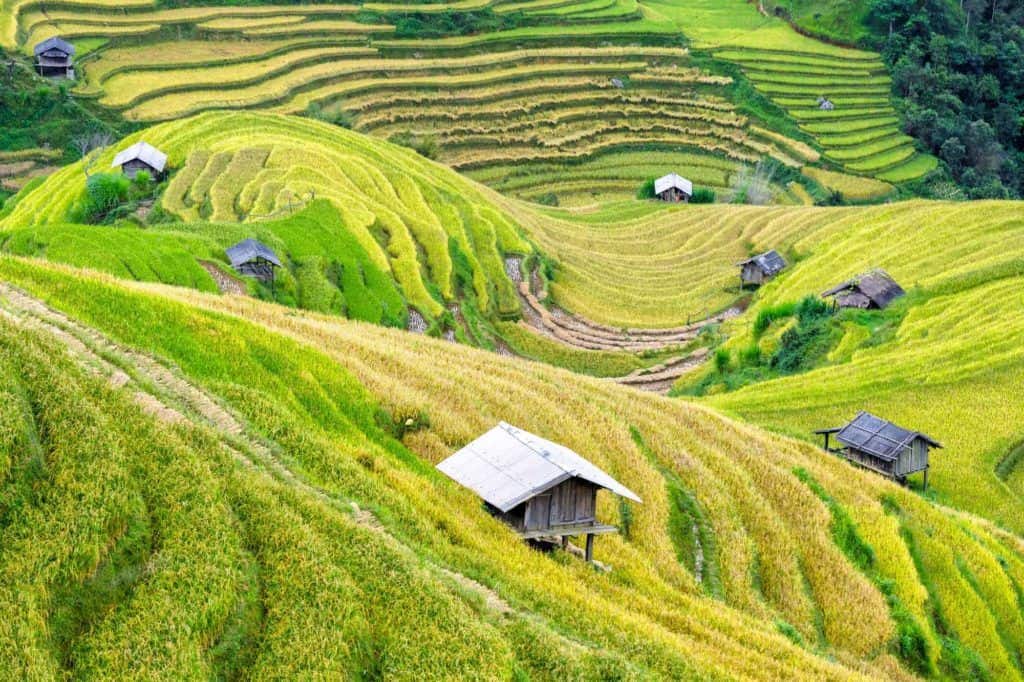
Hike Through the Rice Terraces of Sapa
Explore the area with the local hill tribes. Stay with them during your trek. And enjoy the beautiful terraced countryside for which Sapa is known.
Here’s our full post about trekking in Sapa .
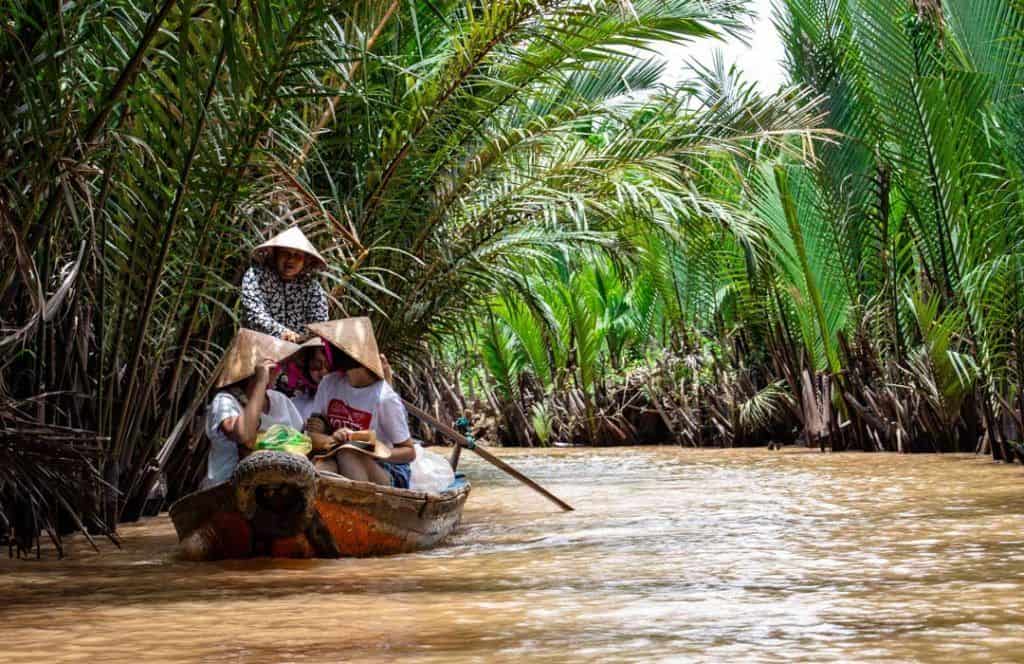
Cruise the Mekong Delta
Probably one of the ‘must do’s of Vietnam.’ The Mekong Delta is full of hidden gems including floating markets, friendly locals and late afternoon storms.
Book a multiday tour of the Mekong Delta
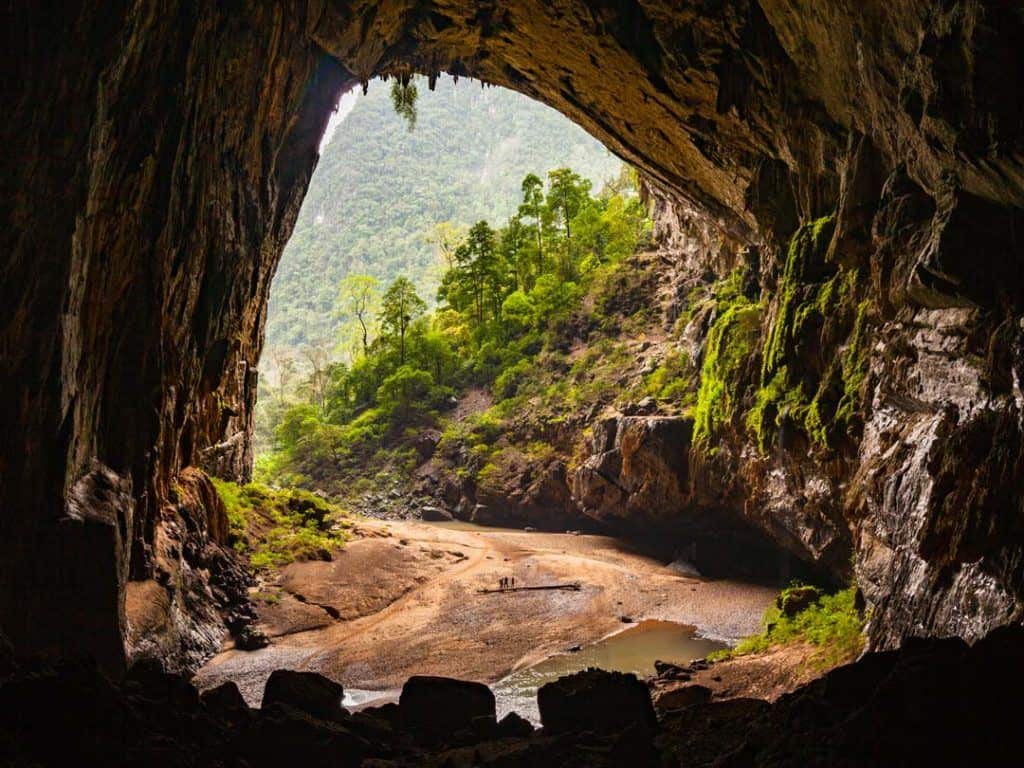
Go Caving in Phong Nha
Caves there can fit a 747 plane in it. They are massive and spectacular. This is an adventure you will never forget.
Book your Phong Nha cave tour
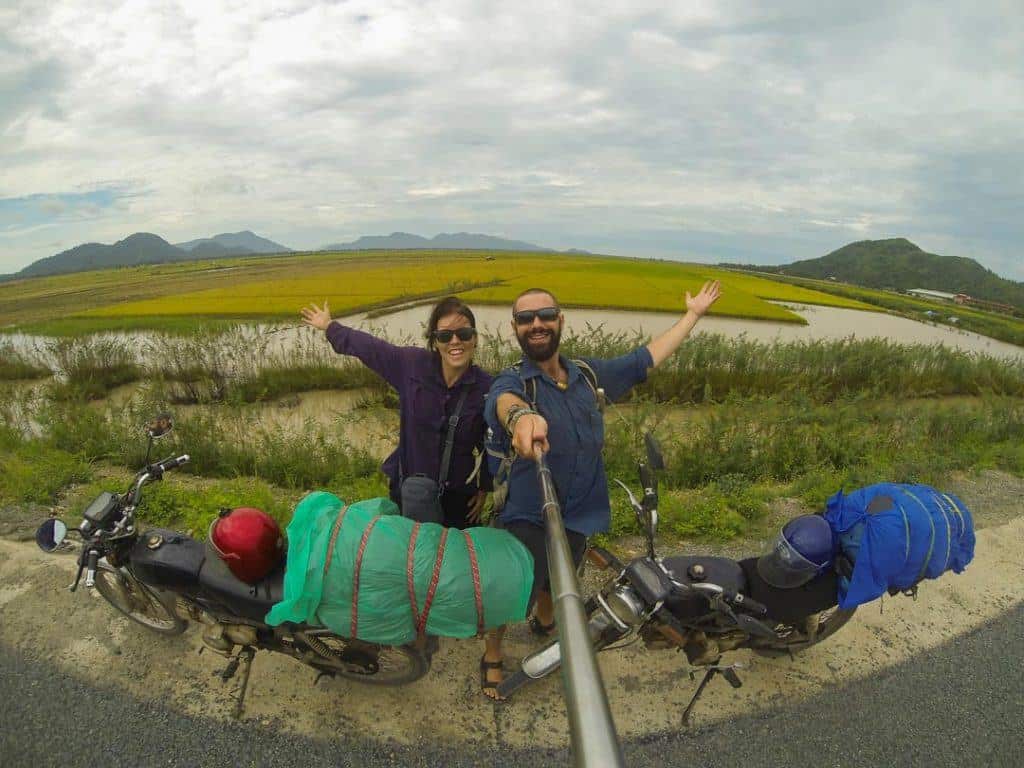
Ride a Motorcycle
Yes, that’s right! Hiring a motorcycle or scooter is a must. But maybe do it out on the country roads. Opt for the famous ride to the mountain village of Dalat, or pretty much anywhere throughout the country.
Read about how to ride through the famous Hai Van Pass
Other Things to do in Vietnam
Learn to cook Vietnamese food . Eating delicious Vietnamese food is one thing. Eating it after you’ve learned to prepare it is another!
Scuba dive in Nha Trang. You may not think of Vietnam as a big scuba location, but there is some great diving to be had in Nha Trang.
Go canyoning in Dalat. Rappel, slide, jump and climb your way through canyons in this gorgeous place!
Explore the Marble Mountains in Da Nang. These beautiful mountains have been mined for marble for years and have incredible views and temples to visit along the way.
Sandboard down the sand dunes in Mui Ne. It’s like snowboarding, but down massive sand dunes! Enjoy this rush!
Visit the Giants Causeway in Ghan Da Dia. Half the world away from the Giant’s Causeway in Northern Ireland, be amazed at this unique geologic structure .
Visit the Cu Chi Tunnels outside of Ho Chi Minh City. No trip to HCMC is complete without touring these historic tunnels that were used during the war.
Conquer the Hoi An Pass on a motorbike . This is known as one of the most beautiful sections of highway in the world. Enjoy!
Explore the world’s biggest cave . We have a special connection with Hang Son Doong as it is where we were engaged. Make your own special moment too!
Climb the highest mountain in Indochina in Sapa. Fansipan is over 3,000m above sea level and offers incredible views along the way to the top!
BE SURE TO CHECK OUT THESE OTHER AMAZING THINGS TO DO IN VIETNAM
READ MORE...
A First-Timer’s Guide to Trekking in Sapa
The 11 Best Things to Do in Da Nang, Vietnam (2024 Guide)
33 BEST Things to Do in Vietnam (Epic 2024 Guide)
10 BEST Things to Do in Ninh Binh, Vietnam (2024 Guide)
Scuba Diving In Nha Trang – Is It Worth It?
BEST PLACES TO VISIT IN VIETNAM
There are plenty of amazing places to visit in Vietnam. Depending on your interests, trip duration and time of year you will find plenty of things to do during any length of stay.
When slurping a bowl of pho in a local market or exploring an ancient temple, it’s easy to feel like you’ve stepped into a time machine in Ho Chi Minh City.
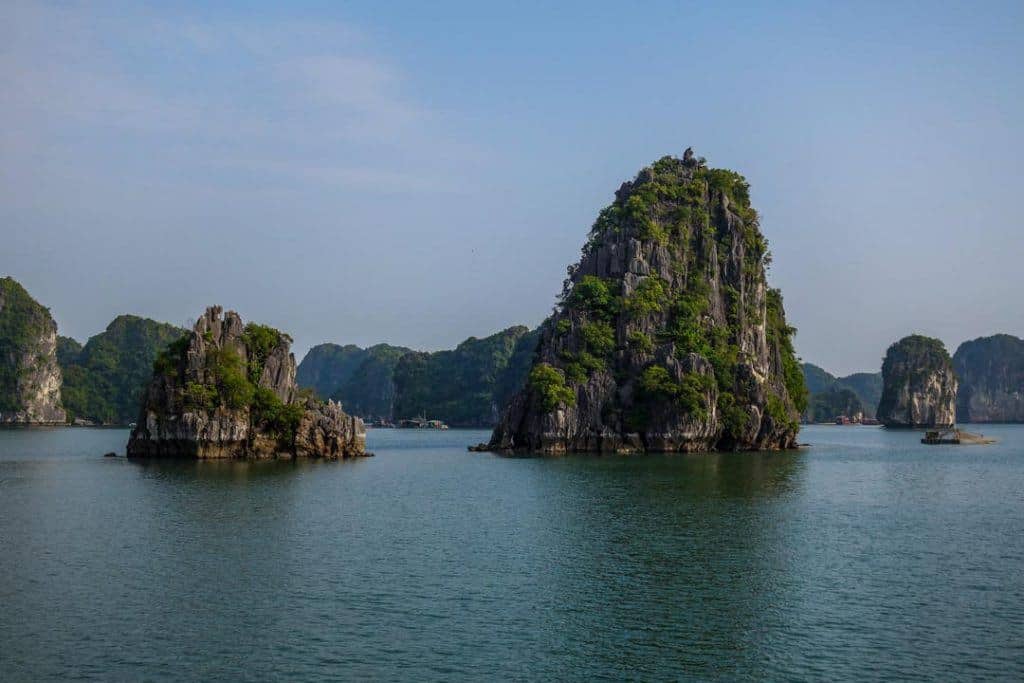
A collection of over 3,000 limestone islands providing endless kayaking opportunities. Take the time to relax aboard a boat or venture to Cat Ba National Park for mystical waterfalls!
Book your tour of Halong Bay
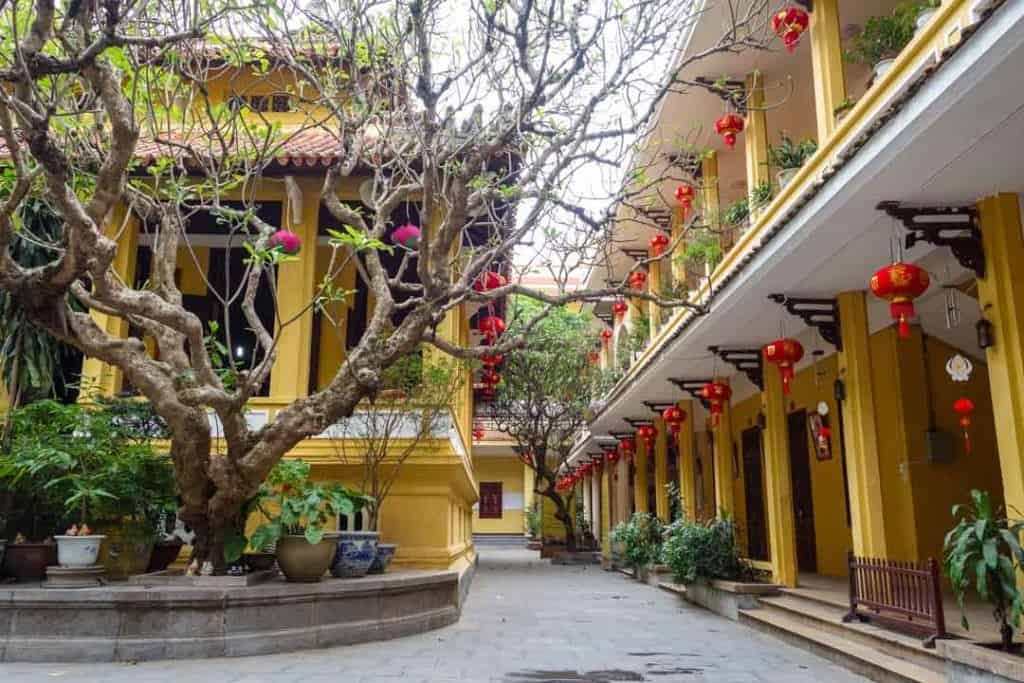
The capital of Vietnam is also one of the most ancient capitals in the world. The history of Hanoi is rich, devastating and full of legends. This mystical city is also known for its cuisine, silk, buzzing nightlife as well as cultural diversity.
Plan your 3-day Hanoi itinerary
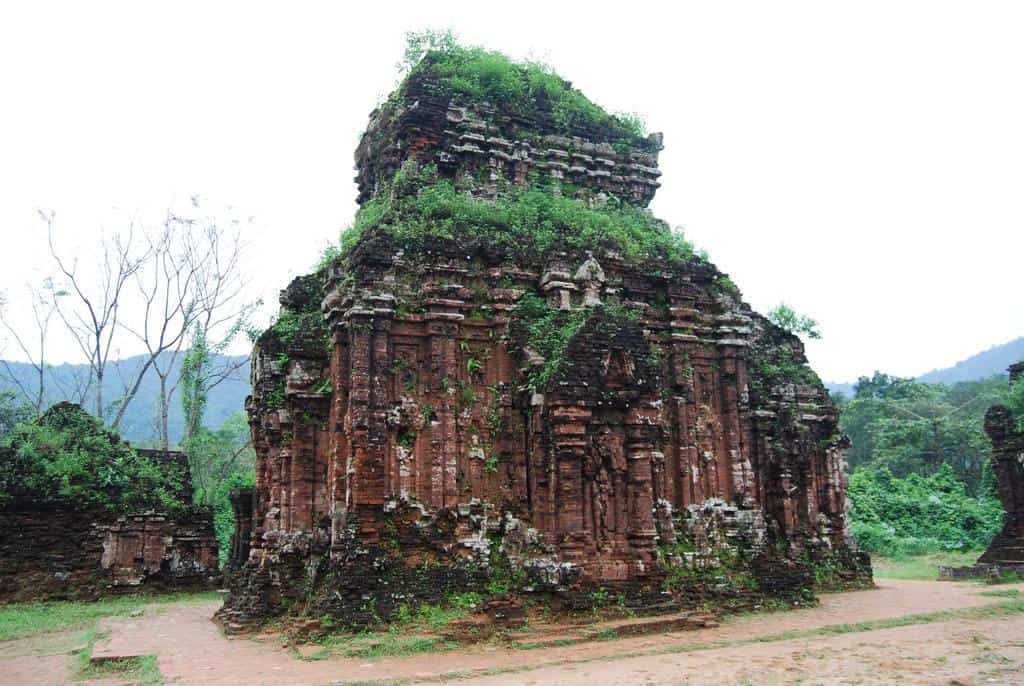
My Son Temple
Ancient temples dating back 1,000 years give a culture understanding into Vietnam’s past all while showing the scars of the war.
Book an early morning tour of My Son
For more information on specific things to do in the top places to visit in Vietnam, reference our following city travel guides:
Ho Chi Minh City:
* Ho Chi Minh City Itinerary * Day Trips from Ho Chi Minh City
* Hanoi Itinerary * Day Trips From Hanoi
Dalat Hoi An
Da Nang Hue Ninh Binh
BE SURE TO CHECK OUT THESE OTHER AWESOME PLACES TO VISIT IN VIETNAM.
BEST VIETNAM TRAVEL ITINERARY
We’ve put together a few Vietnam itineraries that are sure to leave you wanting for nothing at the end of your visit.
There are so many amazing things to do in Vietnam that planning an itinerary for your travel can be a little overwhelming.
Even though the country is one united nation, you can think of it geographically as being divided into a northern and southern region.
So depending on how much time you have, you may want to explore the northern region, southern region or the entire country.
Of course, no one-size-fits-all plan will suffice. But if we were to head back to Vietnam these are the top places and things that we would want to do!
1-Week Vietnam Travel Itinerary Highlights
Most people spend at least a month went hey travel to Vietnam. But if you had just one week, or were willing to split a few weeks between the northern and southern regions, this is how we’d spend our time!
Northern Vietnam
- Fly into Hanoi
- 2 nights – Hanoi
- 2 nights – Halong Bay or Bai Tu Long Bay
- 2 nights – Sapa
- Alternative to Sapa – 2 night in Hue
- Fly out of Hanoi
Central Vietnam
- Fly into Hanoi or HCMC. Get a local flight down to Dong Hoi
- 3 nights – Phong Nha
- 2 nights – Hue
- 2-3 nights – Hoi An
- Fly out of Da Nang to either Hanoi or HCMC to leave
South Vietnam
- Fly into Ho Chi Minh City
- 2 nights – Ho Chi Minh City
- 2 nights – Mekong Delta
- 2 nights – Dalat
- 1 night – Mui Ne
- Fly out of Ho Chi Minh City
READ MORE: Check out this post for more details on our Vietnam travel itinerary .
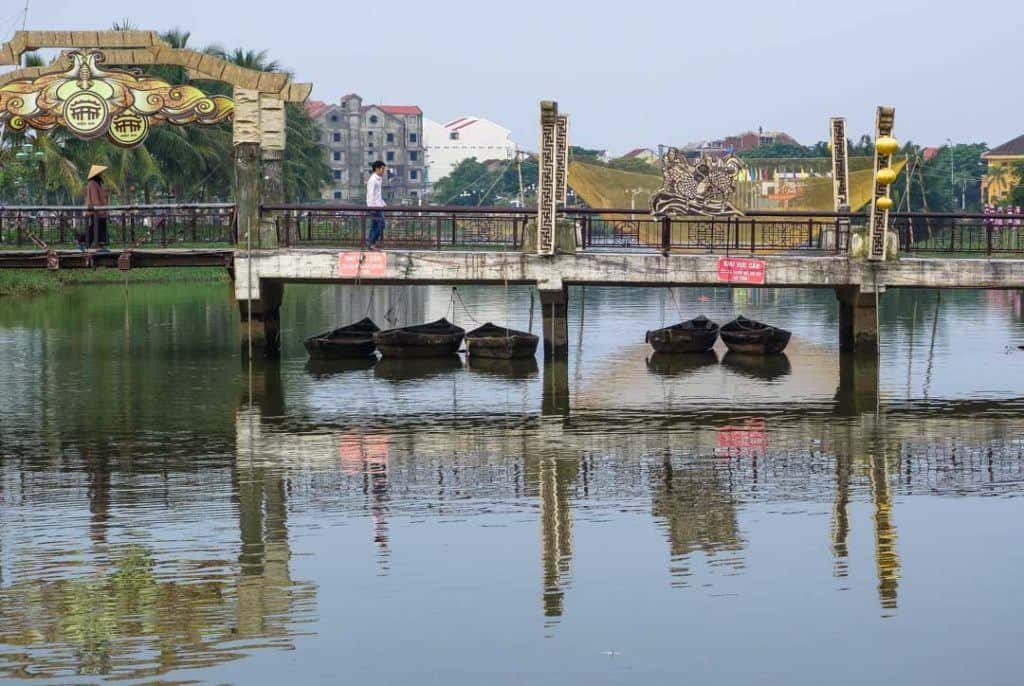
VIETNAM TRIP PLANNING
Best time to visit vietnam.
The best time to travel to Vietnam really depends on what you are looking for in terms of weather, scenery and budget.
Peak season occurs from mid-December through to February. But expect prices to double during this time. The low season is perfect for those on a budget.
- Low Season – April to June, September to November
- Shoulder Season – December to March
- High Season – July & August
Northern Vietnam – The best months to travel Northern Vietnam are April to May or September to October. There are mostly sunny days and the rain has stopped.
The weather gets really cold from December to March and is not suited for hiking or sailing a junk boat in Halong Bay that time of year.
Central Vietnam – The best months for travel to Central Vietnam are January to June. There are heavy rains in October and November and the really hot months are from May to August.
Southern Vietnam – The best months to explore Southern Vietnam are January to April where conditions are beautiful.
You really can travel the south at any time of the year. Just note that from May to November there are afternoon downpours.
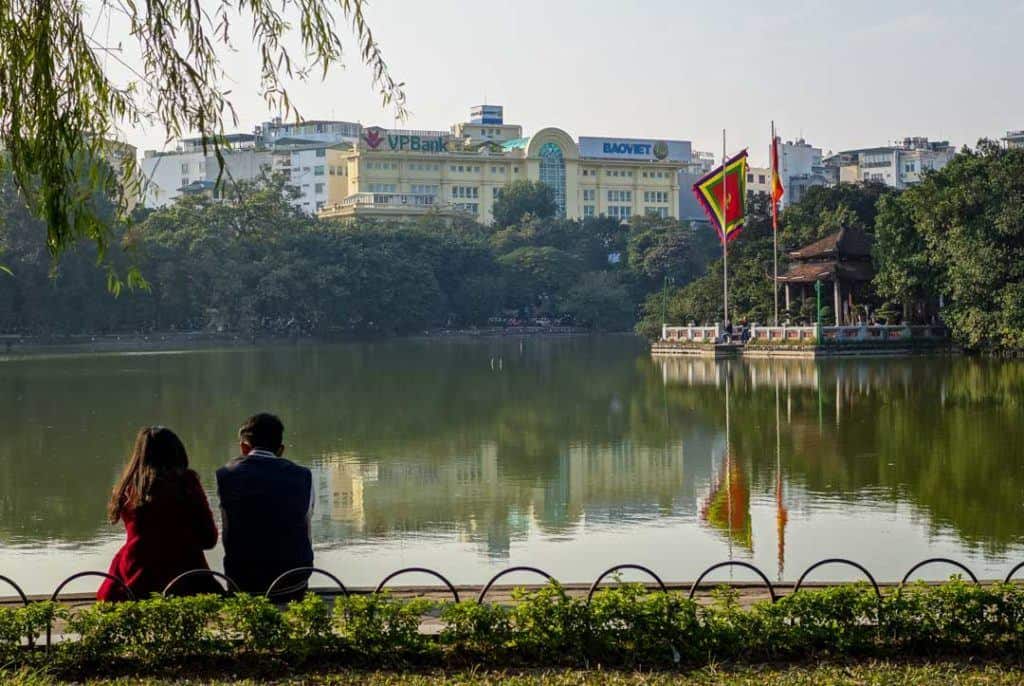
VIETNAM TRAVEL BUDGET GUIDELINE
Vietnam is a cheap country to travel if you want it to be, this all depends on what your budget is like. Our advice is always over-budget when making plans, and if you come home with money, it can go towards your next trip. All prices below are in USD per day.
Budgeting Tips
To make your money go further here are a few tips:
- Eat street food as often as possible. You can usually fill up for $1-2USD.
- Travel in groups when possible. Staying in hostels will lead to making friends. And with friends, you can split transportation costs and barter on other expenses.
- Negotiate taxi fares before taking the ride. Vietnamese taxi drivers are notorious for flexible fares that tend to fall int heir favor. Don’t be afraid of a little negotiation.
- Drink bia hoi . Sure it’s not the more delightful beer. But it is shipped in fresh each day, it’s cheap and it’s what the local drink.
- Take in the sights for free. Do a little research and walk the streets on your own. You’ll also find there are a number of free tours and other opportunities if you ask around.
- Sleep on overnight busses for longer trips. Combine the transportation and accommodation line items of your budget and save a few dollars.
But there are a few things you should know about the different budgets at which you can choose to travel.
Note: Budgets shown as Single Traveller / Couples per day.
Budget Traveller ($35 Single / $50 Couples)
If you are on a backpacker budget and planning on staying in dorm rooms, getting street food, drinking a few nights of the week, I would budget for about $35 a day.
A single hostel bed can be $5-$8 per person. A budget basic private room is $15-$20. A street food meal can be $1-$2. A bottle of beer is about $1- $1.50 and a bia hoi is $0.20 per cup. This is not the nicest beer. But it is passable and you get to make new friends when drinking it.
Walking or taking public transport will keep your budget down. There are many free things to do, you just need to think outside the box.
Mid-Range Traveller ($100 Single / $120 Couple)
If you have a little more cash in your budget your travels in Vietnam will become a lot more comfortable.
A nicer hotel is definitely affordable.
There are restaurants where you will pay more than the street food price. But the food is definitely of nicer quality (most of the time). The local beer can get a little too much sometimes so you will be able to enjoy an international beer or wine.
For the attractions you are most interested in, get a guide and learn more about the history of the country. You’ll be able to commit much more of your budget to do things rather than cutting corners just to stay alive.
Luxury Traveller ($90+ Single / $120+ Couple)
You don’t have to have that much more to enjoy a luxury trip to Vietnam. With a few more dollars in your budget, a nicer hotel is definitely affordable. Eat and drink anything you would like at virtually any restaurant.
You can hire transportation without having to haggle. And you can pretty much do any tour you would like to do when visiting any part of Vietnam.
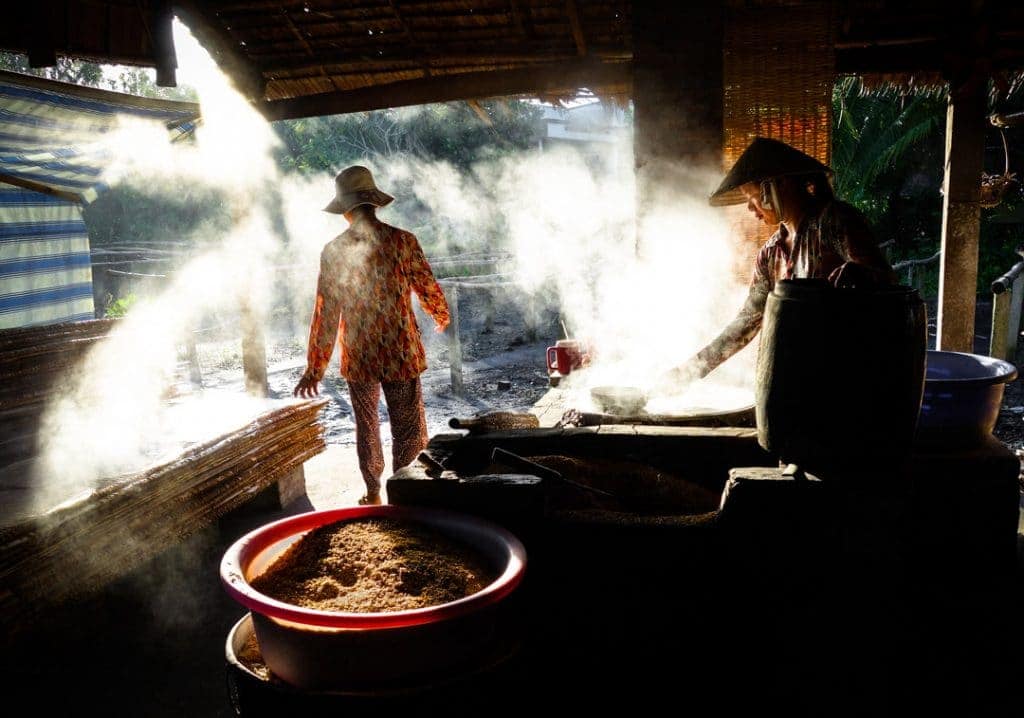
GETTING TO AND AROUND VIETNAM
Entry requirements.
Most travellers are required to have visas when travelling to Vietnam, which can typically be arranged upon arrival. You are typically allowed to stay for 3 – 6 months, depending on nationality.
For information about your specific visa requirements click here
Additionally, Vietnam has introduced an electronic visa (e-visa), which costs $25 USD and is granted for single entry visits for up to 30 days.
You no longer will have to apply through an agent to get an invitation letter or queue at the airport immigration for hours waiting to receive your visa upon arrival.
Apply in advance here .
Once you are approved, all you need to do is print the visa out and present it on entry to Vietnam. Don’t lose this e- visa print out as you will need this during your travels in Vietnam.
Hotels will ask for it on check-in at the accommodation and travel agents may ask for it if you are booking flights.
Also, print out your travel insurance as well. Immigration will ask for this also as they want to know you are covered if you fall ill or get injured during your stay.
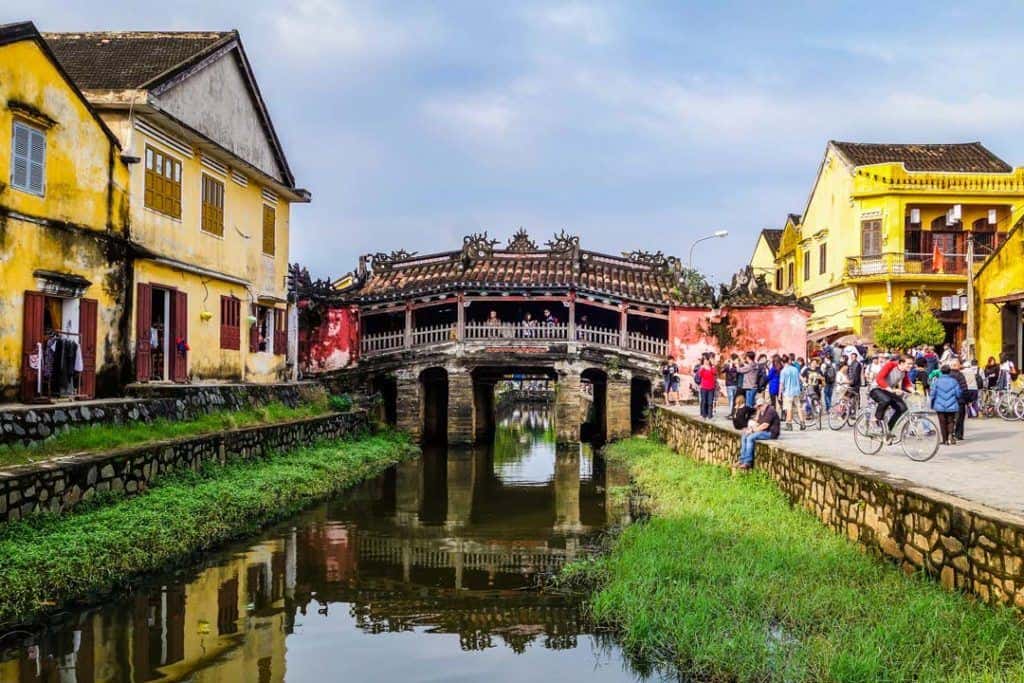
Getting to Vietnam
There are a number of different ways to travel to Vietnam, depending on where you are coming from and how you like to get around with transport.
There are a lot of different airlines that fly to Vietnam from all over the world. There are two major international airports in Vietnam: Tan Son Nhat Airport (SGN) in Ho Chi Minh City in the south and Noi Bai Airpot (HAN) in Hanoi in the north.
Direct flights to Vietnam from Australia, Europe and North America are still limited, but it is improving. You will most likely have to book a flight with a stopover in either Hong Kong, Bangkok, Kuala Lumpur, Seoul or Singapore.
There are many domestic airports scattered among the country. Vietnam Airlines is Vietnam’s national carrier. We have flown with them several times and they are amazing.
You can cross into Vietnam by train from China, all the way from Beijing to Ping Xian. This is the Dong Dang Crossing which is 160km from Hanoi.
After you have crossed the border hop on a train to Hanoi. Don’t buy the direct ticket from Beijing to Hanoi. It works out cheaper to buy your ticket from Beijing to Ping Xian then cross the border and purchase another ticket from Dong Dang to Hanoi.
If you do the train trip from Beijing through to Hanoi, it will take 36 hours so it is best to book a sleeper. Make sure you have your visa organised before getting to the border.
You can bring your own food and drinks for the train or purchase them from the cafeteria on board. There are squat toilets on board and areas to store your luggage.
You can get to Hanoi or Ho Chi Minh City through either the Cambodia, Laos or China borders. There is a route from Vientiane (Laos) to Hanoi, and one from Siem Reap or Phnom Penh to Ho Chi Minh City.
Most travel agents in Vientiane, Siem Reap or Phnom Penh will sell the tickets or at your accommodation. You can also get a minivan from Guangzhou through to Hanoi.
Make sure you have your visa ready. The border crossings by land may not be set up as well as others.
If you want to book any of your bus trips online rather than trying to deal with travel agencies in the country, you can do so on the popular website Bookaway .
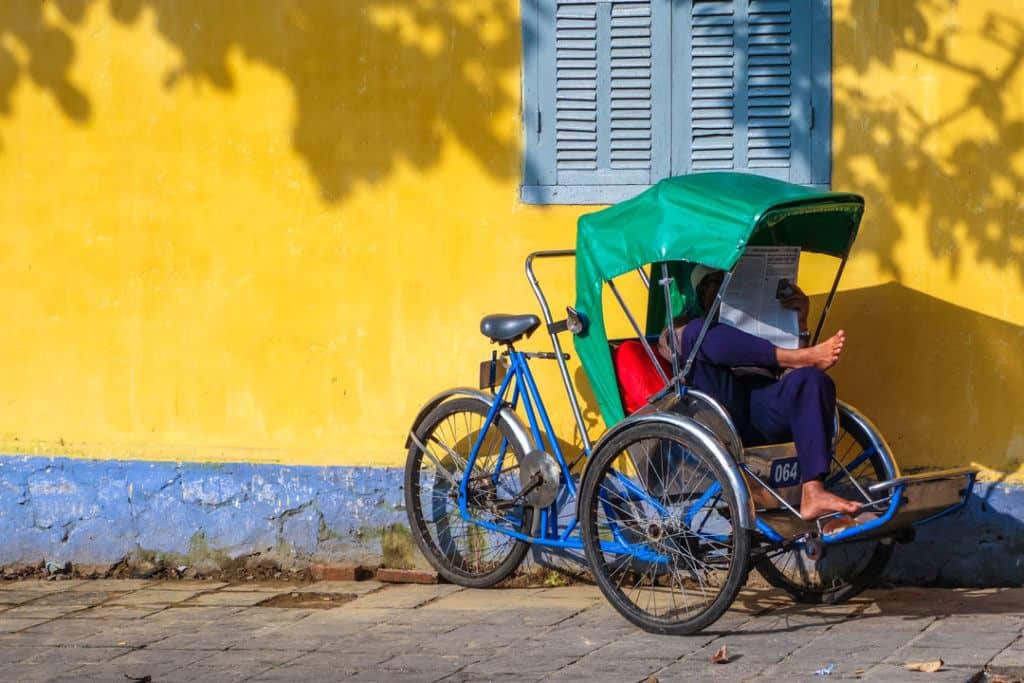
Getting Around Vietnam
Getting around Vietnam is surprisingly easy. Public transport goes everywhere, and there are plenty of moto-taxis that are happy to take you to the places that public transport won’t reach.
Travelling by Air
The fastest way to get around the country, of course, is by air. There are many domestic airports all over the country and you can fly in from major cities.
You can get cheap flights within the country through VietJet Air and Vietnam Airlines. For the best deals head directly on the airline’s website.
Travelling by Taxi, Tuk Tuk Or Mototaxi
When you are in the cities and town catching a taxi, tuk-tuk or moto-taxi can be the best way to get around. For taxi companies, look for the biggest and most reputable companies as you can be ripped off.
For the tuk-tuks, ask your accommodation the average price to your destination so you can agree on a price with the driver.
We recommend Uber and Grab (car or motorbike) which you can use an app and get the price.
Travelling by Bus
It is possible and advisable to travel by bus throughout Vietnam. Busses inside of cities can be complicated and should be a last resort.
However, when travelling long distances in Vietnam busses are a great option. This is especially true if you take night busses and sleep during the ride.
Travelling by Motorbike
We think travelling by motorbike is the best way to see Vietnam if you have the time. Buy your own motorbike and ride the length of the country. Or you can choose one area and explore Northern Vietnam or South Vietnam.
Here’s our post to help guide you on how to buy a motorbike in Vietnam .
Travelling by Train
Taking the train is a great way to get around the country. They are great for overnight journeys as the trains have bed cabins.
In Vietnam, there are many places with roadwork that can last for years. So trains can be the best way to go.
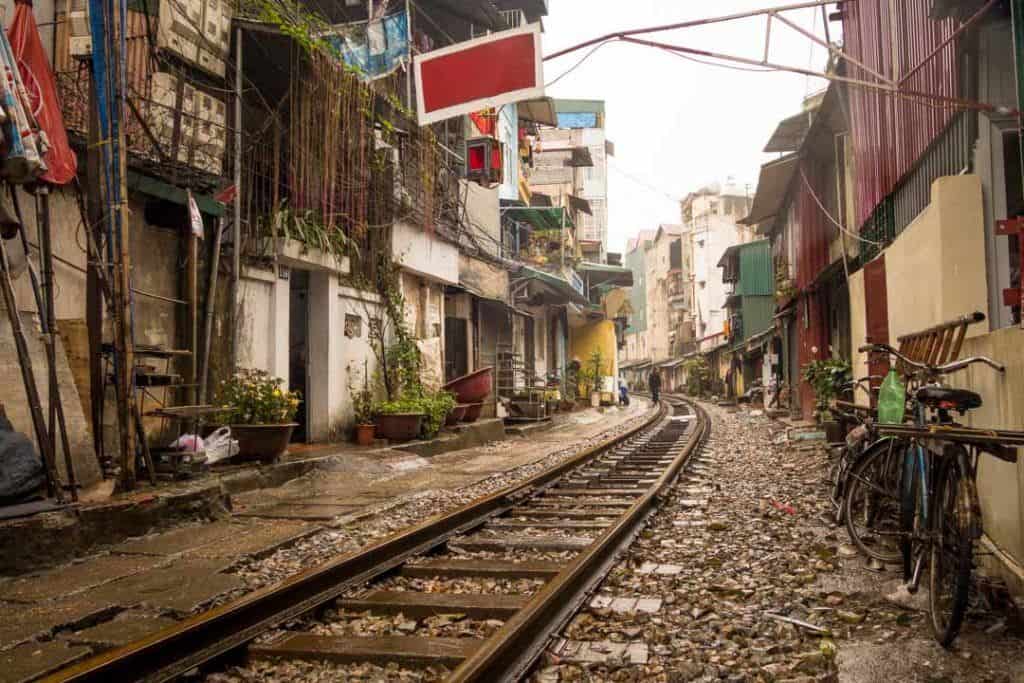
APPS AND TECHNOLOGY
We know you’ll absolutely love travelling in Vietnam. But technology has made it easier, more affordable and safer to travel than ever.
Here are a few apps we think you should definitely acquaint yourself with prior to your travels:
Grab – Use this app to catch a ride from any metro area in Vietnam.
XE Currency – Transfer, monitor and calculate currency as the need arises. This app may not be totally necessary as you are typically tied into rates the banks charge for services. But it is handy to have around.
Express VPN – This will protect your sensitive information wherever you travel – not just in [Country]. Be sure to have this to keep your online information secure as you travel.
iTranslate – Even if you don’t know more than a handful of Vietnamese words, iTranslate will help you communicate as you travel in Vietnam.
WiFi Finder – With this app, you no longer have to guess whether the next place on your itinerary has WiFi or scramble across town looking for hot spots.
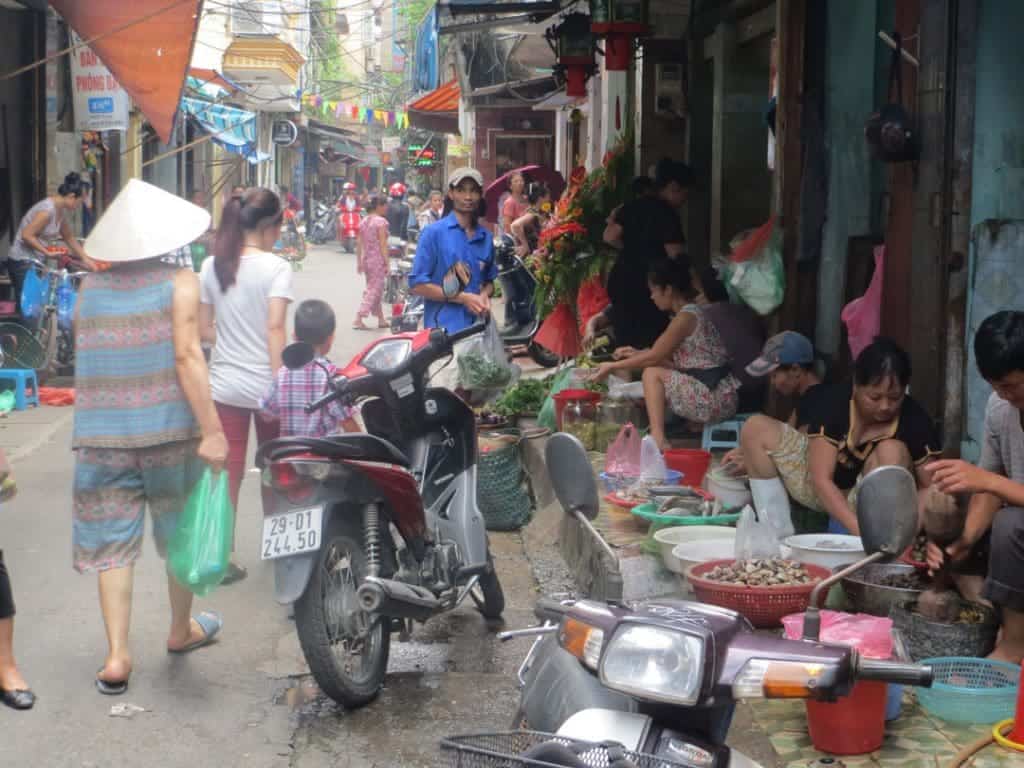
BEST THINGS TO EAT IN VIETNAM
When you travel to a foreign country one of the new and most exciting things you will experience is the food. There are so many amazing food choices in Vietnam, and Vietnamese food is delicious.
Here are a few of our favourites.
Goi Cuon: This is a rice paper packed with greens, coriander and various combinations of minced or shredded pork, shrimp or crab. It will be served with a sweet and sour sauce or a delicious homemade peanut sauce.
Sometimes to make the experience even better, you get to hand roll them yourself. This was our favourite dish.
Banh Mi: With this one, it will be different in every corner of Vietnam. This is a baguette sandwich that is filled with meat, greens, pata, pickled vegetables, soy sauce, cilantro and sometimes an omelet.
The meat filling will be roasted pork belly, grilled pork loin, barbecue pork, boiled chicken, or a fried egg.
Pho (pronounced ‘fur’): This flat rice noodle soup is either light beef or chicken broth flavoured with coriander and ginger with spring onions and bits of meat (chicken, pork or beef).
It is a dish you can have any time of the day and is delicious, but it can be hit and miss in some places. If you have an average one, please do try it again. We ate pho a lot for breakfast and never got sick of it.
Bun Cha: This is a Hanoi specialty and it is deliciously addictive. Bun Cha is served with grilled fatty pork over a plate of white rice noodles. It will be served with a sauce.
It will all be served separately and you combined everything together. You can ask for some little fried spring rolls on top too. It is so delicious!
Coa Lau: Hoi An is the best (and only authentic) place to try this one. as the noodles are made using water from a special well in town.
It is chewy rice flour noodles with Chinese barbecue pork, bean sprouts, croutons and fresh herbs in a delicious pork-based gravy.
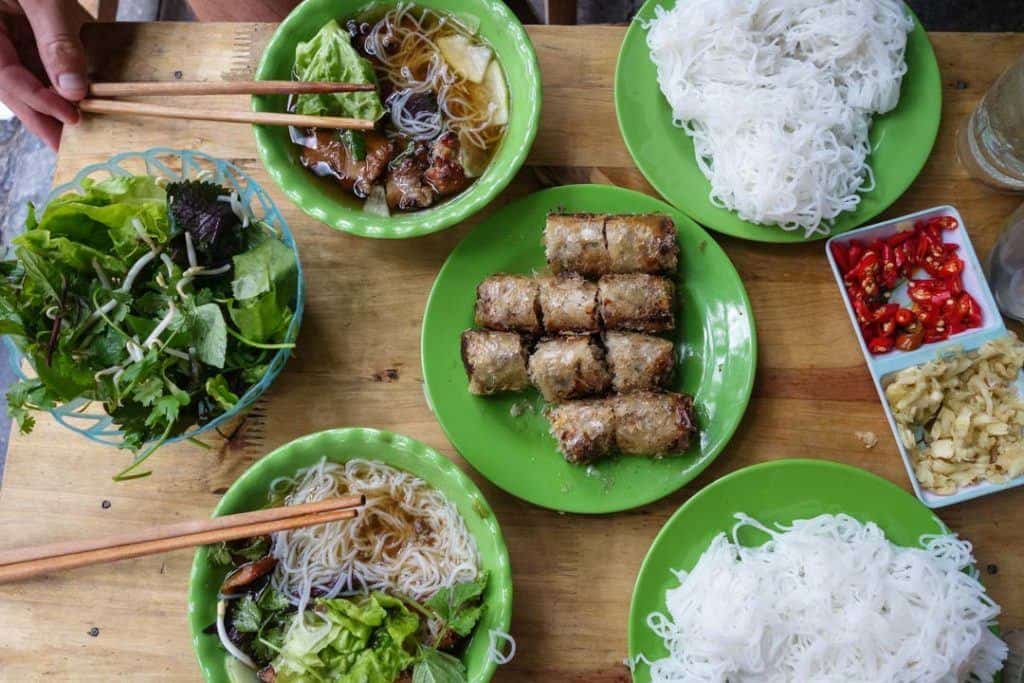
PLACES TO STAY IN VIETNAM
There are accommodation options for all budgets in Vietnam. You can stay in a shared dorm for $5 USD per night, or a luxury hotel for over $300 USD.
The accommodation standards can vary in each destination.
For example, we got a really nice hotel in the middle of nowhere when we were on our bike for $12 a night. But we would not find a place like this in Hanoi, Hoi An, HCMC or Hue for less than $25.
NOTE – In Vietnam, the accommodation will keep your passport for the duration of your stay. This is to do with the government. Officials will randomly come around and check hotels and hostels.
If they do not have the ID or passport of every person staying there, the accommodation will be fined. The accommodation will keep your passport in a safe. If you are unsure just ask, “do you lock my passport up?”
Types of Accommodations
Vietnam is wildly popular among backpackers. Because the costs are generally incredibly low, budget travellers flock to the country.
This means that there are lots of great hostel options when looking for accommodations in Vietnam.
Whether you are busy spending all your time exploring and are just looking for a cheap place to crash for the night or want to make friends along the way, you will find most of what you are looking for in a variety of hostels throughout Vietnam.
Because costs are generally lower in Vietnam than in most parts of the world your quality of life can go up quite a bit when you travel to Vietnam.
One way you can upgrade your travel experience is by booking rooms in hotels instead of beds in hostels. For a few dollars more you’ll get vastly more space and privacy.
In some towns and villages, hotels are your only option.
But generally, these are very reasonably priced. You can expect to spend USD$20-30 for a decent hotel room in most cities, towns and villages across Vietnam.
Another good option in recent years is AirBnB, and there are more and more amazing places popping up to stay in Vietnam for very affordable prices every day.
As is typical in many destinations where Airbnb accommodations are available, you’ll likely find great value and a little more personal space with an Airbnb stay.
If you’re looking for an awesome place to stay, we personally love using Airbnb. If you’ve never used the platform before, sign up using this link to get USD$35 off your first booking .
Our Favorite Places to Stay in Vietnam
We travelled from the south to the north and stayed in many different places. Here are a few accommodation options we highly recommend.
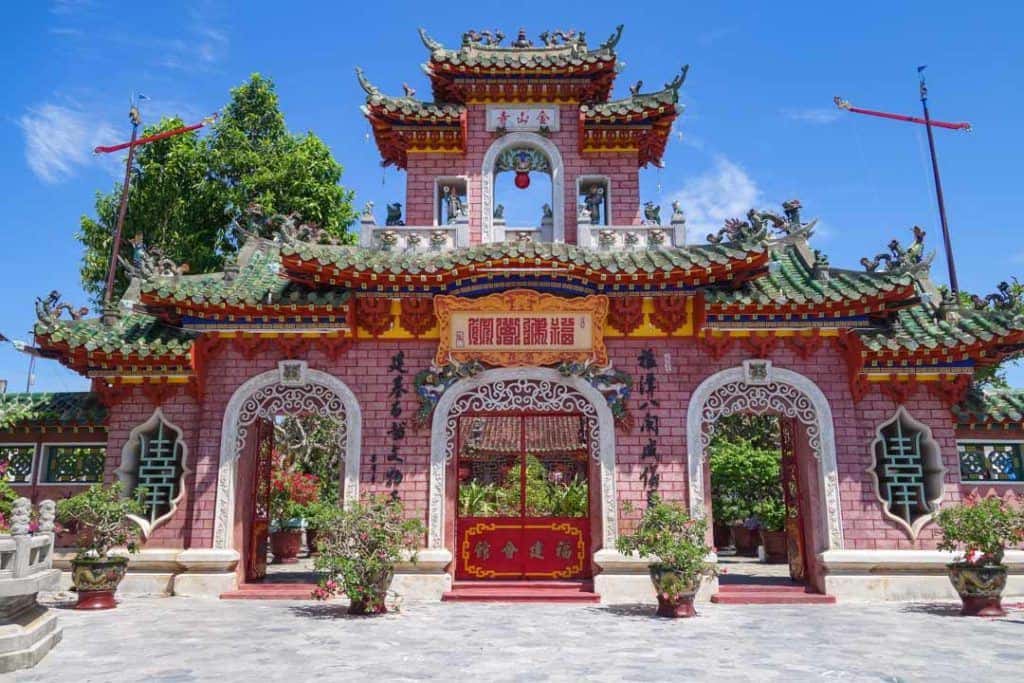
VIETNAM TRAVEL TIPS
The Vietnamese people are friendly, welcoming and hospitable towards travellers. It is a great destination to travel to in Southeast Asia.
The people are very respectful and would like the same back from you. Here are a few things that you should know before going to Vietnam.
GENERAL VIETNAM TRAVEL TIPS
While we have many basic travel tips we suggest you use when travelling to Vietnam, there are also plenty of Vietnam-specific tips that will make your visit the best it can be.
Here are a few we recommend you consider as you plan your trip to visit Vietnam:
Please show respect to their religious beliefs and their cultures . You are travelling to someone else’s country. They have different religious beliefs and cultures in your home. Please respect them.
Watch your belongings. Vietnam is a safe country but unfortunately, there still is petty theft. Whether you are at a restaurant or on a bus always watch your belongings.
Beware of the counterfeit tour agencies . Unfortunately, there are plenty of these around, especially in the main tourist areas. Book through the main owner or operator or any of these tours that we recommend .
Do not drink the tap water. The locals don’t even drink the water. There is bottled water available everywhere. Popular tourist restaurants will usually have on their menu that they wash their salad and veggies in sterilised water and make tea, coffee and soup from that too.
Carry toilet paper everywhere . There are toilets available in restaurants or in public but there may not be toilet paper. Most of the time you have to pay for the public toilet and they may give you some toilet paper, but don’t count on it. Always have your stash.
Toilet paper goes in the bin . DO NOT put the toilet paper in the toilet. Please put it into the bin provided. Vietnam’s sewerage systems are not built for much more than human waste so toilet paper and other items will just clog up your toilet.
Embrace the “bum gun “. Next to every toilet in Vietnam, there is a water hose. This is not to wash down the floor. This is to clean yourself up after you do your business. Don’t be disgusted by this. Embrace it.
Vietnam is bigger than you think . This country is huge and many people underestimate it. Vietnam is about 1,650 kilometres long from north to south. The distance on buses and trains is long so be prepared.
Take note of the Vietnamese money . It will be a new currency for you so do take a look at it before you go out spending. There are more zeros in it than you might be used to (1USD = 23,000 Dong)
Always take photos when you rent a scooter . Renting a scooter in Vietnam is something everyone does. It is a great way to get around and see all the attractions. But where you rent it from can get you into trouble. Whenever you rent a scooter take photos of the bike or else might end up with a crazy expensive bill.
Always wear a helmet. Always . Please wear a helmet. The roads are crazier here than they are in your country. The rules are different and road conditions are not the best. A quality helmet could save your life in an accident.
Make sure you have travel insurance . We tell people who are going travelling, “if you can’t afford travel insurance, you can’t afford to travel.” You do not know what is going to happen while you are away and knowing you are covered will put your mind at ease.
Be confident when crossing the road . The roads in Vietnam are crazy. Crossing the road can be daunting but you need to be confident. Do not walk backward or hesitate. Walk slowly and watch the traffic coming towards you. They will all move around you.
Take your shoes off before entering a temple or a person’s home . It is a custom that stems back to ancient times and a big part comes back to cleanliness. The ground is used for chatting, dining and even sleeping.
Cover your shoulders and knees when entering a temple . This is common in most religious sites. There are always signs suggesting visitors dress ‘appropriately.’ Shoulders and knees should be covered. If it is a hot day and a t-shirt is too sticky, carry a scarf for when you visit to cover your shoulders.
Keep a low profile . Do not be loud, raise your voice in aggression or show off. Do not show dramatic affection publicly like kissing. Save it for the hotel room
Ask for permission before taking a photo of someone . This is polite and ensures you are not intruding on them. The people are not there for your entertainment. If they say no, smile and thank them anyway.
Do not take photos of anything to do with the government or military. This is a big NO in any country and can end up with you in jail.
Do not touch someone on the head . The head is the most important part of the body. Touching someone’s head who you don’t know is like saying you are more important than they are.
Place your chopsticks across the top of the bowl when finished . Don’t have your chopsticks hanging out of the bowl, and don’t point them at anyone when they are resting on the plate.
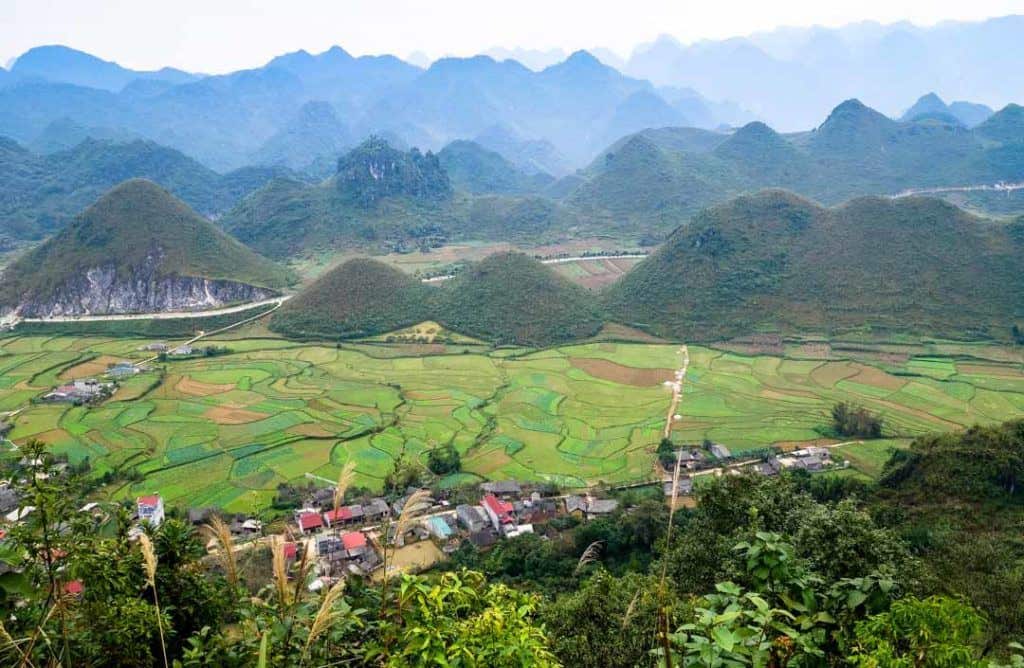
VIETNAM PACKING LIST
We always travel with a core packing list wherever we go. And when it comes to Vietnam, many factors will affect what else you need to bring along with you.
Check out our travel essentials and be sure to add any of the other additional items listed below.
Important Note! Before you book any international trip, we honestly recommend getting travel insurance. You never know when things will go wrong, and medical bills can add up quickly if you get sick or injure yourself overseas.
Our personal recommendation based on our own experience is World Nomads .
TRAVEL INSURANCE. SIMPLE & FLEXIBLE.
Which countries or regions are you traveling to, what’s your country of residence, enter traveler’s age, staying safe in vietnam.
Vietnam is extremely safe, apart from the one major danger which is the roads. They are crazy, even more so if you try to ride 10’000km around the country on motorbikes as we did!
Aside from that, common sense will keep you safe.
Here are a few reminders of what common sense when travelling in Vietnam means:
As you saw above, Vietnam is extremely safe. We did not feel unsafe once in the 7 months we were there (excluding the roads).
This doesn’t mean you can completely let your guard down though, and petty theft does happen in this country, although it’s not common.
Some tips for protecting your things:
In other words, use common sense and you’ll be fine.
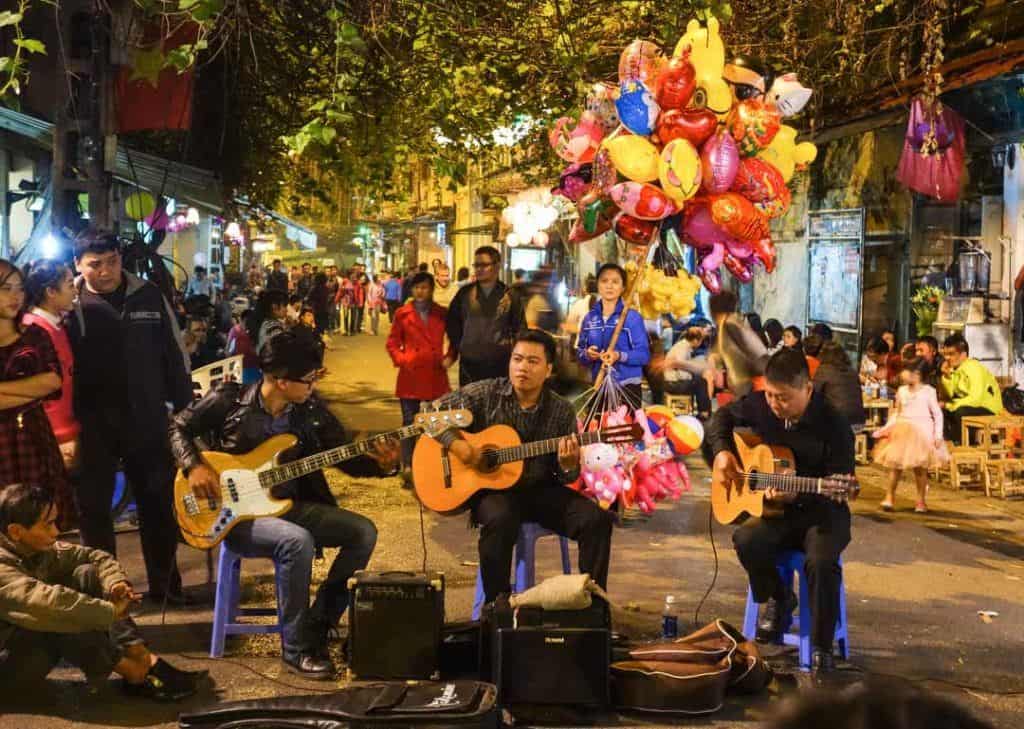
STAYING CONNECTED IN VIETNAM
Staying connected with friends and family (and work) when travelling in Vietnam is important. But if you don’t know how to connect you can find yourself greatly inconvenienced or spending too much money.
We feel like your money will go a lot further if you consider a few options.
Purchase a SIM Card
Picking up a SIM card has become the quickest and typically most affordable way to stay connected in Vietnam or any country for that matter.
If you have an unlocked phone you can use a 4G SIM card to connect to the cellular networks in Vietnam. From there you can cast a hot spot if you need to crank out some work on your computer or want to connect a tablet.
This 3G/4G SIM card is a great and affordable option for a SIM card if you are flying into Vietnam.
Rent a Portable WiFi Device
Alternatively to a SIM card, particularly if you don’t have an unlocked phone, you can rent a portable WiFi device during your travel to Vietnam.
This device will be delivered to you when you arrive in Vietnam and will provide 4G service for less than USD$5 per day.
You’ll be able to connect anywhere you can find service across the country, which will be most of the places you are likely to travel in Vietnam.
Access Free WiFI
Free is always best, if it is convenient. And there are plenty of places throughout Vietnam that will provide free WiFi in public spaces or at restaurants, cafes and hostels and hotels.
We recommend using the WiFi Finder app, which will help you locate WiFi anywhere you travel in Vietnam.
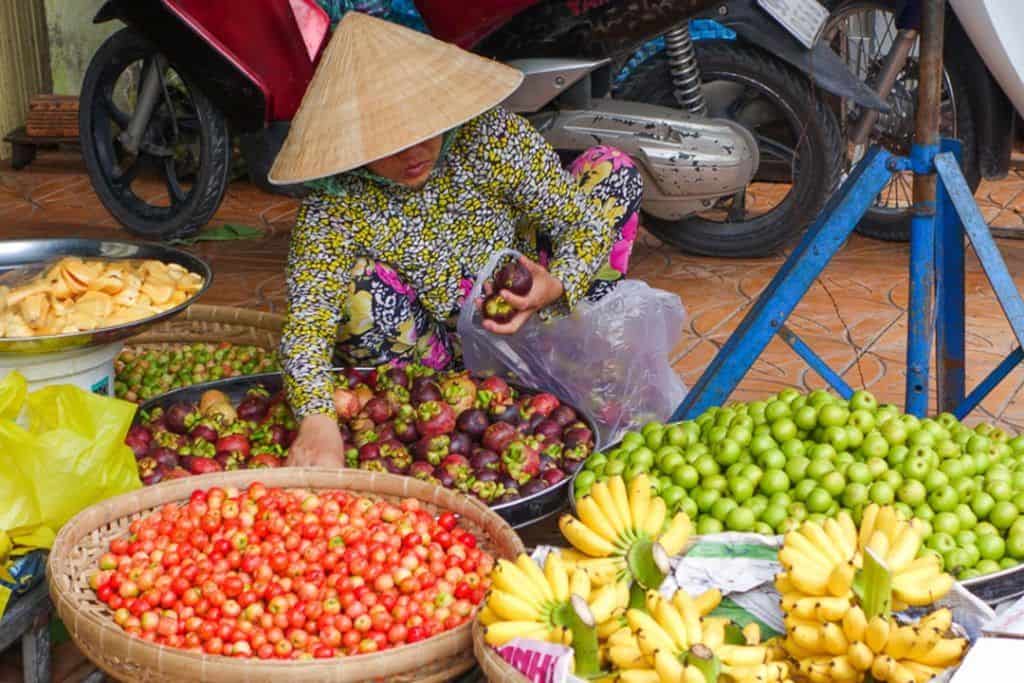
BE A RESPONSIBLE TRAVELER IN VIETNAM
We absolutely love Vietnam. And we love the idea that it will remain a beautiful and friendly place for travellers for years to come.
Here are a few tips specific to travel to Vietnam that will promote sustainable tourism in the country:
Use your own energy to get around. Walk or cycle through town as much as possible. Taking a cyclo-taxi is a close alternative if you don’t have the energy to propel yourself through the city. But this reduces the impact of taxis, busses and other forms of automotive transportation.
Mind your plastic . Plastic is everywhere in Vietnam. But using your own reusable bag for groceries and other shopping, carrying a reusable water bottle and having your own straw are just 3 of the many simple ways you can reduce the amount of plastic you use.
Shop local . Visiting the markets will be one of your top experiences when travelling to Vietnam. Support local vendors as often as possible, including in taking tours when available.
Be mindful of wildlife . Wildlife in the wild is great. But be mindful not to provoke, feed or otherwise molest wildlife. And never purchase any item made of or involving rare or endangered species.
Attempt to communicate in Vietnamese . You’re probably not going to be fluent as soon as you arrive in the country. But knowing a few phrases and doing your best to communicate with locals will show respect and earn trust and make your experience richer.
KEY VIETNAMESE TRAVEL PHRASES
You don’t have to be fluent in Vietnamese to have a great time when you travel to Vietnam. But it does help to know a few key phrases.
This will not only assist you in your travels but it will also show respect to the local Vietnamese people that you are doing your best to assimilate into their culture.
BOOKS TO READ ABOUT VIETNAM
Maybe you already know everything about Vietnam. Chances are you don’t!
But even if you are well-read, here are a few suggestions that might be worth your time while you’re on the plane to Vietnam.
The Quiet American (Graham Greene) – Originally published in 1956 and adapted for film twice, this story by Greene became an instant classic. Greene fictionalizes life in 1950s Vietnam as told by a British correspondent trying to understand the roots of the rising conflict set to occur.
At Home In The World (Thich Nhat Hanh) – World renown Vietnamese monk, Hanh reflects on lessons and stories in life from the Buddhist perspective.
Vietnam: Rising Dragon (Bill Hayton) – A piece of nonfiction that looks back on the Vietnam of old and attempts to projects its place in the future of Southeast Asia.
The Sympathizer (Viet Thanh Nguyen) – The Pulitzer Prize-winning book, allegedly influenced by The Quiet American , is told through the eyes of a double-agent during the Vietnam War who struggles to understand the minds and hearts of men engaged in war.
DISCLAIMER: Some of the links in this article are affiliate links, which means if you book accommodation, tours or buy a product, we will receive a small commission at no extra cost to you. These commissions help us keep creating more free travel content to help people plan their holidays and adventures. We only recommend the best accommodations, tours and products that ourselves or our fantastic editorial team have personally experienced, and regularly review these. Thanks for your support, kind friend!
Table of Contents
Read our vietnam posts, 20 amazing things to do in hoi an, vietnam (2024 guide), 14 incredible things to do in dalat, vietnam (2024 guide), the perfect 3 days in hanoi itinerary [2024 guide], 25 amazing things to do in hanoi, vietnam (2024 guide), the perfect 3 days in ho chi minh city itinerary [2024], the 8 best day trips from ho chi minh city (2024 guide), caves, zip lines and deep mud in phong nha, ganh da dia – vietnam’s own ‘giant’s causeway’, ba be national park – the lake, trekking and happy water, motorbiking the road from dalat to nha trang in vietnam, riding sea to sky: hue to hoi an by motorbike, getting a chinese visa in hanoi, vietnam.
Vietnam travel guide
This Vietnam Travel Guide is a comprehensive resource that offers essential information for travelers exploring this diverse country. It includes details on popular destinations, practicalities such as visas, currency, and language, as well as transportation options like taxis, buses, trains, and domestic flights. The guide also provides insights into the weather patterns month by month, allowing you to plan your trips accordingly. Furthermore, it offers cultural background and inspiration.
Destinations
Essential guide, getting around, vietnam weather by month.
- Inspiration
Vietnam is a country with a countless of destinations to explore, and this Vietnam travel guide highlights some of the most popular ones.
North Vietnam
Hanoi , the capital city of Vietnam, is known for its rich history, vibrant culture, and bustling street life. Visitors come to explore its charming Old Quarter, taste delicious street food, and visit iconic attractions like Hoan Kiem Lake and the Temple of Literature.
Sapa , located in the northwest of Vietnam, is renowned for its stunning terraced rice fields and ethnic minority hill tribes. Travelers flock to Sapa to trek through breathtaking landscapes, experience the unique culture of local communities, and witness the beauty of the Fansipan Mountain, known as the “Roof of Indochina.”
3. Halong Bay
Halong Bay , a UNESCO World Heritage site, is famous for its breathtaking natural beauty. Travelers visit this iconic destination to cruise along the emerald waters, marvel at the limestone karsts and islets, and explore hidden caves and floating fishing villages.
4. Ninh Binh
Ninh Binh , often referred to as the “Halong Bay on land,” captivates visitors with its stunning karst landscapes, ancient temples, and picturesque countryside. Travelers come to Ninh Binh to take boat rides through the Trang An Complex, explore the ancient capital of Hoa Lu, and enjoy the tranquility of the rural scenery.
5. Ha Giang
Ha Giang , located in the far north of Vietnam, offers adventurous travelers an off-the-beaten-path experience. Known for its dramatic mountains, winding roads, and ethnic minority communities, Ha Giang attracts visitors seeking epic motorbike journeys, trekking adventures, and cultural immersion in remote and pristine landscapes.
6. Mai Chau
Mai Chau , nestled in the peaceful valley of Hoa Binh Province, offers a serene escape from bustling cities. This rural destination is famous for its picturesque landscapes, traditional stilt houses, and warm hospitality of the Thai ethnic minority. Visitors can cycle through scenic villages, participate in local homestays, and enjoy traditional dance performances.
Central Vietnam
7. phong nha.
Phong Nha , is a paradise for nature and adventure enthusiasts. This UNESCO World Heritage Site is famous for its magnificent cave systems, including the world’s largest cave, Son Doong. You can explore the stunning underground wonders, go trekking in the lush jungle of the national park and kayak over the Son River.
Hue , the former imperial capital of Vietnam, is renowned for its historical significance and majestic citadel. Visitors come to Hue to explore its UNESCO World Heritage sites, including the Imperial City and the royal tombs, and to experience the city’s rich cultural heritage, traditional music, and delicious royal cuisine.
Da Nang , a coastal city in central Vietnam, is known for its beautiful sandy beaches, stunning bridges, and modern skyline. Travelers visit Da Nang to relax on its pristine shores, explore iconic attractions such as the Marble Mountains and the Dragon Bridge, and indulge in delicious seafood.
Hoi An , a charming ancient town, enchants visitors with its well-preserved historic architecture, lantern-lit streets, and vibrant riverside atmosphere. People flock to Hoi An to wander through its atmospheric alleys, shop for tailored clothing, immerse themselves in its lantern festival, and savor local delicacies
11. Nha Trang
Nha Trang, a coastal resort city, is famous for its turquoise waters, white sandy beaches, and vibrant underwater world. Travelers visit Nha Trang to relax on its idyllic beaches, enjoy water sports and island-hopping tours, and experience its lively nightlife and seafood dining scene.
Dalat , situated in the Central Highlands, is known as the “City of Eternal Spring” for its pleasant climate and picturesque landscapes. Visitors come to Dalat to escape the heat, explore its French colonial architecture, visit flower gardens and waterfalls, and engage in outdoor activities like hiking, biking, and canyoning amidst its natural beauty.
South Vietnam
13. ho chi minh city.
Ho Chi Minh City , the bustling metropolis of Vietnam, offers a captivating blend of modernity and history. Visitors are drawn to Ho Chi Minh City to explore its iconic landmarks like the Independence Palace and Notre-Dame Cathedral, indulge in vibrant street food, experience the vibrant nightlife, and immerse themselves in the city’s rich history and culture.
14. Mekong Delta
The Mekong Delta , a vast maze of rivers, canals, and lush green fields, is a unique region known as the “Rice Bowl” of Vietnam. Travelers venture to the Mekong Delta to cruise along its waterways, visit floating markets, witness traditional village life, and taste the fresh tropical fruits and local delicacies unique to this region.
15. Phu Quoc
Phu Quoc , a tropical paradise island, is renowned for its pristine white-sand beaches, crystal-clear waters, and stunning coral reefs. Visitors flock to Phu Quoc to relax on its picturesque beaches, explore its national parks, indulge in water activities such as snorkeling and diving, and savor the island’s fresh seafood.
16. Con Dao
Con Dao , a secluded archipelago, offers unspoiled natural beauty and a rich historical background. Travelers seek out Con Dao for its pristine beaches, lush forests, and diverse marine life, as well as to discover its haunting history at the former prison complex, Con Dao Prison. The island provides a tranquil retreat for relaxation, outdoor activities, and exploring its captivating landscapes.
Mui Ne , a coastal town, is renowned for its stunning sand dunes, vibrant kite-surfing scene, and serene fishing villages. Visitors come to Mui Ne to witness the dramatic landscapes of the Red and White Sand Dunes, engage in water sports, taste fresh seafood, and enjoy the laid-back beach atmosphere and stunning sunsets.
Off the beaten track destinations
Explore the off the beaten track destinations in Vietnam: Cao Bang , home to the stunning Ban Gioc Waterfall ; Mu Cang Chai , renowned for its breathtaking terraced rice fields; Quy Nhon , a tranquil beach town; Kon Tum, where you can discover the mountains and ethnic minorities of the central highlands. Experience the unspoiled beauty of Lan Ha Bay and Bai Tu Long Bay , the lesser-known siblings of Halong Bay. Visit Cat Ba, the largest island in the bay, and uncover the hidden gem of Ba Be Lake , the largest natural lake nestled in the jungle.
Health & Safety
When traveling to Vietnam, it’s important to be aware of certain health and safety considerations.
Mosquitoes are prevalent, especially in certain regions, so it’s advisable to use mosquito repellent and take precautions to prevent mosquito-borne diseases like dengue fever or malaria.
Road safety can be a concern, with chaotic traffic and different driving habits, so it’s recommended to exercise caution and use designated pedestrian crossings.
It’s advisable to avoid drinking tap water and instead opt for bottled or filtered water to prevent waterborne illnesses.
Additionally, practicing good food safety by eating freshly cooked or hot meals, avoiding street food stalls with questionable hygiene practices, and practicing proper hand hygiene can help prevent food-related illnesses.
It’s always recommended to consult with a healthcare professional or travel health clinic before your trip for personalized advice on vaccinations and health preparations.
Vietnam is generally a safe destination for travelers, with a low rate of crime targeting foreign visitors; however, it’s important to remain vigilant and take precautions against petty theft, such as keeping a close eye on personal belongings and being aware of common scams.
Money & budget
Vietnam’s official currency is the Vietnamese Dong (VND), and it’s advisable to carry local currency for most transactions as other currencies are not accepted. Banks and authorized currency exchange offices are the best places to exchange foreign currencies, but interestingly, gold jewelry shops often offer competitive exchange rates.
The average cost of a trip to Vietnam varies depending on your travel style. For budget travelers, a weekly average budget can range from $150 to $300, including accommodation, meals, transportation, and some sightseeing. Midrange travelers can expect to spend around $300 to $700 per week, while luxury travelers may have a budget of $700 and above per week.
In Vietnam, there is no tipping culture , and service charges are usually included in the bill. However, it’s appreciated to give small tips for exceptional service. ATMs are widely available throughout the country, but it’s important to note that there may be limits on the amount you can withdraw per transaction. Additionally, many local shops and restaurants may not accept card payments, so it’s advisable to carry enough cash for smaller purchases.
Internet & calling
Vietnam has a widespread availability of Wi-Fi networks, ranging from local restaurants and coffee shops to upscale resorts. As a customer, you can typically access these Wi-Fi networks for free.
However, to ensure a reliable internet connection and avoid dependence on Wi-Fi, it is recommended to buy a Vietnamese SIM card . SIM cards are affordable and convenient, allowing you to have internet access for various purposes such as navigating with Google Maps, using Google Translate, booking taxis through ride-hailing apps, or checking reviews on platforms like TripAdvisor. While there are several providers to choose from, Viettel is generally considered the best option for its coverage and reliability.
Electricity & socket adapters
The voltage in Vietnam is typically 220V, and the sockets commonly used have 2 pins , accommodating both flat and round pins. If your devices use a different type of plug, you can either bring a travel adapter with you or easily purchase one in Vietnam at one of the many convenient stores available.
Traveling to Vietnam
Before traveling to Vietnam, it is essential to check the visa requirements for your country. While a few countries, including 11 European countries, are eligible for visa-free entry , allowing a maximum stay of 15 days, those wishing to stay longer or coming from other countries such as the US, Australia, Canada, or New Zealand, must arrange a valid visa before their trip.
For most travelers, the e-visa is the recommended option, which can be easily obtained through the official website of the Vietnamese immigration. The e-visa process typically takes 3 to 4 working days, costs 25 USD, and allows a stay of up to 30 days in Vietnam.
Arrival options
Unlike major hub cities like Hong Kong, Singapore, Bangkok, and Kuala Lumpur, Vietnam doesn’t have as many international direct flights from the US, Australia, and Europe, often requiring a transit. It’s important to note that even when boarding your flight to Vietnam, you need to show a valid visa.
In addition to flights, Vietnam can be accessed by land borders from countries such as Cambodia, Laos, and China. Another option is entering Vietnam via a seaport. Fortunately, all of these entry options, including land and seaports, are possible with an e-visa.
Long distance
1. domestic flights.
Domestic flights in Vietnam are a great option for traveling within the country, offering convenience and affordability. With tickets that can be as cheap as $40 USD, it’s an excellent alternative to avoid long journeys by bus. Vietnam has three major airlines, namely Vietnam Airlines, Vietjet Air, and Bamboo Airways, providing extensive coverage to numerous domestic airports across the country, totaling around 21 airports.
2. Bus travel
Bus travel in Vietnam is a popular and extensive mode of transportation, with a network that connects every corner of the country. It is known for being very affordable, making it an economical choice for budget-conscious travelers. There are various options available, including day buses and sleeper buses, with different classes such as smaller limousine buses, VIP sleeper buses, normal sleeper buses, and mini vans. Opting for the luxury options may provide a more comfortable and enjoyable experience without a significant increase in cost.
3. Train travel
Train travel in Vietnam offers a unique and nostalgic experience, allowing you to soak in the scenic beauty of the country at a more relaxed pace. While trains may be slower compared to buses, they are generally considered a safer mode of transportation. Depending on your preference and budget, trains offer various options including hard seat, soft seat, and different cabin configurations such as 4 berth and 6 berth cabins. For popular routes like Sapa to Hanoi, there are tourist trains available, providing additional comfort for the journey.
4. Private transfers
Private transfers in Vietnam offer convenience and flexibility for travelers, as foreign tourists are not permitted to drive cars themselves. Renting a car with a driver allows for comfortable and hassle-free transportation, whether for airport transfers or exploring different destinations. Moreover, private transfers can be customized to include stops along the way, giving you the opportunity to create your own personalized tour or embark on a multi-day trip to discover the diverse landscapes of Vietnam.
Short distance
5. public transportation.
While public transportation options like the metro and buses exist in Vietnam, they are often underutilized by tourists. The metro system is still in its early stages of development, and communication barriers can make it difficult to navigate public bus routes. However, the biggest reason not to use public transportation in Vietnam is the way better alternative of using taxis.
Taxis in Vietnam are an affordable and convenient mode of transportation, offering door-to-door service for travelers. Additionally, taxi apps like Grab have gained popularity, providing an effortless way to book a taxi and communicate your destination, effectively overcoming any language barriers you may encounter.
Walking in Vietnam’s cities can be challenging as sidewalks are often in poor condition and occupied by parked motorbikes, forcing pedestrians to walk on the main road. Crossing roads can also be a daunting task, unless you come across a traffic light. Generally, Vietnam is not considered pedestrian-friendly in urban areas.
However, outside the cities, there are excellent opportunities for trekking in Vietnam , allowing you to explore beautiful landscapes, such as rice fields, jungles, and smaller villages.
Other options for getting around
Apart from practical transportation options, there are leisurely alternatives for getting around in Vietnam. Cycling is a fantastic way to explore the peaceful cities and picturesque countryside, offering a closer connection to the surroundings.
Cyclo rides provide a unique and authentic local experience, allowing you to leisurely explore the streets and soak in the vibrant atmosphere. Boats and cruises are popular for discovering the rivers, canals, and stunning landscapes of the Mekong Delta and the famous Halong Bay.
Best time to visit Vietnam
Vietnam experiences three distinct weather regions due to its elongated shape. Each region has its own best time to visit , making it somewhat challenging to pinpoint a single ideal time. However, if you’re looking for a period that aligns with all three regions, the best time to visit is generally from January to May, with March being particularly favorable.
Northern Vietnam : In the north, the weather is divided into four seasons. From January to March, it is often chilly with occasional fog in Hanoi and Halong Bay. Spring (April and May) brings pleasant temperatures and blooming flowers. Summer (June to August) is hot and humid, while autumn (September to December) offers cooler temperatures and clearer skies.
Central Vietnam : Central Vietnam has a tropical climate with distinct wet and dry seasons. From January to August, the weather is relatively dry, making it a good time to visit cities like Hue and Hoi An. However, be aware of potential typhoons from August to November. The region also experiences high temperatures in the summer months.
Southern Vietnam : Southern Vietnam has a tropical climate with two main seasons – dry and wet. From November to April, the dry season prevails, characterized by lower humidity and pleasant temperatures. May to October is the wet season, with frequent rainfall and higher temperatures. Ho Chi Minh City and the Mekong Delta are popular destinations in this region.
Vietnam by month
With so many incredible destinations to choose from in Vietnam, it can be overwhelming to decide where to go. Here are some inspiring recommendations to help you plan your trip:
- For the best rice fields , consider visiting Sapa, which is easily accessible and boasts vast landscapes. Alternatively, Pu Luong offers smaller, less touristy rice fields but requires a bit more effort to reach.
- When it comes to beautiful beaches , Phu Quoc is renowned for its stunning shores. Along the central coast, you’ll also find picturesque beaches in Hoi An, Quy Nhon, Phu Yen, and Nha Trang.
- Seeking adventure? Embark on a thrilling motorbike journey in Ha Giang, explore captivating caves in Phong Nha on caving expeditions, or try canyoning in the scenic town of Dalat.
- Vietnam is home to some of the most beautiful cities , including the charming ancient town of Hoi An, the bustling capital city of Hanoi, the historic city of Hue, and the picturesque hill station of Dalat.
- If trekking is your passion, head to Sapa, Ha Giang, Pu Luong, or other mountainous regions for unforgettable hiking experiences amidst breathtaking landscapes.
- For nature enthusiasts, Ha Giang, Sapa, Ninh Binh, Halong Bay, and Ban Gioc Waterfall offer spectacular natural wonders to explore and admire.
For more inspiration and detailed information about these and other remarkable destinations in Vietnam, you can check out our Vietnam inspiration list .
Vietnamese culture
To fully immerse yourself in Vietnamese culture, here are some helpful tips to enhance your experience:
- Embrace Vietnam’s culinary pride by indulging in local cuisine. Take a street food tour or join a cooking class to discover the diverse flavors and ingredients that make Vietnamese food so renowned.
- Vietnam is home to 54 ethnic groups , each with its own unique traditions. Learn from them by visiting ethnic markets, staying at homestays, and exploring villages to gain insights into their customs, arts, and way of life.
- Gain a deeper understanding of Vietnam’s history by learning about the Vietnam War . Visit significant sites such as the Cu Chi Tunnels and the War Remnants Museum , which provide valuable perspectives on the country’s past.
- When visiting temples and pagodas, dress appropriately by covering your shoulders, wearing modest clothing, and removing your shoes as a sign of respect.
- Make an effort to learn some basic Vietnamese phrases . While many Vietnamese may not speak fluent English, they appreciate and welcome your attempts to communicate in their language.
- Celebrate special events with the locals, such as Tet (Lunar New Year), Mid-Autumn Festival , or National Day . Participate in traditional festivities, enjoy local customs, and savor the festive atmosphere.
- When entering someone’s home or certain establishments, it is customary to remove your shoes as a gesture of cleanliness and respect.
- Always ask for permission before taking photos of people, as it shows respect for their privacy and personal space.
- Avoid any disrespectful actions towards the national flag or the country’s leaders. Show reverence and sensitivity towards symbols of national importance.
- Explore traditional craft villages to witness artisans practicing age-old crafts, such as pottery, silk weaving, or wood carving. This provides an opportunity to appreciate Vietnam’s rich artistic heritage.
- Join locals for a casual beer-drinking experience on the street. Sidewalk stalls offer a social and lively atmosphere where you can engage with Vietnamese people and soak up the local culture.
- Experience the warmth of Vietnamese hospitality by joining a family dinner. Embrace the tradition of sharing abundant food and engaging in lively conversations, creating lasting memories of authentic Vietnamese hospitality.
- Ho Chi Minh City
- Mekong Delta
- Language & travel dictionary
- Electricity
- Internet & calling
- Best travel time & weather
- Hoe does it work?
- Visa on Arrival
- Visa at embassy
- Holidays & Events
- People & minorities
- Flights to Vietnam
- Domestic flights
- Motorbike buy/rent
- Train travel
- 15 most beautiful destinations
- 20 best things to do
- 10 best off the beaten track
- 10 most stunning beaches
- 10 best rice fields places
- 10 best adventures
- 10 cultural experience
- All travel inspiration
- Package trips
- Custom made trip
- Destination Guide
- Essential Guide
- Getting Around
- Vietnam Month by Month
- Vietnam blog
- Travel tips
- Custom Made Trip
- Day- & Multiple Day tours
- Holiday Packages
- Local Meo Vac Homestay
- Local Dong Van Homestay
- Our Team & Company
- Our Customers & Reviews
Copyright © 2023 Local Vietnam
Start typing and press enter to search
Free ebook vietnam travel guide.

Travel Guide Vietnam
Book your individual trip , stress-free with local travel experts
- roughguides.com
- Travel guide
- Itineraries
- Local Experts
- Travel Advice
- Accommodation
Plan your tailor-made trip with a local expert
Book securely with money-back guarantee
Travel stress-free with local assistance and 24/7 support
We wanted to write and commend one of your tour guides - Nina, who has spent to days with us in Bangkok, staying along the river. Nina is the most professi...
Despite its tumultuous history, Vietnam has bounced back to become a big-hitter on the Southeast Asian travel circuit. Unsurprisingly, from a country so long and skinny, there’s plenty of variety on offer: emerald paddy fields and white-sand beaches, full-tilt cities and venerable pagodas, limestone islands looming dramatically out of the sea, vast caves, craggy mountains, and friendly minority communities – with their elaborate tribal costumes and age-old customs. Travel to Vietnam and you’ll be met with warmth and curiosity. Add to that, some of the region’s most nuanced cuisine, and you’re onto a winner.
Where to go in Vietnam
Best time to travel to vietnam.
- How to get to Vietnam
Top 7 best places to visit in Vietnam
Vietnam travel itineraries.
While Hanoi , Ho Chi Minh City and the other major centres are intriguing enough, it’s Vietnam’s striking landscape that most impresses. Rugged mountains hug the west, bordering Cambodia and Laos ; to the east lies the South China Sea – or the East Sea, as the Vietnamese call it. To the north and south, the land fantails out into the splendid deltas of the Red River and the Mekong , and it’s in these regions that you’ll encounter the paddy fields, dragonflies, buffaloes and conical-hatted farmers that constitute the classic images of Vietnam.
As for wildlife, the discovery in recent years of several previously unknown species of plants, birds and animals showcases the wealth of Vietnam’s biodiversity. This makes the improving access to the country’s national parks all the more gratifying for travellers wanting to visit Vietnam.
- Spoken language : Vietnamese (majority of population).
- Official unit of currency : dong (VND ₫).
- Population : 95 million. Around two-thirds live in the countryside (one of the highest rural population densities in Southeast Asia), yet the country has a literacy rate of around 95 percent.
- Tourist numbers : two million in 2000; fifteen million in 2018.
- Politics : The Socialist Republic of Vietnam (capital Hanoi), is one of the world’s last surviving one-party Communist states. It shares land borders with China, Laos and Cambodia and comprises over 330,000 square kilometres, with more than 3400km of coastline.
- UNESCO World Heritage sites : Vietnam has eight. Phong Nha-Ke Bang National Park is home to Hang Son Doong, the world’s known largest cave.
- Visas: Some nationalities are exempt from visa requirements. Travellers from the UK need a visa if staying longer than 45 days. Find out more and get your Vietnam visa .
Travel to Vietnam and you’ll discover there is no shortage of beautiful and intriguing places to explore. Experience the buzz of vibrant Ho Chi Minh City, or captivating Hanoi, with its lively Old Quarter and mouth-watering street food, while the alluring riverside town of historic Hoi An in central Vietnam makes for a more mellow experience.

The Central Highlands affords fantastic trekking opportunities and other outdoor pursuits, with the breezy mountain town of Da Lat providing the ideal base, while a visit to the remote upland regions of central and northern Vietnam is likely to focus on the ethnic minorities who reside there.
Explore the pancake-flat rice lands of the Mekong Delta with its wonderful floating markets, and meander between Ha Long Bay ’s striking limestone forested islands.
Of course, a visit to Vietnam wouldn’t be complete without some relaxing beach time . Take your pick from the gorgeous golden beaches in the south, such as Doc Let beach, on the Hon Khoi Peninsula, and enjoy some superb swimming and snorkeling – as well as exquisite seafood.

Sunrise in Golden Valley near Da Lat © TBone Lee/Shutterstock
Discover more places in Vietnam

- North Vietnam Travel Guide
- The Mekong Delta, Vietnam
- The northern coast Travel Guide
- The Southern Coast Travel Guide
Vietnam is long and slender, with different regions subject to different weather conditions at any one time, which makes figuring out the best time to visit Vietnam somewhat tricky.
The country has a tropical monsoon climate. If you’re visiting the south of the country the driest months tend to be between December and April, while the north of the country is typically driest in spring and autumn.
Within this broad weather picture are regional variations, with differences in altitude also key to varying temperatures. Whereas the south tends to have a year-round tropical climate, the north is considerably cooler in winter.
You can still enjoy a visit to Vietnam during the rainy season, but it’s worth bearing in mind that if you’re intending to go trekking, monsoon downpours can mean flooding in certain areas, and transport can be severely disrupted. You’ll also have to put up with a lot more mosquitoes. On the plus side, there are fewer visitors. Find out more about the best time to visit Vietnam here .
The number of international flights heading to Vietnam has been steadily increasing of late – a fair sign of the country’s burgeoning popularity as a tourist destination.
The vast majority of visitors fly into Ho Chi Minh City and Hanoi, although a fair chunk of visitors still take the cheaper option of an indirect flight routed through Bangkok, Singapore or Hong Kong.
Taking an indirect flight might be your only option if there are no direct flights available from where you intend to travel. While you can fly direct from London, for example, there are no direct flights from Ireland, North America, New Zealand, and very few from Australia. Take a look at Skyscanner for options.
If you’re coming from one of Vietnam’s neighbouring countries, you can fly from several cities, taking advantage of the low cost flights available through budget airlines.
Or, you can enter Vietnam overland from China , Laos, or Cambodia. It’s pretty simple as long as you have the appropriate visa, and this option means you can see more of the region than you would if you simply jetted in.
There are several options for travel within Vietnam. Though still a little rough around the edges, its transport network is continuing to improve. Comfortable buses operate regularly and fares are cheap, or you can travel by coach. If you’re going long distances, booking a berth on an overnight train could be an appealing option. Or, there are cheap domestic flights available, making it possible to visit different ends of the country in a short space of time. Read more about how to get to Vietnam and how to get around Vietnam .

Bout tours around Ha Long Bay © S-F/Shutterstock
1. Sample Hoi An delicacies
Little Hoi An has an almost bewildering selection of mouth-wateringly good restaurants, offering up specialities, such as Cao Lau – rice-flour noodles in soup flavoured with mint and star anise, topped with slices of pork, bean sprouts and pork-rind croutons. The elegant restaurant Morning Glory is one of the best places to try it, along with other superbly prepared dishes, for a reasonable price. You can also try your hand at Vietnamese cooking by taking one of many cookery classes available in town.
Discover 10 Vietnamese foods you need to try .
2. Cruise around Ha Long Bay
An exploration of Ha Long Bay in northern Vietnam is a must for any visit to Vietnam. Dramatic limestone rock formations which jut straight up from the water make up the two thousand or so forested islands. Visit the enchanting caves via one of the tours available and, if you can, make time for one of the three-day tours, as you get to spend a night at sea. Swimming and kayaking around the bay’s bright green waters is a glorious experience.
3. Trek around Sa Pa
On a clear day the views around Sa Pa in the far north of Vietnam are breathtaking. Lush terraced rice fields line the steep valley and mountains loom from all sides. It’s the gateway to fantastic trekking country and the reason most visitors come here. Explore the Hoang Lien Son Mountain range, home to Fan Si Pan, Vietnam’s highest mountain, and visit the small ethnic communities still living a traditional way of life.
4. Relax on Phu Quoc Island
Picture postcard Phu Quoc island in the Gulf of Thailand is no longer a well-kept secret. Word is out about its powdery white-sand beaches facing glorious sunsets, its dense jungle, and the laid-back atmosphere of the island. But even though visitor numbers are up, there is still plenty of unspoiled creamy soft sand in which to dig your toes. You can also paddle around the bays in a kayak, or dive around the reefs, weaving among colourful tropical fish and perhaps a hawksbill turtle.
Around half of the island is part of a UNESCO-listed national park and remains pretty much untouched. You’ll find hiking trails in its tropical rainforests, and a fantastic array of wildlife.
Zipping on a motorbike is a great way to explore the island’s back roads and quiet fishing villages.
5. Hike and bike around Da Lat
Dubbed the city of Eternal Spring for its year-round cool climate, this former hill station in the Central Highlands, with its winding streets and French colonial-era villas, is the place to head when the heat in cities below becomes stifling. Combine a visit to the splendid Bao Dai’s Summer Palace with the Crazy House, a fairytale riot of twisted cement.
But it’s the area surrounding Da Lat that’s the big draw. Fragrant pine forests and dramatic waterfalls beckon, and alongside hiking there’s the opportunity for mountain biking and rock climbing – or, for those seeking greater thrills, canyoning. You can also rent a motorbike for a bit of adventure, and it’s a great way to explore more of the area.
For a more sedate experience, enjoy the beautiful view via the cable car to the Truc Lam Pagoda.
6. Stay in a Stilthouse on The Pu Luong Nature Reserve
This spectacular nature reserve in the northern coastal area of Vietnam is as yet comparatively unknown to outsiders. Trek amid magnificent rice terraces, and visit the white Thai or Muong minority groups, some of which offer home-stay accommodation. You can help prepare a meal and join in with family life, and then bed down in a thatched stilthouse.
7. Soak up the sights and smells of Hanoi
A visit to Vietnam wouldn’t be complete without a visit to its capital city. Hanoi , with its constant buzz of motorbikes and general hubbub is the place to experience city life at full throttle. Wander the sinuous streets of the Old Quarter, with its narrow red roofed tube-houses, temples and pagodas, and whir of street vendors. Perch on a plastic stool and watch the hectic world go by over a cup of Vietnamese coffee or glass of beer.
Check out the atmospheric French Quarter, with its impressive Opera House, and visit the many cultural and historical sites, such as the Ho Chi Minh Mausoleum and Museum of Ethnology.
Everywhere you go you’ll be hit with the scent of delicious street food, such as the traditional breakfast dish of pho, a beef noodle soup.

Busy streets of Hanoi © John Bill/Shutterstock
The carefully created travel itineraries in our Vietnam travel guide will inspire and help you make the most of your trip. Combining the classic tourist sights and busy cities with laidback beaches, quiet temples and remote mountain villages, where you’d be hard-pushed to find another visitor, there’s an itinerary to match your interests and suit your time frame – whether you have a month to travel in Vietnam, or just a week or two. And don’t worry about seeing everything – each of the routes will give you a good taste of the country.
Tailor-made travel itineraries for Vietnam, created by local experts

10 days / from 2150 USD
Vietnam Culinary Discovery
Vietnamese cuisine can be divided into three categories, each pertaining to a specific region, namely the North, Centre and South. You will visit all of these on this culinary tour of Vietnam. Awaken all of your senses to the wonderful sights, sounds and aromas of this fascinating country.

16 days / from 2150 USD
Very Vietnam
Vietnam is full of surprises, seamlessly mixing both ancient and modern. See rice paddies, traditional villages, markets, temples and pagodas. Discover romantic cities, cruise around mystical Halong Bay, laze on pristine beaches and get out and about in exuberant Ho Chi Minh City.

4 days / from 550 USD
Cultural Saigon
Southern Vietnam is home to modern Ho Chi Minh City, a vibrant southern capital full of historic attraction and old Saigonese charm. Soak up some café culture, enjoy authentic street food, and get a taste of the city’s thriving markets.
If you have a month to travel around Vietnam the Grand Tour could be the one for you: it’s the classic itinerary, packing in the essential sights, bustling cities, beautiful beaches, rural Vietnam, and much more. If you have a week or two and want to focus on Vietnam’s ethnic minority groups residing in the north, the Ethnic Culture tour is ideal. And if you have just a week and want to get off the beaten track go for the Unseen Mekong Delta itinerary.
Below is a sample itinerary, ideal for the first-time visitor to Vietnam, but you can see all our itineraries here .
Quintessential Vietnam
You’ll get a taste of everything with this itinerary: big cities, historical and cultural sights, idyllic beaches, boat trips, intriguing caves, unspoiled countryside, homestays in rural villages, and more. Allow sixteen days, or longer if you want to take things at a more relaxed pace.
Start off your tour in Vietnam’s capital and enjoy its busy yet laid-back vibes. Visit some of the principal sights in Hanoi : the Ho Chi Minh Mausoleum, and the nearby One-Pillar Pagoda, the Military History Museum, or the Ethnology Museum, and the Temple of Literature, Vietnam’s principal Confucian sanctuary and its historical centre of learning. Wander around the Old Quarter and take a stroll around Hoan Kiem Lake. Sample delicious street food and watch a traditional water puppet show in one of the famous theatres.
2. Ha Long Bay
Take a two-day boat tour around some of the two thousand or so dramatic limestone islands and intriguing caves of the World Heritage Site Ha Long Bay , Vietnam’s top draw. Enjoy the magical scenery while swimming in the emerald green waters around Titov island beach. Tours can be arranged from Hanoi.
3. Mai Chau and Ninh Binh
Just a few hours away by road Hanoi, The Mai Chau valley is largely unspoiled.
Hop on a bicycle and explore the surrounding rice paddies nestled against forested mountains, and wander around Mai Chau’s bustling morning market. Then visit the nearby White Thai villages to spend the night in a homestay.
Drive to Ninh Binh, the ideal base from which to visit beautiful Tam Coc, essentially a miniature landlocked version of Ha Long Bay, and an easy cycle ride from Ninh Binh. Take a boat trip through the limestone tunnels and between karst hills to the three long, tunnel caves at Tam Coc itself.
Travel to the engaging city of Hue and take a day-long boat trip along the Perfume River to visit the Thien Mu Pagoda and Hon Chen Temple, the Imperial City, and the Tu Duc mausoleum. At the end of the day have a wander through the lively Dong Ba Market.
The next morning take a bicycle, or tour by cyclo, along the north bank of the river to tranquil Kim Long village, where mandarins and other Imperial officials built their houses surrounded by lush gardens, in the late nineteenth century.
Drive to Da Nang via the Hai Van Pass, or “Pass of the Ocean Clouds”, taking in the superb views of Da Nang Bay. Stop off at the Cham Museum in Da Nang, with its impressive display of terracotta and sandstone figures. Then continue to Hoi An .
Wander the narrow streets, soaking up historic Hoi An’s charming old-world atmosphere, with its old merchants houses and wooden-fronted shops. Visit some of the sights, such as the Phuoc Kien assembly hall, the Museum of History and Culture and the beautifully preserved eighteenth-century Tan Ky House. It’s worth tying in your visit to coincide with its monthly lantern festivals – candle-lit paper lanterns meandering down the river is a magical sight.

The riverside town of Hoi An © Judyta Jastrzebska/Shutterstock
6. Nha Trang
Cosmopolitan Nha Trang combines cultural highlights with stylish restaurants and lively bars, and 6km of glorious sandy coastline offering prime opportunities for swimming, snorkeling and other watersports.
Visit the wonderful Po Nagar Cham towers, built between the seventh and twelfth centuries by the Hindu Cham people, and then take a look around the Long Son Pagoda.
Then head for one of the city’s gorgeous beaches, such as Tran Phu beach, closest to the city action and backed by a great promenade, the quieter Hon Chong beach, or the more secluded and pristine Bai Dai beach.
Move on to Da Lat , 1500km high in the Lang Bian Plateau. Visit the splendid Summer Palace of Emperor Bao Dai, and the gaudy Crazy House. Enjoy the Da Lat flower gardens and then set off for Ho Chi Minh City, stopping en route to visit tea, coffee, or rubber plantations.
8. Ho Chi Minh City
Embrace the bustle of the metropolis and see some of city’s main sights: the Notre Dame Cathedral, the History Museum, the Jade Emperor Pagoda, the Reunification Palace, the War Remnants Museum. Take a wander around Cho Lon, the city’s Chinatown, sample street food at Ben Thanh market and, come sundown, stroll along pedestrianized Nguyen Hue.
Take a day-trip from Ho Chi Minh City to the Cu Chi tunnels at Ben Dinh or Ben Duoc, a system of tunnels created by the Viet Cong during the Vietnam war.
An alternative day-trip is to the wonderful countryside around Ben Tre in the Mekong Delta. Explore by boat the many creeks along the Ben Tre coastline and stop off at rice-wine and sugar processing workshops.
Travel advice for Vietnam
From travel safety to visa requirements, discover the best tips for traveling to Vietnam
- Crime and personal safety tips Vietnam
- Eating and drinking in Vietnam
- Getting around Vietnam: Transportation Tips
- Travel Health Vietnam
- Shopping tips for Vietnam
- Sports and Outdoor activities in Vietnam
- Travel Tips Vietnam for planning and on the go
- Best time to visit Vietnam
- Vietnam Weather in September
- Vietnam Weather in November
- Vietnam Weather in June
- Vietnam Weather in July
- Vietnam Weather in December
- Vietnam Weather in August
- Vietnam Weather in January
- Vietnam Weather in February
- Vietnam weather in March
- How to get from Hanoi to Halong Bay
- How To Get From Hanoi To Da Nang
- How to get from Hanoi to Sapa
- Vietnam Weather in April
- How to get a Vietnam visa
Before you go to Vietnam, make sure you have up-to-date travel advice. From insurance information to shop opening hours, tipping etiquette to advice on travelling with kids – our Vietnam travel guide offers tips and advice to cover all you need to know.
Costs and money
Vietnam’s unit of currency is the dong, which you’ll see abbreviated as “đ”, “d” or “VND” after an amount. The American dollar is also widely used and it’s a good idea to carry some dollars as a back-up to pay large bills.
Daily expenses, for example, admission charges to historic sites, for food and drink (especially if you do as the locals do), are low, and it’s almost always possible to haggle. Tipping, while not expected, is always appreciated – 10% is the norm in a restaurant.
For budget accommodation expect to pay between $6-10 for a bed in a dormitory, $15-25 for a simple private room; allow between $35-80 for mid-range accommodation, and for high end the sky’s the limit.
Temples and pagodas are usually free.
Culture and etiquette
Vietnamese society is both conservative and fairly tolerant, so it’s best to follow these simple rules to avoid causing offence: shorts and sleeveless tops fine for the beach, not so at religious sites, and nudity on the beach is a no-no. Women in particular should dress modestly.
As in most Asian countries, it’s not normal to get outwardly angry. Passing round cigarettes (to men only) is always appreciated and is widely used in negotiations, bargaining and so forth.
Electricity
The electricity supply in Vietnam is 220 volts. Plugs generally have two round pins, though you may come across sockets accepting two flat pins and even some that take three pins. Power supplies can be erratic in the sticks, so be prepared for cuts and surges.
It is essential to have a good travel insurance policy to cover against theft, loss and illness or injury. It’s also advisable to have medical cover that includes evacuation in the event of serious illness, especially if you’re doing any motorbike touring. Check your policy specifically covers you for motorbiking in Vietnam and ascertain whether benefits will be paid as treatment proceeds or only after you return home, and whether there is a 24-hour medical emergency number). If you’re planning on doing any ‘dangerous’ sports, check your policy for cover.
In the event that you have anything stolen, you must obtain an official statement from the police.
Internet and email
In the major cities and tourist centres, most cafés and hotels provide wi-fi, and smaller towns are catching up. Unfortunately, some top-end hotels still charge a hefty fee for the privilege of getting online.
Opening hours
Basic hours of business are 7.30–11.30am and 1.30–4.30pm. The standard closing day for offices is Sunday, and many now also close on Saturdays, including most government offices. Most banks tend to work Monday to Friday 8–11.30am and 1–4pm, but there are variations, with some open evenings and weekends, so check. Post offices generally stay open from 6.30am until 9pm.
Shops and markets open seven days a week and in theory keep going all day, though in practice most stallholders and many private shopkeepers will take a siesta. Shops mostly stay open late into the evenings, perhaps until 8pm or beyond in the big cities.
Officially, homosexuality is regarded as a “social evil”, alongside drugs and prostitution. However, there is no law explicitly banning homosexual activity and, as long as it is not practised openly, it is largely ignored. For more information, consult the excellent Utopia Asia website .
Mobile phones
If you want to use your own mobile phone in Vietnam, the simplest – and cheapest – thing to do is to buy a SIM card locally (or even a phone, if your own is locked). It’s best to go to stores run by the major operators – you’ll find them at the major international airports (bring your passport, too).
Travellers with special needs
Few provisions are made for the disabled, and so it’s important to contact airlines, hotels and tour companies as far in advance as possible to make sure they can accommodate your requirements. Getting around can be made a little easier by renting a private car or minibus with a driver; taxis are also widely available in all cities.
Travelling with children
The Vietnamese adore kids and make a huge fuss of them. The main concern will probably be hygiene, as Vietnam can be distinctly unsanitary. So avoiding spicy foods will help while their stomachs adjust. Bear in mind that healthcare facilities can remain basic outside Hanoi and Ho Chi Minh City, so make sure your travel insurance includes full medical evacuation.
There are reduced fares for children on domestic flights, trains and open-tour buses. On trains, for example, it’s free for under-5s (as long as they sit on your lap) and half-price for children aged 5 to 10.
Working and studying in Vietnam
Without a prearranged job and work permit, you shouldn’t bank on finding work in Vietnam. English-language teaching is probably the easiest job to land, especially if you have a TEFL, TESOL or CELTA qualification. You’ll need to apply for a work permit, sponsored by your employer, and then a working visa.
The main English-language teaching operations recruiting in Vietnam include the British Council, ILA Vietnam Language Link Vietnam and RMIT International University. The TEFL website and Dave’s ESL Café also have lists of English-teaching vacancies in addition to lots of other useful information.
There are also opportunities for volunteer work. Check the websites of the VUFO-NGO Resource Centre and Volunteer Abroad .

Sandy coastline of Nha Trang © HelloRF Zcool/Shutterstock
Travel visa requirements for Vietnam
Most foreign nationals need a visa to visit Vietnam – citizens of some Asian and Nordic nations get 15–30 days visa-free, and from 2016 the government allowed the same of passport-holders from the UK, France, Germany, Italy and Spain, although this is for a limited time so do check with your local consulate.
To apply for tourist visas, you have to submit an application form with passport-sized photographs (procedures vary) and the fee. The visa is valid for entry via Hanoi, Ho Chi Minh City and Da Nang international airports and any of Vietnam’s land borders open to foreigners.
Visas are generally valid for thirty days, though longer durations can be arranged; make an application in any Vietnamese embassy or consulate, or through a specialist agent, although it’s quicker (a few days, as opposed to around a week) to get a “visa on arrival” online. There are several reliable websites offering this service, such as the Vietnam Visa Center .
Present your approval letter, photographs (they can take one at the airport, for a fee) and application form (available at airport desks) to immigration on arrival, and the stamping fee. The process is very easy and efficient but note that they can only be picked up at Hanoi, Ho Chi Minh City or Da Nang airports, not at land border crossings.
Thirty-day extensions can be arranged at travel agencies in Hanoi, Ho Chi Minh City, Nha Trang, Da Nang, Hue and Hoi An. In general, they take three days to process and cost from US$25. Overstaying your visa will result in a fine of US$10–25 per day, and border staff at the airport may insist that you head back into the nearest city, in order to pay the fine at an immigration office.
A full list of Vietnamese embassies and consulates is available at Vietnam Visa Center.
Business visas are valid for one month upwards and can be issued for multiple entry, though you’ll need a sponsoring office in Vietnam to underwrite your application.
One-year student visas are relatively easy to get hold of; for example, if you enrol on a Vietnamese language course at one of the universities, though you’ll be required to attend a minimum number of classes per week to qualify. It’s easiest to arrange it in advance, but you can enter Vietnam on a tourist visa and apply for student status later – the only downside is that you may have to leave the country in order to get the visa stamp.
Travel safety in Vietnam
Vietnam is a relatively safe country for visitors and the Vietnamese are generally welcoming to foreign visitors. Petty crime is on the rise on a relatively small-scale and shouldn’t be a problem if you take common-sense precautions: don’t wear expensive jewellery, carry your passport and other important documents concealed in a money belt, and keep a close eye on your bags when travelling on public transport, particularly if they’re on a luggage rack, or on top of a bus.
Also, when walking or riding in a cyclo you are vulnerable to moped-borne snatch thieves, so don’t wear cameras or expensive sunglasses hanging round your neck.
The place you are most likely to encounter street crime is in Ho Chi Minh City , which has a fairly bad reputation for bag-snatchers, pickpockets and con artists. Be wary of innocent-looking kids and grannies who may be acting as decoys for thieves – especially in popular tourist hangouts.
Petty crime is also a problem in Nha Trang , where you should watch your belongings at all times on the beach. Be wary of taking a cyclo after dark and women should avoid walking alone at night.
Unexploded ordnance from past conflicts still poses a threat in some areas. Wherever you are, stick to well-trodden paths and never touch any shells or half-buried chunks of metal.
Drug laws in Vietnam
Possessing or selling prohibited drugs in Vietnam is extremely unwise. Drug laws in Vietnam are strict, with fines and jail sentences are imposed for lesser offences, while the death penalty is regularly imposed for possessing, trading or smuggling larger quantities.
Female travellers in Vietnam
For solo female travellers, Vietnam is generally a safe country. However, it’s best to take the normal precautions if you’re a woman travelling alone; avoid taking a cyclo by yourself, and use taxis from a reputable agency.
(Last updated: October 2019)
The Rough Guides to Vietnam and related travel guides
In-depth, easy-to-use travel guides filled with expert advice.

Find even more inspiration here

Planning your own trip? Prepare for your trip
Use Rough Guides' trusted partners for great rates
written by Rough Guides Editors
updated 09.10.2023
Ready to travel and discover Vietnam?
Get support from our local experts for stress-free planning & worry-free travels.
- Where to stay
- Travel advice
The Complete Travel Guide to travel to Vietnam (Updated 2023)
Over the past years, Vietnam has emerged as a premier tourist destination in Southeast Asia, with an estimated 18 million international arrivals in 2019. The number is only expected to rise – and for a number of good reasons. The country is renowned for its colorful history, diverse culture and quintessential natural landscapes.
If you are planning to visit, an illustrated guide will prove handy. This post is packed with all the important information so you don’t have to spend a lot of time researching online and browsing multiple websites. We have done much of the work for you and we are extremely proud of this comprehensive article as it will serve as a valuable resource to anyone who wishes to visit Vietnam.
Part I. Travel Visa
3 month multiple entry visas will be available from 15 August 2023. Citizens from all countries are now eligible for the e-visa program. 09 more ports of entry have been added to the list of eligible Entry/Exit points. Effective from 15 August, 2023, regular passport holders of 13 countries will be exempt from visa requirements for Vietnam for 45 days instead of 15 days.
1. Do you need a Visa to go to Vietnam?
Vietnam offers visa exemptions to tourists from 13 countries and e-Visas to tourists from all countries. Travelers can also apply for a visa on arrival online or in person at a Vietnamese embassy or consulate.
2. Visa Exemptions
Vietnam’s new visa policy effective from 15th August 2023 extends stay duration for 13 countries enjoying unilateral visa exemption from 15 days to 45 days , regardless of passport type and entry purpose. The 13 coutries include: Germany, France, Italy, Spain, the UK, Russia, Japan, Republic of Korea, Denmark, Sweden, Norway, Finland and Belarus .
Below is the full list of 25 countries +Kazakhstan that are exempted from visa requirement:
Brunei, Myanmar, Belarus, Denmark, Finland, France, Germany, Italy, Japan, Norway, Russia, South Korea, Spain, Sweden, The UK, The Philippines, Cambodia, Indonesia, Kyrgyzstan, Laos, Malaysia, Singapore, Thailand, Chile, Panama.
Notes on Exemptions:
The exemptions listed above are valid until Dec. 31, 2025.
Pro Tip: + All nationalities traveling directly to Phu Quoc Island can visit for 30 days visa-free. You just need to show an outbound ticket on arrival in Vietnam. + If you enter Phu Quoc and then travel to the mainland, you will need to apply for an e-visa/visa to Vietnam. The best way is to apply for evisa/visa in advance and you will need to show your e-visa/visa on arrival at Phu Quoc International aiport for eligible stamp on your passport to visit the mainland later on. If you fail to do so, you might have to apply for a different visa and the procedure would be more complicated.
3. e-Visa Requirements
The e-Visa is one of several visa types offered by the Vietnam Immigration Department to foreigners entering the country. It is valid for 90 days and single entry and multiple entry . It costs US$25 for single entry and US$50 for multiple entry for card payments and requires at least three working days to process.
Vietnam e-Visa Requirements:
- A passport with six (6) months’ validity
- A photo in .jpg format of your full passport data page
- A passport photo in .jpg format (4×6 cm, white background, without glasses)
- A valid international credit or debit card
- An email address for support purposes
- A temporary address in Vietnam
- Your entry and exit dates and entry and exit points/airports
How to Apply for Vietnam’s e-Visa:
Step 1 : Prepare the required materials
Step 2 : Open the official website for Vietnam’s e-Visa Application
Step 3: Upload your .jpg images (passport data page and passport photo) and fill out the required fields on the form.
Step 4: Pay the e-Visa fee of US$ 25 for single entry visa or US$50 for multiple entry visa using any of the payment methods offered. Copy the document code provided. This fee is not refunded if your application is refused or your visa letter contains any wrong details that have been provided by you in the application form.
Step 5: Within three working days you will receive an email about your e-Visa application. Use your document code to locate your e-Visa online. Download and print the e-Visa in two copies for safety.
Pro Tip: Tourists with an e-Visa do not need to queue at Visa on Arrival counters. You can go directly to the immigration counter at your point of entry.
3. Vietnam E-visa official website
- https://dichvucong.bocongan.gov.vn/bocongan/bothutuc/tthc?matt=26276 for guaranteeing agencies and organizations, and
- https://dichvucong.bocongan.gov.vn/bocongan/bothutuc/tthc?matt=26277 for individual foreigners
4. Vietnam Visa on Arrival
If you want a multiple-entry visit or a stay that would last more than 30 days , you may want to apply for a visa on arrival. You will need the following:
- A 4×6 passport photo (white background and no glasses)
- A fully filled-out visa application form
- A passport or substitute ID valid for six (6) months from the date you plan to visit Vietnam
- Payment (US$25 per person for single entry or US$50 per person for multi-entry) for visa fees
- A Letter of Approval from a Vietnamese embassy or consulate (if you will pick up your visa at the airport)
If you are located close to a Vietnamese embassy or consulate, you may submit your application form, passport, photo, and visa fee in person.
If you are short on time or a Vietnamese embassy is far from your location, there are reputable online services that can provide a valid Letter of Approval for a fee. Bring this letter along with your visa application form and other documents to the Visa on Arrival counter at the airport when you arrive.
Part II. Best Time to Visit
There is really no right or wrong time to visit Vietnam because for much of the year there’s both sunshine and rain in different quantities. Vietnam has more than 2000 miles of coastline and three varying weather systems. You can think of the country as having three separate tourist destinations when it comes to the weather.
In Hanoi and the north, May to October is hot and humid, while November to April is cool and dry. In Central Vietnam, the weather is hot and dry between January and August when temperatures can rise to mid-30°C. Heavy rains tend to pour in the months of September, October and November. The southern region is generally hot and dry from November to April, and a bit warm and wet between May and October, with high precipitation in June, July and August.
1. Weather by Region and Season
Far North (Sapa, Bac Ha, Mu Cang Chai, and Ha Giang)
The climate in Sapa and the northwest region is divided into two seasons: the wet season runs from April to September, while the dry season lasts from October to late March. It can get extremely cold in December and January, especially in the evening.
The best time to visit the northeast is during the dry season, which runs from October to April. December and January can get very cold. Try to avoid travel during the rainy season, from May to September.
North Vietnam (Hanoi, Halong Bay, Cuc Phuong, Mai Chau and Ninh Binh)
North Vietnam, including the capital Hanoi, has a summer and winter season. The latter is generally cool but mostly dry and lasts from November to April. The coldest months are January, February and March, with average temperatures of 17-22°C .
Summer is from from May to October. It is hot and humid, and it is during this time when the region has its highest rainfall. July to September are frequently the wettest months, during which inclement weather can prevent cruises in Halong Bay.
**Central Vietnam (**Danang, Dalat, Hoi An, Hue, Nha Trang and Quy Nhon)
Danang, Hoi An and Hue have hot and dry weather that lasts from mid-January to late August. During this period temperatures often rise to mid-30°C. Winter sees an increase in rainfall, with October and November being the wettest.
Hue is usually cooler than Hoi An, particularly early in the year. The coastal city of Quy Nhon shares a similar weather pattern to Hoi An but the dry season lasts a little longer because of its proximity to the southern system.
Dalat, in the Central Highlands, is wet from June to October. It is far drier from November to May, and cold from December to January.
The coastal resort city of Nha Trang in the far south of Central Vietnam has a longer dry season that runs from January to September. The rainy season lasts from October to December, with approximately 50 percent of the annual rainfall pouring in October and November.
South Vietnam (Ho Chi Minh City, Phu Quoc and Con Dao, The Mekong Delta, Phan Thiet and Mui Ne, Ho Tram and Long Hai)
Temperatures remain constant throughout the year, usually ranging from 25 to 35°C. The climate is split into two seasons: wet and dry. The latter starts in November and ends in April or early May. It is slightly hotter and more humid from late February to May. The wet season lasts from May to November, with June, July and August receiving the most rainfall.
In the far south, Phu Quoc and Con Dao often see sunny days so both islands can be enjoyed year-round.
Part III. Holidays & Special Events
1. tet nguyen dan – the vietnamese lunar new year.
Tết is the most important celebration in Vietnamese culture. It is also known as the Vietnamese New Year, Vietnamese Lunar New Year or Tet Holiday. It is the shortened form of Tết Nguyên Đán, which is the Sino-Vietnamese term for “Feast of the First Morning of the First Day”.
Tết marks the arrival of spring and generally takes place from late January to mid-February. Since a lot of people return home to celebrate the holiday with friends and family, the busy cities clear out and become almost like ghost towns.
Tết can be an exciting time to visit Vietnam, but it is also the busiest time of the year to be there. The festivities will definitely have a huge impact on your travel plans. Markets and shopping malls become busier and hotels get booked. Popular beach destinations and tourist spots like Hoi An have more sightseers than usual.
It can become incredibly noisy though. Cities will have fireworks everywhere, people will be making noise by banging gongs, ringing bells, and lighting firecrackers to scare away evil spirits that bring bad luck. The revelry typically lasts for three days, although in some areas it could drag on for more than a week. The first day of Tet is normally spent with family, the second day is for catching up with friends, and the third day is dedicated to teachers and visiting temples.
Traveling during this holiday season can pose some difficulties. Buses and trains are sold out in advance so travel itineraries can’t wait until the last minute. Museums, shopping areas, and other commercial establishments can be closed for up to five days and this can affect sightseeing plans. See to it that you have things to do to keep you occupied.
Pro Tip: Plan well in advance as hotels and domestic flights might be fully booked already. Please bear in mind that tour guide fee and transportation fees are often increased during this period due to high demand.
Dates for Tet in Vietnam:
- 2022: February 1-4
- 2023: January 22-26
- 2024: February 10-14
2. Hue Festival
This is a big biennial festival that takes place in the city of Hue, where you can enjoy a wide variety of games, cultural events, and performances held for more than a week. It was created in 2000 with the goal of preserving traditional customs that date back to the Nguyen Dynasty. Since then it has been observed in the months of April, May and June every two years. During this period special showcases are held like the Hue Poetry Festival, Ao Dai Fashion Shows, Dialogue of Drums and Percussions, and sporting activities such as boat racing, kite flying and human chess. There are also movie screenings, street performances and art exhibitions.
In addition, a number of ancient sceneries of the Nguyen Dynasty are reproduced to give tourists a sneak peek into the feudal era of Vietnam. Some of the typical events include the Xa Tac Offering Ritual, the Nam Giao Offering Ritual, and the Royal Refined Music of Hue which was recognized by UNESCO in 2003 as a Masterpiece of the Oral and Intangible Heritage of Humanity.
3. Mid-Autumn Festival
This magical festival is celebrated on the 14th and 15th day of the lunar month. Also known as the Harvest Festival, Full Moon Festival and Children’s Festival, it features an array of activities like lion dances, children carrying paper lanterns, and food booths selling sticky rice, mooncakes, fruits and sweets. During the night of the festival, families set up their ancestral altar upon which they display offerings honoring the full moon.
The Mid-Autumn Festival is best observed in the UNESCO-listed town of Hoi An, where locals kick the festivities up a notch. There’s plenty of lantern processions, street performances and art shows. Kids are encouraged to participate in drawing, coloring and essay writing contests, while tourists get to enjoy the awesome sights of brightly colored paper lanterns lining the Japanese Covered Bridge and the banks of the Thu Bon River.
Part IV. Getting Around Vietnam
Vietnam is a sinuous, serpentine nation, slithering 1,025 miles down along the eastern seaboard of Indochina. This is probably the reason why imaginative ways of transportation are a fascination. From being pedaled along in a bicycle rickshaw known as the cyclo to an exhilarating ride on a motorbike taxi , transportation runs as big a gamut as you’ll find elsewhere in the world.
If you wish to traverse the entire length of the country with side trips to Hanoi and Ho Chi Minh City, you have quite a handful of transportation options. The big question is which ones should you choose? Well, the answer depends on your time, budget, and sense of adventure.
If you’re short on time, travelling from north to south by plane makes a lot of sense. If you plan to visit the more remote tourist destinations such as the Northern Highlands, hiring a taxi or taking the train are the best options. If you’re on a budget but have plenty of time and patience, then the bus system will do. Or, if you’re the adventurous type, you may just have to hop aboard a motorcycle!
1. Vietnam by Plane
Vietnam has more than 20 airports. Quite a big number for a relatively small country. The reason behind this is that most of the airstrips constructed during the Vietnam War were converted to peacetime airports.
To date, majority of international flights land in Hanoi and Ho Chi Minh City, with daily arrivals coming from Asian hub cities. Bangkok, Guangzhou, Hong Kong, Phnom Penh, Siem Reap, Singapore, and Seoul have the most number of flights. Some international flights also head to Danang and Nha Trang.
Major international airline companies include Vietnam Airlines, China Southern Airlines, Hong Kong Airlines, Korean Air, Singapore Airlines, Thai Airways, Jetstar, and AirAsia.
Vietnam Airlines, Bamboo Airways, Vietravel Airlines, VietJetAir, Jetstar and VASCO operate domestic flights.
A lot of tourists explore Vietnam by making their way north from Ho Chi Minh to Hanoi, and then they do the other leg by plane. This will only take two hours, but if you take other modes of transport, the journey could take days, weeks, or even months.
The other key cities are also well connected. Whether you need a flight from Can Tho, Da Nang, Da Lat, Hai Phong, Hue, Phu Quoc or Nha Trang – flying to these areas from Hanoi or Ho Chi Minh is easy because of the range of available domestic flights.
2. Vietnam by Train
Vietnam has 1,600 miles of railway, with the main line called Reunification Express providing an all-in encounter with the nation’s amazing beauty, people and history. The rail line runs from Hanoi to Ho Chi Minh City. It has multiple stops including popular tourist destinations like Danang, Hue and Nha Trang. Note, however that the whole trip takes more than 40 hours! Moreover, trains are generally more expensive than buses, but the comfort level is well worth it.
Book an overnight train so you can sleep your way through most of the travel time inside an air conditioned sleeper berth. There are several classes on Vietnamese trains, but try to go for the highest level that you can afford. For overnight travel, there are hard-berth and soft-berth compartments, with six and four bunks, respectively.
Vietnam is currently upgrading its train system, but even today, you can rest assured that traveling by train is one the best experiences you can have in this southeast Asian nation. Make sure you purchase your ticket in advance, especially during peak season.
Another option is to engage the services of a private company, which links more luxurious carriages to standard trains. A lot of tourists prefer this when they are going from Hanoi to Lao Cai in the Northern Highlands. A number of companies, including Fanxipan, Chapa Express Train, Sapaly Train, and Victoria Hotels, operate luxurious private carriages called Victoria Express Train. While the Victoria cars are regarded as the most comfortable on this route and travellers don’t need to book Victoria Hotel Sapa to travel on Victoria Express Train like before.
3. Vietnam by Bus
If you have lots of time and comfort is not your top priority, going around Vietnam by bus is a good option. Majority of the cities are served by a bus route, but a word of caution, travelling along the country’s rickety roads may not be for everyone. For instance, a 172-mile bus ride from the Mekong Delta to Ho Chi Minh City will take approximately 8 hours .
For tourists and those on a budget, the best bus options are the privately operated vehicles called ‘open tour’ buses. The fares are cheap and they cover all the top destinations. You can purchase an ‘open’ ticket so you can ask the driver to stop if you see something interesting along the Hanoi-Saigon route. However, some prefer to keep their options flexible by purchasing individual tickets as they go.
The open tour buses are better than national buses because they are air-conditioned and operate on fixed schedules with a limited number of passengers. State-run buses can be the exact opposite so beware. Research any private bus company before buying a ticket and see to it that you bring along some snacks and drinks for the ride.
4. Vietnam by Boat
Ferry services can whisk you to the major islands. One thing that you should never miss is a cruise in Halong Bay – the top boat destination in Vietnam. There are dozens of private ships plying the emerald waters, taking tourists to marvel at the magnificent karst island formations. You can choose from day trips and overnight excursions, with a full range of vessels, from bare-bones to the most luxurious.
Boat tours are also offered in the charming city of Hue where local households try to earn a few bucks from passing gappers. Lunch trips, fishing, and snorkeling are available from Hoi An, Phu Quoc, and Nha Trang to the nearby islands.
You can also go on a river tour along the Mekong Delta, on board a private company’s river cruise. For tourists who are traveling to both Vietnam and Cambodia, a popular itinerary that links the two neighboring countries is a ride on a fast boat from Phnom Penh to Chau Doc.
5. Vietnam by Motorcycle or Motorbike
For the adventurous, motorbike or scooter rentals are offered in most major cities. You can also find motorcycle rentals, especially in Dalat. Carefully inspect the bike before you roar off and remember that there is a helmet law in Vietnam.
If you are not ready to roll on your own, you may opt for the Easy Rider Adventures in Dalat. It is quite a popular tour company so beware of the imitators. They offer short rides, bespoke, and multi-day trips.
6. Vietnam by Local Transportation
You’ve got three options: taxi, cyclo or the xe om. Metered taxis are cheap by international standards. However, dubious taxis with tampered meters ply the streets of Hanoi and Ho Chi Minh City. Only hire taxis from reputable companies like Mai Linh and Vinasun.
The cyclo is a three-wheel bicycle taxi. They first appeared during the French colonial period following a failed attempt to introduce rickshaws. This mode of transport is dying out, but is still available in some key cities. Cyclo drivers usually hang out near markets and major hotels. Remember to negotiate the fare before going anywhere.
The xe om is a motorbike taxi. Literally translated, xe means motorbike, while om means hug, so now you have an idea on how it works. Going around by xe om is okay as long as you are traveling light and don’t have a lot of luggage. There are lots of xe om drivers hanging around bus stations, hotels, and street corners. Just like with cyclos, negotiate the fare before you hop in.
Part V. Best Places to Stay in Vietnam
When it comes to accommodation in Vietnam, affordable luxury is the name of the game. You get to bask in sheer comfort and convenience in Indochina for what you would normally spend for a cracker-box suite in the United States and major European cities. Pay a little over US$100 and you are treated like royalty! If you plan to visit, go for a luxury room and you can rest assured that it’s worth every single penny.
Check out our mini ebook for additional information so it will be easier for you to pick which hotel perfectly suits your needs and preferences…
Part VI. Top Destinations/Attractions in Vietnam
Vietnam is country of staggering natural beauty, with its islands and beaches considered as among the very best in Southeast Asia. It’s a land of cultural complexities and its cuisine is arguably the most sumptuous in the region**.** More than 20 years have passed since the country was formally unified, and during that period, it has done an exceptional job of mending its wounds. Today, this proud country is a superb travel destination. You can’t go wrong – it’s both exotic and compelling!
Hanoi is chock full of history and culture, particularly in the Old Quarter, which is the tourism hub of the city with its bustling market streets, pulsating nightlife and some of the best local cuisine in the country. If you plan to visit, here are the other destinations that you shouldn’t miss:
- Imperial Citadel of Thang Long
- Water Puppet Theatre
- Ho Chi Minh Mausoleum
- Hoan Kiem Lake and Ngoc Son
- Dong Xuan Market
- Ba Vi National Park
- Hanoi Opera House
- Temple of Literature
This picturesque town has both culture and breathtaking natural beauty rolled into one enticing package. It is home to a number of ethnic groups and has grown significantly over the past years. What was once a quiet mountain town is now a tourist hot spot. Try to find a homestay in one of the villages or if the weather permits, climb Fansipan which is the highest mountain in Indochina. Check out this list of fun things to do in Sapa to spice up your itinerary…
- Trek and visit the captivating tribal villages
- Take a leisurely stroll near Sapa Lake
- Marvel at the majestic and romantic Love Waterfall
- Take a cable car up to lofty Fansipan
- Gaze in awe at the green rice terraces of Muong Hoa Valley
- Bask in the splendor of Thac Bac Waterfall (or the Silver Falls)
- Enjoy a traditional textile experience at Cat Cat or Ta Phin Village
- Experience the hustle and bustle of the Sapa market
- Snap photos amid the colorful sights of Ham Rong Flower Garden
- Discover history and culture at Sapa Museum
- Go off the beaten track and trek through authentic villages along Muong Hoa Valley
- Stay overnight in one of the homestays in remote villages of Ban Ho or Thanh Phu
- Go ecofriendly by staying overnight in one of the ecolodges near Sapa: Topas Ecolodge, Utopia Lodge
- Visit one of the colorful ethnic markets near Sapa: Coc Ly market on Tuesday, Can Cau Market on Saturday, Muong Khuong, Bac Ha markets on Sundays
3. Halong Bay
No trip to the northern region of Vietnam is complete without a visit to Halong Bay. Declared as a UNESCO World Heritage Site in 1994, Halong Bay’s towering limestone islands are a sight of ethereal beauty. It’s therefore not surprising that it is northern Vietnam’s premier tourism hub.
The entire Halong Bay or sometimes referred to as the Gulf of Tonkin, covers an area of approximately around 1,500 square kilometers. Experts claim that it took roughly 500 million years to form Halong Bay to the 1,969 islands and islets made from karst limestone. Humans have inhabited the area since time immemorial but inflicted no damage to the natural wonder. The magnificent landscape has definitely added unique cultural values to this unique spot.
Things to do in Halong Bay
- Sign up for a day boat cruise or better, spend a night on a traditional wooden boat
- Kayak around the karst formations, explore fishing villages and hidden lagoons
- Get up early to participate in a Taichi Class on the sundeck and see the Sun rising
- Go spelunking at Hang Sung Sot Cave
- Go squid fishing at night
- Have a bird’s eye view of the landscape on board a seaplane
- Take an excursion to Cat Ba Island and explore one of the caves (Hospital Cave, Trung Trang Cave)
- Bicycling to Viet Hai Village
- Enjoy the serene surroundings at Lan Ha Bay
- Check out Virgin Cave in Bon Hon Island
- Travel to Monkey Island and stay at the secluded Monkey Island Resort
Located in the central coast of Vietnam, Hoi An is popular for its well-preserved Ancient Town that is traversed by canals. The city is a melting pot of history as clearly reflected by its architecture, a blend of different eras and styles – from French colonial buildings to Vietnamese tube houses, wooden Chinese temples, and the Japanese Covered Bridge with its iconic pagoda.
Things to do in Hoi An
- Explore the UNESCO Heritage Sites including Hoi An Old Town
- Snap amazing photos at the iconic Japanese Covered Bridge
- Enjoy a gastronomic treat at the popular restaurants
- Soak up the sun at An Bang Beach
- Get your bicycle and explore the village paths and countryside
- Sharpen your bargaining skills at the Hoi An Central Market
- Take a tour at the Museum of Trade Ceramics
- Enjoy a day of scuba diving and snorkeling at Lao Cham Island
- Have some special tea at Reaching Out Tea House
- Attend a Cooking Class at Sabirama Cooking School
- Go for a stroll to the Lantern Market
- Sit down and learn to make silk lanterns at a local house
- Sip a cup of coffee or cool drink at Faifo Cafe with panoramic view from the rooftop
- Further afield: visit My Son Sanctuary for a half day; spend a full day on Ba Na Hills to explore the viral Golden Bridge and the Amusement complex on the Ba Na Hills with round trip transfers by cable car; trek the Bach Ma National Park
5. Nha Trang
Located in Vietnam’s south-central coast, Nha Trang is a traveler’s paradise. This resort city offers you miles of of white sandy beaches against a backdrop of verdant mountains, lots of beautiful islands, plenty of historical sites and long hours of sheer relaxation. In addition, there is a menagerie of other captivating activities that will leave you asking for more!
In case you are wondering what to do in Nha Trang, then take a look at the list below.
- Engage in adrenaline pumping water sports, scuba diving and snorkeling
- Embark on sailing trips to neighboring islands
- Take a trip to paradisaical Doc Let or Bai Dai beaches
- Go on excursions to Ponagar Cham temples and the 19th century Long Son Pagoda
- Check out Vinpearl cable car, the world’s longest oversea cable car
- Visit Vinpearl Amusement Park and spend a full day to experience unparalleled fun for kids
- Visit Yang Bay Eco Park, a charming nature park just a stone’s throw away from the town centre
- Kick back and relax Vietnamese style at the Thap Ba Hot Springs and Mud Baths
- Explore the National Oceanographic Museum of Vietnam
- If you love photography, make sure to drop by the Do Dien Khanh Gallery
- Explore the countryside by bicycle or by boat
- Rafting the Cai River
Known as the “City of Eternal Spring” because of its temperate weather, the town of Dalat has been one of the most popular destinations in southern Vietnam’s Central Highlands for getaway holidays . A lot of people call it ‘Le Petit Paris’ and this hill town even has a mini-replica of the Eiffel Tower in its centre! It is also a preferred location among domestic honeymooners, hence it’s also called ‘The City of Flowers’ and ‘The City of Lovers’
Dalat is renowned for its wide variety of flowers, fruits, and vegetables from its farmlands. It’s equally known for its pristine nature sites, beautiful landscape, and minority villages. There’s certainly something for everyone, but here some of the things that you should try if you visit this remarkable place…
- Explore the summer palace of Emperor Bao Dai, the last emperor of Vietnam
- Visit Da Lat Railway, one of Vietnam’s oldest railway stations and known for its art deco architectural style
- Marvel at the unconventional and fairytale-like architecture of the Hằng Nga Guesthouse, also known as the ‘Crazy House’
- Go on a cable car ride to Truc Lam Pagoda, a complex featuring traditional Asian architecture
- Mingle with over 100 monks and nuns at the Truc Lam Pagoda (a Buddhist Zen monastery)
- Take in the stunning vistas atop Lang Biang Mountain
- Allot a few hours and make a trip to Pongour Waterfalls
- Stroll through elaborate floral displays at the Dalat Flower Gardens
- Go on a drive outside the city and visit Lang Biang Mountain and the Elephant Waterfalls
- Head to a village of K’Ho ethnic minority to learn about local life, Vietnamese coffee and enjoy a cup of freshly brewed coffee by the farm owner/local host
- Discover how weasels and coffee come together at the Trai Ham Da Lat Weasel Coffee
- Find cute gifts and haggle for inspired goods at the lowest prices at the Dalat Night Market
- Trek on the quite path through the pine forest, coffee and persimmon plantations up to Pinhatt Mountain in order to enjoy the fabulous, picturesque view of Tuyen Lam Lake.
- Hit the road on two wheels and head off to Lak Lake
7. Ho Chi Minh City
Commonly called Saigon, Ho Chi Minh City is known for its French colonial landmarks, including the 19th-century Central Post Office and the Notre-Dame Cathedral, which is entirely constructed of materials imported from France. From the cheapest guesthouses to world class hotels, the tastiest of street stalls to the classiest restaurants, the scrum of the markets to the finest boutiques, Ho Chi Minh City is a high-octane conurbation of commerce and culture.
Without further ado, here are the top things to do in Ho Chi Minh City:
- Crawl through the Cu Chi Tunnels
- Savor the flavor of a bowl of Pho
- Visit the Giac Lam Pagoda, the oldest temple temple in the city
- Enjoy a romantic dinner on Bonsai River Cruise
- Explore the War Remnants Museum
- Tour the Reunification Palace
- Visit the Central Office which was designed by Gustave Eiffel, of Eiffel Tower fame
- Grab a cup of coffee in Tao Dan Park
- Have a drink and enjoy the nightlife in Pham Ngu Lao or Bui Vien Street
- Tour the History Museum with artifacts dating 4,000 years
- Say a prayer at the Notre Dame Cathedral
- Marvel at the splendor of the Cao Dai Temple
- Scale the Bitexco Financial Tower
- Snap some amazing photos at the Phuoc An Hoi Quan Pagoda
- Visit the Jade Emperor Pagoda, one of the fanciest temples in the city
- Tour the Ho Chi Minh City Museum
- Explore the Fine Arts Museum
- Admire the caramel-colored Cha Tam Church
- Shop till you drop and dine at the Ben Thanh Market
- Shop like a local at the Binh Tay Market
- Head to an organic farm in the outskirt of Ho Chi Minh City to learn about herbs, pick up ingredients for the cooking lesson.
8. Mekong Delta
The Mekong Delta in is the ‘rice bowl’ of Vietnam. It is a water world with its vast maze of rivers, canals, swamps, and floating markets. You’ll also find ornate Khmer pagodas, Buddhist temples, and communities surrounded by rice paddies. Boats are the primary means of transportation, and tours of the region typically start in Ho Chi Minh City or in Can Tho, a bustling city in the heart of the delta.
- Embark on a Sampan Cruise in My Tho. Regardless where the cruise starts, the boat will take you to Dragon (Con Tan Long), Tortoise (Con Quy) and Unicorn (Con Thoi Son) islands
- Visit the Vinh Trang Pagoda and the Bat Pagoda
- Tour the Cai Be Fruit Orchard, the largest of its kind in the delta
- Visit floating markets and experience the daily life on the Mekong River
- Pick up a bicycle to ride along peaceful village paths in deeper Mekong Delta
- Sample a bowl of noodle soup at Cai Rang floating market
- Come to the Tra Su Cajuput Forest to see what the wetlands look like
- See the process of traditional silk making in Tan Chau Silk Village
- Go bird watching at Tram Chim National Park
- Scale the Sam Mountain and enjoy a grand view at the peak featuring Cambodia on one side and Vietnam on the other
- Be more daring at Dong Tam snake farm, dubbed “The Kingdom of Snakes”
- Visit Hon Phu Tu – Father and Son Island off the coast of the Cave Pagoda strait
Part VII. What to Eat in Vietnam
Vietnam may have a varied landscape but all of its cuisine features the balance of aromatics, sourness, sweetness, and fish-sauciness. Just like other Asian cuisines, it is all about striking that perfect blend: the sweet and the salty, the fresh and the fermented. Another thing that’s remarkable about Vietnamese cuisine is that it ain’t complex by any means. In fact, most of the popular dishes can be prepared and cooked just as well on the roadside as in a first-rate restaurant. It’s this simplicity, the fresh ingredients, and the subtle variations by region, that makes the food special and keep tourists coming back for more.
Up north, the food has a heavy Chinese influence with its noodle-based soups ands stir-fries. As you head south, there’s more blending of flavors with neighboring Cambodia and Thailand. Down south, the tropical climate nourishes more rice paddies, herb gardens, coconut groves, and jackfruit trees. The food is usually sweeter: savory dishes have more palm sugar and pho has sweeter broths.
It’s tough to talk about Vietnamese food without mentioning French influence. Evidently, colonization had a lasting effect on the entire nation including the land, the people, and the flavors. Perhaps the most distinct is the banh mi, which refers to the French baguette used to make this delectable Vietnamese sandwich. However, the locals have taken this sandwich to a whole new level and made it their own with fish patties, sardines, grilled pork, cilantro, chili-spiked pickled carrots, among other fillings.
Leave a Comment Cancel reply
You may also like.

Textiles of Vietnam Series: The Black H’mong – Embroidery
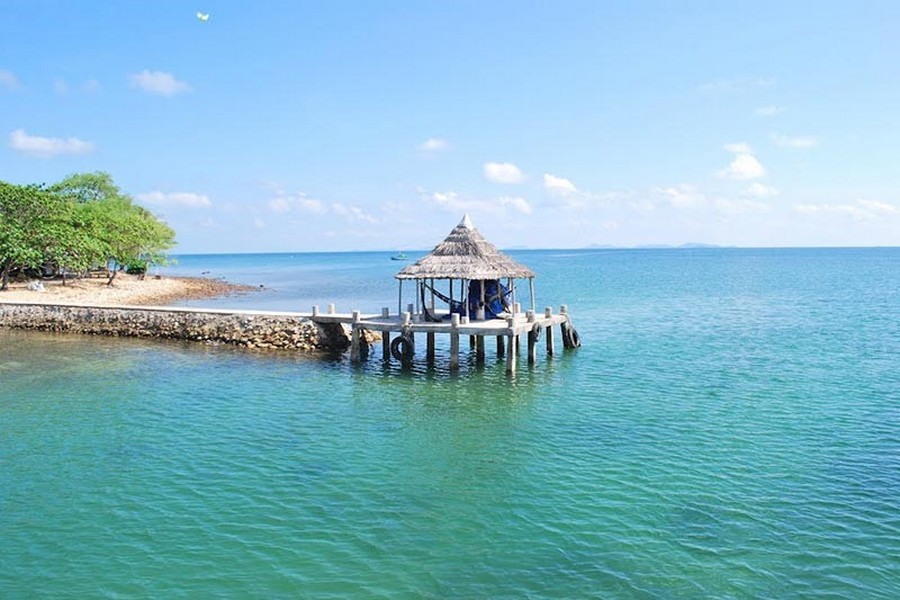
Top 10 most beautiful islands of Vietnam
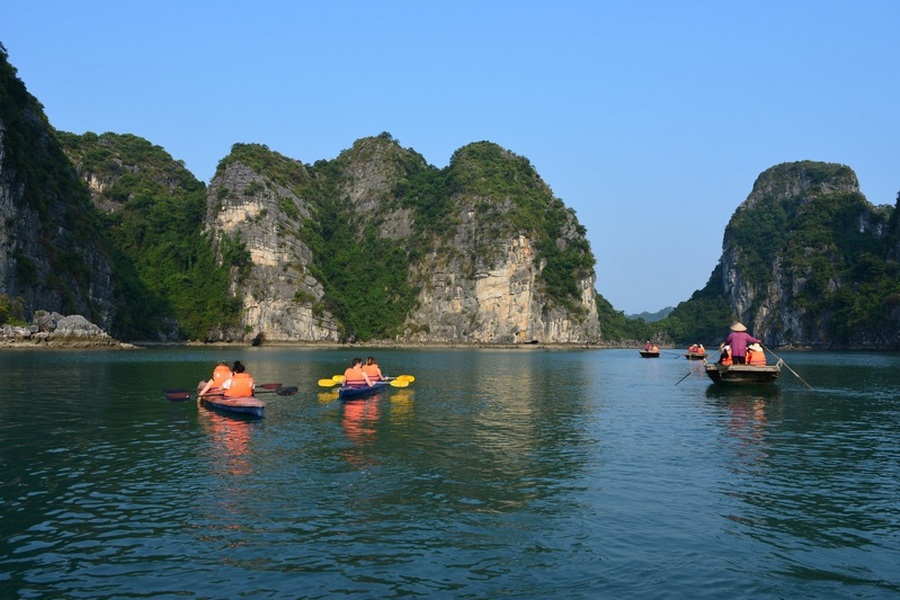
Best time to visit Halong Bay, Vietnam
Our newsletter.
Get free consultation on designing your travel itinerary in Vietnam
Don’t Miss Out! Expert trip Planning for Vietnam & Southeast Asia:
Get free itinerary designed just for you.
Looking to plan an unforgettable trip to Vietnam & Southeast Asia?
Our travel specialists have over 20 years of experience and thousands of satisfied customers. They’ll work with you to create a custom itinerary that fits your interests and ensures a memorable trip.
The Offered Consultation includes:
- A personalized itinerary tailored to your interests and preferences (FREE)
- A trip quotation that includes detailed inclusions (FREE)
- Insider knowledge and expertise from our local travel specialists. (FREE)
To claim your free consultation, simply share us with your name and your email address. We’ll be in touch with you shortly to begin planning your dream vacation.
ALL FOR FREE! Don’t wait, take the first step toward your dream Trip now.
Our team of travel specialists will create a customized itinerary for you in just 24 hours, completely free of charge. Well collaborate with you every step of the way to ensure that every detail is tailored to your satisfaction. Feel confident that you’re in good hands, and let us take care of the planning.
- Your Name *
- Your Email *
- Your Message
5/5 - (1 vote)
Vietnam Travel Guide
Where street food rules, the history is rich, and breathtaking landscapes are some of the world's best.
Best time to visit Vietnam
Best places to visit in vietnam, best things to do in ninh binh & tam coc (vietnam), 14 things to do in hoi an, vietnam, trekking in sapa: balancing on the borders of the ricefields, ha long bay: how to visit & things to do, map of vietnam, weather in vietnam.
The weather in Vietnam varies massively depending on where you are in the country. The north embraces distinct seasons, with hot, humid, and wet summers from April to October and cold, dry winters. Meanwhile, the south has perpetual heat and a distinct rainy season between May and October.
All destinations
12 things to do in hanoi, vietnam, 10 best things to do on phu quoc island, vietnam, 8 best things to do in mui ne, vietnam, unforgettable experiences, discover vietnam by motorbike with easy riders, 14 best things to do in vietnam in 2024, ha long bay, ha long bay on a budget: visit from cat ba island (vietnam), best travel insurances, how to plan a trip.
- Find Hotels via Booking.com
- Find Hostels via Hostelworld
- Find a Rental Car via Sunny Cars
- Find Flights to Vietnam via Skyscanner
- Get a Travel Insurance via Heymondo
- Book Tours & Attractions via GetYourGuide
- Book a Bus/Train/Transfer via 12Go
- Get a Visa via iVisa
- How to pack light for your trip
- How to plan your trip our tips
Why is Vietnam worth visiting?
Vietnam is an unmissable destination, from Ha Long Bay’s stunning natural wonders to Hue’s cultural gems! With diverse landscapes, vibrant cities, rich history, and world-famous, irresistible cuisine, all offering unique and enriching experiences, who wouldn’t want to visit?
Is Vietnam cheap to visit?
Vietnam is one of the cheapest countries in the world to travel in. You can enjoy delicious street food, affordable accommodations, and cultural experiences without breaking the bank, making it a budget traveler’s paradise.
Can I drink tap water in Vietnam?
Avoid drinking tap water during your time in Vietnam. Keep hydrated by filtering water using a reusable water bottle with an in-built filter system, or indulge in a delicious fresh coconut instead.
Do I need a visa for traveling in Vietnam?
While some countries such as France, Spain, Italy, and the UK get 45 days of visa-free entry to Vietnam, most other visitors need a visa for their stay. The good news is that this can now be obtained online, allowing a 90-day stay and multiple entries. Make sure to check your entry requirements well ahead of time
What language do they speak in Vietnam?
In Vietnam, the official language is Vietnamese. While English is widely spoken in all tourist areas, enhance your travel adventure by learning a few basic phrases and immersing yourself in the local culture through meaningful interactions with friendly residents.
Do I need travel insurance for Vietnam?
Travel insurance is an absolute must for all your travels! It covers everything from medical emergencies to unexpected travel hiccups, ensuring you can explore Vietnam worry-free and allowing you to focus on creating incredible memories.
Is Vietnam safe?
Vietnam is a very safe country to travel through. However, always exercise caution, keep your belongings secure, and stay vigilant against pickpockets and scams. If you’re navigating the chaotic traffic on a motorbike, prioritize safety—wear a helmet and protective gear and ensure you have comprehensive insurance coverage.
What power plug type does Vietnam have?
Vietnam mainly uses Type A, C, and F plug types but can also use types B and D. Because you can never be sure which plug type will be available, it’s worth bringing or purchasing a universal plug adapter, which will enable you to keep your devices charged throughout your Vietnam adventure.
Why do people love Vietnam?
People adore Vietnam for its captivating mix of stunning landscapes, diverse cultures, warm and genuine locals, characterful cities, mouthwatering cuisine, and distinctive coffee culture, which can all be experienced without breaking the bank. A vacation in Vietnam is definitely worth it!
Travel to Vietnam
Embark on an unforgettable journey through Vietnam’s enchanting landscapes and vibrant cultures. This Southeast Asian gem, adorned with tropical forests, limestone cliffs, and dynamic cityscapes, promises an immersive travel experience. Nestled between the bustling cities are remnants of a rich history, showcasing Vietnam’s resilience and cultural diversity. A key highlight is the delicious street food, making Vietnam a flavorsome paradise for food enthusiasts.
How to plan your trip to Vietnam
Dreaming of the perfect vacation in Vietnam ? Explore our Vietnam travel guides . Whether you’re looking to discover all the best things to do in Vietnam by motorbike , wondering how to visit Ha Long Bay on a budget , or the ‘emerald island’ of Phu Quoc , we have you covered.
For the ultimate adventure around the country, exploring limestone cliffs, vibrant cities, fascinating history, exhilarating mountain roads, pristine beaches, and diving into delicious street food, we recommend spending 3 or 4 weeks in Vietnam .
The climate in Vietnam varies from north to south, allowing you the flexibility to choose the best time for your visit, depending on where you’re planning to travel in Vietnam.
North Vietnam: In the northern regions, including the bustling capital Hanoi , summers are hot and humid, while winters bring a cooler, drier atmosphere. The best window to explore iconic destinations like Ha Long Bay is during the spring months of March to May or the fall season between September and November. During these periods, the weather is mild, and the landscapes are adorned with lush greenery, offering a picturesque backdrop for your explorations.
South Vietnam: Moving south, these regions experience a more consistent tropical climate throughout the year. The dry season from November to April is the best time to visit Vietnam to explore the southern landscapes, encompassing the Mekong Delta and the vibrant metropolis of Ho Chi Minh. The central regions, including Hoi An and Hue , also benefit from this dry period.
Public Holidays: It’s worth avoiding visiting Vietnam during public holidays such as TET and the Vietnamese New Year in late January or early February, as prices will be much higher and transport and transport services will be significantly reduced.
Coastlines and beaches in Vietnam
Vietnam’s enchanting landscapes extend beyond its bustling cities and historical sites, offering a coastline adorned with pristine beaches and breathtaking natural wonders. Hoi An , a place most known for its lantern-lit streets of the old town, is home to An Bang Beach, a 4-kilometer stretch of golden sand. Lined with deckchairs and beach bars, it provides the perfect setting to unwind while gazing at the ocean.
Just 30 minutes from Hoi An is the dynamic city of Da Nang, with delicious eateries, architectural marvels like the Dragon Bridge, and some of Vietnam’s finest beaches. Da Nang has so much to offer, whether it’s the 32-mile-long beach, My Khe, or Non-Nuoc beach, surrounded by the Marble Mountains.
In the North, Ha Long Bay , a UNESCO -listed marvel, is an iconic destination for those seeking a surreal seascape. Limestone karsts rise from the ocean, creating a scene of unparalleled beauty. Hop on a kayak and explore the bay’s many white sandy beaches, most of which are uninhabited, giving that desert island feeling.
Further down the coast, Mui Ne attracts water sports enthusiasts with its reputation as a kitesurfing hotspot. The beaches come alive with colorful kites during the day, offering a spectacle for both participants and spectators. As the sun sets, Mui Ne transforms into a tranquil haven, perfect for watching the sunset over the glistening waters.
For an island escape, head to Phu Quoc, close to Cambodia. Its white-powder beaches, turquoise waters, palm tree forests, and vibrant markets make it a paradise for nature lovers. Make sure to stop by Phu Quoc, one of the best beaches in the area.
Food, culture and religion in Vietnam
Whether you’re an adventurous backpacker, a history enthusiast, or simply someone with an appetite for new experiences, the rich culture, flavors, and experiences will capture your heart throughout your Vietnam holiday !
Culture: Vietnam’s culture goes back thousands of years, influenced by indigenous people and those from China, France, and other Southeast Asian countries. Respect for the land, sea, and people is instilled from a young age, where family bonds are treasured, art is shared, and lively rituals take place.
Cuisine: Food plays a vital role in Vietnamese culture , focusing on fresh, healthy, locally sourced ingredients full of flavors, textures, and aromas. The most well-known is Pho, a savory noodle soup that balances sweet, salty, and sour tastes, and the Banh mi, a French-inspired baguette filled with fresh ingredients.
Religion: Religion plays a significant role in Vietnamese life, with the population mainly following either Buddhism, Confucianism, Taoism, Catholicism, or Cao Dai, peacefully living happily together. For a look at some of the most breathtaking religious sites, Tran Quoc Pagoda in Hanoi, peacefully nestled on an islet of West Lake, and the vibrant Cao Dai Temple in Tay Ninh province are both worth visiting.
Why you should travel to Vietnam
Vietnam offers an adventure like no other! It’s easy to see why this Southeast Asian treasure is such a popular backpacking destination. With diverse landscapes that’ll leave you in awe, a history that comes alive, out-of-this-world budget-friendly experiences, and the warmth from locals, you’ll feel like you’ve found a home away from home.
Whether you’re cruising through the breathtaking Ha Long Bay , navigating the bustling streets of Ho Chi Minh City on a motorbike, traversing the vibrant terraced rice fields of Sapa , relaxing on an untouched island paradise, or exploring the underground remnants of the Cu Chi Tunnels, Vietnams diversity is what sets it apart.
Let’s not forget the food – it’s a flavor explosion! From steaming bowls of pho to the crunch of fresh spring rolls washed down with delicious tea or coffee, Vietnam boasts some of the best cuisine on the planet. Your taste buds are in for a treat!
Safety and Travel Advice Vietnam
When venturing into Vietnam’s captivating landscapes and vibrant cultures, it’s crucial to prioritize safety to ensure you have the most amazing travel experience.
Natural Disasters: While Vietnam is generally safe from natural disasters, staying informed is wise, especially in regions prone to occasional typhoons and flooding. Registering with your embassy for emergency updates can be invaluable, offering real-time information to navigate any unforeseen challenges during your stay.
Crime and Safety in Vietnam: Vietnam is known for its warm hospitality, yet, like any destination, visitors should exercise caution against petty theft. Keep your belongings secure, avoid isolated areas at night, and opt for well-lit, populated spaces. Vigilance enhances your overall safety and ensures a trouble-free exploration of this captivating country.
Learn more about travel safety .
Traffic in Vietnam: Navigating Vietnam’s hectic roads may involve contending with bustling traffic, steep mountains, and poorly maintained roads. If you plan to ride scooters or motorbikes, wear a helmet, protective clothing, and great travel insurance to cover unexpected accidents.
Travel Insurance: Prioritize your safety by securing comprehensive travel insurance before embarking on your vacation in Vietnam . Beyond covering potential accidents, insurance safeguards against unexpected scenarios like flight cancellations or lost baggage. This ensures you can fully immerse yourself in Vietnam’s beauty, knowing you have a safety net in place.
Find the best travel insurance for your trip .
The Essential Vietnam Travel Guide

WHAT TO KNOW BEFORE YOU VISIT
- WHERE TO STAY IN VIETNAM
- WHERE TO EAT
- WHAT TO DO IN VIETNAM
Over the past decade, Vietnam’s economic boom has ushered in a golden age of travel. Don’t just take our word for it: in 2019, Vietnam received a record-breaking 18 million international visitors. And in 2021, it was named Asia’s Leading Destination by the World Travel Awards.
Pandemic or not, Vietnam remains one of the best travel destinations on earth. From the rice terraces of Sapa to the sprawling skyscrapers of Saigon — Vietnam has it all. We’ve put together an Essential Vietnam Travel Guide to help you get to know the country better.
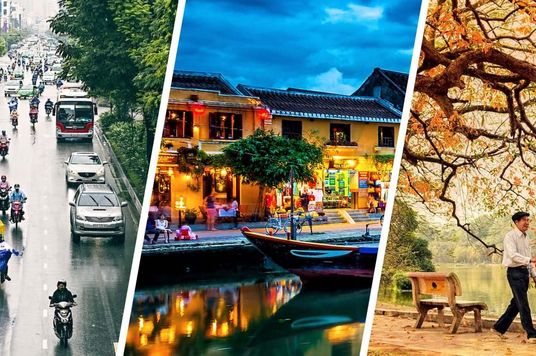
Travel Guide: When Is The Best Time To Visit Vietnam?
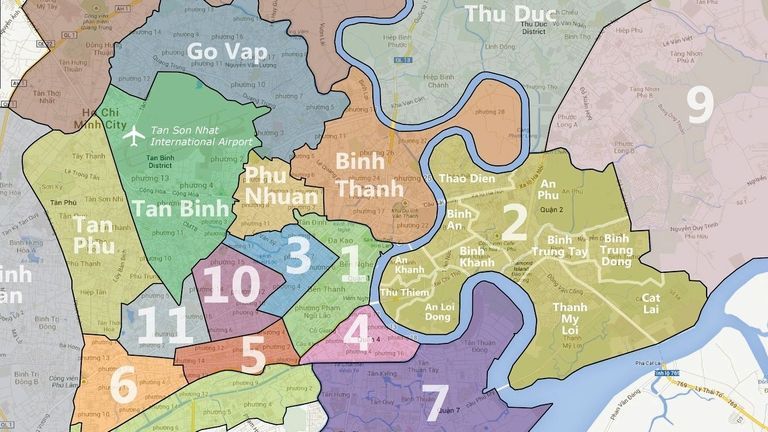
A Guide To Ho Chi Minh City’s Districts: Understanding The City

In Photos: Capturing The Chaos Of HCMC’s Rush Hour
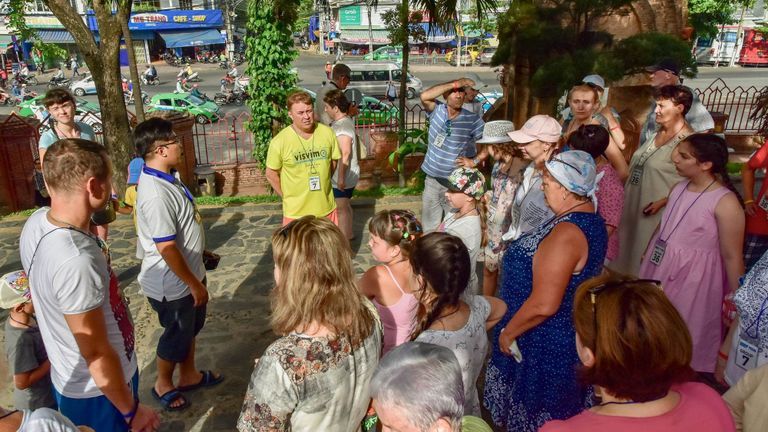
Updated: Your Checklist For Traveling To Vietnam In The New Normal
Nomadic Matt's Travel Site
Travel Better, Cheaper, Longer
Vietnam Travel Guide
Last Updated: March 19, 2024
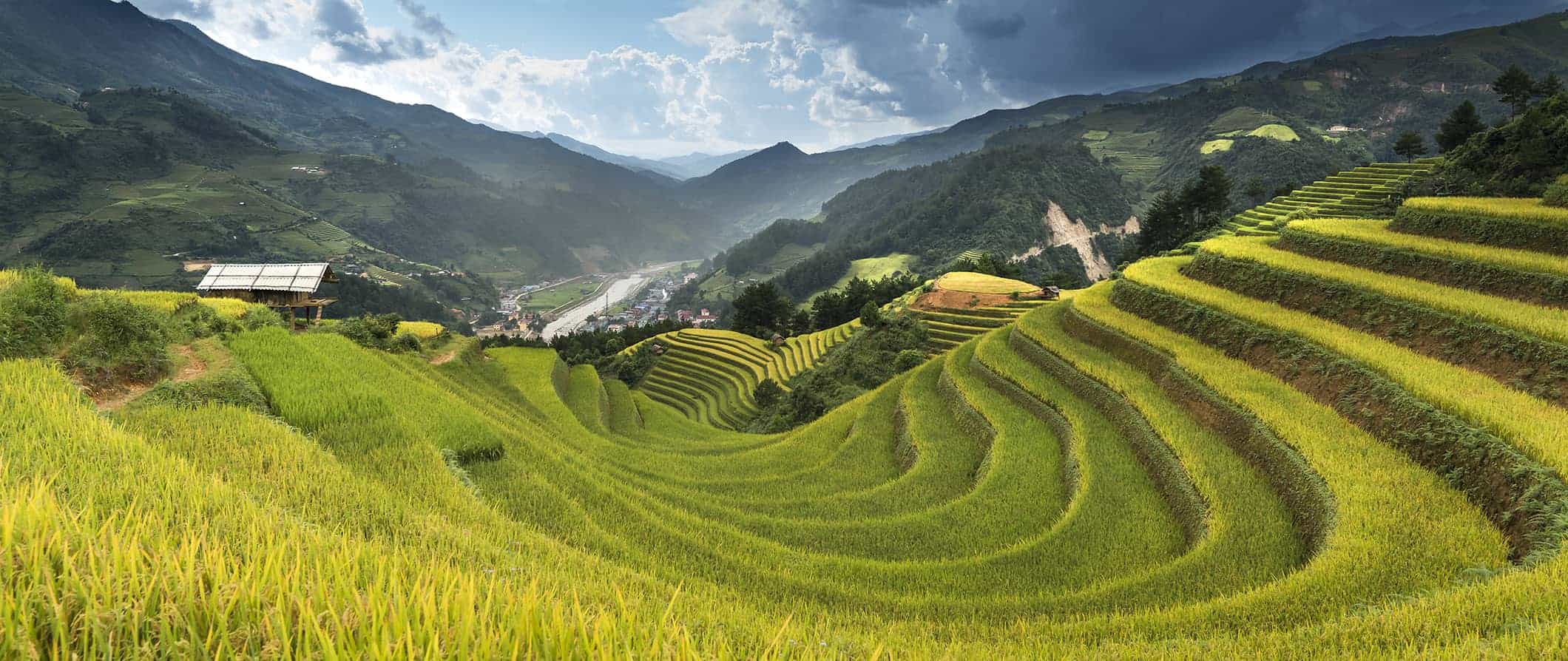
Most people either love or hate traveling in Vietnam. When I first went, there was a negative attitude towards foreign travelers (for good reason), lots of scams, and just not a lot of good vibes. But, since that trip many years ago, the country has changed a lot: it’s embraced tourism, people have opened up more, there’s fewer scams, and Ho Chi Minh City has even become a hub for digital nomads.
From exploring the Old Quarter of Hanoi to the delicious food and fancy garments of Hoi An , Vietnam has a lot to see and do so take your time. Don’t rush your trip.
This budget travel guide to Vietnam can help you plan your trip and ensure you make the most of your visit.
Table of Contents
- Things to See and Do
- Typical Costs
- Suggested Budget
- Money-Saving Tips
- Where to Stay
- How to Get Around
- How to Stay Safe
- Best Places to Book Your Trip
- Related Blogs on Vietnam
Click Here for City Guides
Top 5 things to see and do in vietnam.
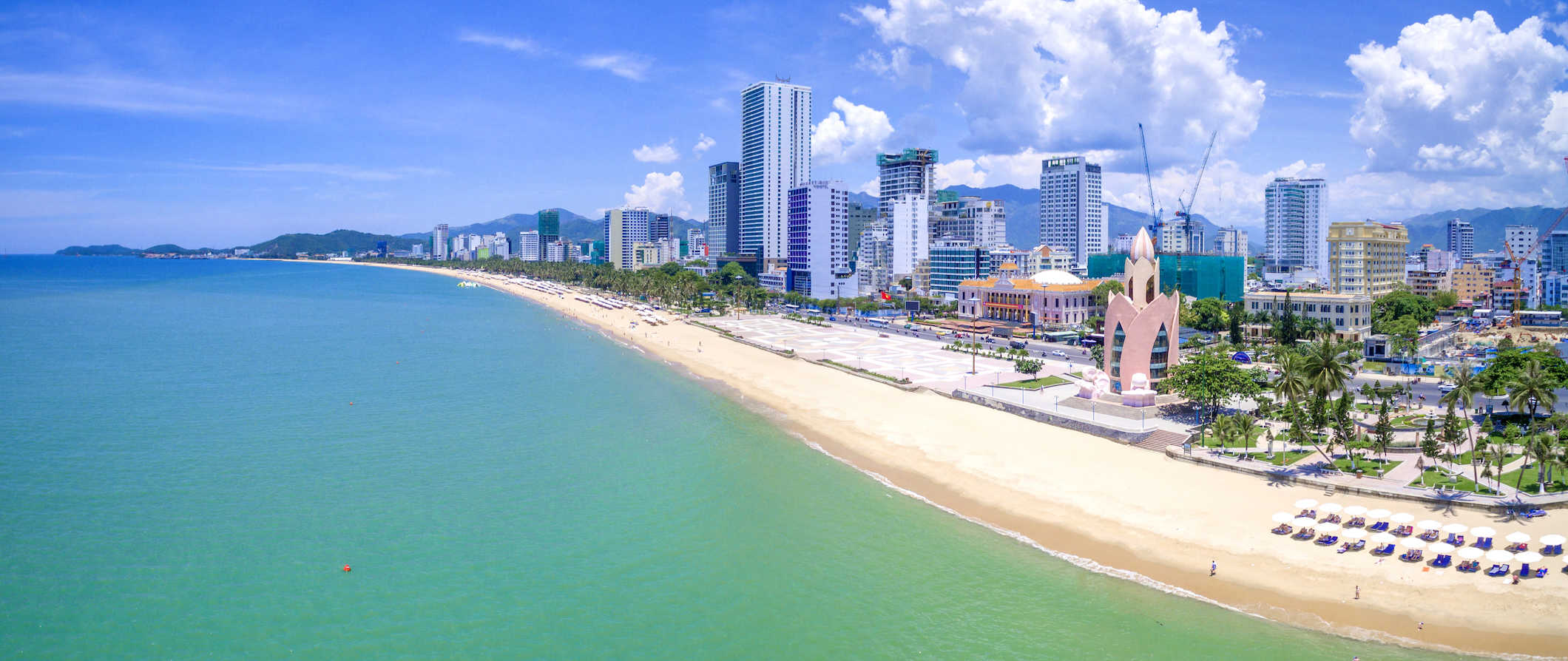
1. Tour the Mekong Delta
The delta is a 60,000-kilometer (37,000-mile) long web of interconnected waterways, which spans three Vietnamese provinces and has been used since the 4th century BCE. What I love about this area is it’s filled with small villages, pagodas, mangroves, and orchards. The best way to experience the area is to go on a boat or bike tour, where you’ll experience rural Vietnamese culture. Some of favorite things include the Cai Rang floating market for the colorful fruits and veggies and vibrant atmosphere; Vinh Trang Pagoda for its impressive golden exterior and lush gardens; and the incredible Sadec Flower Village that is stunning and serene, even if you’re not a flower enthusiast. Spend a few days really getting to know the region outside the hustle and bustle of the cities. Day trips on the river start at around 575,000 VND per person.
2. Wander Hanoi
Vietnam’s capital dates to the 3rd century BCE when it was the capital of the ancient nation of Au Lac. I love to wander around the narrow streets of the Old Quarter. It’s a great place to get a feel for the city as there are tons of vendors, smells of street food, people watching, and bustle. Some of my favorite places to visit include the One-Pillar Pagoda, the Imperial Citadel of Thang Long, and the Hanoi Water Puppet Theater. Be sure to check out the history museum to learn about French colonialism and Communist rule (from the Vietnamese perspective) as well as the Ho Chi Minh Mausoleum. Hanoi is also a good base for doing multi-day tours to Ha Long Bay.
3. Explore Ha Long Bay
This iconic region is home to more than 3,000 islands and is one of the country’s most popular tourist destinations. The towering limestone islands are covered in lush jungles and surrounded by calm emerald waters. A UNESCO World Heritage Site, it’s located 2-3 hours from Hanoi and travelers can take multi-day boat cruises around the islands (most are 2-5 days). During the cruise, you’ll visit floating markets, incredible beaches, massive caves, and either sleep onboard your boat or on one of the many islands. Just keep in mind that this area is super popular and is often overcrowded. Cheap tours start around 1,200,000 VND while a mid-range tour costs around 3,000,000-4,500,000 VND. Just remember that you get what you pay for and the cheaper boats might be a bit run down.
4. Hang out in Hoi An
Hoi An was a thriving port city between the 15th and 19th centuries and the architecture is incredibly well preserved (the entire Old Town is a UNESCO World Heritage Site). It was easily my favorite place in Vietnam because I loved walking around, taking a thrilling sidecar trip in the countryside, and of course, Vietnamese cooking classes, which are great because you learn to prepare fresh fish caught right there. This place is famous for its tailors so if you’re looking to buy some custom made clothes at an inexpensive price, this is the spot to do it in. They will even ship it back to your home country.
5. Get adventurous in Sapa
This is northern Vietnam’s premier trekking area and it’s hugely popular with all sorts of travelers. Sapa is famous for its hill tribes, lush vegetation, beautiful hiking trails, and breathtaking mountains. If you’re looking to experience the scenery and outdoor recreation opportunities Vietnam has to offer, this is the place. This area is rich in culture because it is comprised of 85% ethnic Vietnamese minority groups that have different colorful traditional dress and unique styles of houses. To avoid the tourists, come during the off-season or take longer hikes to parts the crowds don’t go to.
Other Things to See and Do
1. take a free walking tour.
The first thing I do when I visit a new destination is take a free walking tour. It’s the best way to get the lay of the land, see the main sights, and connect with a local guide who can answer all my questions. Both Hanoi and HCMH (the two largest and most popular cities in the country) have a few free tours available that cover the main highlights and are a great primer to the country (Hanoi Free Walking Tours and Saigon Free Day Tours are two companies worth checking out). Just remember to tip your guide at the end!
2. Crawl through the Cu Chi Tunnels
This extensive network of tunnels spans nearly 310 miles (500 kilometers). It was utilized by the Viet Cong during the Vietnam War. Tours involve a description of the tunnels, after which tourists are allowed to crawl about the maze and fire AK47s at shooting targets. It’s a sobering experience and not one meant for anyone claustrophobic. However, if you want to better understand the terror of the Vietnam War, this is a must-visit. Admission is around 100,000 VND per person.
3. Relax or find adventure in Dalat
Dalat is nestled in the hills of the Central Highlands and is popular with tourists who want to relax in the mountain air and those who want to participate in a host of adventure sports (such as rock climbing, ziplining, and rappelling). The hills around Dalat are filled with traditional tribal villages, which you can tour as well. Expect to pay around 2,000,000 VND per person for a full day of ziplining and rappelling around waterfalls.
4. Visit Cuc Phuong National Park
South of Hanoi lies Vietnam’s first National Park, Cuc Phuong. Covering 222 square kilometers (85 square miles), this place is home to over 2,000 species of trees and some truly rare wildlife including the Clouded Leopard, Delacour’s Langur and Owston’s Civet. It was my favorite park in all of Vietnam and the only place I didn’t find hordes of tourists. The entrance fee is 50,000 VND.
5. Explore Ho Chi Minh City
Also known as Saigon, Ho Chi Minh City is Vietnam’s largest city and is definitely worth exploring. Ho Chi Minh is the place to really gain an understanding of French colonialism as well as the US headquarters there during the Vietnam War, which you can learn more about at the War Remnants Museum. Like most cities in Vietnam, you’ll be met with the roar of motorbikes speeding through colonial streets. I loved Ben Thanh Market, which is a must-see for amazing food and there is a great buzz of activity within the place. Don’t miss your chance to get the best Pho soup in Ho Chi Minh, that means some of the best is right on the side of the street.
6. Get active in Mui Ne
Despite being a fishing village, Mui Ne has a significant tourism scene due to its popularity as a wind- and kite-surfing destination. The best highlight for me aside from the beach was riding on the rolling sand dunes similar in size to the Saharan ones and also the Jeep Tour to the Fairy Stream through a canyon, which is not something you get to do very often! Also, don’t miss the 9th-century Po Shanu Cham Towers with beautiful views of the Phan Thiet coastal town. Mui Ne is definitely worth checking out for a day or two when you’re passing by on the bus because it has a nice chill vibe to it, friendly people, and beautiful sunsets.
7. See My Son
My Son is a set of Hindu ruins in Vietnam that date back to the Cham Empire. The Champas ruled over Central Vietnam from the 3rd to the 19th century. The temples here are of incredible historical importance, but they have been largely reclaimed by the surrounding jungle, and have fallen into a great state of disrepair. Don’t come here expecting something as marvelously preserved as Borobudur or Angkor Wat. The entrance fee is 150,000 VND.
8. Visit the caves in Phong Nha-Ke Bang
Hang Son Doong is reputed to be the world’s largest cave and is located in Phong Nha-Ke Bang National Park. It was discovered by a local in 1990, and “rediscovered” by a British caving team in 2009. You can arrange trips to see this stunning cave in all its glory with stalactites and stalagmites, an inner cave forest, and even cave pearls. You’ll be blown away by its beauty. Entrance to the caves is around 150,000 VND per person.
9. Check out the rice terraces
Outside of connections to the Vietnam War, the stereotypical image of Vietnam is of the many rice paddies. You can find these in the Muong Hoa Valley. If you’ve never visited rice terraces, you should make a point to see them in Vietnam. Visit them to learn about rice production and take stunning photographs of the unbelievable Vietnamese countryside. Expect tours to cost around 600,000 VND per person.
10. Relax in Hue
Hue is generally passed by, making it a bit of a quieter stop along the tourist trail. Stroll along the beautiful Perfume River and into the Imperial Citadel. Don’t miss the Tu Hieu Pagoda and the Tombs of the Emperors, which mostly date from the 19th and 20th centuries. Some of the main tombs to see are the Tomb of Minh Mang, the Tomb of Tu Duc, and the Tomb of Khai Dinh.
11. Take a cooking class
Vietnamese food is delicious and the best way to learn about these incredible dishes is to take a cooking class. You’ll not only learn how to make some of these tasty meals but you’ll get to interact with a local chef who can teach you about their history and cultural significance. Many cooking classes also include a visit to the local market where you’ll shop for ingredients. Prices vary but expect to pay at least 800,000 VND per person.
12. Tour the former DMZ
The Vietnamese Demilitarized zone was the dividing line between the Communist north and anti-Communist south during the Vietnam War. It was in use from 1954 to 1976. These days, you can take a tour of the DMZ from Hue and learn about the conflict from expert guides who were actually involved in the war (or survived it as civilians). You’ll see secret tunnels, learn about military surveillance, and get insight about the conflict from a perspective not often shown in the media. Full-day tours from Hue start around 2,500,000 VND.
13. Buy a motorbike
If you’re an adventurous traveler, buy a motorbike and drive the length of the country. This is considered the best way to travel Vietnam by veteran backpackers who like to get off the beaten path. You can buy bikes in Hanoi or HCMC at either end of the country and then make your way to the opposite end, stopping along the way over the course of a few weeks. While it’s not for everyone, this mode of travel offers the most freedom as you’ll be able to visit a lot of places that the buses and trains don’t stop at. You can buy a bike for as little as 4,800,000 VND, and then you can sell it once your trip is done to recoup some of the cost. There are always backpackers looking to buy a bike in HCMC and Hanoi.
14. Sample the local coffee
Vietnam is the world’s second-largest coffee producer (after Brazil) exporting a whopping 1.5 million tons of it per year (after rice, it’s their biggest export). Even if you don’t drink coffee (I don’t), trying fresh coffee here is a must. Whether you just hop arounds cafes, do a tasting experience in Hanoi of HCMC, or head out to one of the many coffee plantations, learning about this vital crop (and also sampling it fresh) is an experience not to be missed. Expect a half-day plantation tour (with lots of samples) to cost around 700,000 VND.
For more information on specific cities in Vietnam, check out the following guides:
- Hanoi Travel Guide
- Ho Chi Minh City Travel Guide
- Hoi An Travel Guide
- Nha Trang Travel Guide
Vietnam Travel Costs
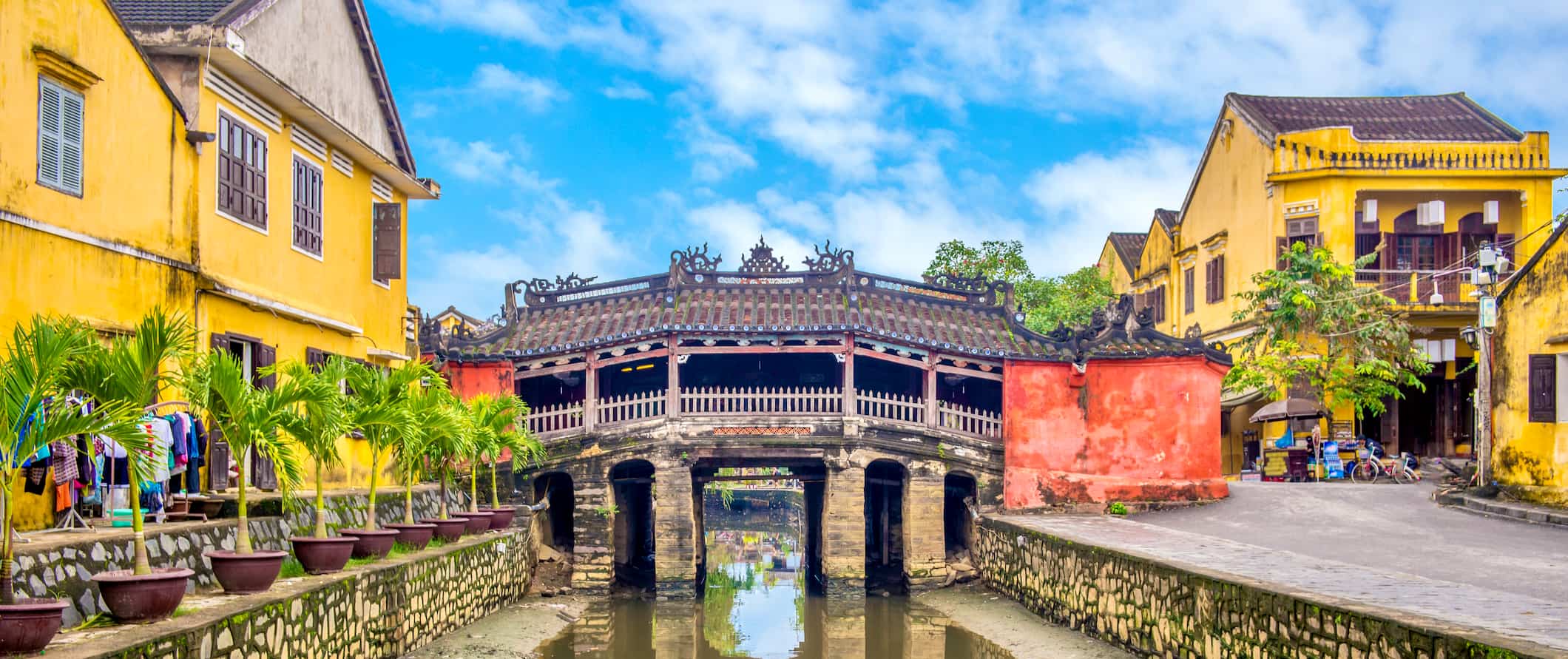
Accommodation – Hostels start at around 100,000 VND per night for a dorm room. These can be a bit rustic and no-frills. For a hostel with more amenities, such as free breakfast or a a free happy hour (as well as improved cleanliness), expect to pay double. Private rooms cost at least 350,890-425,000 VND per night for a double room. Most hostels include free Wi-Fi, and many also include free breakfast or free beer during certain hours of the day. Self-catering facilities are not very common since eating out is so cheap.
For those traveling with a tent, wild camping is not legal in Vietnam. While it is still possible to do as enforcement is sparse (especially if you’re sleeping in a hammock), I also wouldn’t recommend it. Insects and animals can be an issue, there are lots of landmines still undiscovered out in the brush, and robbery can occur. Stay safe and stick to hostels.
For a budget hotel with a double bed, expect to pay around 225,000 VND per night. This usually includes free Wi-Fi and free breakfast.
On Airbnb, a private room costs at least 325,000 VND per night. For an entire home or apartment, prices begin around 600,000 VND. Prices double when not booked in advance so plan accordingly
Food – Vietnamese cuisine is fresh, flavorful, and uses a lot of herbs and vegetables. Rice and noodle dishes are common as are various soups such as the iconic pho (a beef noodle soup). Wonton soup, meat curry, fresh French bread (known as bahn me , and grilled fish are just some of the popular dishes you’ll encounter. Standard ingredients include fish sauce, lemongrass, chili, lime, Thai basil, and mint.
You can get a bowl of pho or a rice dish for 20,000 VND. Street food is the cheapest and the most delicious food option in the country.
Most sit-down restaurants are also inexpensive at around 45,000-95,000 VND. The fancier (and more touristy) the restaurant, the more expensive.
Western food is also more expensive, usually around 110,000 VND for a fast food meal, so skip it if you’re on a budget.
If you want to splash out on a fancy three-course meal, expect to spend around 250,000 VND.
A liter of water at a convenience store is about 15,000 VND, while beer or soda is about 20,000-35,000 VND.
For those looking to cook their own meals, expect to pay at least 400,000 VND per week for basic groceries. Be sure to shop at the local markets to get the cheapest and freshest food. That being said, food is so cheap in the country that it’s simply easier – and cheaper – to just eat street food, especially as most hostels and hotels don’t have shared kitchens.
Backpacking Vietnam Suggested Budgets
On a backpacker budget, you can visit Vietnam for 600,000 VND per day. This budget covers a stay in a large hostel dorm, eating street food for all of your meals, limiting your drinking, taking the bus, and doing free activities in each destination. If you plan on drinking, add another 20,000-40,000 VND to your daily budget.
A mid-range budget of about 1,125,000 VND per day covers staying in a cheap hotel, eating street food and at the occasional sit-down restaurant, enjoying a few more drinks, taking the occasional taxi to get around, and doing more paid activities such as museum visits and water upper shows.
On an upscale budget of 2,460,000 VND, you can stay in a nice hotel, eat out for all your meals anywhere you want, enjoy lots of drinks, and more taxis, and do whatever tours and activities you want, including a multi-day trip to Ha Long Bay. This is just the ground floor for luxury though. The sky is the limit!
Vietnam Travel Guide: Money-Saving Tips
Vietnam is a very affordable country. In fact, it’s one of the cheapest in Southeast Asia. Even with the explosion of tourism in the last few years, it still remains very affordable. You’ll be hard pressed to spend money if you’re sticking to non-Western food, cocktails, and hotels. However, if you’re looking to travel even cheaper and save some money, here are some tips:
- Eat delicious street food – The street food here is excellent and cheap, and you can watch it being cooked in front of you. Stick to the local food and you’ll save money. The street-side pho, bread, sandwiches, donuts, and bananas are your best deals.
- Late-night travel – If traveling on long journeys, try to take the late-night “sleeper” buses or trains as these will save you the cost of a night’s accommodation. Depending on the company, you may even have a chance to comfortably lie flat as you ride through the dark countryside to your next destination.
- Take the tourist bus – It is actually cheaper to take the tourist bus around the country than taking local transportation because of the “tourist” price you get at the bus station. Tickets from one end of the country to another are very affordable.
- Fly for cheap – Vietnam’s low-cost airlines VietJet and FlyVietnam are extremely inexpensive. This is a great option for people with limited time to explore different regions of Vietnam. Both airlines frequently offer special deals and at the time of writing this, Hanoi to Da Nang is just 820,000 VND!
- Bargain hard – Tourists tend to be charged more than locals for everything from cyclos (a three-wheel bicycle taxi) to clothes to street food. Bargain harder than you would ordinarily, and don’t underestimate the value of walking away.
- Avoid paying tourist prices – Before you leave the hostel, ask them to estimate how much what you want to do should cost. How much should a ride to the museum cost? How much should I pay to have a gown like this made? They will be able to give you bargaining guidelines.
- Bring a reusable water bottle – The tap water in Hanoi is not safe to drink. To save money and reduce your plastic use, bring a reusable water bottle with you. LifeStraw make a reusable bottle with a built-in filter so you can be sure your water is always safe and clean.
Where to Stay in Vietnam
To help you save money on accommodation, here’s a list of my recommended hostels and budget hotels in Vietnam:
- Mad Monkey (Hoi An)
- Hoi An Golden Holiday Hotel (Hoi An)
- Little Hanoi Hostel (Hanoi)
- San Palace Hotel & Spa (Hanoi)
- Hanoi House Hostel & Travel (Hanoi)
- Ccasa Hostel & Coffee Bar (Nha Trang)
- The Hideout (HCMC)
- Orchid’s Saigon Hotel (HCMC)
How to Get Around Vietnam
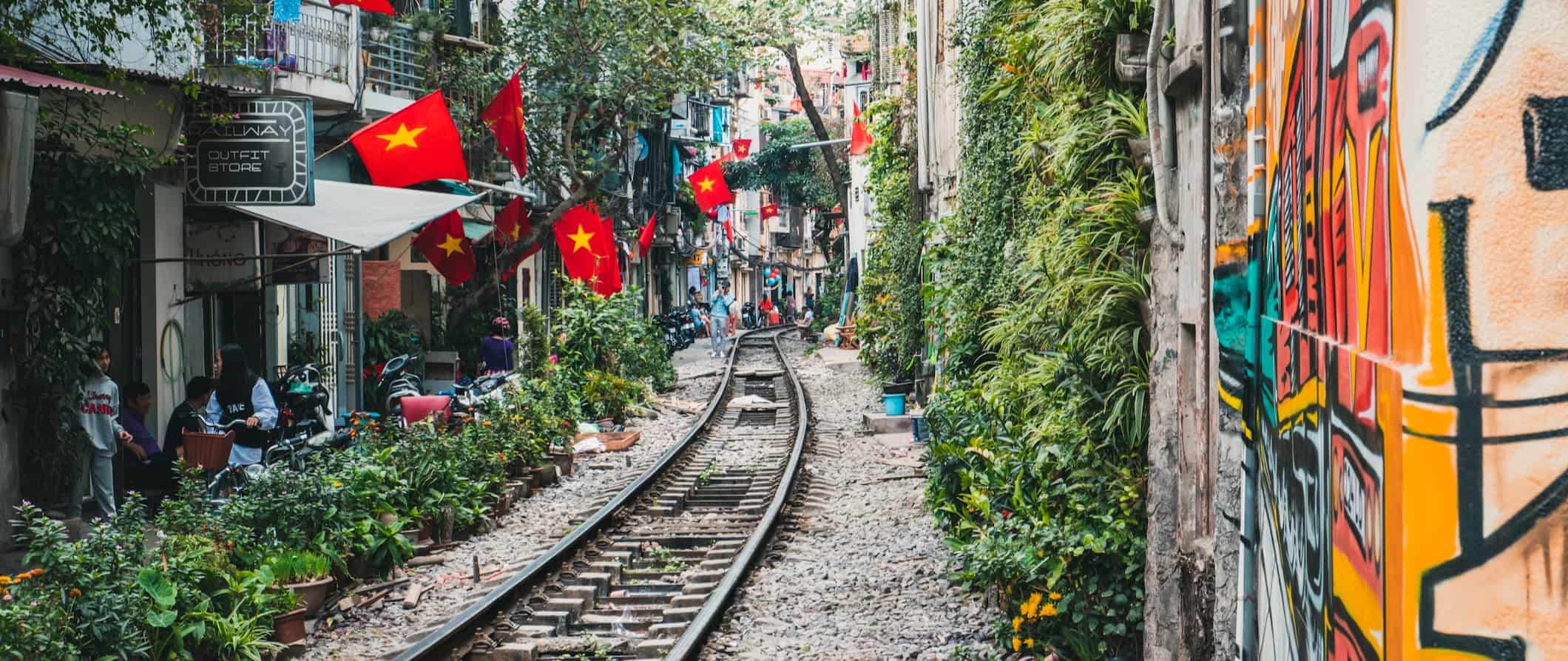
Public transportation – Larger cities in Vietnam (such as Hanoi and HCMC) have reliable and safe public transportation. In Hanoi, there are buses that cover most of the city and generally have stops near all the major tourist sites. Tickets are paid for in cash on the bus and generally cost 7,000-15,000 VND depending on how far you go. HCMC also has a large network of buses, with tickets costing up to 10,000 VND (again, depending on how far you travel).
Cyclos (a bicycle rickshaw) is one of the cheapest ways to get around. A short ride costs as little as 12,000 VND, while a longer night ride costs upwards of 40,000 VND. A more popular option is the ze om , a motorbike taxi that has fares starting from 15,000 VND. You’ll have to hold on tight though (and make sure you wear a helmet as accidents are common).
Train – A lot of people love taking the train in Vietnam because it’s safe, affordable, and comfortable and, although some routes might be slow, you’ll get some amazing views of the Vietnamese countryside. The rail network also covers most of the country, so you can get just about everywhere you want to go (except the Central Highlands and the Mekong Delta). You can use the website Baolau to research train schedules and book your tickets. A train journey between Ho Chi Minh and Hanoi (which spans the entire length of the country) starts at 1,000,000 VND for a soft seat (not a berth). The journey takes three days. Hanoi to Hue costs around 600,000 VND and takes around 13 hours while HCMC to Nha Trang costs around 500,000 VND and takes 8 hours.
Bus – It’s easy to find long-distance hop on, hop off bus tours running the length of Vietnam. You can hop on or off at any stop along the way. They cater to tourists, but locals actually use this service too since it’s super affordable. Prices depend on route and operator but generally, Hanoi to Ho Chi Minh is between 815,000-1,600,000 VND.
Flying – Flying domestically in Vietnam is a good idea if you’re looking to fit a lot into a shorter trip. For example, a flight from Hanoi to Ho Chi Minh City takes two hours while the train ride would take at least 30 hours. One-way flights around the country start at around 590,000 VND.
Car rental – Vietnam is very easy to navigate by bus, so I don’t really suggest renting a car here — especially because traffic in the cities is very hectic and accidents are common. That said, car rentals are affordable, costing around 500,000 VND per day. An IDP (International Driving Permit) is required. For the best car rental prices, use Discover Cars .
When to Go to Vietnam
In the southern part of Vietnam, the dry season lasts from December to late April/May while the rainy season occurs from May to the end of November. The rainy season usually just means brief heavy downpours in the afternoon, although sometimes the Mekong Delta will flood. The dry season is the best time to visit but keep in mind that it’s winter up north and it’s going to be a lot colder in the north than the south. Rainy season isn’t that bad either but, like the name implies, it rains a lot.
May through November is still a good time to visit. Temperatures rarely dip below 20°C (68°F), but they can sometimes get as high as 40°C (104°F) in the hottest months (March to the end of May). The south especially gets very hot and humid during this time but it’s perfect beach weather!
Along the central coast, the rainfall pattern differs quite a bit. In the northern part of the region (like Hué and Da Nang), the rain lasts from September to February. February to May is the best time to visit this area. Temperatures soar from June to August, often in the high 30s°C (80s°F).
In Northern Vietnam, the weather is most pleasant from October to December.
The weather in Vietnam varies so much per region so it’s hard to pick the best time to go. But generally, it’s recommended to visit sometime between September-December and March-April if you’re hoping to get an overall experience in the country.
How to Stay Safe in Vietnam
Vietnam is an incredibly safe place to backpack and travel. Violent crime is really, really rare. Petty theft is the most likely thing to happen to you here. Always keep your valuables secure when out and about just to be safe. Lock your windows and use common safety sense, especially in bars at night and in touristy areas.
Traffic in the major cities (specifically Hanoi) is super hectic and there are virtually no rules of the road. There are also millions of motorbikes and scooters here (literally). For that reason, take extra caution when crossing the street. It’s best to just walk as directly and calmly as possible and let the traffic weave around you. If you’re not comfortable doing that alone, follow locals when they cross.
If renting a bike or riding on the back of one, make sure you always wear a helmet. Accidents are incredibly common here, both in the traffic-heavy cities but also in rural areas where roads can be less than optimal.
There are some common scams in Vietnam, such as the motorbike scam where vendors try to charge you for pre-existing damage to your bike rental. When renting anything, take photos and videos beforehand just in case.
Be sure to always count your change. The money is similar looking here so oftentimes people will “mistakenly” give you the wrong change hoping you won’t notice that the 200,000 VND bill you just got is actually only 20,000. Always count your change here!
Most scams here are really just people trying to try to nickel and dime you and try to get you to spend extra money since they know, as a tourist, you have more than they do. You can read about common travel scams to avoid here .
Solo female travelers should generally feel safe here, however, the standard precautions apply (never leave your drink unattended at the bar, never walk home alone intoxicated, etc.). Use common sense when using dating apps while traveling and meet in public places.
Street food here is very safe, but whenever you’re not sure of where to eat simply find somewhere where there are locals eating. If it’s good (and safe) enough for them, you should be fine. Avoid meat that looks uncooked or that has been out in the sun too long. Always wash your hands before and after eating just to be safe.
If you experience an emergency, dial 113 for assistance.
Be sure to make copies of your important documents in case of theft.
The most important piece of advice I can offer is to purchase good travel insurance. Travel insurance will protect you against illness, injury, theft, and cancellations. It’s comprehensive protection in case anything goes wrong. I never go on a trip without it as I’ve had to use it many times in the past.
Vietnam Travel Guide: The Best Booking Resources
These are my favorite companies to use when I travel. They consistently have the best deals, offer world-class customer service and great value, and overall, are better than their competitors. They are the companies I use the most and are always the starting point in my search for travel deals.
- Skyscanner – Skyscanner is my favorite flight search engine. They search small websites and budget airlines that larger search sites tend to miss. They are hands down the number one place to start.
- Hostelworld – This is the best hostel accommodation site out there with the largest inventory, best search interface, and widest availability.
- Agoda – Other than Hostelworld, Agoda is the best hotel accommodation site for Asia.
- Booking.com – The best all around booking site that constantly provides the cheapest and lowest rates. They have the widest selection of budget accommodation. In all my tests, they’ve always had the cheapest rates out of all the booking websites.
- Get Your Guide – Get Your Guide is a huge online marketplace for tours and excursions. They have tons of tour options available in cities all around the world, including everything from cooking classes, walking tours, street art lessons, and more!
- SafetyWing – Safety Wing offers convenient and affordable plans tailored to digital nomads and long-term travelers. They have cheap monthly plans, great customer service, and an easy-to-use claims process that makes it perfect for those on the road.
- LifeStraw – My go-to company for reusable water bottles with built-in filters so you can ensure your drinking water is always clean and safe.
- Unbound Merino – They make lightweight, durable, easy-to-clean travel clothing.
Vietnam Travel Guide: Related Articles
Want more info? Check out all the articles I’ve written on Vietnam travel and continue planning your trip:

Is Southeast Asia Safe for Travelers?
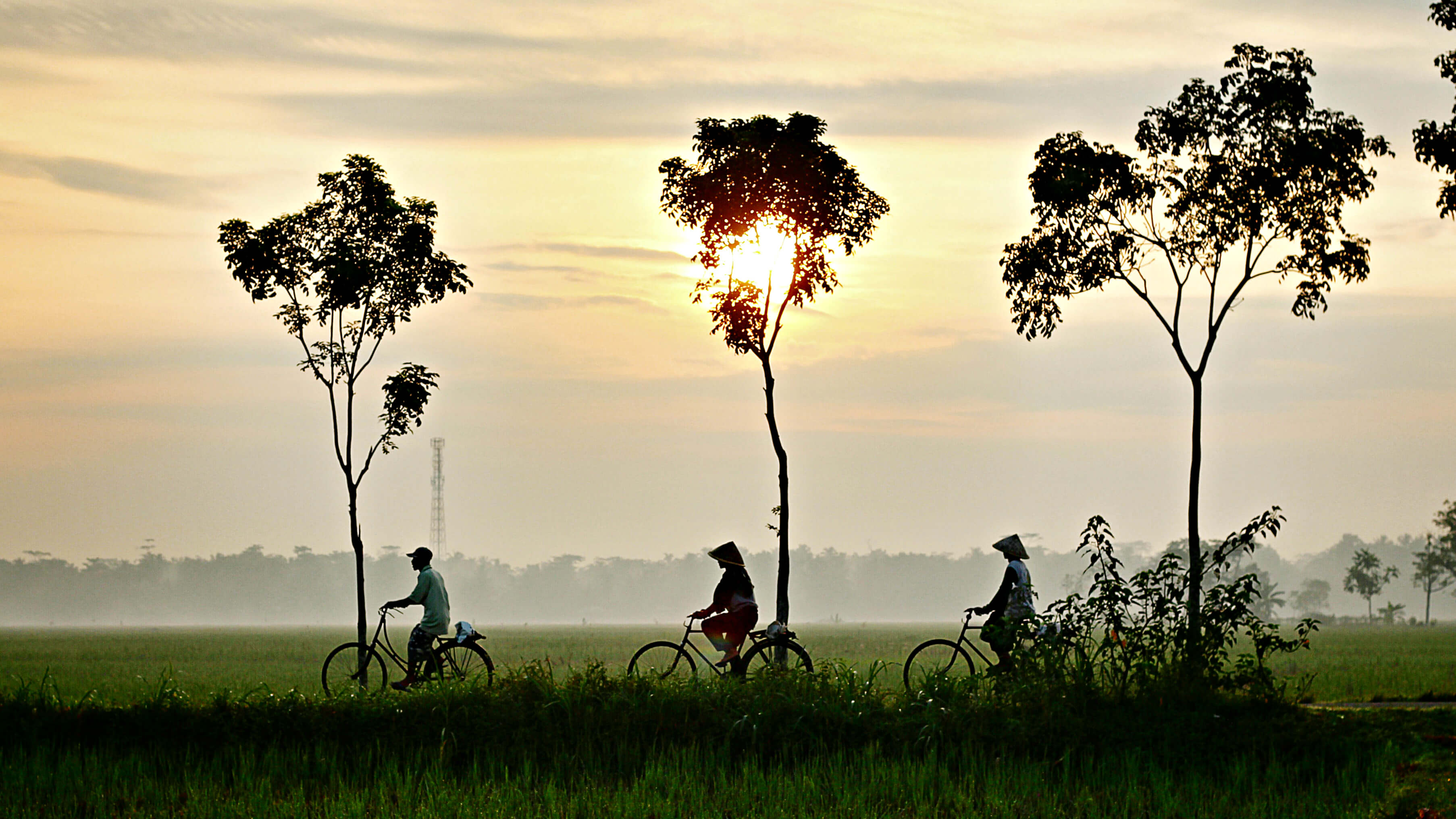
Biking the Mekong Delta in Vietnam
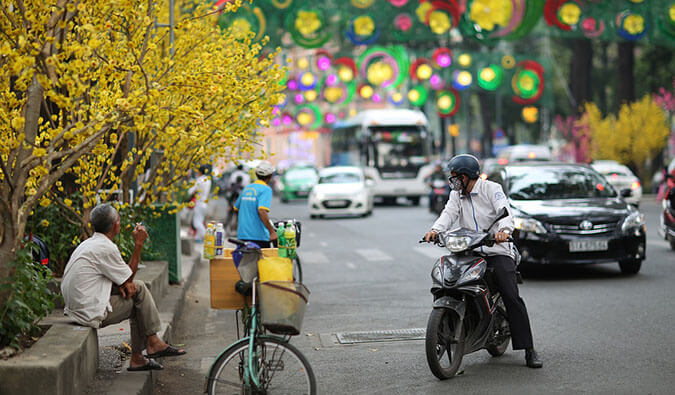
Why I’ll Never Return to Vietnam
Get my best stuff sent straight to you, pin it on pinterest.
- Where To Stay
- Transportation
- Booking Resources
- Related Blogs
23 things to know before visiting Vietnam

Aug 7, 2023 • 10 min read
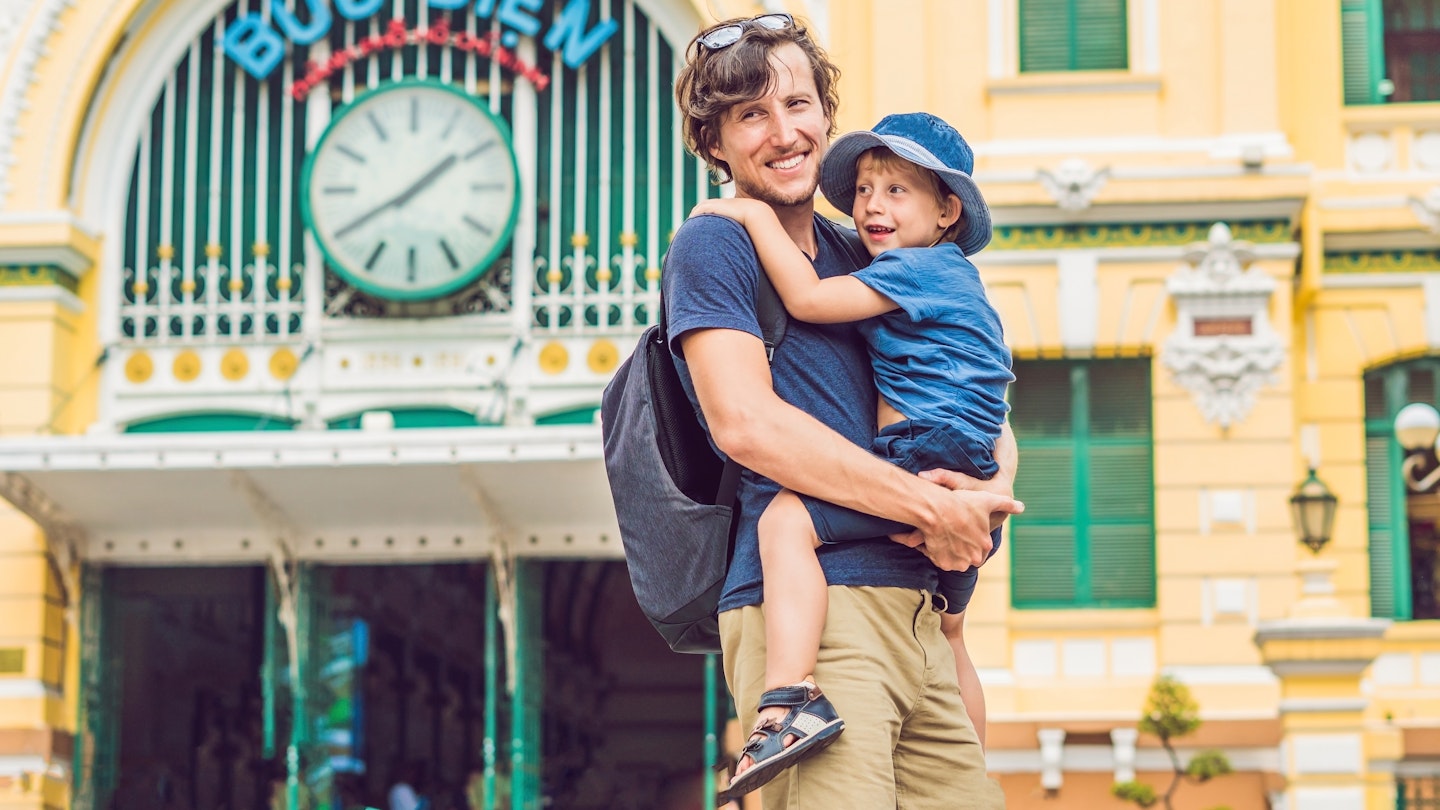
Read on for all the key things to know before you visit Vietnam © Elizaveta Galitckaia / Shutterstock
Adventures abound in Vietnam . You can climb the heights and scuba dive the lows, immerse yourself in culture or just kick back on the sand, confident in the knowledge that a fantastic meal is waiting for you at the end of the day. But there are things to know before you go, to avoid pitfalls in paradise. These are our top tips.
1. Pack for the climate
Perhaps the most important consideration when planning a trip to Vietnam is the weather. The south of the country sits firmly in the humid tropics, but the climate becomes increasingly temperate as you head north, and the highlands around Sapa can be downright chilly in winter. If you plan to visit both halves of the country, bring some clothes for the cooler highlands as well as the steamy Mekong Delta .

2. Be rain ready
Vietnam is soaked by the southwest monsoon from May to September and the northeast monsoon from October to April, so check the weather in the areas you plan to visit. Trekking in the northwest and boat trips in Halong Bay , for example, can be a soggy experience in July and August, but this is a great – if popular – time to bask on the central beaches. Even in the rainy season, it doesn’t rain all day, every day, so bring a raincoat or umbrella and make the best of the smaller crowds and lower prices.
3. Investigate the visa options
There are numerous ways to arrange the paperwork for a visit to Vietnam, some cheaper and quicker than others. You may not need a visa at all for a short trip, and electronic visas and visas on arrival are available for many nationalities – much less hassle than going to the embassy in person. Read up on the visa requirements before you book your flights, to avoid paying more than you need to, or getting held up by red tape.
4. Get your jabs
As with anywhere in the tropics, there are tropical illnesses to be aware of in Vietnam. See your doctor at least a month before you travel to get up to date with vaccinations, and arrange anti-malarial medication if you plan to visit rural areas.
Mosquitoes can also carry dengue fever, so bring repellent. On arrival, avoid drinking tap water and use antibacterial hand gel to reduce the risk of stomach bugs; a medical face mask can reduce the risk of respiratory infections and help with pollution in big cities.

5. Book ahead for Tet and the holiday peak
Booking transport, accommodation and tours ahead of time is not essential, but it’s a good way to avoid disappointment if you come at a busy time , such as July and August on the central coast. If you plan to be in Vietnam during the Tet (Lunar New Year) festival in late January or early February, having transport and accommodation in place before you arrive is a very sensible precaution.
There is a caveat, however – book directly with operators where possible. If you go through an agency, you’ll pay more, and some travelers have reported not getting the services and standards they were expecting when booking through third parties.
6. Factor sleeper buses and trains into your itinerary
Domestic flights in Vietnam are inexpensive but there are less polluting alternatives. When planning long-distance travel , don’t overlook the country’s overnight trains and buses – you’ll save the cost of a night’s accommodation and cover big distances, without eating into your sightseeing time. Reserve a fully horizontal berth for a more comfortable night’s sleep – both buses and trains have them. The booking site 12Go Asia is a good place to start investigating the options.
7. Give Vietnam the time it deserves
Vietnam measures 1650km (1025 miles) from the Chinese border in the north to the Mekong Delta in the south, so you’ll need plenty of time to get from A to B. Road and rail transport can be slow, and there are lots of places where you’ll want to stop as you travel between the major hubs. If you only have a short time, focus your itinerary on a small area – Hanoi and around, say, or Ho Chi Minh City (HCMC) and the Delta.
8. Respect religious spaces
When visiting Buddhist, Hindu, Confucian and Taoist temples, churches and other religious buildings, dress respectfully – it’s best to cover your legs and upper arms, and you may need to take off your shoes and hat to enter. Never touch anyone on the head, and avoid pointing the soles of your feet towards another person or any Buddhist statues – both signs of disrespect in Buddhist culture.
9. Don’t lose face
As in many other parts of Asia, Vietnamese culture places considerable emphasis on "saving face" – in other words, avoiding situations that might cause individual or collective loss of dignity and respect. Public outbursts and arguments can cause everyone involved to lose face, so keep a sense of perspective, and try not to get angry when confronted by inconveniences as you travel.

10. Do right with your chopsticks
There are several taboos associated with using chopsticks. Leaving your sticks sticking upright in a bowl of food is considered unlucky, as it resembles offerings of incense sticks made for the dead. Using chopsticks of uneven length is also frowned on, as is tapping your bowl with your sticks (associated with beggars requesting alms). If you eat in a group, use clean chopsticks (or the reverse ends of your own chopsticks) to pass food to others.
11. Eat like a local
Food is practically a religion in Vietnam, but locals focus their energy on the evening meal, where multiple dishes are shared between diners, with the whole family getting involved. Rather than ordering a single main course, choose a spread of dishes for the table and sample a rich mix of flavors and textures. If you need a boost between meals, street food snacks can be found everywhere, or just grab a nutritious sinh tố (fruit shake) or a cup of local drip-brewed ca phe (coffee).
12. Don’t go overboard with displays of affection
Public displays of affection are not a big part of Vietnamese culture, for couples of all orientations. Kissing, hugging and even holding hands in public can raise eyebrows, so tone down the romantic gestures while you’re in the country. On the plus side, despite lingering legal inequality, LGBTIQ+ couples generally face few problems in Vietnam, and Hanoi and Ho Chi Minh City (HCMC) both have lively scenes.

13. Be a respectful photographer
Always ask before taking photographs of people, particularly in minority villages. Many people find it intrusive, and by asking first, you’ll know if people are comfortable being included in your travel photos. In tribal areas, some villagers ask for payment for photos, which is fair enough... how would you feel if strangers kept sticking a long lens into your front porch?
14. Don’t get dragged into Vietnamese politics
Another time to think twice before pulling out your camera is during public demonstrations and political rallies. Critics of the government can face harsh punishments – demonstrations in 2018 against laws allowing the authorities to monitor online communications led to over 100 arrests. Play it safe – steer clear of political gatherings and avoid conversations about politics with local people.
15. Be a fair bargainer
Haggling is a fact of life in Vietnam, particularly at markets and souvenir shops, and you may pay over the odds if you accept the first price suggested. However, bargaining should never be a confrontational process – treat it as a game and counter the starting price with a lower counter offer, and see how the seller responds. With a bit of back and forth, you should reach a mutually acceptable price – and if you don’t, you can always decline politely and try another vendor. There’s little point haggling over tiny sums of money – if you pay 5000 dong (US$0.20) over the going rate, consider that you can probably afford it.
16. Know your loos
Western-style sit-down toilets are increasingly common in Vietnam, but you’ll often have to pay to use public loos, and paper is rarely provided. Carry your own, or use the hose or water jug provided. Bring antibacterial hand gel or soap; many bathrooms only provide running water.
17. Don’t let touts take you for a ride
Commission-seeking middle men (and middle women) pop up almost anywhere tourists gather, and Vietnam has its share. Be wary of touts who encourage visitors to use certain tour agencies, hotels, shops and transport companies in touristy parts of Hanoi, Ho Chi Minh City and Hoi An. If you use their services, you’ll pay more to cover their fee.

18. Avoid the sex tourism industry
Sex tourism is an unwelcome legacy of the American War, but it’s usually easy to spot – and avoid – places where the sex trade takes place. Be wary of bars, karaoke lounges and massage parlors with scantily clad staff and lots of pink or red neon. Note that some hotels refuse to allow foreign men to share rooms with Vietnamese women – which can lead to headaches for genuine couples with an Asian partner.
19. Give drugs a pass
Illegal drugs aren’t hard to find on the traveler circuit in Vietnam, but the penalties, if you’re caught by the police, can be severe – even for possession of small amounts. Many travelers have ended up in Vietnamese jails for drug offenses, and the death penalty can be applied in drug cases. If you are inclined to toke while you travel, it’s only a short hop to Thailand , where the consumption of marijuana in food and drinks has been decriminalized for now.
20. Shop responsibly
Vietnam has some wonderful crafts and art forms that make for great souvenirs, but stick to modern pieces; it’s illegal to take antiques out of the country. Also be watchful for souvenirs made from animal parts, such as shell, horn, bone, teeth and feathers. Such items are usually taken from wild animals, and you could fall foul of the Convention on International Trade in Endangered Species (CITES) .
21. Be smart about crime, not anxious
Opportunistic crime can occasionally be a problem, particularly in crowded cities where pickpockets and bag-snatchers on motorcycles take advantage of the unwary, but this isn’t a problem unique to Vietnam. Activate your big city precautions, and watch your belongings on busy public transport or in bars and cafes (using a phone or laptop at an outside table is unwise). Handbags with a single strap are a popular target for ride-by bag snatchers – a daypack or messenger bag is a better option.
22. Be wary of American War ordnance
Horrifying volumes of munitions were dropped over Vietnam during the American War, and unexploded ordnance continues to kill and maim people every year. Well-traveled areas are usually safe, but be cautious about stepping off roads and paths in rural areas. Don’t climb into bomb craters and never touch old explosive devices – they can remain deadly for decades.
23. Be typhoon smart
Vietnam is hit by periodic typhoons between May and November, with the biggest risk of storms from August to September. If you travel during the typhoon season, monitor local weather reports, and head inland from the coast if a direct hit by a big storm is predicted. In the event of flooding, contact your embassy or consulate and follow advice from the local authorities.
Explore related stories
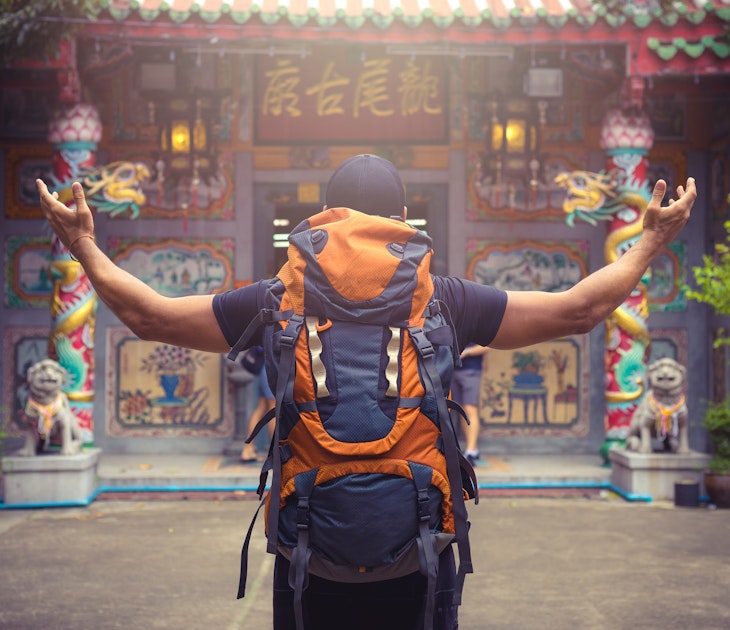
Festivals & Events
Apr 8, 2024 • 6 min read
With three seasons – hot, rainy and (comparatively) cool – Bangkok offers very different experiences throughout the year. Here's the best time to visit.
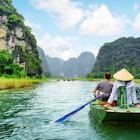
Mar 14, 2024 • 10 min read

Feb 24, 2024 • 8 min read
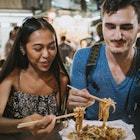
Feb 23, 2024 • 7 min read

Feb 22, 2024 • 5 min read

Feb 3, 2024 • 7 min read
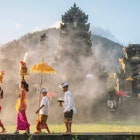
Jan 17, 2024 • 6 min read

Jan 17, 2024 • 8 min read

Jan 11, 2024 • 4 min read

Jan 5, 2024 • 20 min read
Last updated on October 31, 2023 by Shannon
While lumped together with Southeast Asia for geographic and tourism purposes, Vietnam stands out as a destination unique among its neighbors. Each region balances the other.
The frenetic chaos in Saigon is just a stone’s throw from the sleepy colonial towns in the Mekong Delta. Hoi An’s charming, historic ancient town is a mere 40 minutes from the fast-growing and friendly Danang.
History and tradition infuse every aspect of life in Vietnam—from food to religion—and the culture and people are remarkably welcoming to tourism, having built a thriving industry that makes traveling and backpacking in Vietnam unforgettable.
As such, modern Vietnam is a favorite hotspot for budget-loving backpackers traveling Southeast Asia , and destination travelers from all over the world. Although I had spent years traveling other regions of Asia, Vietnam was my final country to visit on mainland Southeast Asia. What an incredible experience.
I have no idea what took me so long to backpack through Vietnam. I spent three months traveling south to north and I discovered cities across the country highlighting various aspects of Vietnam’s long history. I traveled from the War Remnants museum in Ho Chi Minh City to the Japanese and Chinese influenced Hoi An to the French-influenced coffee and baguette culture throughout.
Vibrant, unique, chaotic, traditional—no single word sums the experience of traveling Vietnam.
If you’re visiting Vietnam, this guide covers the essential travel information you should know, pre-trip reading , how to travel responsibly in Vietnam, and specific travel and accommodation recommendations to jumpstart your research.
Table of Contents
Things to Know Before Traveling to Vietnam
Vietnam has a lengthy and complex history, with each layer still visible in modern Vietnam. From tangible evidence of French colonial rule to the aftereffects of the American War and a food culture deeply influenced by the international flavors and cultures—this country has a lot on offer from north to south.
Vietnam has a lengthy and complex history, with each layer still visible in modern Vietnam. Consider this a quick rundown on the basic backstory you’ll need to understand and enjoy traveling and backpacking through Vietnam. Ruled by the Chinese in 111 B.C., Nam Viet (what we now know as Vietnam) was a part of the Han Dynasty.
Over the next thousand years or so, Vietnam remained in the hands of the tyrannical Chinese, before regaining full control of their country in the 15th century. By the middle of the 17th century, Vietnam’s independence was being chipped away by France and in 1884 France gained full colonial control over Vietnam.
France’s impact on Vietnam is a living, breathing, tangible part of modern Vietnam, which is why you need to understand this history before traveling there. The French brought a Western-style education system, European architecture and food, and also instituted political and cultural changes.
Not surprisingly, despite some good brought by the French, many Vietnamese were unhappy with colonial rule. The Viet Minh attacked French forces in 1946, which eventually ended with Geneva peace talks between the nations and the decision to split Vietnam in half: north and south. The communist insurgency began 1957 in South Vietnam; two years later, weapons and men from North Vietnam began gathering in the south.
In response, the United States increased aid to President Ngo Dinh Diem. By 1963, the Viet Cong, a communist group specializing in guerrilla warfare, defeated The Army of the Republic of Vietnam. In a U.S.-backed military coup, representatives from The Army of Republic of Vietnam overthrew and killed the President Diem ; U.S. intervention in Vietnam would only escalate from this point forward.
In response to the threats posed by the North Vietnamese and the Viet Cong, by 1967 the U.S. had sent roughly 500,000 troops to Vietnam. The Vietnam/American War lasted far too long, fueled by poor decisions made by U.S. politicians and resulting in horrifying escalation of violence throughout the war (this is a sad and informative visual history of the war ).
Many thousands of people were killed before Paris peace talks brokered a ceasefire agreement in 1973. By that point, the actions by American troops had forever changed the country as the after-effects of Agent Orange and other chemical weapons continue to impact the Vietnam even today.
Two years after U.S. troops left, North Vietnam invaded the south and took control of the country. As the socialists assumed control over the country, hundreds of thousands of Vietnamese continued to flee, many resorting to crowding into small vessels—anything to escape life in Vietnam. This war is one key reason for the massive Vietnamese diaspora spread around the world.
It’d be great if the warfare ended there, but tired of the Khmer Rouge attacking remote villages near the border, Vietnam invaded Cambodia in 1979 and removed the Khmer Rouge and Pol Pot from power. Ten years later, Vietnam removed their troops from Cambodia. There is still a large ethnically Khmer population in Vietnam’s Mekong Delta region. Since the 90s, Vietnam has grown and the government has stabilized, with tourism a major contributing part of the country’s economy.
Fast Facts About Vietnam Travel
Vietnamese Dong (VND) ( current exchange rate )
Electricity
127V/60Hz (American or European plugs both work here, although only without the third prong)
Primary Airports in Vietnam
- Saigon’s Tan Son Nhat Airport (SGN)
- Hanoi’s Noi Bai Airport (HAN)
- Da Nang International (DAD).
Can you drink the water in Vietnam?
No, it’s not safe to drink the local water in Vietnam. Drink bottled, bring a reusable water bottle so you can buy big jugs, or consider the merits of a SteriPen or LifeStraw for your trip.
How’s the internet in Vietnam?
WiFi is rampant and thoroughly spread even into the smallest of Vietnamese towns. Saigon has a bustling café culture and these coffee shops all offer fast free WiFi. It’s also a standard amenity in all hotels and guesthouses.
You’ll need a VPN if you plan to access many U.S. sites and to stream U.S. Netflix. A VPN is also crucial for those working from abroad since many U.S. sites either IP block or serve an international version of their sites. I’ve used NordVPN since 2016 while living abroad and it’s never failed me once.
Local SIM Cards
Data is very cheap in Vietnam, even the tourist bundles (locals have different rates, so ask your first guesthouse owner to buy your SIM card if you’re a data hog and really need a lot).
I paid 70,000 Dong for 16 GB lasting three months, and the tourist rate is about 150,000 Dong for 8 GB lasting two months. Because I had so much data, I tethered my phone and worked from my data when I encountered slow speeds. Read a full Vietnam SIM card guide here .
And it’s handy that NordVPN works on my iPhone, too.
Vietnamese Visas
The visa situation for North Americans changes often and is entirely unpredictable. That said, in early 2017, the government implemented an online e-visa program that is fast, safe, and affordable.
For more information, check the visa requirements here . While most visitors had to arrange a visa through a third-party company, that is no longer the case, so use the government site directly to avoid fees.
Festivals of Note
- Tết is the country’s New Year’s celebration and is huge throughout Vietnam (late January or early February).
- Lantern Festival in Hoi An (14th day of every lunar month—not calendar month—so research to find out when it’s happening).

Food Considerations
Vietnam is one of the best food destinations in Southeast Asia. The country has a vibrant street food culture and a range of different dishes from north to south. If you are vegetarian, it’s possible to find food, but not always street food. And you have to be diligent.
On my Vegetarian in Vietnam guide , I outline the considerations and obstacles. If you’re celiac, this is a fantastic and thorough post , complete with a downloadable GF translation card .
This post shares the most common street food dishes you will find, and this book chronicles a beautiful food journey through Hanoi. And if you decide to eat street food (which you will!), follow these food safety principles .
Accommodation
The links in city guides below go to my favorite hotel booking site, Booking.com many options are also found on or VRBO , if you are member.
For backpackers and families, Booking.com is perfect for pre-booking hostels and hotels; in high season the bigger towns book up fast ( Hostelworld has a solid selection of hostels, too).
And if you buy a local SIM (which you should), you can easily call ahead and directly reserve spots en route. If none of these will do, check out my detailed guide to finding good places to stay .
What’s the weather like?
Vietnam is long, with a varied topography, meaning at least one region has poor weather at all times of year. This chart is by far the best visual to use in planning your trip weather-wise (although note that Jan/Feb is noted as clear for Sapa, when in reality it’s bitterly cold and often very foggy).
How much should you budget to travel in Vietnam?
Vietnam may well be the most budget-friendly location in Southeast Asia, and that is saying a lot, because nearby Thailand , Laos , Cambodia are quite affordable. Budget backpackers sleeping at hostels and eating street-food will easily stay under $20 a day.
The only activity requiring you to splash out on cash is a Halong Bay Tour—and often you will get better value for a bit more if you choose your tour company wisely.
Mid-range travelers will spend $25 a night on nice accommodation (with A/C and spacious rooms), and another $10-20 on food. High-end travelers get a lot bang for their buck as even nice hotels and food are affordable—scale up from the mid-range budget of $45 a day depending on if you choose to splurge on food, accommodation, or both.
How to Get Around Vietnam
Most backpackers in Vietnam take an overland route starting in one of the two primary cities, either Hanoi in the north or Saigon in the south. Vietnam offers train travel in many areas and buses in others—you can suss out the best routes around Vietnam on Bookaway .
It’s a very long country, so keep that in mind when you consider timing your trip. The distances are longer than you expect and if you’re cramming the entire country into a short week or two-week trip, you will need some long overnight trains and buses to navigate it all.
Air travel is another option. VietJetAir is the country’s privately run low-cost carrier and you can find fares as low as $25 to hop around the country. This is mega convenient and I recommend using SkyScanner to search for fares since it includes all the regional low-cost airlines.
Locally, when you are within a city you will likely use mototaxis and taxis to navigate. Uber operates in this area and you can even catch a mototaxi with it! Instead of haggling with xe om drivers, I used Uber exclusively in the cities.
And because of the taxi scams in Saigon and Hanoi, I stuck with Uber getting to and from the airports and such, but if you need to hail a cab, stick to either Vinasun or Mailinh.
If you have a local SIM, Grab is the regional version of Uber and offers slightly better rates. Either option works, I used Uber because I already have an account that I’ve used in dozens of cities around the world; I highly recommend that travelers at least sign up for Uber and have it in your phone because you never know when it will come in handy to summon a ride and get out of a sticky situation (happened to me in South Africa!).
Is it safe to travel in Vietnam?
Vietnam is safe for travelers on the physical level—you don’t have to worry about bodily harm from the Vietnamese people. That said, theft is an issue and the scams center around money. Travelers should never walk the streets with cameras and bags draped on their shoulder or a motorbike might speed by and grab it from you.
Wear your purses cross-body and cameras secured to your wrist or neck. For the same reason, don’t walk with your cell phone held away from your body (consider investing in a phone leash ) they are fantastic and give peace of mind when wandering).
In touristy areas especially, count your change. Confirm your taxi fare before the ride (or just use Uber , which is what I did—it’s explained more in the transportation section). Use TravelFish to research possible scams in places like Hanoi , Hoi An and Saigon . Since anything can happen on the road, I am a firm advocate of travel insurance and I always carry IMG Global travel insurance .
In addition to the safety concerns listed above, many travelers rent motorbikes and scooters in Vietnam. This is a dangerous place to learn to ride. In the months I visited, I saw dozens of travelers with serious road-rash scarring their bodies.
If you rent a motorbike, please make sure it’s covered by your travel insurance (usually only if you are licensed to drive in your home country) and that you wear the proper gear to protect you if you fall (pants and good shoes). If you have respiratory issues, pollution is a problem in both Hanoi and Saigon, so bring a surgical mask.

Pre-Trip Reading Inspiration: Books About Vietnam
Fiction & Nonfiction Books About Vietnam
- Catfish and Mandala : Travel memoir is often an intriguing way to learn about the culture. A Vietnamese-American return to the Vietnam he left as a young child when his family moved to California. He bicycles around the country, and the journey is beautiful.
- The War. There are no shortage of books about the Vietnam-American War. If you read just two, go with The Sorrow of War , a harrowing recounting of the war and aftermath written from the perspective of a North Vietnamese soldier, and Embers of War , a Pulitzer Prize winning account of the long path of policies and leaders that eventually led to the devastating war.
- Saigon: An Epic Novel of Vietnam : For historical fiction that perfectly accounts the war, but contextualizes it with romance, politics, story, and intrigue, this novel is a better read for those less inclined to learn about the war through drier non-fiction books.
- The Beauty of Humanity Movement: A Novel : Showcasing modern Vietnam in the context of its war-torn history, this beautiful novel takes place in Hanoi and is an easy read. If you’re looking for a better cultural look at contemporary Vietnam, however, Vietnam: Rising Dragon is my recommended non-fiction read.
- Inside Out and Back Again : A beautiful and lyrical story written from the perspective of a 10-year-old girl. This is a wonderful family-friendly read if you are traveling Vietnam with children.
- Eating Viet Nam : A journalist moves to Hanoi and begins a food journey through the back alleys and tiny street stalls of Vietnam. A great read for food lovers.
Podcasts and Online Reads
- The Sandwich that Ate the World : A close look at the history of bánh mì, a tasty Vietnamese sandwich that is wildly popular in Vietnam, and how that love has spread around the globe.
- The History of Pho : This longread recounts the history of Vietnam’s other famous dish, loved the world over: Pho.
- The Vietnam Solution : An interesting piece about current American and Vietnamese relations and how the two countries overcame the war to work together in modern politics.
Find more regional fiction and nonfiction books and long-reads .
Recommended Guidebook
I traveled through Vietnam using the Lonely Planet Vietnam . It was solid. It had just the right amount of detail I needed to understand the nearby travel options.
I used online booking sites ( Booking.com ) for accommodation, and then the Lonely Planet to help figure out transportation and what to do nearby.
Socially Responsible Travel in Vietnam
Let’s talk about socially responsible travel in Vietnam, as well as the greater opportunities in Southeast Asia. This topic has many layers. From volunteering to donating to beggars to choosing ethical activities. It’s a complex situation.
Animal tourism has a dark side, and responsible travelers should research alternatives. Child sex trafficking and tourism is particularly an issue in Vietnam. Environmental pollution from tourism has devastated parts of Halong Bay.
There are a lot of considerations. All travelers should also read this post on giving to child beggars ; you will face this conundrum, so it’s best to be ready. Read our full Vietnam Responsible Travel & Social Enterprise Guide (and one more general responsible travel in Southeast Asia to lessen your impact on any place you visit, then read below for specifics to Vietnam.
Let’s jump into activities you might want to do, as well as alternatives that are just as fun! And at the end, I share tips for responsible volunteering in Vietnam.
Engaging in Human Tourism
Vietnam is among the most unique places to participate in hill tribe tourism. Unlike the sketchy ethnic group tour options in Thailand , northern Vietnam has a well-developed infrastructure of hill tribe groups offering homestay and trekking. Most notably, Sapa O’Chau has a wonderful business model employing and supporting hill tribe communities.
Also, throughout Vietnam, home stays are a common and excellent way to respectfully visit rural communities, support the local economy, while also learning a lot about the people and culture. Use the regional and city guides below for links to community-based tourism options, and responsible tour companies throughout Vietnam.
Riding an Elephant
If you’ve long dreamed of riding one of these majestic creatures, you should read up on their treatment and what it takes to actually break an elephant’s will enough for it to perform tricks and ferry around tourists. It’s a sad industry and one that has grown exponentially alongside tourism.
Traditionally, the Southeast Asians used elephants for hard labor, to help clear land and forests. They make more money from tourism, however, and this has led to a cycle of overworked and abused animals. On the flip side of the debate , feeding an elephant costs a lot, and tourism (including rides) help mahouts afford to properly care for their elephant. It’s a complex, complicated issue.
There are options though! To the best of my knowledge, there are no responsible elephant experiences in Vietnam. There are, however, several sanctuaries in Thailand and Cambodia that offer responsible traveler-elephant interactions. Travelers love the responsible experience .
These sanctuaries are doing wonderful work to give elephants a home and a peaceful life. Avoid elephant experiences in Vietnam, and check out the Save Elephants Foundation to plan a visit in Thailand or Cambodia.
Side note. Generally, avoid riding any exotic wild animal. Riding ostriches in Dalat is gaining popularity and it’s beyond unfortunate. An ostrich’s body is not designed to hold an adult’s weight and these animals fully panic when ridden.
Buying Endangered Animal Products
Vietnam has a massive industry built around selling, exporting, and trafficking in exotic wild animals. Likewise, many of these animals are used for tourist souvenirs. Avoid purchasing anything made from wild or endangered animals—turtle shells, skins, ivory, etc. And do not buy exotic animal meat or turtle eggs for consumption. Engaging in these practices is either illegal or contribute to the continuation of these destructive practices.
To ensure you’re buying authentic, ethical souvenirs handmade in Vietnam, shop at any of the fair trade shops that offer unique gifts made my vulnerable groups.
Haggling Too Much
Bargaining is a fun part of the culture in Vietnam, and it’s surely something you should engage in freely when buying fruit, souvenirs, and even tours. But be warned that certain over-touristed locations have started a dangerous precedence for the locals.
In Hoi An, for example, the prevalence of so many tailor shops has driven prices so low that some locations will accept a commission and lose money rather than lose business (the fabric is a sunk cost, so some are willing to lose net money if it means food on the table that night).
Bargain respectfully and remember, your sale is directly helping the local economy, so spend money and feel good about infusing your cash into the local economy.
Volunteering
Many travelers are keen to volunteer or support responsible businesses on the road. If you’re backpacking Southeast Asia, you may want to stop for a few weeks or months and support a cause near and dear to your heart. Since not all NGOs and volunteer companies are doing great work, consider this list of vetted independent volunteer opportunities in Vietnam .
Supporting Responsible Businesses
Vietnam has standout social enterprises operating all over the country. I highlight a few in the city guides below , and I profiled my absolute favorite social enterprises in Hoi An . Consider researching all of the options for supporting social enterprises on your trip .
Supporting social enterprises is one of the easiest ways to create a trip with positive impact. This means picking businesses that are using funds to support local communities and to offer training, support, or to protect natural resources. You can do everything from get a massage or pick a trekking guide—all with companies committed to social impact.
Don’t forget to book travel insurance for your trip —a great policy provides coverage in case of medical emergencies, lost or stolen gear, adventure sports riders, and more. I’ve used IMG Global for more than a decade highly recommend it !
Best Things to Do in Vietnam

Starting in southern Vietnam, I spent three months backing north through Vietnam. Many travelers pick a direction for their Vietnam travels since the country’s long and skinny shape lends itself to this style of travel—if you’re backpacking across Southeast Asia , your clockwise or counter-clockwise route through the region will determine where you start.
I used a combination of buses, trains, and budget airlines to skip over some long distances, but it’s super common for adventurous travelers to rent a motorbike and ride the length of Vietnam either independently, or on a tour, while exploring the vast number of things to do.
Three months doesn’t make me an expert, but I did find information was surprisingly scarce in some areas (the Mekong Delta), so I offer these city and regional suggestions below as an accounting of how I did the trip, great accommodation I discovered, and my favorite social enterprises and tasty eats.
My Favorite Experiences in Vietnam
- Sipping tea at the Reaching Out Teahouse in charming Hoi An .
- Boating through the Ha Long Bay region from Cat Ba Island.
- Boating through the karst rocks in Tam Coc.
- Spending lazy days in the sun-drenched colonial towns in the Mekong Delta region.
Best Things To Do in Saigon
Humidity, noise, and a friendly face greeted me when I landed in Ho Chi Minh City airport. My friend James has lived in Ho Chi Minh City (known as both HCMC and Saigon) for several years, and he met me at the airport and served as my official welcome party over the next two weeks I visited the city.
We mowed down on spring rolls the first night, and then toured a range of tasty veggie spots and coffee shops around the city. I am far from the expert on this massive, vibrant city, so I polled my global community of travelers for inspiration and guidance during my time.
And I researched, a lot. I detail the handful of things I did before I traveled south to the Mekong Delta, and I’ll link out to other fantastic resources that will allow you to eat and sightsee your way around Saigon.
Take a self-guided walking tour of District 1 highlights.
Most tourists stay in D1 and spend most of their time exploring this part of the city—it holds the bulk of the historical monuments, museums, buildings, and markets. Grab a map or use your smartphone to walk the city.
You could start at Ben Thanh market, then pass the Ho Chi Minh City Hall and head toward Notre Dame Cathedral and Central Post Office—each of these are beautiful structures.
Be sure to enter the post office and look at the old city maps along the walls. From there, you can either head to a coffee shop along the waterfront and beat the heat of the day, or loop around to visit the two primary museums that tourists should visit.
Visit the Reunification Palace and the War Remnants Museum.
You could combine this with your walking tour, or fill a different afternoon with these two activities. Each one is a must visit, though if you had to pick just one, I recommend that all Americans should visit the War Remnants Museum for a sobering take on the Vietnamese-American War.
Spend a half-day visiting markets and temples in Saigon’s Chinatown, Cholon.
Either take the bus or a mototaxi to Cholon in District 5. This makes for a fascinating morning wander, especially for photographers or those keen on visiting architecture and temples. Check out this blog post for all the details —I saved the map offline to my phone, then used it as a guide throughout the morning.
I started at Binh Tay Market (furthest point east of D1 on the map), and walked back toward District 1, zig-zagging through town to see the buildings, pagodas, and churches. I summoned an Uber back to D1 once I had reached the end of the marked Cholon sites. All told, it took three to four hours at a very leisurely pace.
Hang out at a coffee shop.
The coffee culture is alive and huge throughout Vietnam, but especially in Saigon, where local chains dot every corner and hipster boutique coffee shops hide in plain sight. Many cafes have balconies overlooking busy intersections or streets, making for prime people-watching.
These cafes are also the ideal place to work from if you have a bit of travel planning research or work on your docket. This post has a map you can use to find an expat’s extensive list of quirky, fun, and unusual coffee shops throughout the city.
Take a day trip.
There are several popular day trips from HCMC. The Củ Chi Tunnels is the most common and you can join a tour bus from the backpacker district for less than $10 for the day (negotiate, negotiate, negotiate). You could also head to the beaches of Vung Tau . Although I skipped this day trip in favor of flying to Phu Quoc , Vung Tau is a popular day or weekend spot that is quite easy to get to from HCMC, from what I am told.
Lastly, you could take a day tour to the Mekong Delta—it’s a canned tourist experience with heavy sales pressure at points, but if you’re pressed for time, you could get a taste of the Delta on the day trip (I opted to spend nearly two weeks in the Mekong Delta and below I detail how you can navigate the sun-drenched delta towns).
If you go for the day or overnight tours, consider researching more creative tour experiences, like the Delta by Vespa , or a private guide navigating you by motorbike through the interesting towns.
Sip coffee at Quán Cà Phê Cheo Leo.

This is a completely local spot beloved by those who sip local iced coffee and tea throughout the day. The owner has been written up in several local publications for her decision to continue preparing the coffee using traditional methods.
Grab your coffee from a new spot every morning.
Chances are that your guesthouse or Airbnb has several neat coffee shops nearby. Star this free Google map of the city’s coffee shops and try a new one every day.
Eat something tasty in Saigon.
Vegetarians in Saigon will find a wide range of tasty eats, although it’s hard to eat street food throughout the city unless you know where to look. But there are a plenitude of tasty vegetarian restaurants. Use Saigon Vegetarian and Happy Cow for initial ideas, and I marked a few of my favorite spots on the Google Map. Although many of the vegetarian street eats are sweet and dessert-like, I’ve included a few street food stalls on the map, too.

- Sample tasty food at Hum Vegetarian, Cafe & Restaurant . (32 Võ Văn Tần). Convenient place to eat just near the War Remnant’s Museum. It’s mid-range price but the dishes are beautifully prepared, the setting is lovely, and I highly recommended eating here. It offers both Western and Vietnamese dishes, but there are plenty of tasty dishes that do not rely on fake meat.
- Find evening street eats near Mani Vegan . (291/2 Võ Văn Tần). Although I didn’t sample this restaurant, there is a street food stall out front that serves delicious vegetarian soups and spring rolls. She’s there most nights and was the only one serving food on that corner, but be sure to confirm it’s “chay” before eating.
- Use this street food guide to eat well in Saigon . It includes a rundown of the dishes, as well as where to find them in the city.
Sleep somewhere central in Ho Chi Minh City.
With several weeks in HCMC, I tested out a couple of accommodation locations before settling on a VRBO located on a quiet street about halfway between the Ben Than market and the Pham Ngu Lau backpacker/party district. J
ust a six-minute walk to either area, it was central without having a party vibe and few other tourists. Those on an extreme budget and those wanting proximity to the backpacker scene will likely stay in Pham Ngu Lau, others should look for a place walking distance to the main sights in District 1.
- Book a VRBO in a central spot . Vacation rentals in HCMC average about $30-60 for a modern room that sleeps two people and often includes a kitchen nook where you could store breakfast items. Some have multiple bedrooms or beds and can sleep more, or a few even offer penthouse views for a bit more money.
- Stay at a central hotel . Uber-budget travels should look at Vintage Hostel Saigon and La Hostel Saigon . Midrange options are plentiful, including Ngoc Phan Guesthouse and Town House 50 Saigon (both a hotel and a hostel), and for a nicer central spot, consider Cap Town Hotel .
Phu Quoc Travel Guide
Phu Quoc surprised me with its lovely vibe and laid-back beaches. After years of avoiding the party vibe on the busiest of the Thai islands, I had feared that Phu Quoc would follow a similar fate.
Well, it’s not there yet. I tacked this trip on the end of my three months and I flew round trip from Hanoi for less than $100—Vietnam’s budget airlines have amazing deals. So, with flights secured I enjoyed a full week down south, with my last days coinciding with Tet holidays.
I had anticipated either the place would be packed, or everything closed. In reality, most of the island is open during Tet, but the restaurants tack on a surcharge to every meal. You’ll find quiet beaches during the day, and a bit of a party at night, if you want it.
The night market underwhelmed me, but it’s there if you want seafood and souvenirs one night. Otherwise, head to a resort or bungalow for beach time. The island has a lot of investment income—new airport, new roads, new resorts, etc.
So it’s developed, but in the anticipation of large-scale tourism, which it’s not there yet. It’s a beautiful island and I recommend at least a few days here, especially if you are at the end of your travels and need to detox a bit.
Enjoy pristine sands at Sao Beach.
Located a 30-minute motorbike ride from Long Beach, this is the most gorgeous white sand beach you can imagine. It’s very lightly developed, so pack snacks, sunscreen, and a good book.
While there are many chair and towel rentals just near the parking lot, walk further down the beach for shady palms and open sands. To get there, I rented a motorbike from my accommodation and drove out there for the day with a travel friend.
Sleep somewhere budget but nice.
Stay at Kim Lien Phu Quoc Guesthouse for private budget accommodation. This guesthouse offers a convenient location and basic but clean accommodation.
Although the bungalows are not beachside, you are incredibly close. It’s a one minute walk through Rory’s Beach Bar to reach the sand and sun. The family is exceedingly lovely too, and I enjoyed my time there.
Splash out some cash for a great sleep.
Splurge for luxury at La Veranda Resort . While I didn’t stay here, I chatted with a Canadian couple several mornings in a row who use this resort as their go-to vacation spot in Vietnam. The husband works for Vietnam Airlines and they escape here on long weekends.
Sip drinks at Rory’s Beach Bar .
This spot is pricey by Vietnamese standards and it’s straight-up Western, which is sometimes welcome. The Aussie owners serve the best cappuccino on the island and offer creative Western dishes if you are jonesing for a change of flavors. It’s also the central backpacker hangout spot on Long Beach, so head here if you want drinks and a bit of a party vibe in the evening.
Eat at September Vegetarian.
September Vegetarian (141 Trần Hưng Đạo) offers creative vegetarian fare and tasty smoothies. The restaurant is right on the main street, so the location is unfortunate, but the staff is friendly and the food is great.
Enjoy beach-side barbecue.
Around sunset, all the beachside restaurants on Long Beach set up barbecue stations and display fresh, iced fish and seafood. While expensive, my traveling friends said their meals were spectacular. Walk along the beach at sunset and you can peruse the selections and find ones that hit your price points and food preferences.
Things to Do in Hoi An
My custom Google Map shares a full list of cafes and vegetarian friendly spots and you can easily save this map and see it overlaid on your own Maps app while you’re in town.
I was in Hoi An for several weeks, so I visited many places. For that reason, the cafes and restaurants are just my favorite spots that I found myself returning to time and again.
Visit the historic sights in Old Town.
You’ll buy a pass at one of the entrances to Old Town. This pass includes entrance tickets to any five of the 22 UNESCO World Heritage Sites. Each time you enter one, you’ll need to hand over your pass and they will snip one ticket.
Admire the Japanese Bridge.
The Japanese Bridge (Chùa Cầu) is obviously gorgeous and worth visiting and photographing, but the shrine inside is quite small and I don’t recommend that you hand over a ticket to visit—you can walk across the bridge with just your tourist pass, no ticket required. No matter how hard they try to snip your pass, don’t let them unless you’re keen to see the shrine.
Photos from the bridge are lovely, although you will likely want to circle around to the small footbridge that gives you reflective views of the Japanese bridge in the water. Visit both day and night as it looks entirely different and they do a great job illuminating the structure.
Take in the vibes as you photograph Old Town.
Hoi An is seriously pretty. It’s also seriously touristy. More so than any other spot in Vietnam, you will find yourself navigating waves of Chinese and international tourists.
The crowds thicken throughout the day, so your best bet for gorgeous photographs is to roll out of bed early and stroll through town at sunrise. That’s when the sunshine-yellow houses look most atmospheric and you’ll be one of the few tourists up that early as the locals rush through breakfast and preparations for the day ahead.
This is a great blog post outlining timing and how to get gorgeous photographs in and around Hoi An . I was crushed that I couldn’t take this photo tour , but the photographer was away leading a tour in Burma, so I’ll have to do it next time.
Visit all of the main sights at night, too!
Lanterns light the streets of Hoi An and it just couldn’t be more picturesque. If you enjoyed the city during the day, it’s time to take a look at your favorite parts at night, too.
Wander the central market.
You’ll find a labyrinth of food stalls inside of the central market, and numerous fruit and vegetable sellers lining the streets around the market. This is a good spot for lunch (there is one veg-friendly restaurant in the northeast corner inside), and also just interesting to see and experience the bustle of locals going about their daily business.
Sip tea and support a social enterprise.
Stop by the Reaching Out Teahouse (131 Trần Phú). Visiting this teahouse was a highlight of my time in Hoi An. It’s a quiet sanctuary away right in the center of Old Town. While the streets can be crushingly busy, the teahouse is run as a social enterprise employing deaf people from the local community.
The staff communicate through gestures, small word blocks, and notes. It’s thoroughly lovely and I recommend the tea or coffee tasting and sampling all the handmade sweets. Read my full profile on this delightful social enterprise.
Visit the temples and historic halls.
There are several main temples that travelers should explore to soak in Vietnam’s cultural heritage. One key significant site is the Quan Cong Temple, dedicated to General Quan Cong, adorned with exquisite carvings and remarkable craftsmanship.
Additionally, the Phuc Kien Assembly Hall, Trieu Chau Assembly Hall, and Quan Thang Ancient House are must-visit destinations, each showcasing distinctive architectural features and offering insights into the town’s history and multicultural influences.
The map above shows the five places I think you should visit in Hoi An if you buy just one tourist pass while in town. These include the three ancient houses of: Tan Ky, Duc An, and Quan Thang. Also visit The Museum of Trade Ceramics, and Phuoc Kien Assembly Hall—the most impressive of the ones in Hoi An.
The Museum is low-key and the most interchangeable of the recommendations, so consider visiting a second assembly hall if you’re not keen on reading about the history of trading and how that built Hoi An.
Bike the rice paddies (and stop for coffee and treats!).
Many guesthouses provide free bicycles for your use, or you can easily rent one in town. While you can use the bike to navigate around town, you should also head out on the road toward the beach and get lost in the rice paddies.
It’s nigh impossible to actually get lost, so you should instead wander through narrow lanes and dig deep into this rural slice of life right outside of touristy Hoi An.
You could also stop by Jack’s Cat Cafe for a coffee and cat cuddles—this social enterprise supports strays.
Visit the beach.
Near the beaches, try P&B Restaurant for food (corner of Nguyễn Phan Vinh and Hai Ba Trung) and Sound of Silence for a coffee—it’s has a great indie vibe.
Enjoy delicious vegetarian eats.
Eat something great at Minh Hien Vegetarian Restaurant (50 Trần Cao Vân). This is the best all-around vegetarian restaurant in town. They have an extensive menu with a range of options. This is a good spot to try vegetarian versions of local Hoi An specialties. They also have an informal cooking class every afternoon.
Other great vegetarian eats include:
- STREETS Restaurant Café was one of my favorite nice dining experiences in the city. This social enterprise is right in Hoi An’s old city and has a hospitality and culinary training program for disadvantaged young people in the community. The restaurant not only provides opportunity to youth but also funding to the work of STREETS INTERNATIONAL, an organization that develops and operates sustainable programs for street kids and disadvantaged youth in SE Asia and throughout the world. I LOVED their vegetarian cao lau (this is a dish local to Hoi An) and you should try it here (they have a non-veg version too).
- Bánh mì Phượng . (2B Phan Châu Trinh). The most famous place in Hoi An for the iconic Vietnamese sandwich. The egg one is vegetarian option, but make sure to also reiterate that you want it vegetarian so that they don’t use pâté or any other meat ingredients. Meat-eating friends said it truly was the best banh mi of their entire trip through Vietnam.
- Sample other restaurants. Morning Glory has beautiful dishes of Vietnamese food and several tasty vegetarian options—it’s midrange prices but a great spot for meat-eaters to try the local Hoi An dishes. I deeply enjoyed the pizza at Good Morning Vietnam (near Morning Glory, the general Google Maps location is wrong; my map pinpoints it accurately). My custom Google Map shows all my other favorite spots. Or my friends Simon and Erin have shared a great guide to vegetarian restaurants in Hoi An , which provides a few recommendations that I did not include here.
Sample the best coffees in Hoi An—there are a lot!

- The Hill Station Deli & Cafe . (321 Nguyễn Duy Hiệu). A stunningly pretty spot, make sure you go upstairs. This is the most hipster spot in town and a surprisingly quiet setting to sit with a laptop or a book. If you’re into Instagramming against textured walls, you’ll be here doing that for hours. The menu offers artisanal cheeses and high-end charcuterie, as well as a mix of neat jams and other items from various provinces in Vietnam. The coffee is well-priced and equivalent to any place in town. The meals are a bit more dear, with most things starting at 100,000+ dong per dish. I spent Sunday mornings as the only person writing in the picture-perfect room upstairs.
- Faifo Coffee . This spot has excellent coffee and gorgeous upper floors with views of Old Town. Very chill place to sip coffee and relax.
Sleep somewhere nice.
- Midrange : Longan Homestay is my absolute top recommendation for budget to mid-range travelers. This spot is a four-minute walk to the Japanese Bridge entrance to Old Town, and an easy 15 minute walk to the backpacker street. It’s on a quiet side street, so you will get a good night’s sleep. Plus, it’s nice to be away from the action, but still so close. The family is so lovely and I spent two weeks here so that I could catch up on work while still exploring from a convenient base.
- Budget : Backpacker accommodation is condensed into one area, and it’s a bit intense if you’re spending anything more than a few days in town. Stay at Tipi Hostel for the a classic uber-budget backpacker option where you’ll meet new people and it won’t break the bank.
- Stay near the beach : To stay near the water, head to An Bang Vana Villas for budget accommodation, and Under the Coconut Tree for mid-range prices in a quirky setting.
Hue Travel Guide
Central Vietnam experienced historic flooding and rains during my visit, and this impacted my time in both Hoi An and Hue. For that reason, I don’t have a heap of information on what to do. I spent three days in Hue, and it rained buckets each day. I stayed close to town, wore sandals, used an umbrella and poncho, and explore anyhow.
Plus, I loved my guesthouse so much that I have to include it here. So if you are visiting Hue, you will need to use other guides too, but here are the things I loved from my friend time there.
- Stay at Hong Thien Ruby Hotel . One of the nicest places I stayed. The entire hotel is recently renovated. Although rooms are small, beds are cozy and all is spotless. It’s a great price too. Plus, the free breakfast is speedy and unlimited, and they always had welcome drinks and fruit plates when I returned from sightseeing. Can’t recommend it highly enough that you stay here while in Hue.
- Eat at Red Chili . There are many thoroughly tasty vegetarian items on the menu—good variety and well-flavored tofu dishes. The staff is friendly and didn’t mind when I camped out with a book and a hot tea one afternoon to beat the rain. It’s conveniently in the budget touristy area of town and makes for a great dinner or lunch.
- Eat at Lien Hoa Vegetarian Restaurant . This place is large and very popular with locals. The food was hit or miss for me as it’s heavy on the dishes made with textured fake meats. That said, the menu is extensive and it’s likely that there are many fantastic dishes (but the menu is not in English, so bring your cheat sheet of Vietnamese phrases and foods).
- Visit the Kinh thành Huế Royal Palace . The expansive Imperial City is a UNESCO World Heritage site and has large grounds and beautiful elements. Built in 1362, construction took 203 years to complete. This was the seat of religious and political power during the last royal dynasty in Vietnam, and visiting the Hue Complex is the primary reason many travelers pass through Hue.
- Venture out to Thien Mu Pagoda . Located on the river outside of town, this is a part of the UNESCO sites in Hue. Either arrange for transportation and a guide with your guesthouse, or you could easily bicycle out to this spot. This pagoda is included in the day tours outside of town.
- Consider using Hearts for Hue tour operators . Its main purpose is to improve the living conditions of the boat people in Thua Thien Hue Province, just outside Hue. It runs tours to local community projects as a way to generate income for its programs.
Hanoi Travel Guide
Densely packed and filled with history, visiting Old Town Hanoi is an experience unlike any other city in Vietnam. While some areas of Vietnam ooze charm (here’s looking at you, Hoi An), and in some the pace of life moves at a glacier pace (hello, Mekong Delta), Hanoi has a vibe entirely its own. The jumble of people, sights, smells makes every moment in the city feel alive.
I spent more than five weeks in Hanoi house sitting over the holiday season. The expats returned home for the holidays, and I had a gorgeous flat overlooking the lake in Tay Ho—the residential and quieter part of the city.
I spent one week of that time in a wonderful hotel in Old Town that comes with my utmost recommendation. While there are many guides to the city far more comprehensive than my own, here’s a brief list of my favorite places and sights.
Use your smartphone to zip around the city.
I used Uber almost exclusively in the city, although I used the public bus once or twice from the airport (so handy!), and used private VIP coaches between cities around Hanoi for my day trips.
This map has the Hanoi bus routes if you’re feeling enthused to sort it all out. If you don’t use Uber or Grab, you should only use one of three trusted taxi groups Mai Linh Taxi (0438-222-666), Taxi CP (0438-262-626), or Hanoi Taxi (0438-535-353).
Take a Hanoi Kids tour of Old Town.
Hanoi Kids is a social enterprise that offers free personalized city tours run by students who want to practice their English and learn of other cultures. Any donations go to the organization, not the guides, which keeps the entire exchange as this sweet experience of pure cultural exchange.
You can ask your guide to show you any aspect of the city—food, architecture, history, markets—and you will pay for their entrance fees into the sites, and any transportation, but nothing else.
I went on the tour after an ALA reader raved about her experience, and I echo her sentiments—it’s a fabulous way to see the city and you will end the day with a new friend. Highly recommend.
Visit the Temple of Literature.
This Confucian temple is gorgeous and a real highlight of the various temples in Hanoi. It was the first national university in Vietnam and it’s well-preserved and lovely to stroll the shady grounds on a nice day.
Walk around Hoàn Kiếm Lake and visit the temple.
Old Town circles this lake, so it’s easy to visit. Walk around the lake on a weekend morning and you will see many locals using the parks for exercise and enjoyment.
Relax at Omamori Spa.
Omamori Spa is a social enterprise that employs the blind, and the massages are spectacular. The only downside is that it’s far outside of Old Town, so you will need to use Grab or Uber for transportation. Call or email ahead for a reservation as it’s a small spot.
Organize a tour to Sapa with Sapa O’Chau social enterprise.
Sapa O’Chau is phenomenal social enterprise offering tours to Sapa with local guides and a lot of input from the indigenous groups you would visit. Includes treks, homestays, and most anything you’re interested in doing in Sapa.
Learn how to make your favorite Vietnamese dishes.
You’ve surely been mowing down on delicious Vietnamese food throughout your travels in the country, but you should consider learning the secret to all of those amazing flavors. Book a morning or afternoon cooking class with Rose Kitchen Hanoi to visit a local market for ingredients before having the chance to whip up your favorite Vietnamese dishes.
Try egg coffee!
You can’t leave Hanoi without sampling egg coffee, which is unlike anything you’ve likely tried before. Originating during the war, when milk was in scarce supply, the frothy, sweet egg coffee drink is delightful.
Although you will find many shops offering it, Giảng Cafe (39 Nguyễn Hữu Huân) is the best place to sample for the first time. Read more on the history of egg coffee , and this shop.
Pull up a tiny stool alongside locals for a delicious street food desert.
Mow down on chè, a local desert. On your evening wanders, stop by Chè 4 mùa (4 Hàng Cân), pull up a tiny stool among the locals, and point to whatever looks tasty. Although no one spoke English, the proprietress brought me the dish of the night, a sugary-sweet concoction with sesame and ginger.
Drink lots of Vietnamese coffee.
Vietnamese, in general, loves coffee, and Hanoians are no different. There are dozens and dozens of great coffee shops in Old Town Hanoi. Use the map to find my favorites when you’re out and about.
Eat something tasty.
If you’re on a gastronomic trip through Vietnam, then you should start your Hanoi travels by reading Eating Viet Nam , a chronicle of a journalist’s quest to eat the streets of Hanoi. Then try some of these wonderful restaurants in the city.
- KOTO Training Restaurant . (59 Van Mieu). This hospitality training restaurant aims to give at-risk and disadvantaged youth the possibility to learn and thrive in their lives. Located conveniently near the Temple of Literature, which you should visit, the food is priced mid-range and has many great Vietnamese dishes. It’s a social enterprise and mission worth supporting.
- Eat at the Hanoi Social Club . (6 Ngõ Hội Vũ ) . Delicious western food and has several great vegetarian options. It’s all very healthy and the vibe is cozy and nice, although very Western. There is live music certain nights during the week, so check the Facebook for details. Although not a formal social enterprise, the restaurant aims to hire those who have just finished the hospitality training programs.
- Sample favorite student street eats . This street food guide lists the most iconic dishes, and where the university students running Hanoi Kids go to find them.
Sleep somewhere central.
- Midrange : Mai Charming Hotel is my favorite spot in Hanoi . After several failed attempts at a good hotel, I found this budget to mid-range option, and then extended my stay since I so enjoyed my time here. Located near the cathedral, the staff go out of their way to make your stay amazing. Every single staff member learned my name and greeted me warmly, and provided great advice for onward travel. It’s central, cozy, and the free breakfast is filling. Rooms are newly renovated and bathrooms are modern—the most budget rooms are very small, but completely worked for one person. While there are certainly budget hostels, and pricier hotels, this place offers great value for money.
- Budget : Head to Hanoi Lotus Hostel for a nice budget travel spot. I booked a spot here after some long weeks of travel, when I was returning to the city and wanted to meet other travelers. There are many mega party hostels in Hanoi, and this seemed like a good alternative. A glitch in their system meant my booking didn’t go through (cue me scrambling for a place to sleep), but I did check out the place and would easily try again if I needed a hostel option in the city (they have a private room).
Mekong Delta Travel Guide
Many backpackers head to the Delta on a one- or two-day arranged tour from Saigon. This is a mistake. If you have a few days (or a week), head to the region as an independent traveler.
For me, I took the one-day tour to My Tho from Saigon and I brought my luggage with me and then journeyed on to Ben Tre instead of returning to Saigon with the tour bus. This is convenient if you want an easy ride out of town, but the tour is awful. It’s one of the worst packaged tourist experiences in my many years on the road.
Consider just heading straight to Ben Tre, or better yet, catch a bus to Can Tho, where I had a phenomenal tour organized from my guesthouse (more on that in second).
I took a mototaxi to Ben Tre from My Tho, and I spent two nights in Ben Tre, using my full day to take a long and scenic bike ride around the nearby islands. The next morning, I took a scenic cargo boat for six hours to Tra Vinh, a quaint and quiet city with a lively day market and a few interesting Khmer temples.
From Tra Vinh, I took a cheap and fast bus ride to Vinh Long, just 1.5 hours. Near Vinh long is the Cai Be market; it’s a larger market with the bigger boats selling bulk vegetables to vendors in the area. My tour left at 6am and returned by noon, so I took an afternoon bus to Can Tho, which was less than an hour away.
In Can Tho, I took a deep breath for the final push of early morning wake ups and river tours. I had the option of visiting the larger Cai Rang floating market and Phong Dien, or doing an alternative tour to Phong Dien and then a backwaters tour of the villages. I am so glad I did the second option as it was fascinating and exactly what I had hoped for in a tour of the Mekong Delta. From Can Tho, I took a cheap VietJet flight to Da Nang.
- Stay at the Oasis Hotel , this is the best accommodation option in town. It’s run by a Kiwi-Vietnamese couple, and the owner Ken is a character. It’s spotless, breakfast is tasty, and it has many cozy touches and a Western-style bed. Ken is a fountain of advice for onward travel too, especially if you are looking to explore the area off the path a bit.
- Relax with a drink . If you’re staying at Oasis, Coffee 3D is very close and is a great spot for an afternoon coffee or a sweet smoothie after dinner. It has wifi and a very relaxed vibe of teens and young couples hanging out.
- Bike through the countryside . Oasis provides free bicycles to guests and this makes navigating Ben Tre a cinch. Using the giant map painted on the guesthouse wall, I followed a route through the tiny paths and used tiny ferries to bike across two nearby islands. It was about an 18 kilometre ride that took about four hours with many stops for photos and coconuts to refuel—it was lovely.
- Visit the night market . Along the riverbank each evening you can find the usual street foods and wares for sale. It’s a pleasant, low-key town and the market reflects that.

- Visit the morning market . This morning market is my favorite in all of the Mekong towns. Tra Vinh sees few tourists and so the locals have a fresh and delightful joy in seeing you wander around. Many vendors beckoned me to their stalls and then asked to take their photo, or they asked me to photograph their son/cousin/reluctant brother, etc. It was a lovely way to spend the morning before my bus ride.
- Sleep somewhere central . Khách Sạn Thanh Trà is serviceable and central but completely underwhelming; this is where I stayed. They have several tiny rooms at backpacker to mid-range prices and will never be fully booked. If I go back, I will try Gia Hoa 2 , which looks just generally a bit nicer. Or consider staying in the rural areas at a nicer location, like the Coco Riverside Lodge , which looks a bit swanky and lovely.
- Stop at the Chùa Mạc Dồn pagoda . This is located very near to the bus station (which is on the outskirts a ways out of town) so it’s easiest to pay for your mototaxi/taxi to stop for a few minutes here before dropping you off at the bus station.
- Cai Be Floating Market . I organized the tour from my guesthouse and it had overtones of the My Tho tour, but nicer. The tour stopped at a coconut candy factory and honey farm, but it there was no pressure to buy and far fewer tourists. If you’re into the idea of visiting these shops and seeing how they make it, opt for a tour from Vinh Long. Alternatively, if you’re just interested in seeing the Cai Be floating market then you can bargain at the dock and arrange a morning tour with a guide who will motor you out to the market in a tiny boat, show you around, and then motor you back—I would do this option if I ever return.
- Van Tram Guesthouse is very near to everything and was perhaps the nicest value of all my time in Vietnam. The rooms are large and spotless. The only downside is the karaoke across the street until 10pm-ish. I had planned to stay at Hotel Ánh Hồng, but it was fully booked and I was good with Van Tram as my alternative since it turned out the most central budget option. Also, most tourists stayed on the island in a homestay. Having just come from very rural areas, I opted to stay in a guesthouse, otherwise, I had picked out the Bay Trung Homestay .
- Eat veggie food or at the local market . The owner of Van Tram Guesthouse did me a solid by scooting me across town to a hole-in-the-wall vegetarian restaurant. It’s linked on my custom backpacking Vietnam map . The market is just outside the hotel’s front door and makes a great dinner spot for non-vegetarians. If you’re wandering near the market at sunset, check the map and walk across the small bridge—great views and a long board walk on the other side makes for a wonderful stroll.
- Sip drinks riverside at Cafe Hoa Nắng . While I would not eat here, I did enjoy a coffee mid-afternoon and a cold been in the evenings. This is more than just a tourist spot, it’s favored with locals and makes for great people-watching.
Can Tho has an airport easily accessible from the city center. Viet Jet flies from Can Tho to various other cities around Vietnam (I flew to Hoi An/ Da Nang, and many travelers also fly to Phu Quoc or Hanoi). This was my last stop in the Mekong Delta before I jumped half-way up Vietnam to Hoi An.
The city is very plain; it’s primarily a stop-over point for travelers exploring the floating markets, or those en route to Cambodia. I actually traveled north, and then headed back down to spend a week lounging on the beaches in Phu Quoc—I highly recommended heading there after Can Tho so that you don’t have to back track.
- Visit Cai Rang and Phong Dien morning markets . Plan on a very early morning as the Cai Rang market begins as early as 5am. Many tours leave Can Tho around 5:30am so that you arrive while there is still a lot of activity. If you stay at a homestay then you will cut about an hour off of your morning commute to the market. These markets showcase a fading way of life. As bridges span more of the rivers, these floating markets are shrinking. It’s a lovely way to spend a morning.
- Stay at the Mekong Logis Guesthouse in Can Tho . I highly recommend this guesthouse; it’s among my favorite places that I stayed in Vietnam. The family is fantastic and so accommodating and the rooms are spotless and comfortable. The family goes out of their way to ensure you have all the knowledge and help that you need to enjoy Can Tho. I took Linh’s special tour. We rode motorbikes outside of town and then visited the smaller of the two markets by boat. After a tasty breakfast, we toured the smaller rivers and visited a few homes in the rural areas. She shares a lot about the culture and people as she shows you the region. The family speak French and English. Because I had already seen the market near Vinh Long, I appreciated that this tour included a few other aspects.
- Stay at the Nguyen Shack Homestay outside of town . I had definitely planned to stay here as my favored homestay in the Delta, but this place books up far in advance. It’s a lovely location and my best friend loved her time there so much that she wrote about the love story of the couple who run it . It’s outside of Can Tho proper and closer to the floating markets. You can arrange tours directly through them, too. And the market tours are generally cheaper from Nguyen Shack because you’ve already paid to travel outside of town.
Ha Long Bay & Cat Ba Island

This is a signature item on the bucket list for travelers in Vietnam. It’s a stunning UNESCO World Heritage site and worthy of a visit, truly. Before I visited, I had heard awful stories from travelers who had been scammed or disappointed by the experience of visiting Ha Long Bay.
The area is well trodden on the tourist path and, as such, there are a range of experiences on offer, and some are cringe-worthy. The moment that you step foot in the north of Vietnam, you will have no shortage of companies promising to arrange your Ha Long Bay excursion.
For my trip, I got myself to Cat Ba Island and only then entertained the various organizations trying to woo my business. I found a highly-acclaimed, locally-owned tour company and used them for a one-day trip around Lan Ha and Ha Long Bays. It was beautiful and I loved the experience. One of the sections below shares information for those also visiting via Cat Ba Island.
What Are Your Options?
- Book a Round-Trip Experience from Hanoi . If you are short on time, this is likely your best option. The companies will arrange for your transfer from Hanoi to the coast (about 4-5 hours all-in from Hanoi to the bay area). They will then put you on a boat for a one- to three-day liveaboard experience where you cruise around the karst rocks. The quality of your live-aboard varies wildly depending on your budget and your tour company. After your cruise, your tour deposits you back on a shuttle and brings you back to Hanoi.
- Stay on Cat Ba Island & Explore From There . Use the shuttle transfers to make the trip between Hanoi and Cat Ba Island (by way of Haiphong, since you’ll need to take a ferry to the island). From there, rent a room at the very affordable hotel rooms (private budget rooms are less than $10). Then organize either a day trip, or a multi-day experience. You will also have the chance to visit the beautiful national park on the island. From there, organize a shuttle back to Hanoi, onward to Sapa, or to Ninh Binh/Tam Coc.
- Visit a Different, Less Touristed Bay . Ha Long Bay has very likely reached peak tourism capacity. The UNESCO area extends across the entire Ha Long Bay Archipelago and to many other bays that are equally beautiful. When on Cat Ba Island, you are adjacent to Lan Ha Bay, which you can easily visit on a Cat Ba cruise. But there is one other main option that is just emerging on the tourism scene. Several travelers that I met in early 2017 had beautiful experiences on Bai Tu Long Bay. The boats running here are a bit pricier, but they are better maintained and it’s a far more remote and tranquil experience.
How to Choose a Tour Company
My hands-down best advice: Wait before booking. Do NOT allow any hotel or tour operator to pressure you into booking a trip before you have sat down with several companies and then researched them all on Trip Advisor.
The most common “scam”—which I use the word lightly because it’s not a full scam, it’s a case of unmet expectations—is to book you on a low-quality boat and take you on an underwhelming but well-trodden path. Some of the boats are dirty, dingy, and infested with rats or roaches.
When you book through a budget hotel or operator, there is no telling which company is actually running your tour.
Find a reputable company. Truly take your time deciding which company you use to book the multi-day cruises. I painstakingly researched before selecting Cat Ba Ventures , a locally run business of repute and was well pleased with the quality of my tour. Here are a few things to consider before booking.
- Quality of the boat . Many of the boats operating in Ha Long Bay are very old; some of the rock-bottom priced budget options are patently unsafe. There are high-end luxury boats, but you would likely have a good trip on a mid-range choice too, it’s not necessary to go luxury to have a good trip, it’s just necessary to know the quality of your boat. The less touristed bays tend to use newer boats from what the locals told me when I chatted them up on Cat Ba Island.
- Sights Visited . If you take a budget backpacker tour you can be 100% sure that you will share the bay each evening with hundreds of other boats, and your boat may tend toward the closer caves and inlets that don’t require much fuel for the boat to visit. If you do just one night, you really lack the time to visit anything in the remote areas of the bay. When you start from a different bay, or the island, you are able to see less touristed areas since you are starting far from the most popular tourist city, Ha Long City.
- Reputation . There are hundreds of tour operators booking trips. They dot every single corner of the northern cities. Use Trip Advisor to find one that you trust. Read the hotel reviews too for any associated properties as many guests book through the hotels and then include the review of the boat trip in their general review of that hotel. Hotels make a hefty sum from your tour package so they have an incentive to charge more and book you on the most budget option they can find. This happens a lot. Research.
- Price . The adage “you get what you pay for” proves true here. You don’t have to blow money to enjoy the trip, but I would highly recommend considering Cat Ba Island as a base for budget backpackers instead of the packaged trips to Ha Long Bay. You will pay about the same, so it’s still budget, but it’s just alternative enough to provide a better experience for the same price.
Cat Ba Island Travel Guide
- Get to Cat Ba Island with a shuttle service . Your hotel in Old Town can organize transport, or you can book it through either Good Morning Cat Ba (what I used to get there) or email Cat Ba Ventures to organize (that’s who I used to book onward trip to Tam Coc).
- Use Cat Ba Ventures for your boat excursion . This company has, by far, the best reputation on the island for a strong standard of service. The tours are priced mid-range, and the vibe on the boats is very nice since everyone paid a bit more to enjoy their trip. I took their one-day trip with kayaking. Cat Ba Local is much newer to the scene, but as of early 2017, feedback from other travelers indicated it was a more affordable alternative for budget travelers looking for something a small step down from Cat Ba Ventures but still well-run.
- Go rock climbing with Asia Outdoors . This is the only organization you should use if you are keen to organize rock climbing; it has a highly trained staff and was the original company pioneering the rock climbing scene in the region.
Day & Weekend Trips Around Northern Vietnam

The north of Vietnam is a gorgeous region of the country and has many of Vietnam’s most notable backpacker experiences. If you’re heading south, there are also gorgeous spots worth an overnight stay at the very least.
Tam Coc/Ninh Binh
- Stay at Nam Hoa Hotel in Tam Coc . I love this hotel so much. The staff is lovely beyond measure. The rooms are small but spotless and freshly renovated. It’s mid-range if you’re solo, but budget if you’re a couple and able to split a room. Breakfast included and an easy walk to town. Bike rental is free and the bikes are in great condition. Highly recommend that you use this as your base, I will stay here again.
- Homestay at Nguyen Shack . Although I loved Nam Hoa Hotel, I would be remiss to not recommend Nguyen Shack as a gorgeous homestay option. This tiny Vietnamese chain of bungalows is thoroughly lovely. If you’re after a home-stay experience then it will get no better than here. Book in advance as it is often fully booked.
- Eat at Sunflower Restaurant . Vegetarian options and is a low-key, locally run restaurant serving good food. There aren’t a ton of eating options in town, so this is a good lunch or dinner choice.
- Visit Hang Mua Cave by bike . The bike ride here is flat and easy, or you could ask the taxi to Tran An to stop here as well. However, you get there, hike to the top here for sweeping views over the river. My friend Jimmy visited, and his Tam Coc photos show just how beautiful it is at the top if the weather is on your side (it wasn’t the day I visited).
- Bike to Bich Dong Pagoda . This is a pretty spot and an easy ride from town. Although it’s not a “must visit,” if you have an extra afternoon in town, it’s worth visiting.
- Take a boat tour from Tràng An . If you’re staying in Tam Coc, rent a taxi for a couple of hours and take the boat tour from Trang An, rather than those offered in Tam Coc. The tours are run with precision since this is a UNESCO World Heritage site, and the scenery is stunning.
Onward Travel
Having spent years backpacking Southeast Asia across many trips, plan your time in the following locations.
Thailand » Chiang Mai | Digital Nomad Costs | Elephant Tourism | Loy Krathong | Songkran | Bo Sang | Transportation, Explained | Fun Facts
Vietnam » Hoi An | Eating Vegetarian
Laos » Luang Prabang | Gibbon Experience | Mekong River | Kuang Si Waterfalls | Pak Ou Caves | Vang Vieng
Cambodia » Angkor Wat | Apsara Dancing
Myanmar » Bagan | Inle Lake | Yangon | Hpa-An | Eating Vegetarian | Spirituality | Burmese Hospitality
How to Plan Your Time in Southeast Asia
📍 Navigate more effectively. Bookaway is super handy to assess the full range of transport options between two cities—it shows everything from flights to trains, buses, minibuses, and more. If you’re booking a rental car, I’ve always found the best deals on RentalCars.com .
🛏️ Find great accommodation . Agoda has the widest and most affordable selection in Southeast Asia. It’s part of the Booking.com family, but has better reviews for SEA. You can book hotels, hostels, and even vacation rentals.
❗ Yes, you need travel insurance . IMG Global is the travel insurance I’ve used for well over a decade of traveling solo, and with kids. Here’s why .
Book Tours Ahead of Time I use Get Your Guide to book locally run tours since I can assess the options, read reviews, and lock in a date.
✈️ Book affordable flights. Expedia and Skyscanner are the first places I look for low-cost flights .
🧳 Smart packing can save your trip. Shop my favorite travel gear , including all of the packing essentials for traveling , gear to keep you safe in Southeast Asia, my favorite travel books , and more.
📖 Read up on any off-the-path activities. Travelfish is among my go-to resources for anything in Southeast Asia. It’s updated far more often than print guidebooks and has extensive local insight and a fairly active forum, too. If you head off-the-path, this should be the first place you check for tips, transport advice, etc.
☕ Peruse all of my tips for round the world travel , or learn how to move and live abroad .
Vietnam Travel Guide: Travel Stories from the Blog
Discover all of my travel stories blogged in real-time while I was traveling through this beautiful country.
A Little Delight… Stories of Responsible Travel in Hoi An, Vietnam
15 Things to do in Vietnam + Tourist Spots

Vietnam is most known for its turbulent wartime history, delicious food, and Ha Long Bay. Before arriving in the country and traveling around its countrysides, little did I know that it is also home to some of the most spectacular natural landscapes in Southeast Asia, and charming heritage sites that are worth a peek.
Vietnam’s tourist spots are broadly spread out in its northern, central, and southern regions. The country isn’t overwhelmingly massive, but unless you’re traveling long-term or plan to stick to just one or two regions, you will have to pick destinations to skip or prioritize.
To make it easy for you to decide on where to go, here’s a list of my favorite places to visit in Vietnam:
Vietnam travel essentials: (click below to view prices online)
Where to stay Tours + discounts Vietnam fares
Vietnam WIFI/SIM Card
See also : Places to Visit in Vietnam | Ho Chi Minh Itinerary | Things to do in Hanoi | Indochina Travel Guide .
If you love visiting historic places, this heritage city in Central Vietnam is a must-visit. Hoi An is a riverside town with an old-world charm. It’s filled with vintage buildings influenced by Vietnamese, French, Chinese, and Japanese architectural styles. Delicious local food is also a major attraction here. The city’s magical atmosphere comes alive under the romantic sunset light and at night when the houses, temples, and shops are lit up.
Location : Quang Nam Province, central Vietnam . Save on Google Maps .
How to go :
The most popular gateway to Hoi An is Da Nang in Central Vietnam. nearest major city. There are a lot of convenient transport options between the two cities. Travel time is only around 45 minutes.
Hoi An Travel Essentials
Where to stay Tours + discounts Check Fares
Top discounts
My Son & Hoi An Private Day Tour from Da Nang
Hoi An Private City Transfers for Da Nang, Hue & Ba Na Hills
My Son Temples day tour from Hoi An

See more : Hoi An travel tips

To help with your trip planning, I’ve added links to the locations on Google Maps. Feel free to click/tap on the links posted. Then, use the “save” feature on the Google Maps app for easy reference. I’ve also shared photos from my Instagram feed . Use Instagram’s save feature for quick access to your travel/feed goals.
Follow me on Instagram
There seems to be something interesting to discover at every street corner in historic Hanoi, especially in the old quarter of the city. It’s one of the best cities in Southeast Asia to explore on foot. Hanoi also has scenic lakes that are best viewed from rooftop restaurants or bars, while enjoying traditional Vietnamese coffee or a chilled bottle of Saigon beer.
Location : Hoàn Kiếm, Hanoi, northern Vietnam . Save on Google Maps .
Hanoi along with Ho Chi Minh is one of the major international gateways in Vietnam, so getting by air is very easy. Hanoi-Noi Bai International Airport found 45 minutes away from the city center serves frequent flights from Kuala Lumpur, Tokyo, Seoul, Hong Kong, Manila, Bangkok, Singapore, Taipei, Beijing. As well as major cities in Australia, New Zealand, Europe, the Middle East and more. Major airlines include AirAsia, Jetstar, VietJet, Vietnam Airlines. From the Philippines, Manila-Hanoi flights are served by Cebu Pacific, Philippine Airlines and Vietnam Airlines. Flight duration is around 2.5 hours.
Hanoi Travel Essentials
Private Noi Bai Airport Transfers (HAN) for Hanoi City or Halong Bay
Hanoi Private Car Charter
Private City Transfers for Hanoi City and Surrounding Areas

See more : Hanoi travel tips

3. Ho Chi Minh
Bustling Ho Chi Minh, on its own, may pale as a travel destination compared to other cities in Southeast Asia, but it is a necessary transport hub if you plan to explore Southern Vietnam. In case you find yourself in Ho Chi Minh, the city center offers interesting cultural sights, urban experiences, Vietnamese food+coffee & cheap shopping, in addition to scenic day trips to the Mekong Delta.
Location : Ho Chi Minh City, southern Vietnam . Save on Google Maps .
Ho Chi Minh’s International Airport is the busiest airport in Vietnam. Found 45 minutes away from the city center, this airport serves frequent flights from Kuala Lumpur, Tokyo, Seoul, Hong Kong, Manila, Bangkok, Singapore, Taipei, Beijing, Phnom Penh, Siem Reap, Melbourne & Sydney. As well as major cities in New Zealand, Europe, Middle East and more. Major airlines include AirAsia, Jetstar, VietJet & Vietnam Airlines. From the Philippines, Manila-Hanoi flights are served by Philippine Airlines, Cebu Pacific and Vietnam Airlines. Flight duration is around 2.5 hours.
Ho Chi Minh Travel Essentials
Full Day Mekong Delta Excursion from Ho Chi Minh
Ho Chi Minh City-Mekong Delta River Cruise
Ho Chi Minh City & Cu Chi Tunnels Full Day Tour

See more : Ho Chi Minh travel tips

Location : Phan Thiet, Bình Thuận Province, southern Vietnam . Save on Google Maps .
Mui Ne Travel Essentials
Shared City Transfers between Da Lat and Mui Ne via Shuttle Bus
Mui Ne Private Jeep Tour
Da Lat to Mui Ne, Nha Trang or HCMC Car Transfer

See more : Mui Ne travel tips

Location : Lâm Đồng Province, southern Vietnam . Save on Google Maps .
Da Lat Travel Essentials
Da Lat Waterfalls Day Tour
Da Lat Private Car Charter

See more : Da Lat travel tips

Da Nang is one of the biggest surprises on my first visit to Central Vietnam. It’s a major tourist hub with its own set of attractions and convenient direct domestic and international flight connections. Da Nang is a great place to visit for travelers who aren’t ready to leave their urban comfort zones. This clean, modern, and laid-back city is bordered by a long white sand beach that is lined with top-notch resorts. The riverside area of the city center feels more like a huge outdoor theme park with well-maintained promenades, iconic bridges lit up at night, and the Sun Wheel (giant Ferris Wheel).
Location : Hải Châu District, Da Nang, central Vietnam . Save on Google Maps .
After Hanoi & Ho Chi Minh, Da Nang’s airport is the next most well-connected international airport in Vietnam. Da Nang International Airport (DAD) serves direct flights from Guangzhou, Hong Kong, Kuala Lumpur, Seoul-Incheon, Shanghai-Pudong, Siem Reap, Singapore, Taipei, and Tokyo-Narita. As well as flights from major domestic destinations including Hanoi, Ho Chi Minh, Buon Ma Thuot, Hai Phong, Pleiku, Vinh, Can Tho, Da Lat & Nha Trang. Major airlines include AirAsia, Jetstar, China Eastern, Silk Air, Vietjet & Vietnam Airlines. Travel time by flight to Da Nang is around 1.5 hours from Hanoi & Ho Chi Minh.
Da Nang Travel Essentials
Ba Na Hills and Golden Bridge Day Tour
Cham Islands Day Tour from Da Nang
Da Nang Airport (DAD) Private Transfers for Da Nang, Ba Na Hills & more

See more : Da Nang travel tips

Hue is central Vietnam was the seat of Nguyen Dynasty emperors and the national capital from 1802-1945. It is home to a massive royal citadel called the Forbidden Purple City, which admittedly sounds more interesting than the actual war-ravaged site. For travelers who love visiting heritage sites, a more tempting incentive to visit Hue are exquisite imperial tombs scattered around the outskirts of the city.
Location : Thua Thien Hue Province, central Vietnam . Save on Google Maps .
Hue, in Central Vietnam, is located two hours north of Danang. The best way to get there is by train, which offers scenic coastal views along the Hai Van Pass. If you want to fly directly, Hue-Phu Bai Airport (HUI) serves flights from Hanoi, Ho Chi Minh, Da Lat & Nha Trang. Airlines include Vietjet, Jetstar & Vietnam Airlines. Travel time to Hue-Phu Bai Airport takes around 1 hour from Hanoi and 1.5 hours from Ho Chi Minh.
Hue Travel Essentials
Hue Private Day Tour from Da Nang
Hue heritage sites join-in tour
Phong Nha Cave Exploration from Hue

See more : Hue travel tips

8. Phong Nha
If this is your first time to know about Phong Nha, join the club! Phong Nha–Kẻ Bàng National Park located in Central Vietnam might not be popular as other places featured on this list, but it has something special to offer that is unrivaled not only Vietnam, but all of Southeast Asia, and maybe even the World — it’s massive and insanely beautiful caves.
Location : Quang Binh Province, central Vietnam . Save on Google Maps .
Phong Nga, in Central Vietnam, is 4–5 hours north of Hue by land or 7 hours north of Da Nang. If you are coming from Hanoi or Ho Chi Minh, consider a flight or train to Dong Hoi. Then, continue the 45-minute land trip to Phong Nha by shuttle. Flights are operated by Vietnam Airlines, Jetstar Pacific, and VietjetAir. Flight duration to Dong Hoi Airport (VDH) is around 1 hour from Hanoi (HAN), and 2 hours from Ho Chi Minh (SGN).
Phong Nha Travel Essentials
Phong Nha National Park and Paradise Cave Day Tour in Quang Binh
Phong Nha River Cruise Day Tour in Quang Binh

See more : Phong Nha travel tips

9. Ninh Binh
Touted as “Ha Long Bay on land,” Ninh Binh is filled with steep karst mountains soaring amidst tranquil rice paddies, meandering rivers, and dotted with temples and ancient settlements. The best way to explore the area is on a scenic boat ride that passes through the mountainscape or by following the riverside path by bicycle. Ninh Binh is two hours away from Hanoi in Northern Vietnam.
Ninh Binh is around 2 hours south of Hanoi by land. You can go on the bus from Giap Bat (Southern) Bus Terminal or a train on the Reunification Express. To get around Ninh Binh, you can either join an organized tour or go on a do-it-yourself (DIY) tour by bicycle/motorcycle.
Location : Ninh Bình Province, northern Vietnam . Save on Google Maps .
Ninh Binh Travel Essentials
Hanoi-Hoa Lu, Ninh Binh Private Day Tour
Mua Cave and Trang An Tour from Hanoi

See more : Ninh Binh travel tips

10. Ha Long Bay

No doubt Ha Long Bay is beautiful. With over 1,600 towering karst islands and islets, it’s a natural wonder worth a peek. However, if you’ve been to Krabi (Thailand) or El Nido (Philippines), do not expect too much with the quality of the water. The area that surrounds the bay is simply not as pristine, even under the bluest of skies. If you’re already traveling in Hanoi & Northern Vietnam, consider a trip to nearby Ha Long bay.
Location : Quảng Ninh Province, nothern Vietnam . Save on Google Maps .
Ha Long City is the main jump-off point to the islands surrounding Ha Long Bay. The land journey from Hanoi takes around 3.5 to 4 hours. There are many shuttle/bus companies operating this route with pick-up directly from your hotel. You can easily book one at your hotel or by shopping around the travel agencies in Hanoi Old Quarter. To get around the bay, you have many options including sightseeing day trips to multi-day overnight cruises.
Ha Long Bay Travel Essentials
Where to stay Tours + discounts
11. Ban Gioc Waterfall & Cao Bang
If you’ve read my other best places to visit lists, you may already know about my fascination for beautiful waterfalls. Cao Bang in Northern Vietnam is home to Ban Gioc Waterfall, the most majestic in Vietnam. Half of this massive cascade sits on the Chinese border and is called Delian Waterfall on the other side.
Location : Cao Bằng Province, northern Vietnam . Save on Google Maps .
Total travel time from Hanoi to Ban Gioc is around 8 to 11 hours. If you want convenient transfers, consider booking an organized tour. If you want to go on your own, local buses to Cao Bang depart from My Dinh Bus Terminal in Hanoi. Travel time is 7.5–8 hours. From Cao Bang, minibus and shuttles go all the way to Ban Gioc Waterfall. Travel time is 2.5–3 hours.
Cao Bang Travel Essentials

12. Sa Pa & North Vietnam

Sa Pa, Vietnam
Location : Lao Cai Province, northern Vietnam . Save on Google Maps .
Sa Pa Travel Essentials
Asia 4G LTE WIFI Hotspot (Manila Airport Pick Up)
Shared Limousine Transfer from Hanoi to Sapa
13. Nha Trang

Nha Trang, Vietnam
Location : Khanh Hoa Province, southern Vietnam . Save on Google Maps .
Nha Trang Travel Essentials
Shared City Transfers between Da Lat and Nha Trang via Limousine
Private Da Lat Airport Transfers (DLI) for Da Lat City, Nha Trang, Mui Ne, and Tuyen Lam Lake
14. Phu Quoc

Phu Quoc, Vietnam
Location : Kien Giang Province, southern Vietnam . Save on Google Maps .
Phu Quoc Travel Essentials
15. Con Dao Islands

Con Dao Islands, Vietnam. Photo by vanlaphoang1945 via Flickr
Location : Bà Rịa–Vũng Tàu Province, southern Vietnam . Save on Google Maps .
Con Dao Travel Essentials
Beyond Vietnam

Angkor Wat (temple) view from the reflecting pond
Location : Indochina, Southeast Asia (mainland) . Save on Google Maps .
Cambodia Travel Essentials
Angkor Wat & Little Circuit Guided Join-In Tour
Banteay Srei & Angkor Grand Circuit Guided Join-In Tour
Siem Reap Private Car Charter
See more : Cambodia travel tips

Wat Rong Khun (White Temple), in Chiang Rai, Thailand
Thailand Travel Essentials
Bangkok Suvarnabhumi Airport Rail Link (ARL) Ticket
Bangkok Chao Phraya Princess Cruise
Pattaya-Nong Nooch Tropical Garden Ticket
See more : Thailand travel tips

Tat Fane Waterfall near Paksong, in Bolaven Plateau, Champasak, Laos
Laos Travel Essentials
Tours + discounts
Vang Vieng – Luang Prabang Shuttle – Shared City Transfers
Pak Ou Cave & Kuang Si Waterfall Day Tour from Luang Prabang
Vientiane – Vang Vieng Shuttle – Shared City Transfers
See more : Laos travel tips

Braemar Hill Peak in Hong Kong
Location : Southeast China, East Asia . Save on Google Maps .
Hong Kong Travel Essentials
Hong Kong Disneyland Admission Ticket
Ocean Park Hong Kong Admission Ticket
Victoria Peak Tram and Sky Terrace 428
See more : Hong Kong travel tips

What places have you added to your bucketlist? Have you been to beautiful places in Vietnam that should be on this list? Feel free to share your thoughts!
Places to visit in Vietnam
Vietnam tourist spots, things to do in Vietnam, where to go in Vietnam & more.
Note: Destinations featured above are not listed by rank.
Book your way to Vietnam
How much does it cost to travel to Vietnam? Click below to compare flight, ferry & buses fares posted on these booking sites:
Where to Stay in Vietnam
Click below & search recommended Vietnam hotels/hostels/home rentals within your budget. Remember to set your min/max price , travel dates, and sort by review ratings . I often book online with these trusted booking sites below for rock-bottom prices & convenient bookings.
Book sooner rather than later if you already have your dates set. Cheaper-priced rooms and hotels with high reviews tend to get fully booked faster, especially during busy days like weekends, holidays & peak tourist seasons.
Vietnam Essentials & Top Discounts
Vietnam mobile data sim card/pocket wifi.
Travel with ease & confidence throughout your trip. Get a data SIM card or pocket WIFI device! Access Google Maps and all your favorite travel apps. Share your travel stories instantly with all your friends. Click below and choose your pick-up location:
See all discounts
Popular discounts and tours booked by other travelers:
Da Nang Private Car Charter
Ho Chi Minh Airport Private Transfers – Tan Son Nhat Airport (SGN) for Ho Chi Minh City
Click below to see more on:
Don’t Stop Here
Click below for more travel inspiration:

Don’t leave yet. There’s more!

Discover more blogs and travel tips in:
- Ho Chi Minh
- Southeast Asia
Find more posts about:
- Best Travel
- Best Places
- Best Things To Do
Leave a Reply Cancel reply
Your email address will not be published. Required fields are marked *
This site uses Akismet to reduce spam. Learn how your comment data is processed .
October 16, 2015 at 10:48 pm
Thanks for sharing your travel to Vietnam. Been to Saigon in 2011 and been wanting to go to Hanoi. Never knew about the other worth visiting places until you shared your wonderful pictures. Is it hard to tour Halong Bay? Would it be just fine skipping Halong Bay when I go to Hanoi?
October 16, 2015 at 11:23 pm
My pleasure Manuel :) There are still more potentially worthy places to visit in Vietnam. I want to go back as well, particularly, for Sa Pa and Da Lat. I booked an overnight boat cruise in Ha Long Bay for $80. I had a very bad experience with both the booking and tour agency. Touring Ha Long Bay is easy since you just have to turn up at the travel agencies in Hanoi or Ha Long City at least a day before (or book online). It’s finding a decent tour agency / boat operator that is the tricky part.
If the weather is too cloudy or rainy, I would skip Ha Long Bay. I enjoyed Ninh Binh and Phong Nha a lot more than Ha Long Bay.
October 13, 2017 at 7:32 pm
Amazing Vietnam!!!!
December 26, 2017 at 9:31 pm
What an amazing and informative blog marcos.One should definitely go through the blog if he/she is travelling to vietnam.This country has a blend of chinese as well as french culture so anyone can feel the presence of both the cultures.
April 24, 2020 at 10:15 am
I’m Vietnamese and living in Hanoi but I haven’t had opportunity to visit of all these places. Now I got more motivation to visit more places in the Southern of Vietnam, especially Mui Ne Beach! About the last place Can Dao Island, actually its name is Con Dao, not Can Dao. Anyway, thank you for sharing the destinations to visit.
October 23, 2022 at 5:53 pm
Thank You Marcos, i have been following you in IG and i love all your post. I am an Ilongga also from Bacolod city but now reside in the US for 35 years. I am planning to visit southeast asia this december 2022 but only have 3 days to spend in Vietnam, so which one is the best to visit? Thank You!
October 26, 2022 at 5:00 pm
Hi Nadia, visit Hanoi to enjoy the food and historical sites then enjoy a day trip to Ninh Binh & Ha Long Bay
- Be Inspired
- Destinations
- Things to do
- Eat & Drink

Vietnam tourist map
We would like to introduce a great companion for your journey to explore Vietnam: Vietnam Map , which includes all the types of maps you need, such as region, transportation, and city map. We have compressed them to the highest quality, so you can print them on paper and use them on your trips.
Topography and climate of Vietnam
Based on geography and climate, Vietnam is divided into eight regions: Northwest, Northeast, Red River Delta, North Central Coast, South Central Coast, Central Highlands, Southeast, and Mekong River Delta. Each region has relatively different climatic and topographic characteristics.
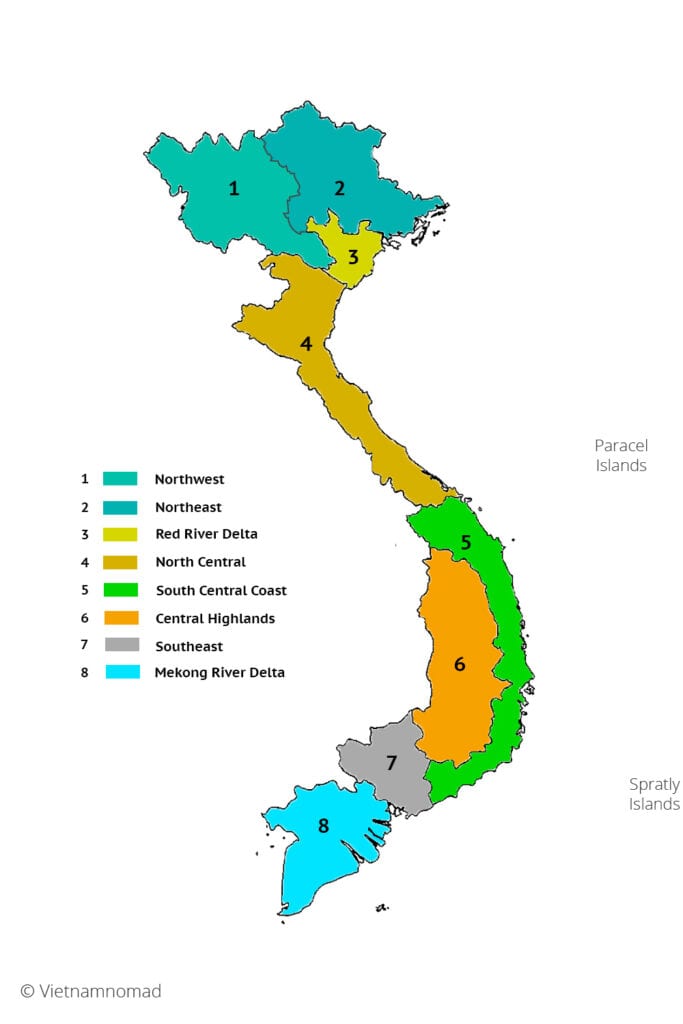
1. Northwest
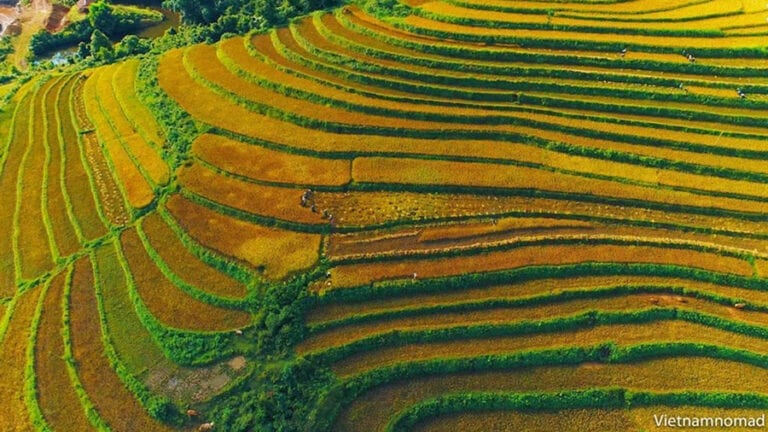
Northwest Vietnam consists of 6 provinces: Dien Bien, Son La, Hoa Binh, Yen Bai, Lai Chau, Lao Cai. The famous tourist destinations: Sapa (Lao Cai), Mu Cang Chai (Yen Bai), Dien Bien Phu (Dien Bien), Mai Chau (Hoa Binh), Moc Chau (Son La). It is a mountainous area which shares the borderline with China and Laos. This is home of magnificent fold mountains and extremely unmatched landscapes.
The region has two distinct seasons: summer and winter. The summer (April to October) is hot and humid. Winter (November to March) is cold, cloudy that is characterized by drizzle. The average annual temperature is about 25 ºC. In winter, the lowest temperature is in December and January; some places have temperatures below 0 ºC.
2. Northeast
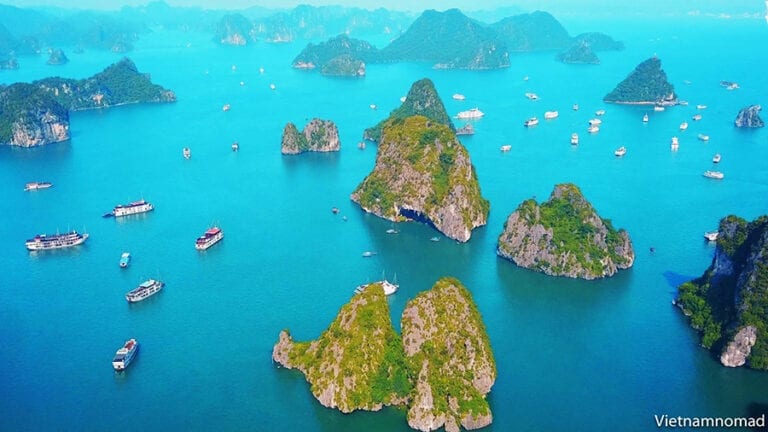
Northeast Vietnam consists of 9 provinces: Ha Giang, Bac Giang, Bac Kan, Cao Bang, Lang Son, Phu Tho, Thai Nguyen, Tuyen Quang, Quang Ninh. The famous tourist destinations: Dong Van (Ha Giang), Ban Gioc Waterfall (Cao Bang), Ba Be Lake (Bac Kan), Ha Long Bay (Quang Ninh), Mau Son (Lang Son). The region is geographically distinguished with the Northeast by the Red River. There are middle-high mountain ranges blended with vast plateaus. The complicated system of water bodies carving into the limestone mountains creating deep valleys across the region.
The climate is quite similar to the Northwest, but the region is more affected by the humid monsoon climate than the Northwest. Therefore, the Northeast is directly affected by tropical storms in the summer.
3. Red River Delta
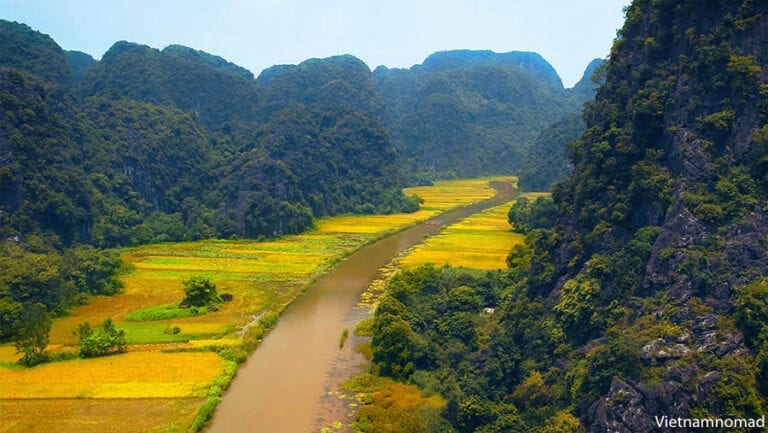
Red River Delta consists of 10 provinces: Bac Ninh, Ha Nam, Ha Noi, Hai Duong, Hai Phong, Hung Yen, Nam Dinh, Ninh Binh, Thai Binh, Vinh Phuc. The famous tourist destinations: Hanoi, Cat Ba (Hai Phong), Do Son (Hai Phong), Trang An (Ninh Binh). The delta is situated in the North of Vietnam, this is one of the most densely-populated regions across the country due to the fertile soil and a large concentration of waterways, which are advantageous for agricultural activities.
Like the Northeast and Northwest, the Red River Delta also has two distinct seasons: the summer is from April – November; the winter is from December – March. However, the weather here is milder than in the other two regions.
4. North Central
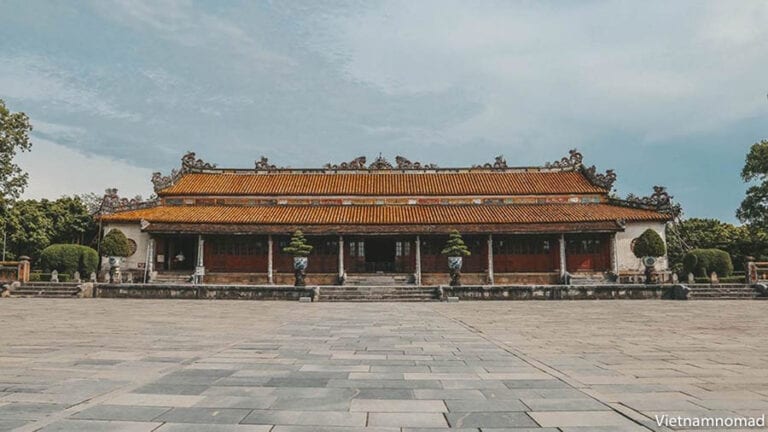
North Central consists of 6 provinces: Ha Tinh, Nghe An, Quang Binh, Quang Tri, Thanh Hoa, Thua Thien Hue. The famous tourist destinations: Thien Cam Beach (Ha Tinh), Cua Lo Beach (Nghe An), Phong Nha – Ke Bang (Quang Binh), Hue (Thua Thien Hue). This region is a long-stretching land and also the most narrow part of the country, which is one of the most important economic regions featuring aquaculture and tourism. The area is home of a great collection of three out of eight UNESCO’s World Heritage Sites in Vietnam.
Due to the monsoon in the northeast, the whole area is affected by cold weather with rain in the winter. This is different from the dry weather in the winter of the North. In the summer, there is the southwest monsoon (also known as Laos wind), so the whole region will have a hot and dry climate. At this time, the daily temperature can reach over 40 ºC; meanwhile, air humidity is very low.
5. South Central Coast
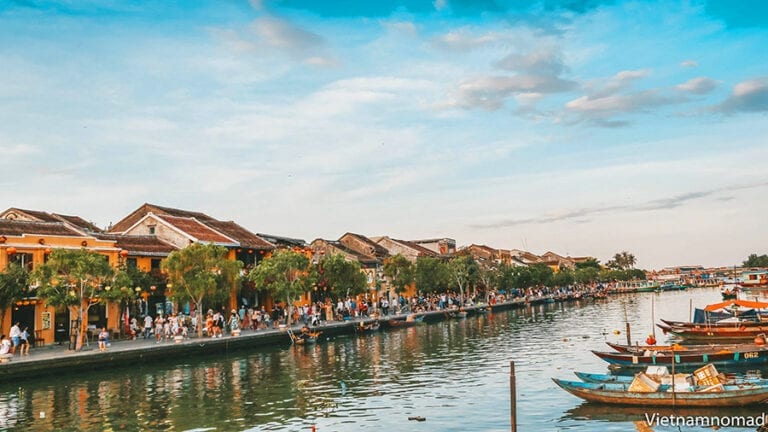
South Central Coast consists of 8 provinces: Da Nang, Quang Nam, Quang Ngai, Binh Dinh, Phu Yen, Khanh Hoa, Ninh Thuan, Binh Thuan. The famous tourist destinations: Da Nang, Hoi An (Quang Nam), Quy Nhon (Binh Dinh), Nha Trang (Khanh Hoa), Mui Ne (Binh Thuan). South Central Coast has a strategic position in terms of economic and transport values. The landscapes are dominated by the fertile whale-shaped hills, which is beneficial for herding activities. Bordering a large sea area, the economy strongly relies on marine resources. Here is also a potential travel hub thanks to its well-developed transport system.
The weather here is different from the North Central Coast due to the northeast monsoon blocked by the Bach Ma mountain range. The remarkable feature of the Central climate is that there is a rainy season and the dry season does not occur at the same time in a year in the two climatic regions of the North and the South.
6. Central Highlands
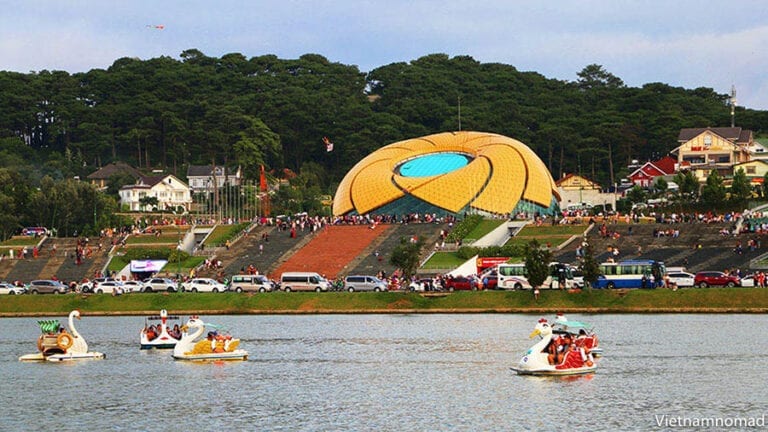
Central Highlands consists of 5 provinces: Dak Lak, Dak Nong, Gia Lai, Kom Tum, Lam Dong. The famous tourist destinations: Dalat (Lam Dong), Mang Den (Kom Tum), Buon Me Thuot (Dak Lak). The region consists of many plateaus, which are surrounded by mountain ranges. Central Highlands is known as the coffee capital of Vietnam as the fertile basalt facilitates the growth of this industrial crop. Some distant and remote mountainous parts of the area are also home to various minority ethnic groups.
Located in the tropical savanna region, the climate in the Central Highlands is divided into two seasons: the rainy season from May to the end of October and the dry season from November to April, in which March and April are the hottest. Particularly, the lands are over 1.000 m high, the climate is cool all year round.
7. Southeast
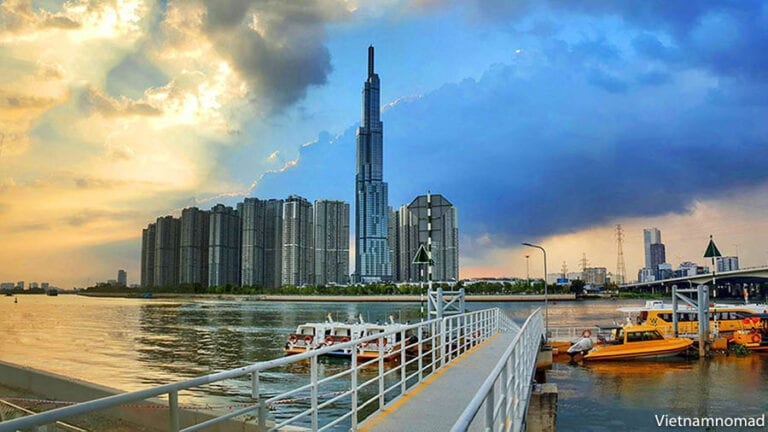
Southeast Vietnam consists of 6 provinces: Ba Ria Vung Tau, Binh Duong, Binh Phuoc, Dong Nai, Tay Ninh, Ho Chi Minh City. The famous tourist destinations: Ho Chi Minh City, Vung Tau Beach (Ba Ria Vung Tau), Con Dao Island (Ba Ria Vung Tau), Black Virgin Mountain (Tay Ninh). Southeast is the highly industrialized zone. A massive landmass is used for industrial trees and factories. The landscape highlights the midlands and low mountain ranges. This is where the major river systems meet and concentrate on the most vital ports as well as tourism.
The South is located in a region characterized by the equatorial tropical climate, abundant sunshine, and high humidity. The annual average humidity is about 80 – 82%. The climate has two distinct seasons: dry and rainy. The rainy season is from May to November and the dry season is from December to April.
8. Mekong River Delta
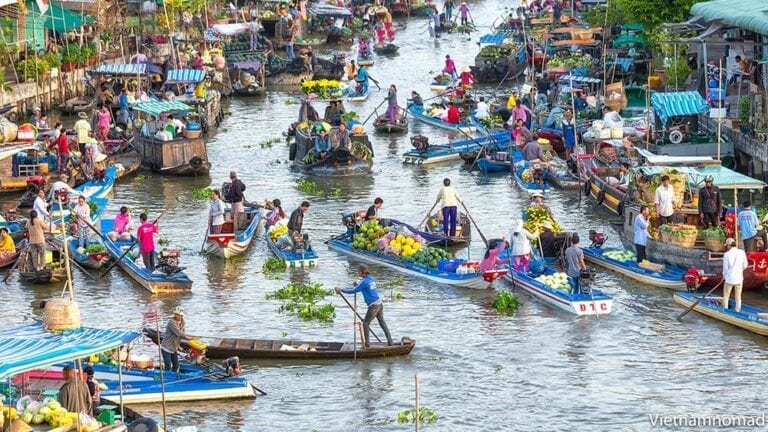
Mekong River Delta consists of 13 provinces: Long An, Tien Giang, Ben Tre, Vinh Long, Tra Vinh, Hau Giang, Soc Trang, Can Tho, Dong Thap, An Giang, Kien Giang, Bac Lieu, Ca Mau. The famous tourist destinations: Can Tho, My Tho (Tien Giang), Tram Chim (Dong Thap), Chau Doc (An Giang), Phu Quoc (Kien Giang). It is the southernmost part of the country and dominated by flat floodplains. The low basin of the Mekong Delta is rich in sediment from its mother source and greatly contributes to the agricultural practice of its people for centuries. The region is covered by very little forestry, mainly mangrove forests and swamps to prevent waves and preserve land.
The climate of the Mekong Delta is similar to the Southeast: the tropical monsoon climate, there are two distinct seasons: the rainy season (May to November) and dry season (December – April).
Best time to visit Vietnam
The ideal time to visit Vietnam is during the dry season. In which the period from December to March is the best time to visit Vietnam. You can rely on the detailed map below to choose the appropriate time to visit each place in the country.
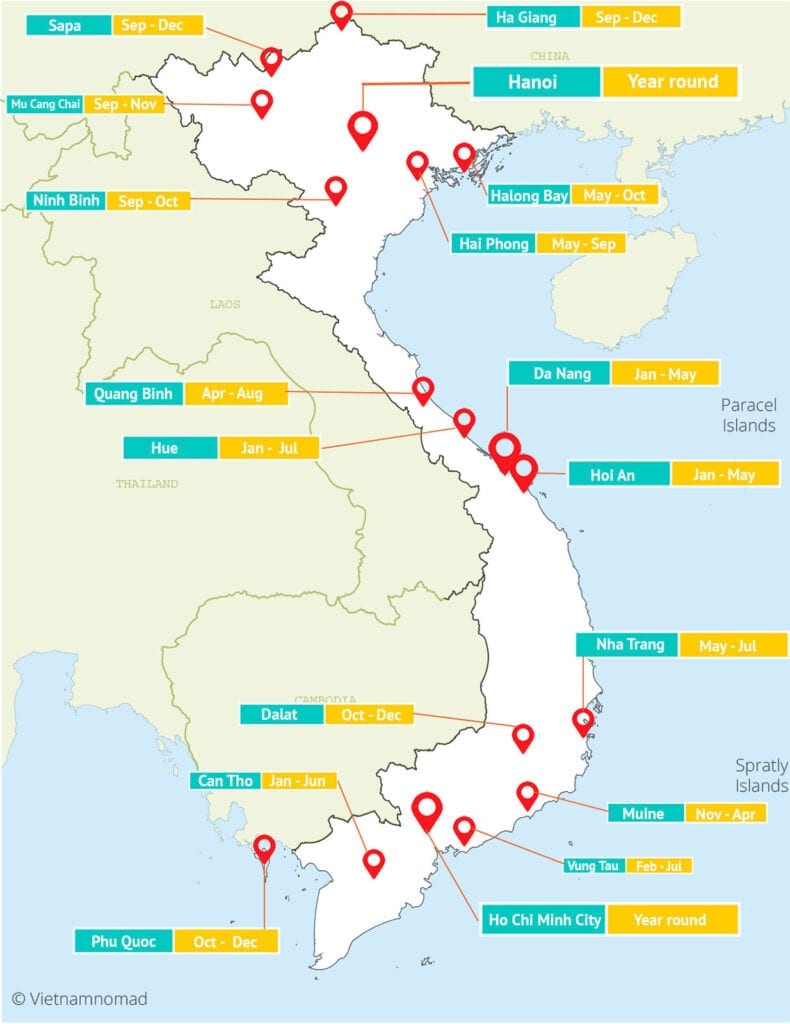
Vietnam Visa
It’s easy to come to Vietnam! Vietnam offers visa exemptions to tourists from 24 countries and e-Visas to travellers from 80 countries.
Vietnam visa exemption
Citizens of 24 countries are exempted from visa when entering Vietnam:
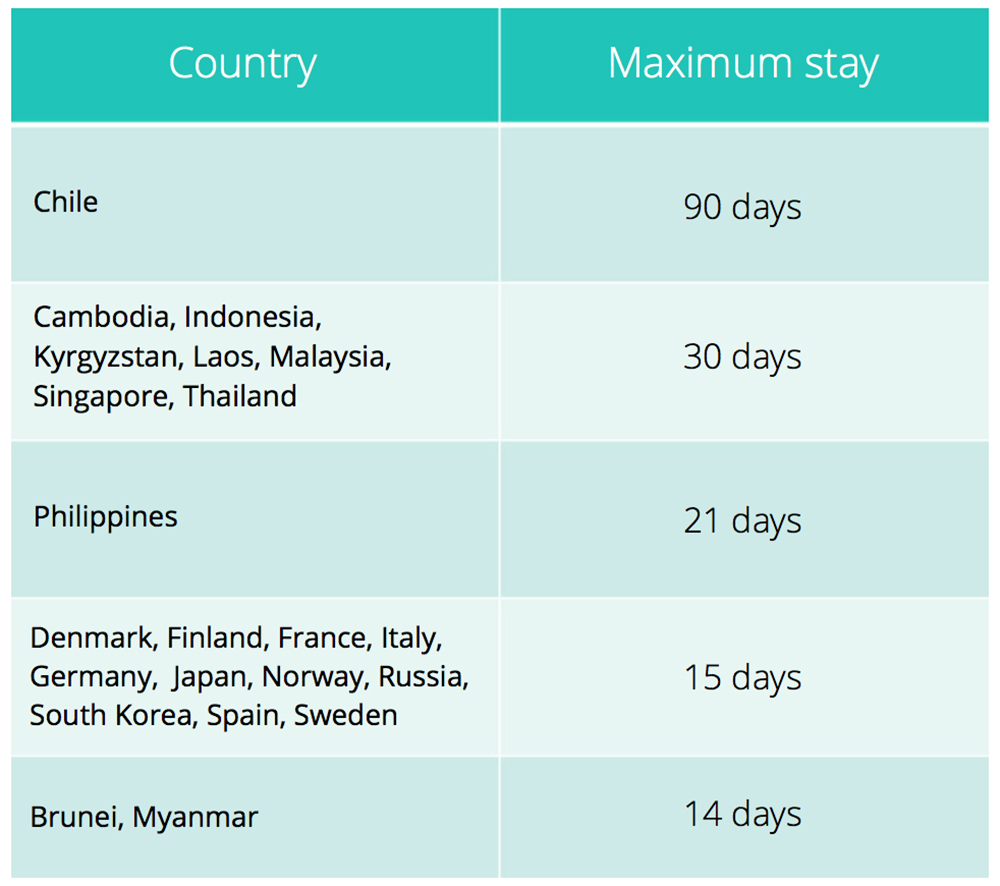
Vietnam visa application
Now you can easily apply for Vietnam Visa with an electronic Visa, E-Visa is available to nationals of 80 countries. What you need to do is visit the official website of the Immigration Department ( click here ) and follow the instructions.
The e-Visa costs 25 USD, takes three working days to process, and is a single-entry visa, valid for 30 days.
Learn more about Vietnam Visa >
Money and Exchange
Vietnamese currency is known as “Dong” or “VND” as currency code. There are no longer coins but only paper and polymerized money, so it is quite easy to carry around. Vietnamese banknotes, however, have many zeros: the smallest bills commonly in circulation are 500 VND, 1.000 VND, 2.000VND, and 5.000VND; and the highest one is 500.000VND.
Cards are widely accepted in restaurants, hotels, and other public amenities (but not at street-food stalls), and ATMs are placed densely. The most popular exchange rate when travelling in Vietnam is from USD to VND. It is known among travellers that the best exchange rate is given at jewelry shops; however, it is now considered illegal to exchange currency at those shops. So, the best way is to change money at the airport, local banks, or ATMs.
Learn more about the Vietnamese currency >
Transportation in Vietnam
Vietnam’s transportation network is quite complete with international and domestic airport systems in many provinces, the “famous” North-South railway system, and the extensive road system with the backbone of National Highway 1A. Below is a transportation map in Vietnam with train stations and airports.
Learn more about transportation in Vietnam >
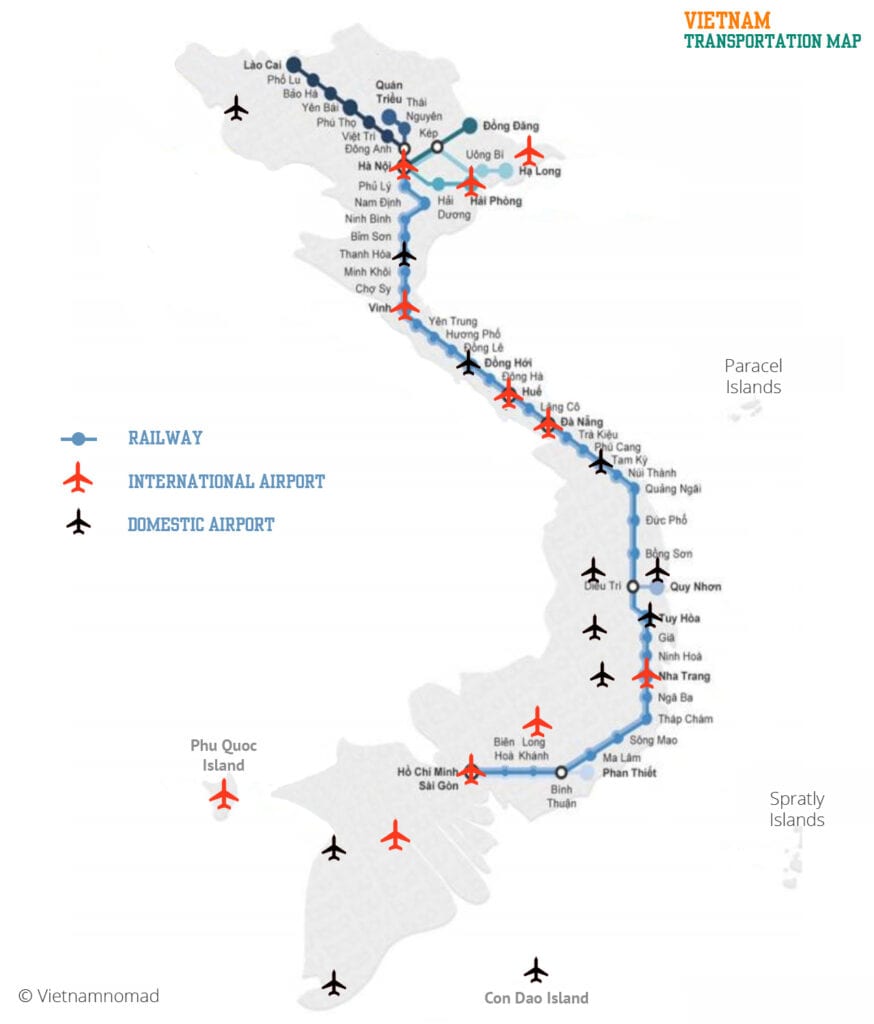
Cost of living in Vietnam
I t is totally possible to live on a budget in Vietnam as the cost of living is claimed to be inexpensive. Most of the items cost less than half of what you would pay in the West or even relatively cheaper in comparison with some tourist hubs in Asia.
Although in big cities such as Ho Chi Minh City and Hanoi Capital, things could be a bit pricey, there are still lots of opportunities to lead a comfortable lifestyle with an income of under 700 USD (of course, if you are willing to eat local food and enjoy a Vietnamese standard lifestyle). If you live outside of these two major cities, living expenses could be much less. Your lifestyle will determine your cost of living, but generally, Vietnam has a competitive yet fertile job market for both locals and expats and an average rate of living expenses. As long as one has a job and not too bad at money management, they can assure an enjoyable life and travel if they wish.
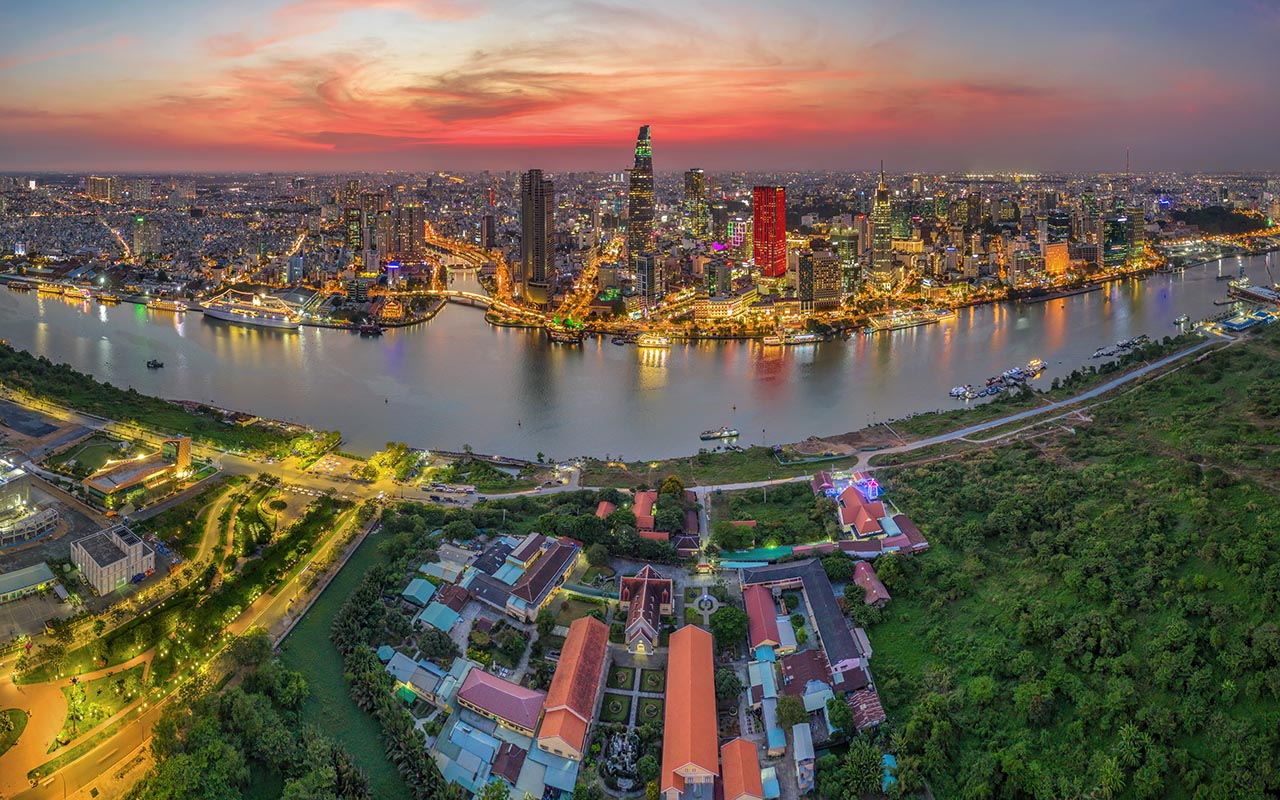
Internet and Telecommunication
Vietnam offers a very accessible Internet connection that covers most parts of the country. Wi-fi is available in every corner: at restaurants, coffee shops, convenience stores, or even at small food vendors sometimes. So there would be very little chance that you lose touch with the world while travelling here.
There are also many SIM card providers that offer 4G data service along. So if you are mostly on the road or wish to keep in touch with people, here is an option. Some of the most reliable telecommunication companies known are Viettel, Mobifone, and Vinaphone. SIM card’s price normally starts from 50.000 – 100.000 (2 – 4,5 USD), and you can add money to buy data packages that are totally affordable, ranging from just 30.000 VND for unlimited access.
Accommodation in Vietnam
Accommodation in Vietnam varies from around under 10 USD to as much as you could imagine, catering to different budgets and preferences. There are many types of accommodation that you can choose from, from hostels and guesthouses to homestays and luxurious resorts which keep popping up throughout the country. Although hospitality is a huge industry in Vietnam, it is obviously popular among the locals as the young Vietnamese tend to travel more and more these days. So, it is ideal to book your accommodation in advance to make sure of a preferable stay. Booking could be made easily through online booking websites or, particularly for homestays, through direct messages on their Facebook pages.
The vast majority of accommodations are considered very stylish and full of character, of which homestay is one form of accommodation you have to get yourself into. They are not only a place to crash after a long day exploring, but are experience itself. Most places have English-speaking staff, and they accept both cards and cash.
Best places to stay in Vietnam >
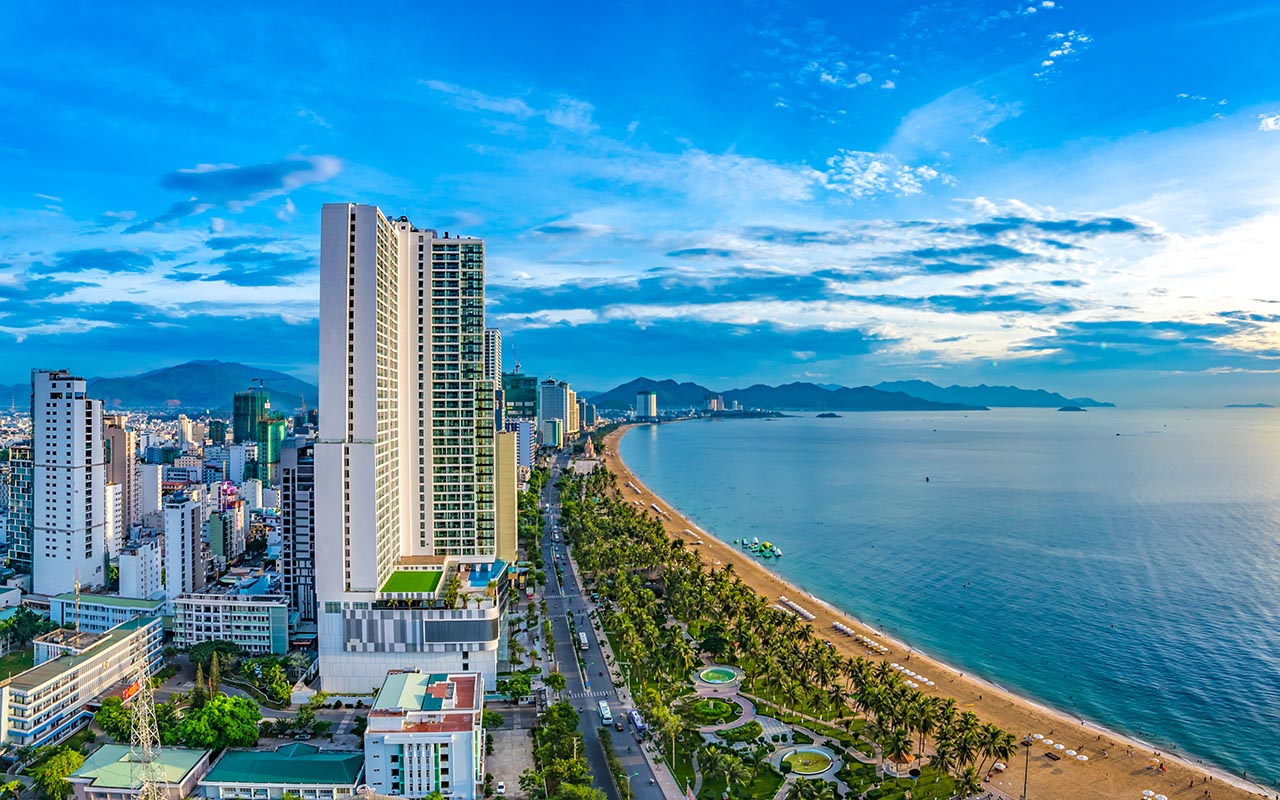
Shopping in Vietnam
It is no exaggeration that Vietnam is one of those shopping paradises. There is a whole range of shopping activities that you could take part in, which serve your craving for shopping and offer insight into the country’s culture. You could wander around the local open-markets to embrace the vibrance and dynamic energy of the street business culture of the Vietnamese, or opt for a less hustle and bustle shopping vibe in the shopping malls. A new breeze of shopping experience that is enjoyed by the millennials is the flea-markets, which are often held on weekends gathering the participation of local clothing and handicraft brands. Each market in Vietnam brings the characteristics and colors of the local community here. Going to the market is not only for shopping, but it is also a journey to discover the local culture.
For great trips, convenience stores are a good choice for you. There are many convenience stores in Vietnam, especially in big cities as Ho Chi Minh City, Hanoi, and Da Nang, which have almost everything you need. There are many well-known brands such as 7-Eleven, Vinmart, FamilyMart, and Cycle K. Therefore, if you need food or necessities, convenience stores are a quick choice.
Supermarkets or shopping malls are also an option, but most of them only appear in big cities with brands such as Vinmart, Co.op Mart, Vincom, and Lotte Mart.
Vietnam is also known as the manufacturing location for many big fashion names such as Nike and Adidas, so you are likely to get a very competitive price for those.
Due to the variety of items, affordable prices, and a wide range of shopping experiences, shopping would be a great part of your traveling in Vietnam.
15 best places to visit in Vietnam
Coming to the S-shaped country, you can admire the poetic and charming scenery wherever you go. The natural beauty, unique culture have made Vietnam become a tourist destination worldwide. At each place, we have designed an “all-in-one” travel guide page; click on the photo of the destination and explore it your way.
1. Ha Long Bay
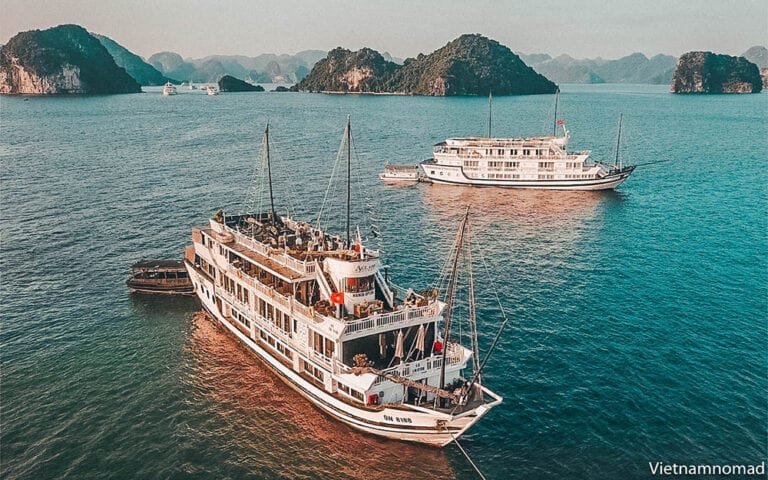
Ha Long Bay is a famous tourist destination of Vietnam, located in the western part of the Gulf of Tonkin in the northeastern region of Vietnam. With thousands of magnificent islands, Ha Long Bay has been recognized by UNESCO as a natural heritage of the world since 2003.
Ha Long City is a coastal region with two distinct seasons: winter (November to April) and summer (May to October). Affected by the climate of Northeast Vietnam, there are two distinct types of monsoons: the Northeast wind in the winter that brings coldness and drizzle; and the Southwest wind in the summer that brings warmth and rain. The best time to visit Halong Bay is in the spring and autumn (from April to October) because of the chilly weather.
Looking down from above, Ha Long Bay like a picture with thousands of unique rocky islands such as Dau Nguoi, Rong, La Vong, Trong Mai, and Canh Buom. Hidden inside the rocky islands are beautiful caves such as Thien Cung, Dau Go, Sung Sot, Trinh Nu, and Tam Cung.
2. Ninh Binh
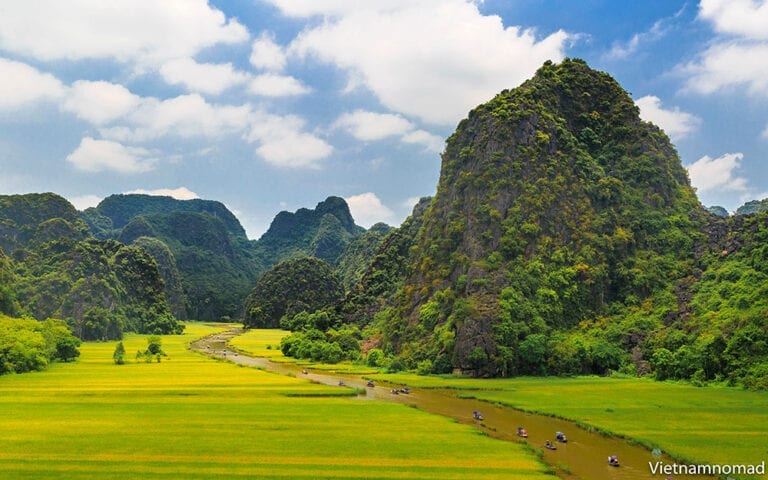
About 100 km away from Hanoi, Ninh Binh is a gem of Northern Vietnam. It is located in the southernmost region of the Red River Delta, which is the intersection of two large rivers: the Red River and the Ma River. This is known as the ancient capital of Vietnam, with many historical relics remaining.
You can travel to Ninh Binh at any time of the year. However, the ideal time for tourists to visit this land is in early spring, between the second and third month of the lunar calendar. At this time, the weather is mild, suitable for those who want to admire the spring beauty, and join the temple ceremony at the beginning of the year. If you come to Ninh Binh in late May and early June, you will admire the breathtaking scenery by the bright yellow rice fields along the banks of the Ngo Dong River. The golden color of rice interspersed with the green of the mountains creates a beautifully natural picture. In fall, you will be surprised by the peaceful beauty of the sky clouds combined with the blue Sao Khe River blooming full of lotus flowers and water lilies. The faint pink of the lotus flower combined with the pure white of water lilies creates a beautiful picture like in a fairyland.
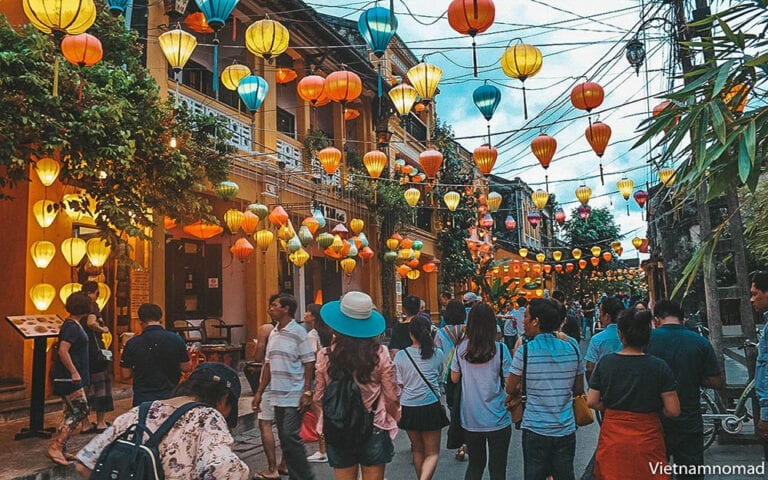
Hoi An is located downstream of the Thu Bon River, Quang Nam Province, Vietnam. It is a famous tourist city, only about 30km from Da Nang to the South. The Ancient Town of Hoi An carries the diversity of settings and the history of hundreds of years of cultural interference between the three countries of China, Japan, and Vietnam. You will be fall in love with the mix of vibrant lifestyle and ancient architecture of this little town.
As the most beautiful city in Vietnam, Hoi An is crowded year-round; the tourist season starts from November to the end of February. If you want to enjoy a “real” Hoi An, April to June is the right time for you, when there are the least tourists.
Hoi An is famous for traditional architecture’s beauty, the harmony of houses, walls, and roads. Along with many ups and downs of history, Hoi An ancient town retains the ancient beauty in every corner.
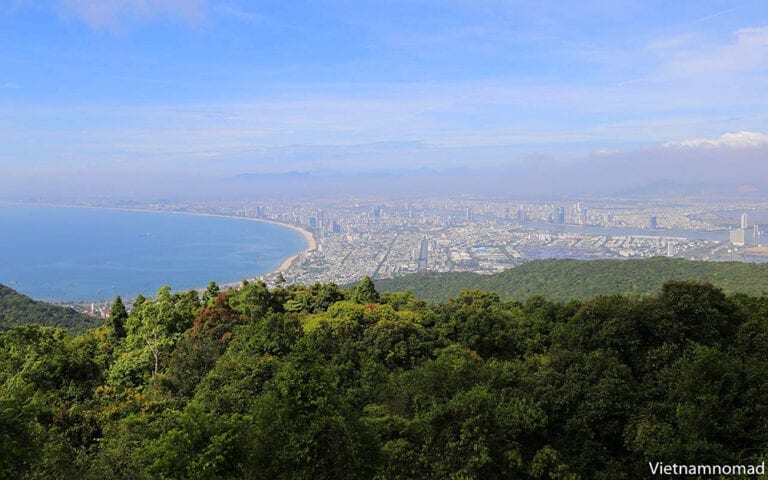
Da Nang is located in Central Vietnam, with an almost equally divided distance between Hanoi Capital and Ho Chi Minh City. Possessing one of the most beautiful beaches on the planet – My Khe and many incredible natural landscapes, Da Nang City is one of the most attractive tourist destinations of the Central region.
Da Nang’s climate is divided into two distinct seasons: the dry season (from December to August) and the rainy season (from September to November). The best time to travel to Da Nang is from January to July; at this time, the weather is not too hot; the temperature is about 25 – 32 °C, suitable for outdoor activities.
Da Nang is a “Crouching Tiger Hidden Dragon” city in Vietnam, where there are mountains, forests, beaches, and delicacies. The famous tourist attractions in Da Nang include Ba Na Hills, My Khe Beach, Marble Mountains, and Asia’s largest Fantasy Park indoor amusement park. Da Nang also has many fascinating landscapes such as Hai Van Pass, and the primeval forest in Son Tra Peninsula.
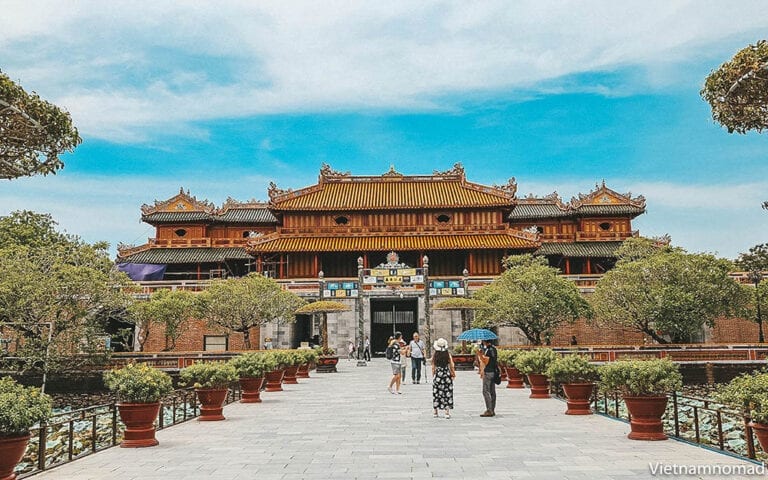
Once was the capital of the Nguyen Dynasty, Hue is considered a royal land with many palaces and tombs of the Kings. If you want to learn about the glorious Vietnam history, you cannot miss this land. Hue also attracts visitors by the poetic and beautiful natural landscapes and friendly people.
The weather in Hue is generally quite harsh, with high temperatures in the dry season (35 – 40 °C), but the dry season is also a good time to visit this city because the weather is less rain, suitable for visiting the palaces and tombs.
In addition to the Hue Imperial Citadel and mausoleums, you should also visit places such as Lang Co Bay, Hon Chen Palace, Thien Mu Pagoda, and Thuan An Beach.
Hue dishes are extremely delicious and cheap. The delicacies can be mentioned such as mussel rice, Hue beef noodle soup, and Hue sweet soup.
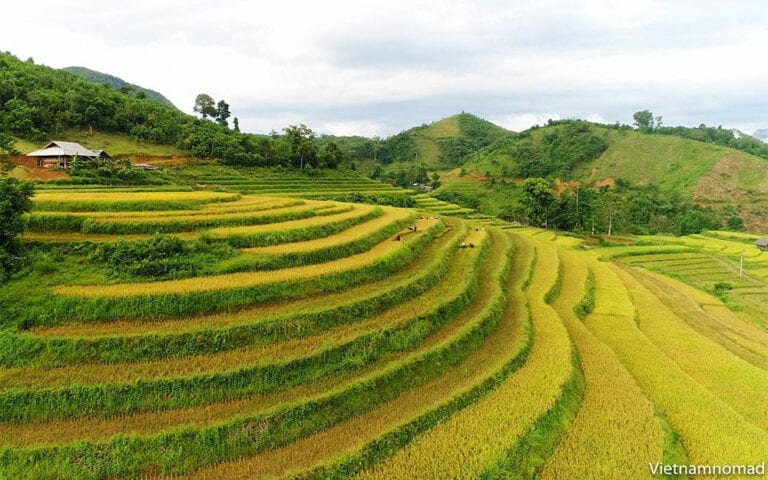
Sapa is a scenic spot located in the Northwest of Lao Cai province in Vietnam. It is one of the most famous tourist destinations in Vietnam . Situated at an average altitude of 1.500 – 1.800 m above the sea, Sapa is always in the thick fog, creating a fanciful scene.
Sapa is a mountainous region with a cool climate all year round. The weather in Sapa has four seasons; the average temperature of Sapa is 15 °C. Summer in Sapa is not too hot; winter is often cloudy and cold, sometimes it snows.
Tourists come to Sapa to enjoy the fresh air and admire the wild beauty of the Northwestern mountains. Terraced fields, waterfalls, and majestic mountains create an impressive beauty for Sapa. Besides, visitors also can explore the customs and cultural beauty of ethnic minorities such as Black H’Mong, Red Dao, Tay, and Giay.
Referring to Sapa, it is impossible not to mention famous tourist destinations such as Fansipan Peak, Ham Rong Mountain, Stone Church, Muong Hoa Valley, and some villages such as Cat Cat, Ta Phin, Ta Van. Come to this foggy land, don’t forget to enjoy a salmon hot pot, drink a cup of Tao Meo wine.
7. Nha Trang
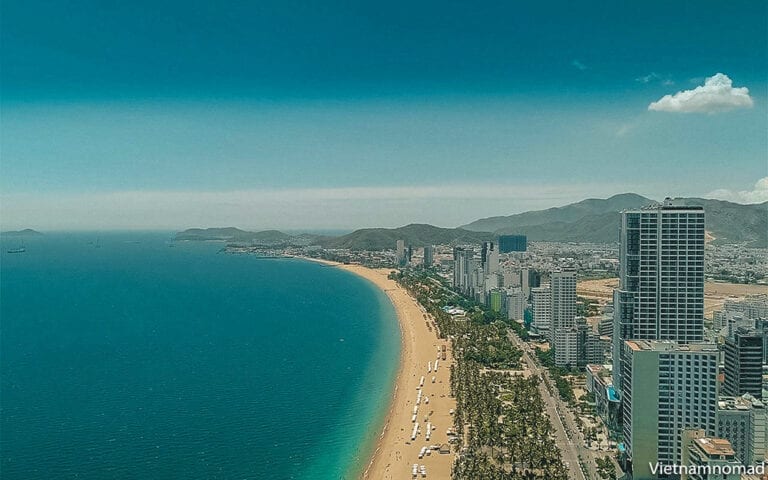
As a coastal city in Khanh Hoa Province, Nha Trang is the top destination of Vietnam. Nha Trang is surrounded by beautiful beaches , majestic mountains, and pristine islands, an ideal place for your vacation. Besides the beautiful beaches, the islands as Hon Tre, Hon Chong, and Hon Mun are always attractions to visit this coastal city.
T he most significant advantage of this city is the long sunny season during the first eight months, the temperature difference is not considerable. The rainy season of Nha Trang lasts from September to December and reaches its peak in October and November.
From fine dining restaurants facing the sea to favorite pubs, all are located along the beach in front of Nha Trang city. Coming here, you definitely have to try the famous specialties such as Banh Can, Banh Canh Cha Ca, and Nem Nuong.
8. Ho Chi Minh City
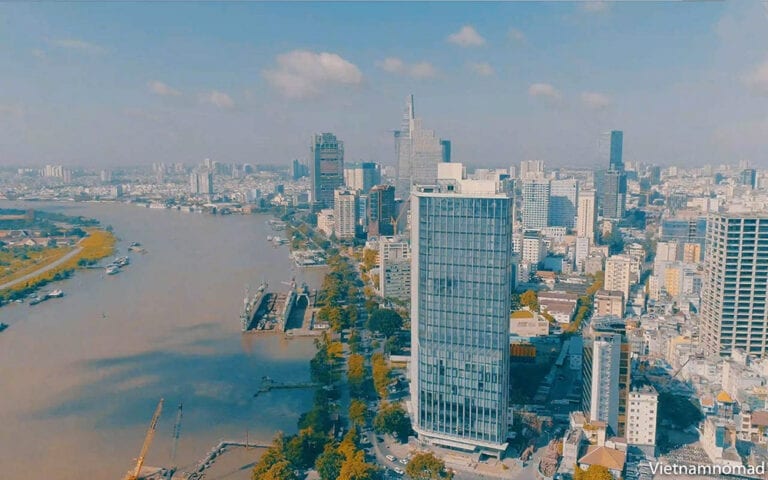
Ho Chi Minh City (Saigon) is the biggest city in Vietnam, which has long been known as the Pearl of the Far East, a lavish metropolis.
Ho Chi Minh City left a deep impression for the first time with anyone who has ever been to. The bright light of night streets, the colorful signs, the fresh beer pubs, the playgrounds that last all night; all turned Ho Chi Minh City into a paradise of shopping and food in Vietnam. People here are famous for being enthusiastic and generous. For strangers, they are willing to guide every intersection and street corner.
Ho Chi Minh City weather does not have four seasons like Hanoi but only two: rainy and dry. The rainy season is from May to November. In general, you can visit Ho Chi Minh City at any time of the year; the rainy season is also the most beautiful season of this city.
Ho Chi Minh City is subdivided into 22 district-level subdivisions. Urban areas include districts 1, 3, 4, 5, 6, 7, 8, 10, 11, 12, Phu Nhuan, Binh Thanh, Go Vap, Tan Binh. The suburbs include Hoc Mon, Cu Chi, Binh Chanh, Nha Be, Can Gio and Thu Duc City (sub-city).
District 1 is the administrative, economic, and transactional center of Ho Chi Minh City. Therefore, if you are a first-timer, you should visit the famous spots such as Ben Thanh Market, Nguyen Hue walking street, Notre Dame Cathedral, Independence Palace, and Bui Vien Street. District 1 is also the place where the majority of tourists choose to stay while in this city.
District 2 and District 3 are the ideal residence with spacious street, elegant and quiet villas.
District 4 is the place where people mainly live by working in warehouses and docks. So coming here, you will discover the daily life of ordinary workers in the city.
District 5 is where more than half a million Chinese people have been living there for a long time. It is also an attractive tourist destination with the name “ China town “.
In the suburbs, a destination not to be missed when coming to Vietnam is Cu Chi Tunnels, a massive underground tunnel system; it is heroic evidence of the history of the “ Vietnam war “.
Coming to Ho Chi Minh City to sip a bottle of Saigon beer on Bui Vien Street, sometimes that’s enough.
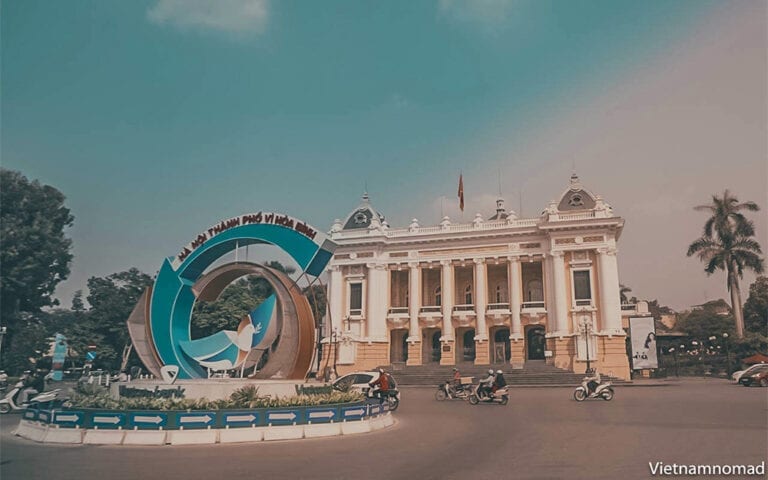
Hanoi – the capital, is Vietnam’s important cultural, political, commercial, and tourist center. Over a thousand years of history, Hanoi has become a famous tourist destination in the world.
Hanoi attracts tourists by its ancient beauty, historical colors, and hospitality from local people. The best time to visit Hanoi is in the fall, from mid-August to the end of October. At this time, the weather in Hanoi is cool, and the scenery is extremely romantic.
Hanoi has more than 4.000 monuments and beautiful landscapes. In particular, there are more than 9.000 relics in the ranking of national monuments, with hundreds of temples, structures, and famous attractions. Some prominent relics of Hanoi are the Temple of Literature, One Pillar Pagoda, Ngoc Son Temple, Ba Dinh Square, Hanoi Cathedral, and Opera House.
Also, the unique culture of the Hanoi people fascinates many tourists around the world. Hanoi is famous for its fine handicraft products in craft villages such as Bat Trang ceramics, Ngu Xa bronze casting, and Yen Thai village. Besides, Hanoi also owns unique cuisine and many different cultural festivals throughout the year.
Hanoi is also remembered as the city with the best street food in the world. Come to Hanoi, do not forget to enjoy specialties such as Pho, Bun Cha, Cha Ca La Vong, and Bun Thang.
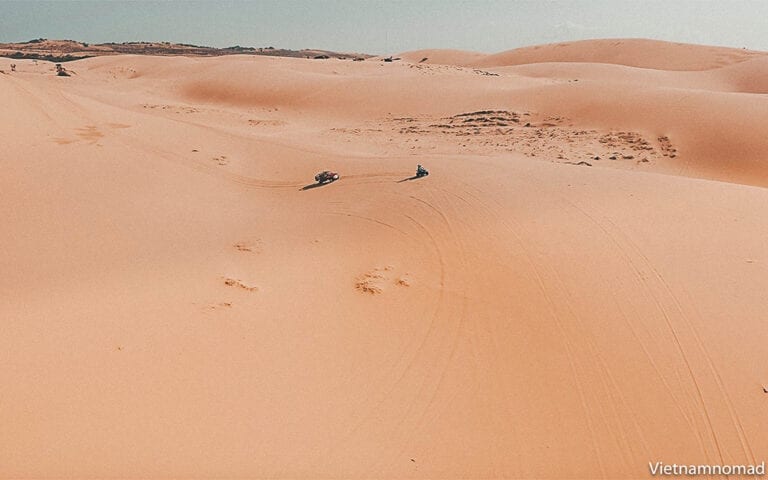
Located 22 km northeast of Phan Thiet City center, Mui Ne is one of the most beautiful and famous destinations in Binh Thuan Province. In 2014, Mui Ne ranked 2nd on the top of the most beautiful beaches in Southeast Asia by Canadian traveler site voted. According to Skyscanner, this place has been listed on the list of 10 impressive beaches of Asia Pacific.
The period from April to August is considered to be the best time to travel to Mui Ne. From September onwards, Mui Ne often rains, so it is inconvenient for outdoor activities.
Besides the poetic and idyllic scenery, Mui Ne attracts visitors by the desirable and affluent culinary features. Coming here, you definitely have to enjoy the delicately processed seafood dishes such as Dong, fish salad, Banh Can, and Banh Xeo.
11. Ha Giang
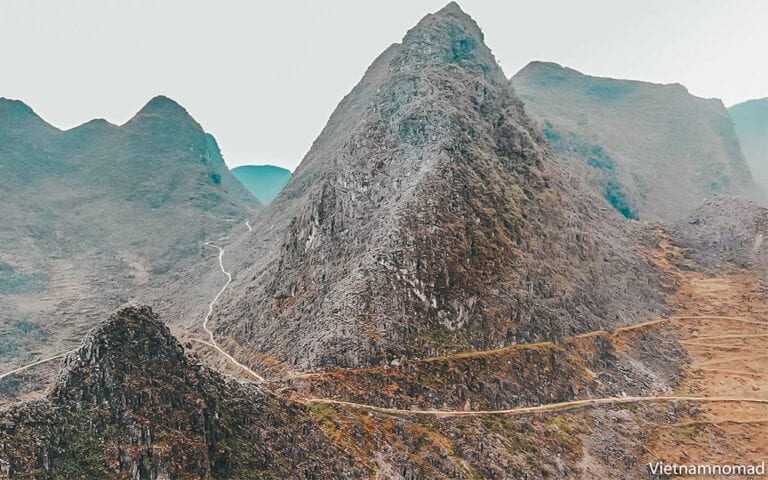
Famous for the majestic scenery, the endless terraced fields, the long buckwheat flower fields, and the cultural identity of upland ethnic people, Ha Giang is one of the destinations that attract many tourists in Vietnam recently. Located in the mountainous north of Vietnam, Ha Giang is a majestic mountain complex, with an average height of 800 m to 1.200 m above sea level.
The northern highland is Dong Van Plateau, including Quan Ba, Yen Minh, Dong Van, and Meo Vac districts, with 90% of the area is limestone mountains, typical for karst terrain. There are sharp rocky mountains, deep and narrow ravines, and cliffs. On October 3, 2010, Dong Van Rock Plateau joined the Global Geopark Network. The western include Hoang Su Phi and Xin Man districts, which are part of Bac Ha Plateau, commonly known as Chay River lift arch, with elevations from 1.000m to over 2.000m. The terrain here is usually domed or semi-arched, interspersed with steep, sometimes sharp, or jagged terrain. The low mountainous region covers the remaining districts and towns, stretching from Bac Me, Ha Giang town, through Vi Xuyen to Bac Quang. This area has strips of old forest interspersed with relatively flat valleys located along rivers and streams.
The best time to visit Ha Giang is from October to December in the buckwheat flower season. Another great time to visit this land is from September to October, which is the rice season.
Coming to Ha Giang, visitors also have access to mountainous residents’ culture through highland markets; one of them is Khau Vai Love Market, a dating place for couples. At this fair, people also sell various handmade products such as embroidered towels, cloth bags, dresses with bright and delicate patterns. Another thing that attracts visitors to come to Ha Giang is the specialties such as dried buffalo meat, Thang Co, Buckwheat flower pancake, and Chao Au Tau.
Moreover, Ha Giang has a rich and diverse cultural treasure, with more than 20 ethnic groups living here. Each ethnic group has its own unique cultural identity, expressed through customs, festivals, and religions.
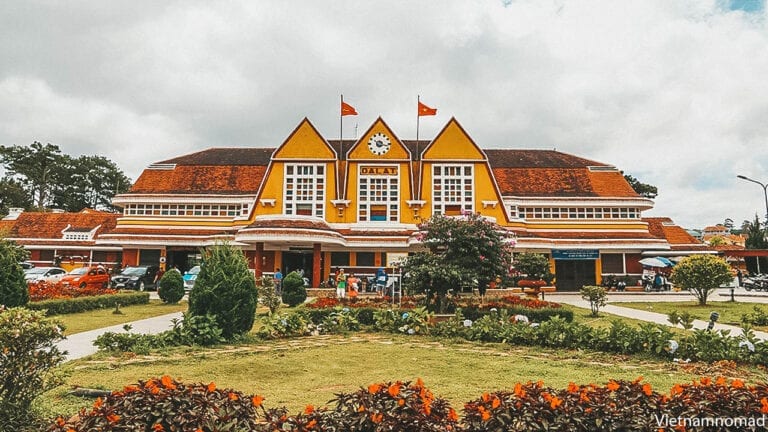
Dalat is a city in Lam Dong Province, located on Lam Vien Plateau, at an altitude of 1.500 m above sea level, which has many beautiful landscapes. Dalat is one of the most famous tourist cities in Vietnam, a little Paris of Vietnam.
Dalat has an ancient, romantic beauty with many architectural works and old villas from the French colonial period. Dalat has a typical climate of the Central Highlands region with two distinct seasons: rainy season and dry season. The rainy season lasts from May to October, and the dry season lasts from November to April next year. The ideal time to visit Dalat is from October to December, when the flowers bloom throughout the mountains.
Dalat attracts tourists by famous attractions such as Tuyen Lam Lake, Xuan Huong Lake, Bao Dai Palace, Linh Son Pagoda, Truc Lam Zen Monastery, and many beautiful coffee shops. Come to Dalat, don’t forget to enjoy the delicious food such as Lau Ga La E, Banh Mi Xiu Mai, and Banh Can. At night, in the chilly air, visitors can stroll around the night market and Xuan Huong Lake edge to enjoy a cup of hot soy milk, or a Dalat baked rice paper.
13. Phu Quoc

Phu Quoc is also known as a gem island, the largest island in Vietnam, located in the Gulf of Thailand. Phu Quoc Island, together with other islands, form the Phu Quoc Island District of Kien Giang Province. In 2006, Kien Giang coastal and island biosphere reserve, including Phu Quoc, was recognized by UNESCO as a world biosphere reserve.
As a tropical monsoon island equatorial, the Phu Quoc climate is divided into two distinct seasons, which are the rainy season and the dry season. Because it is the gateway to receive the west-southwest monsoon, the humidity in the rainy season is very high, from 85 to 90%. In the dry season, the island is affected by the northeast monsoon, so that the temperature will increase in April and May. The best time to visit Phu Quoc Island is the dry season, from the end of October to March next year. At this time, the weather in Phu Quoc is less rain, which is convenient for travel and relaxation.
Phu Quoc has many beautiful beaches stretching from the north to the south and 99 hills covered by vast primeval forests. In the north of the island, there are Rach Vem, Bai Thom, and Hon Mot fishing villages – with outstanding wild beauty. In the South Island, there are 12 large and small islands such as Hon Thom, Hon Mong Tay, Hon Gam Ghi, Hon May Rut – the ideal places for nature exploration activities such as night squid fishing, diving to see corals, and discovering pristine forest.
Phu Quoc not only attracts tourists with beautiful views but also the delicious dishes made from a rich source of seafood. Some dishes that you cannot miss when visiting Phu Quoc are Herring Salad, Grilled Squid, Quay Noodle, and Sim wine.
14. Quy Nhon
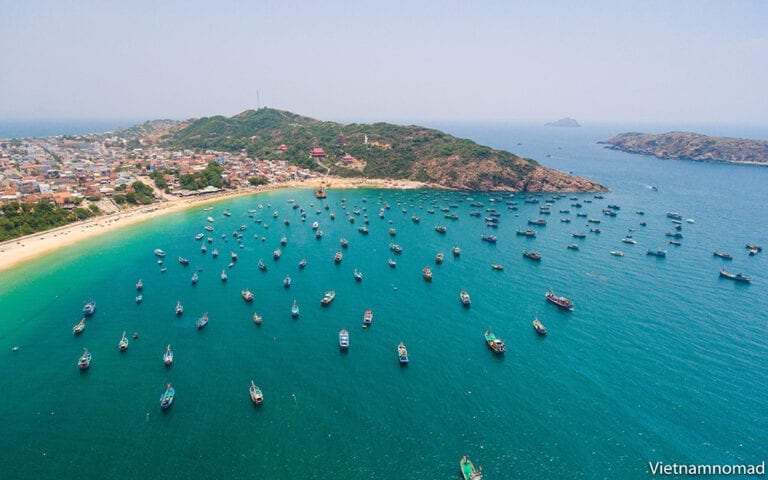
If talking about a hidden pearl of Vietnam, Quy Nhon is a leading candidate. Located in Binh Dinh Province, Quy Nhon is known as one of the most beautiful coastal cities in the South Central Coast with many ideal beaches such as Eo Gio, Ky Co, Cat Tien, Nhon Hoi, and Hai Giang, where visitors can immerse themselves in the majestic natural scenery.
Binh Dinh climate is characterized by humid tropical and monsoon with 2 distinct seasons in a year. The dry season lasts from January to August and the rainy season lasts from September to December. The ideal time to visit Quy Nhon is from January to September when the weather is sunny and less rain.
Coming to Quy Nhon, not only immersed in the clean beaches but also infatuated in the food here. Great dishes in Quy Nhon can be mentioned as Banh Xeo, Bun Ca, Banh It La Gai, and Bao Da wine.
15. Quang Binh
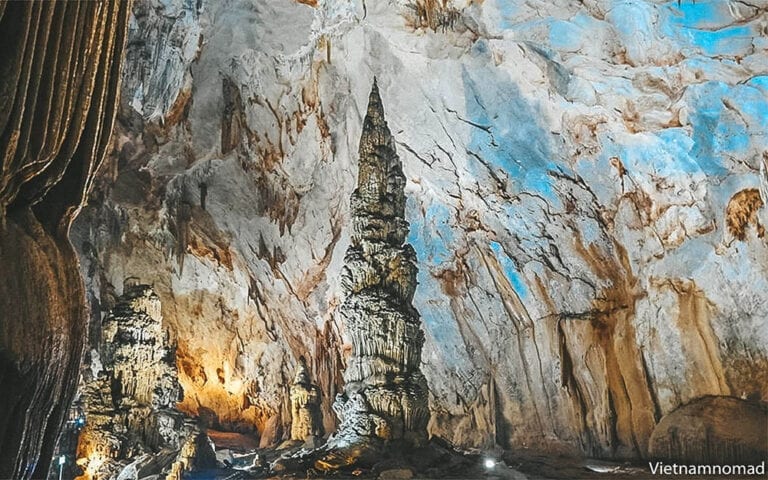
Quang Binh is known as the “cave kingdom” with more than 300 different large and small caves, including Son Doong Cave, En Cave, Thien Duong Cave, Phong Nha Cave, Tien Son Cave, Chay River – Dark Cave, System of Stunted Caves in Le Thuy. Not only that, but Quang Binh also has unbelievably pristine beaches such as Nhat Le Beach, Rock Jump Beach, Vung Chua, and Yen Island. And most importantly, Quang Binh also has attractive spiritual attractions such as the Tomb of General Vo Nguyen Giap, relics of Hang Tam Co, General Memorial Hall, and Hoang Phuc – a pagoda is over 700 years old.
The ideal time to visit this land is from March to September when the weather is pleasant and less rain. From September to March, there are usually heavy rains.
The two famous of these destinations are Phong Nha-Ke Bang National Park and Son Doong Cave. Recognized as a UNESCO world heritage site in 2003, the Phong Nha – Ke Bang Complex is a destination not to be missed when traveling to Quang Binh. Son Doong Cave, located in the core area of Phong Nha – Ke Bang National Park, is a new cave discovered by the Royal Cave Research Association of England, which was announced as the largest cave in the world in 2010; it was put into operation in the form of adventure travel in 2013. Tourism activities of Son Doong Cave are limited to the number of participants, so the number of people who have conquered Son Doong cave is even less than the number of people who have ever stood on Mount Everest.
In addition to owning a beautiful landscape, Quang Binh also attracts tourists with rich and featured cuisine. With only 100.000 VND, you can enjoy many delicious dishes, including Banh Bot Loc, Banh Canh Ca Loc, and Banh Khoai.
10 must-try foods in Vietnam
Vietnam has been long known as a culinary paradise; for thousands of years of civilization, Vietnamese people have created countless beautiful, harmonious, and delicious dishes. To explore Vietnam is to dive into its diverse cuisine as not only does it always burst with flavors but also is an incarnation of a prosperous breadth of history.
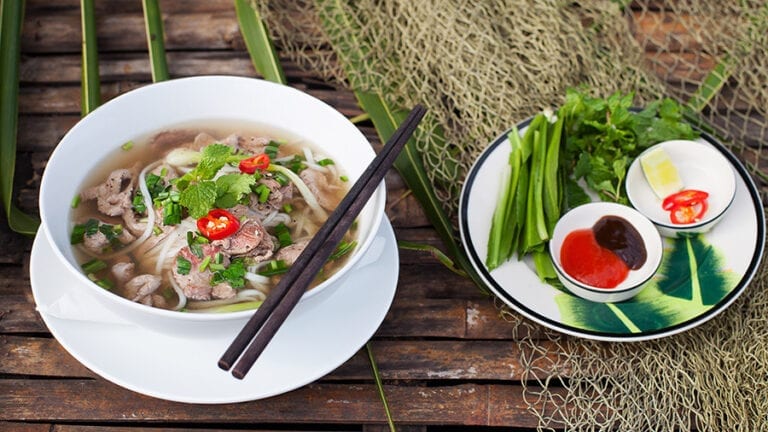
Pho is considered the national dish of Vietnam, a must-try food when coming to this S-shaped country. It has been voted by CNN, BBC, and Business Insider as the best dishes in Asia. In 2016, Pho was voted as one of the top 3 most delicious Vietnamese dishes in the world.
The main ingredients of Pho include noodles, broth, thinly sliced beef, and herbs. A qualified broth has to fulfill three strict criteria: firstly, the broth has to be clear to guarantee visual attractiveness; secondly, it has to come with the subtle sweetness extracted from the pork bones slowly cooked for hours; and thirdly, it has to bring up the herby aroma of cinnamon, anise, ginger. When eating Pho, we usually eat with hot sprinkles and spices such as chili sauce and sauté.
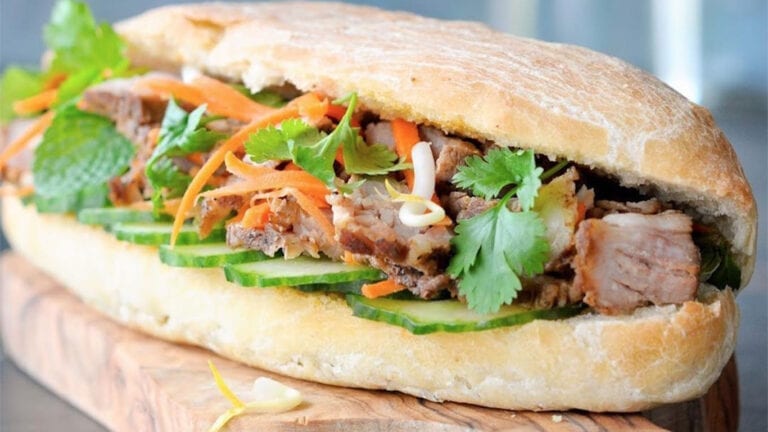
Culinary experts and international media recognized Banh Mi as the must-try dish when coming to Vietnam. The Guardian of England ranked Banh Mi in second place in the top 10 most delicious and attractive street food in the world. This newspaper once wrote: “There is a little known secret that the best sandwich in the world is not in Rome (Italy), Copenhagen (Denmark) or New York City (USA), but on Vietnamese streets.” David Farley, a BBC travel and food writer, praised Banh Mi as “the best sandwich in the world.”
Banh Mi makes of flour, like the Baguette but smaller, with fillings inside. Typically, the fillings have grilled pork, Vietnamese sausage, pate, egg, herbs, and cucumbers.
Banh Mi is sold in almost every street in Vietnam. Thanks to its simplicity and convenience, Banh Mi has become a familiar breakfast for Vietnamese people.
3. Goi Cuon
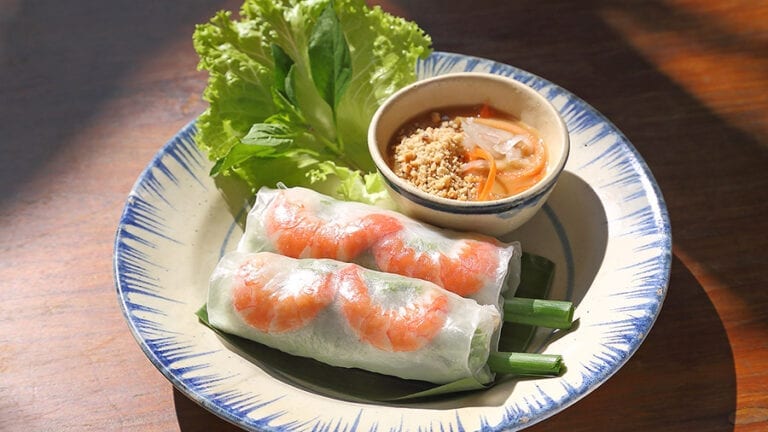
Goi Cuon is one of two Vietnamese dishes featured in CNN’s list of the world’s 50 best dishes in 2011. It is a favorite dish in Southern Vietnam.
Goi Cuon is usually made from boiled pork, boiled shrimp, fresh vermicelli, thinly sliced cucumber, long-stemmed chives, split onions, pickled carrots, or chopped green mango, herbs, and lettuce. All the ingredients are then rolled with rice paper. Saigon people like to eat Goi Cuon with black sauce. The habit of using black sauce is the culinary touch between Vietnamese and Chinese.
4. Bun Bo Hue
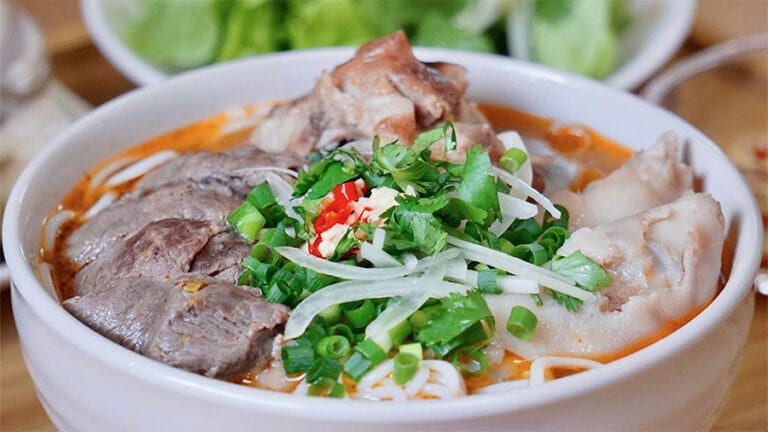
In an episode of “Anthony Bourdain: Parts Unknown” on CNN, the famous American chef said: “Hue beef noodle is the best soup in the world.” The Asian Record Organization had also put Hue beef noodles into the top 100 delicious Asian dishes in 2016. This is a popular dish of Hue. Hue beef noodle ingredients include pork leg meat, a piece of boiled pork blood, beef ball, and lemongrass.
To have a good bowl of Hue beef noodles, choosing the ingredients is very important: Beef should be bright red, smooth, and yellow fat. The broth is stewed with beef bones for a naturally sweet taste.
Nowadays, you can enjoy a bowl of Bun Bo Hue anywhere, but a proper bowl must be enjoyed at a roadside restaurant near Trang Tien Bridge, Hue.
5. Mi Quang
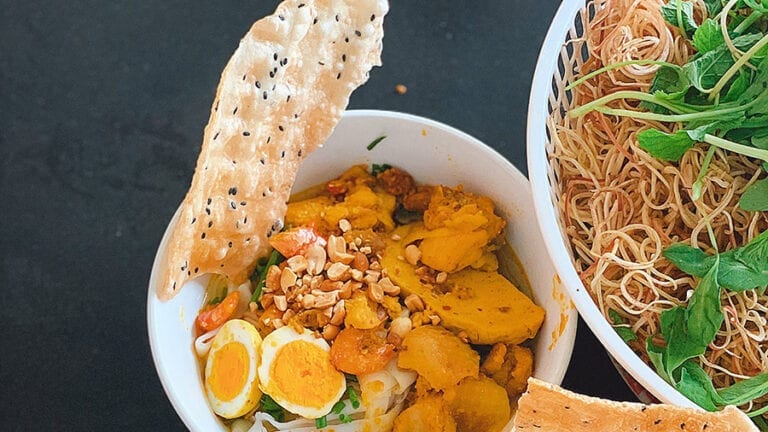
Mi Quang is a typical dish of Quang Nam, a province known for many famous tourist destinations such as Hoi An Ancient Town and My Son Sanctuary.
Mi Quang is a Vietnamese soup, which has all kinds of proteins that you could think of. For a “special” bowl of Mi Quang, there are noodles, sliced pork, shrimps, and quail eggs. Mi Quang is not complete without a handful of green herbs, crispy “Banh Da” – a type of rice paper that is thick, cracky, and added sesames.
6. Banh Xeo
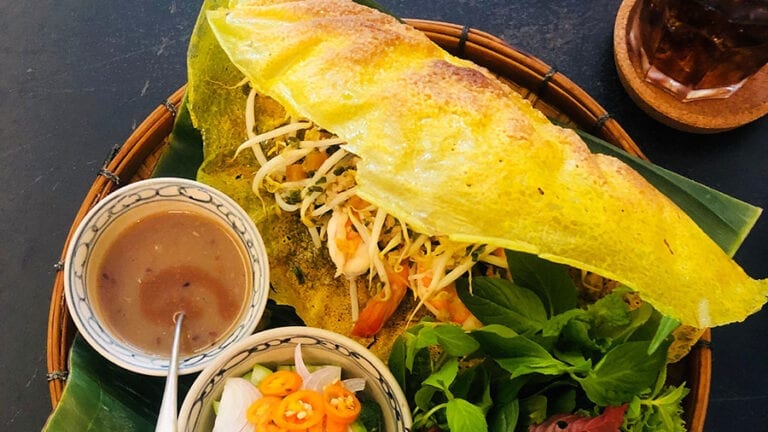
Banh Xeo (Vietnamese crepe) was one of the Vietnamese dishes participating in the 2016 Street Food Congress (WSFC), which was held in Manila, Philippines. According to CNN, this was one of the most popular street food in the world in 2016. There are two types of Banh Xeo, Banh Xeo of the Mekong Delta people (usually bigger and softer) and Banh Xeo of the Central Vietnam people (smaller and more brittle).
Due to the popularity it has gained among the foodies from all over the world, the fillings have been added to maximize the dining experience. Authentically, however, Banh Xeo is stuffed with pork belly, shrimp, bean sprouts, and mung beans. The “right” Banh Xeo batter is mixed with coconut milk, added garlic chives, and has to be fried in pork fat. Banh Xeo is no good as take-away food as what makes it really stand out is the dining vibes: the constant sizzling noise on the background, the scent of coconut milk, and turmeric powder as well as the vibrant talking of the eaters who gather to share not only food but stories.
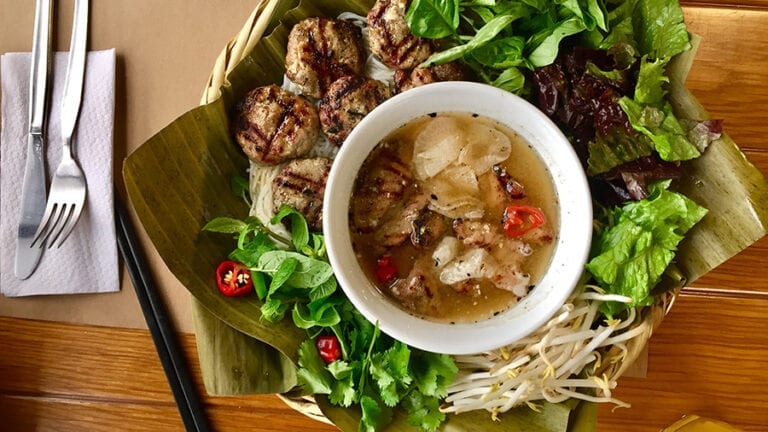
Bun Cha has been voted CNN’s top 10 delicious summer food, National Geographic’s top 10 best street food in the world, which was more famous after president Obama enjoyed this dish in Hanoi in 2016.
Bun Cha consists of three main parts: dipping sauce, grilled pork, and rice noodle. The success of Bun Cha is determined by the dipping sauce. Sauce to eat Bun Cha is a combination of fish sauce, vinegar, sugar, garlic, chili, green papaya, and carrots.
Bun Cha is a perfect combination of five flavors: bitter (from herbs and pickled papaya), spicy (from chili), sour (from lemon and vinegar), salty (from grilled pork), and sweet (from meatballs).
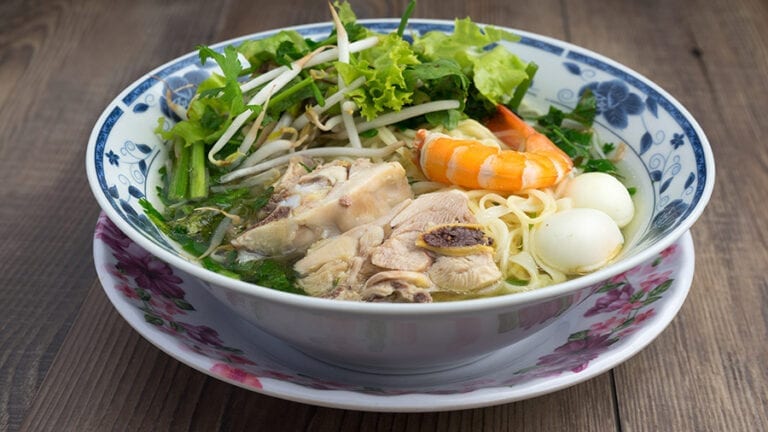
For thousands of years of wet rice cultivation, Vietnamese have processed rice into many different dishes, typically noodles, Pho, vermicelli, and Hu Tieu. Hu Tieu is a delicacy born from the essence of rice in one of the largest rice-growing regions in the world: the Mekong Delta.
When being ordered, the cook blanches noodles in a separate pot of boiling water before presenting them in the bowl with blanched bean sprouts, chopped scallions, sliced pork, shrimp, and quail eggs. It is often served with green vegetables and basil.
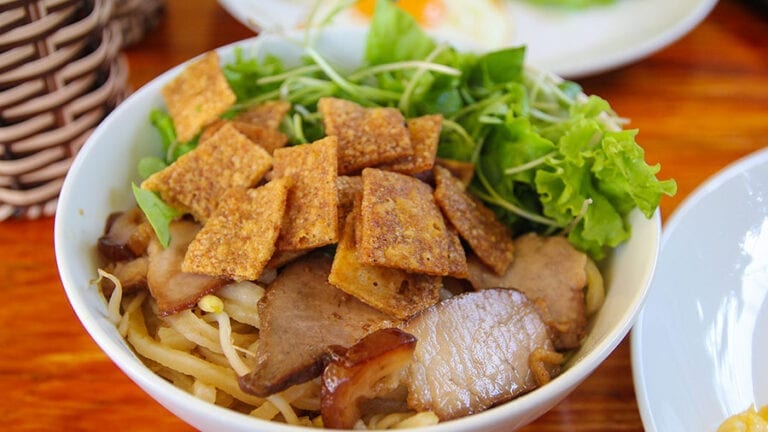
Cao Lau was voted the best street food in Asia by Australia Traveler News. This dish has been mentioned many times by CNN as one of the best dishes in Vietnam. Cao Lau is a specialty of Hoi An ancient town.
A special feature of Cao Lau is the yellow noodles, which make from rice soaked with ash – from trees in Cham Island, Hoi An. It does not need much broth, but instead, Cao Lau must have minced meat, soy sauce, and roasted pork skin.
Cao Lau is often sold in restaurants with two floors, which are hanging red and blue lanterns. Tourists have enjoyed the delicious taste of Cao Lau and the ancient tourist atmosphere of street corners.
10. Vietnamese Coffee
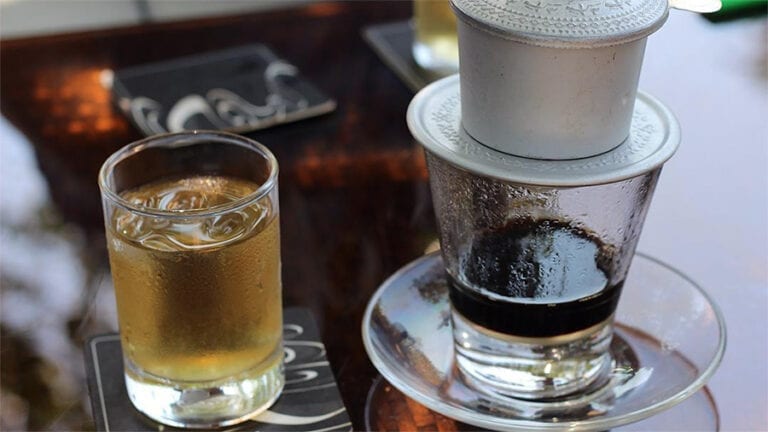
You may not know it, but Vietnam is the second biggest exporter of coffee in the world. And the coffee here is unlike any you’ve ever seen, Vietnamese often drink coffee with condensed milk, coconut, and sometimes with … eggs. Vietnamese coffee is usually Robusta, stronger than any other type of coffee; a cup can make you awake all day.
Vietnamese drink coffee anywhere and anytime, coffee is so popular that you can find coffee shops anywhere for about 15.000 VND (less than 1 dollar).
Tips and notes
1. Watch carefully when crossing the road: As you know, traffic in Vietnam is quite messy, especially in big cities, so always follow closely and obey traffic signals when crossing the road to ensure your safety. Don’t be afraid as it would be a highlighted experience of your travel. You can always follow a local nearby to cross, we are sure they will happy to help.
2. Keep your phone and wallet carefully when visiting crowded attractions: Anyplace in the world has good and bad people, so remember to keep your personal belongings carefully, especially valuable items. If you visit crowded places, it is a good idea to wear your package on your front.
3. Mo torbike Safety: If you are planning to rent a motorbike in Vietnam, you must have an international driving license and always wear a helmet when driving. Make sure to test the bike carefully to see if it fully functions before going on a long trip.
4. Step Out of Your Comfort Zone: Vietnam is a land with many interesting, strange and unexpected things, especially in cuisine, the street food looks gruesome such as “flipped duck eggs” (aka baluts) or “Bun Dau Mam Tom”, but believe us, they are delicious! Even if it is not tasty for you, it is still a unique experience, isn’t it?
5. Tip or not tip? In Vietnam, there is almost no “tip culture”, in most cases, you don’t need to tip; but at the following services, tips are often accepted: Spa, massage, nails, foot-massage, tour guide: 3 – 5 USD.
6. Saving the phone number of the embassy (or consulate) of your country in Vietnam. An additional copy of passport, travel insurance, and air tickets to provide in case of loss.
Vietnam itineraries
Here are some suggested Vietnam itineraries you can refer to. The itineraries include detailed information on maps, routes, and costs. Click on the images to learn more!
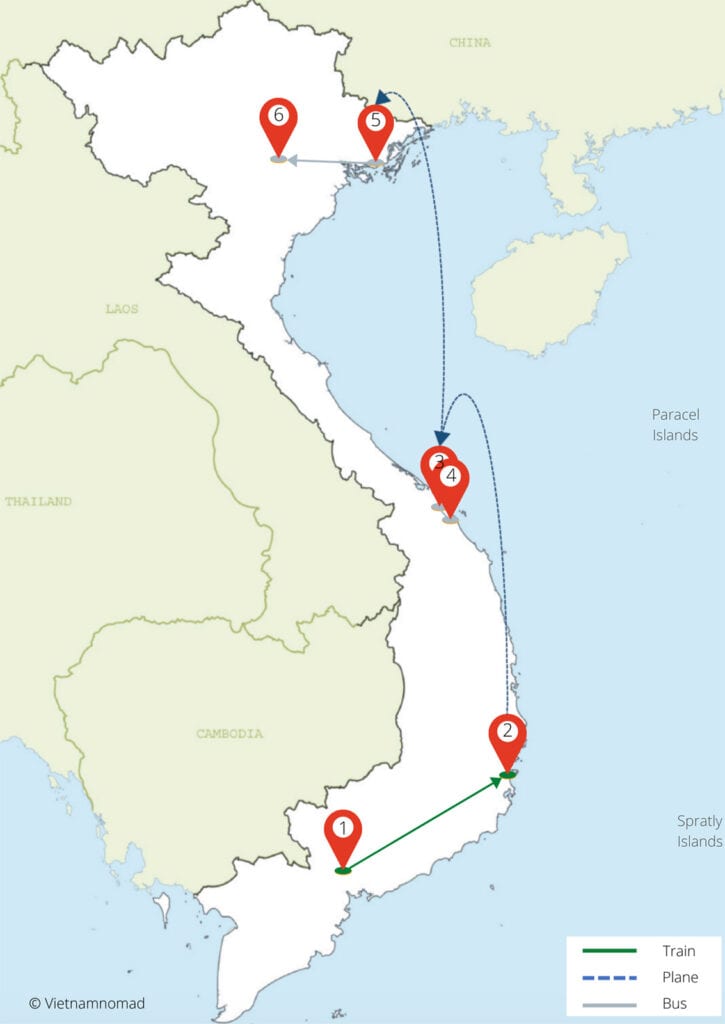
Vietnam travel guide book
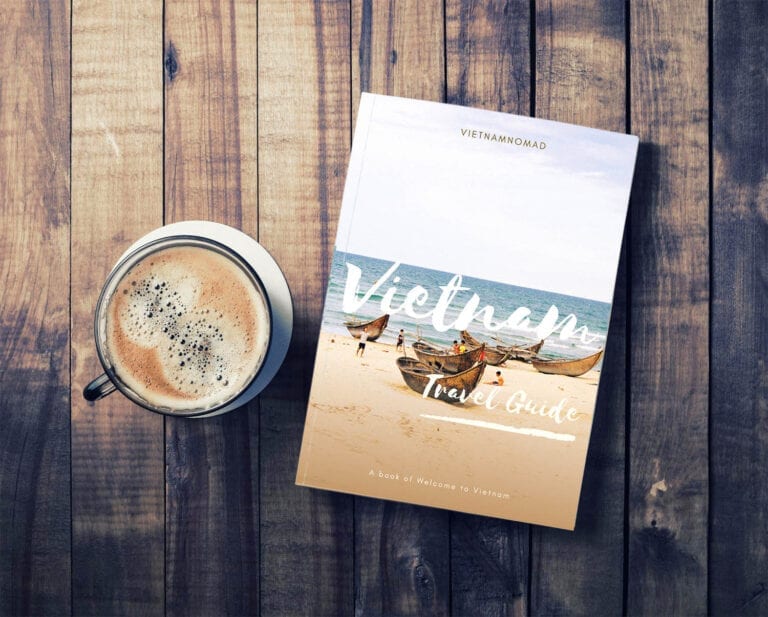
We would like to recommend a great companion: the Vietnam Travel Guide. The book contains travel information from overview to detail, consists of 6 chapters, 135 pages, which is designed in the form of graphics and visual images.
Read more >
Vietnam travel FAQs
What zone is vietnam in.
Vietnam is GMT/UTC + 7h during Standard Time (GMT +7) .
Is Vietnam worth a visit?
As a country that owns beautiful beaches, magnificent natural caves, delicious street food, fascinating history, and unique culture, Vietnam must be on the list of destinations to visit at least once in your lifetime.
What is the main language spoken in Vietnam?
Vietnamese’s native language is known as Vietnamese or the Kinh dialect, which is widely spoken by the majority of the Vietnamese. The language is written in the form of Latin alphabets with the addition of five tones. It may be tricky to learn, however, considered as tourist-friendly compared to other character languages in the area.
Do people in Vietnam speak English?
English is the common language in Vietnam. Vietnam ranks 31st among 72 countries in the world and seventh among 19 Asian countries in English proficiency, according to the latest annual English Proficiency Index released by the Swiss Education First (EF).
Is Vietnam safe for tourists?
Do you know? Vietnam is one of the safest countries in the world. A country without war, without ethnic conflict, without guns, without violence, and without terror. According to a recent survey, 78% of Vietnamese people feel that their life is happy or very happy .
What can you buy in Vietnam for 1$?
1 USD is equivalent to about 23.300 VND , a nutritious breakfast such as Pho or Hu Tieu, 2 cups of coffee, 2 loaves of bread, 4 bus tickets in Ho Chi Minh City, 4 500ml bottles of mineral water,… even a dinner!
How many days do you need in Vietnam?
Two weeks is sufficient time to explore Vietnam’s famous localities, but if you want to enjoy more fully, then four weeks would be ideal; 30 days is also the maximum stay for Vietnam E-Visa.
Is street food safe in Vietnam?
Street food is a Vietnamese specialty, mostly safe, but sometimes you can have a little stomach ache with strange foods. But it’s okay, you are traveling, right?
Should you tip at a restaurant in Vietnam?
To be honest, in Vietnam, we don’t have (or very little) “tip culture”. So if you eat in small or medium eateries, you don’t need to worry about it, just pay the right amount on the menu. Of course, you can tip a small amount if you wish to (we’re sure the server would be happy too) but note that it is not necessary.
Thank you for reading the Vietnam travel guide!
#MeetinVietnam
- Vietnam travel guide
Related Articles

- 3 Other destinations
- 4.1 History
- 4.2 Politics
- 4.3 Economy
- 4.5 Culture
- 4.6 Climate
- 4.9 Holidays
- 4.10 See also
- 4.11 Tourist information
- 6.1.1 Visa-free entry
- 6.1.2 E-Visa
- 6.1.3 Regular visa
- 6.1.4 Dual citizens
- 6.2 By plane
- 6.3 By train
- 6.4.1 Cambodia
- 6.4.2 China
- 6.5 By boat
- 7.1.1 Destinations
- 7.1.2 Seats and carriages
- 7.1.3 Tickets
- 7.2.2 Stay safe
- 7.3 By plane
- 7.4 By bicycle
- 7.5 By motorbike
- 7.6.1 By metered taxi
- 7.6.2 By xe ôm
- 7.7 By cyclo
- 7.8 By boat
- 7.10 On foot
- 8.1 Architecture
- 8.2 City life
- 8.3 Landscapes and nature
- 8.4 Museums
- 9.1 Motorbiking
- 10.1.1 ATMs
- 10.1.2 Credit cards
- 10.1.3 Cashless payment
- 10.1.4 Money exchange
- 10.1.5 Banking
- 10.1.6 Acceptance of other currency
- 10.2 Tipping
- 10.3.1 Tax refund
- 10.3.2 Price discrimination
- 10.3.3 Supermarkets
- 10.3.4 Costs
- 11.1 Dietary restrictions
- 12.2 Coffee
- 12.3 Soft drinks
- 12.4 Wine and liquor
- 16.1 Unexploded ordnance
- 16.3 Corruption
- 16.4 Prostitution
- 16.5.1 Taxis
- 16.5.2 Taxi and cyclo drivers
- 16.5.3 Hotels
- 16.5.4 Restaurants
- 16.5.5 Hostels
- 16.5.6 Copycats
- 16.5.7 Fake monks
- 16.6 Traffic
- 16.7 Nightlife
- 16.8 Wildlife
- 16.9 LGBT travellers
- 16.10 Politics
- 17.1 Healthcare
- 18.1 Politics
- 18.2 The American War
- 18.3 Religion
- 19.1 Electricity
- 20.1.1 Mobile phones
- 20.1.2 Useful numbers
- 20.2 Internet
Vietnam ( Vietnamese : Việt Nam) is a country in Southeast Asia with great food and a wealth of natural and cultural attractions. Despite the turmoil of the Vietnam War (called the American War in Vietnam), Vietnam has emerged from the ashes since the 1990s and is undergoing rapid economic development, driven by its young and industrious population. It remains less developed as a tourist destination than Thailand .
Regions [ edit ]

Cities [ edit ]
- 21.0245 105.84117 1 Hanoi ( Hà Nội ) — Vietnam's capital, a historic city with a wealth of cultural and historical sites
- 10.775556 106.701944 2 Ho Chi Minh City ( Thành Phố Hồ Chí Minh ) — Vietnam's largest and most cosmopolitan city, formerly known as Saigon ( Sài Gòn ) when it was the capital of South Vietnam
- 16.069444 108.209722 3 Da Nang ( Đà Nẵng ) — The largest city in central Vietnam
- 11.941667 108.438333 4 Dalat ( Đà Lạt ) — A French colonial hill station in the highlands
- 20.8 106.666667 5 Haiphong ( Hải Phòng ) — The "port city", a major port in north Vietnam
- 15.877669 108.33265 6 Hoi An ( Hội An ) — A well-preserved ancient port, near the ruins of My Son
- 16.456111 107.576389 7 Hue ( Huế ) — The former home of Vietnam's emperors
- 12.245 109.191667 8 Nha Trang — A burgeoning beach resort
- 18.673333 105.692222 9 Vinh — The major city in north-central Vietnam with very nice Cua Lo Beach
Other destinations [ edit ]
- Con Dao — Islands off the Mekong Delta
- Cu Chi — The site of the Cu Chi Tunnels
- Cuc Phuong National Park — Home to some of Asia's rarest wildlife and the Muong hill people
- The DMZ — The ruins of old American military bases, spectacular mountain scenery and rugged jungles
- Ha Long Bay — Famous for its unearthly scenery
- Ninh Binh — Ha Long Bay-like karst scenery along the river
- Phu Quoc — An island just off the coast of Cambodia, known for its beaches, fish sauce and seafood
- Sa Pa — A region to meet native indigenous people in the hills by the Chinese border
- Phong Nha Caves – A World Heritage cave system in Quang Binh province.
Understand [ edit ]
Vietnam, originally a dynasty until 1945, has been a socialist state under an authoritarian system since unification in 1976. The country has about 100 million inhabitants and provides a staggering variety of forest landscapes and a complex cultural history.
History [ edit ]
Vietnam's history is one of war, colonization and rebellion. Occupied by China no fewer than four times, the Vietnamese managed to fight off the invaders just as often. Even during the periods in history when Vietnam was independent, it was mostly a tributary state to Imperial China until the French colonization. Vietnam's last emperors were the Nguyễn Dynasty , who ruled from their capital at Hue from 1802 to 1945, although France exploited the succession crisis after the death of Tự Đức to de facto colonise Vietnam after 1884. Both the Chinese occupation and French colonization have left a lasting impact on Vietnamese culture, with Confucianism forming the basis of Vietnamese social etiquette, and the French influencing Vietnamese cuisine.
After a brief Japanese occupation in World War II (see Pacific War ), the Communist Viet Minh under the leadership of Hồ Chí Minh continued the war of independence against the French. The last Emperor Bao Dai abdicated in 1945 with a proclamation of independence following soon after. The majority of French had left by 1945, but in 1946 they returned to continue the fight until their decisive defeat at Dien Bien Phu in 1954. The Geneva Conference partitioned the country into two at the 17th parallel, with a communist-led North supported by the Soviet Union, and Ngô Đình Diệm establishing a capitalist regime and declaring himself President of the Republic of Vietnam in the South, supported by the United States.
South Vietnam would be plagued by numerous domestic problems, including corruption, nepotism and electoral fraud. Diệm, who was a Roman Catholic, enacted laws that discriminated against the Buddhist majority, which led to the Buddhist monk Thích Quảng Đức self-immolating in protest at a busy intersection in Saigon in 1963. U.S. economic and military aid to South Vietnam grew during the 1960s in an attempt to bolster the South Vietnamese government. This escalated into the dispatch of 500,000 American troops in 1966 and what became known as the Vietnam War in the West (the Vietnamese refer to it as the American War ). What was supposed to be a quick and decisive action soon degenerated into a quagmire, and U.S. armed forces withdrew following a cease-fire agreement in 1973. Two years later, on April 30, 1975, a North Vietnamese tank drove into the South's Presidential Palace in Saigon and the war ended. An estimated 3 million Vietnamese and over 55,000 Americans were killed. Vietnam's war against the United States was one of many that they have fought, but it was the most brutal in its history. Most of the nation's population was born after 1975. American tourists will receive a particularly friendly welcome in Vietnam, as many young Vietnamese are admirers of American culture. See Indochina Wars for more on these conflicts.
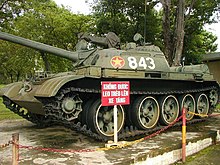
After unifying the country, the communist government proceeded to root out the remaining capitalist elements in the south. Many business owners were killed while others, known as the boat people, became refugees and attempted to escape to Western countries, resulting in the establishment of Vietnamese communities in many countries, including the United States , Australia and Canada . The ethnic Chinese, long resented by the ethnic Vietnamese for their perceived economic clout, were particularly hard-hit by the purges.
Following the collapse of the state-run economy, the government implemented market-oriented reforms and introduced capitalist elements in 1986 with a policy known as đổi mới . This policy has proved highly successful, as it spurred impressive economic growth and infrastructure development. Discriminatory laws against the remaining ethnic Chinese were repealed, and many have used their business acumen to contribute greatly to the revitalisation of the Vietnamese economy, also regaining some of their previous economic dominance in the process. Relations with the United States have thawed considerably, with formal defence ties having been re-established in 2016. Some former refugees or their descendants, most of whom were raised and educated in the West, have returned to Vietnam to take advantage of new economic opportunities. Today, Vietnam is widely considered to be one of the rising stars of Asia with a young population and vibrant economy.
Politics [ edit ]
The Socialist Republic of Vietnam (Cộng hòa xã hội chủ nghĩa Việt Nam) is a one-party authoritarian state, with the General Secretary of the Communist Party of Vietnam as the supreme leader, the president as the head of state and the prime minister as the head of government. The Vietnamese legislature is the unicameral National Assembly , from which the prime minister is selected. In practice, the president's position is only ceremonial, with the prime minister wielding the most authority in government.
Economy [ edit ]
Economic reconstruction of the reunited country has proven difficult. After the failures of the state-run economy started to become apparent, the country launched a program of đổi mới (renovation), introducing elements of capitalism. The policy has proved highly successful, with Vietnam recording near 10% growth yearly (except for a brief interruption during the Asian economic crisis of 1997). The economy is much stronger than those of neighboring Cambodia and Laos. Like most Communist countries around the world, there is a fine balance between allowing foreign investors and opening up the market.
There used to be extreme restrictions on foreigners owning property or attempting to sell. However, a property regulation announced in 2015 allows foreigners to own and lease apartments in Vietnam.
It is very difficult for them to trade without negotiating 'fees'. Business can be done via local partnerships with all the attendant risks.
Power and services is another issue. There are often rolling blackouts at times when there is not enough electricity. For this reason, many shops have portable generators.
According to government estimates, Vietnam saw 12.9 million tourist arrivals in 2017. Just 5% of visitors to Vietnam return for another holiday, compared to Thailand's whopping 50% return rate.
People [ edit ]
Most people in Vietnam are ethnic Vietnamese (Kinh), though there are many minority groups who tend to live in the highlands or big cities. The three biggest minorities are the Tay people, Thais and Muong. Others include the Khmers and Hmong. There is a sizable ethnic Chinese community in Ho Chi Minh City, most of whom are descended from migrants from Guangdong province and are hence bilingual in Cantonese, Teochew or other Chinese dialects and Vietnamese. The Chams, who live in the southern coastal areas of the country, represent the bulk of Muslims in Vietnam.
Buddhism , mostly of the Mahayana school, is the largest religion in Vietnam, with over 80% of Vietnamese people practising it to one degree or another, albeit usually syncretised with Taoism, Confucianism and Vietnamese folk religion. Christianity (mostly Roman Catholicism) is the second largest religion at 11%, followed by the local Cao Dai religion. Islam , Hinduism and local religions also share small followings throughout the southern and central areas.
Culture [ edit ]
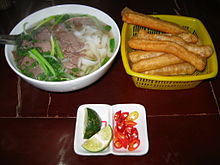
Due to its long history as a tributary state of China, as well as several periods of Chinese occupations, Vietnamese culture is strongly influenced by that of southern China, with Confucianism forming the basis of Vietnamese social etiquette. The Vietnamese language also contains many loan words from Chinese, though the two languages are unrelated. Buddhism remains the single largest religion in Vietnam. As in China, but unlike its Southeast Asian neighbors, the dominant school of Buddhism in Vietnam is the Mahayana School.
Nevertheless, Vietnamese culture remains distinct from Chinese culture as it has also absorbed cultural elements from neighboring Hindu civilizations such as the Champa and the Khmer empires. The French colonization also left a lasting impact on Vietnamese society, perhaps symbolised best by the Vietnamese fondness for baguettes and coffee. Southern and Central Vietnam, especially along the coast, have a much stronger Western influence, as compared to the North.
The division of Vietnam during what is locally called the American War has also resulted in cultural differences between northern and southern Vietnam that can be seen today. To this day, northern Vietnamese have a tendency to be more ideological, while southern Vietnamese tend to be more business-minded.
Vietnam is known for several traditional arts, with perhaps the most famous being water puppetry . In modern times, Vietnam has also jumped on the cirque nouveau bandwagon, with AO Show from Ho Chi Minh City perhaps being the best known example. Vietnam is also home to a vibrant pop music scene, with South Korean pop being the biggest influence on modern Vietnamese pop music.
Climate [ edit ]
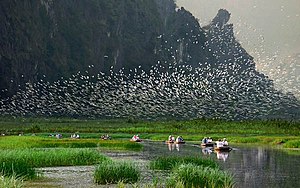
Vietnam is large enough to have several distinct climate zones.
- The south has three somewhat distinct seasons: hot and dry from Mar-Apr; rainy from May-Nov; and cool and dry from Dec-Feb. April is the hottest month, with mid-day temperatures of 33°C (91°F) or more most days. During the rainy season, downpours can happen every afternoon, and occasional street flooding occurs. Temperatures range from stifling hot before a rainstorm to pleasantly cool afterwards. Mosquitoes are most numerous in the rainy season. Dec-Feb is the most pleasant time to visit, with cool evenings down to around 20°C (68°F).
- The north has four distinct seasons, with a comparatively chilly winter (temperatures can dip below 15°C/59°F in Hanoi), a hot and rainy summer and pleasant spring (Mar-Apr) and autumn (Oct-Dec) seasons. However, in the Highlands both extremes are amplified, with occasional snow in the winter and temperatures hitting 40°C (104°F) in the summer.
- In the central regions the Hai Van pass separates two different weather patterns of the north starting in Langco (which is hotter in summer and cooler in winter) from the milder conditions south starting in Da Nang. Northeast monsoon conditions Sep-Feb often have strong winds, large sea swells and rain. This is a miserable and difficult time to travel through Central Vietnam by motorbike. Normally summers are hot and dry.
Read [ edit ]
- Catfish and Mandala: A Two-Wheeled Voyage Through the Landscape and Memory of Vietnam by Andrew X. Pham (2000).
- The Quiet American by Graham Greene (1955). Set in 1950s Saigon. A love triangle with a historical backdrop. 2 film adaptations: 1958 & 2002.
- The Lover by Marguerite Duras (1984) (original title: L'amant ). Film adaptation: 1992 starring Jane March, directed by Jean-Jacques Annaud.
Watch [ edit ]
- Indochine (French, 1992), with Catherine Deneuve, directed by Régis Wargnier. Set in 1930s French Indochina. A good storyline with some interesting insights on the history and politics of the time. Set around Saigon.
- Cyclo (Vietnamese, 1995). Set in Saigon, a dive into the murky violence and poverty of 1990s Saigon.
Holidays [ edit ]
By far the largest holiday is Tết — the Lunar New Year — which takes place between late January and March. In the period leading up to Tết, the country is abuzz with preparations. Guys on motorbikes rush around delivering potted tangerine trees and flowering bushes, the traditional household decorations. People get a little bit stressed out and the elbows get sharper, especially in big cities, where the usual hectic level of traffic becomes almost homicidal. Then a few days before Tết the pace begins to slow down, as thousands of city residents depart for their ancestral hometowns in the provinces. Finally on the first day of the new year an abrupt transformation occurs: the streets become quiet, almost deserted. Nearly all shops and restaurants close for three days, (the exception being a few that cater especially to foreign visitors; and hotels operate as usual.)
In the major cities, streets are decorated with lights and public festivities are organized which attract many thousands of residents. But for Vietnamese, Tết is mostly a private, family celebration. On the eve of the new year, families gather together and exchange good wishes (from more junior to more senior) and gifts of "lucky money" (from more senior to more junior). In the first three days of the year, the daytime hours are devoted to visiting: houses of relatives on the first day, closest friends and important colleagues on the second day, and everyone else on the third day. Many people also visit pagodas. The evening hours are spent drinking and gambling (men) or chatting, playing, singing karaoke, and enjoying traditional snacks and sweets (for women and children.)
Visiting Vietnam during Tết has good points and bad points. On the minus side: modes of transport are jammed just before the holiday as many Vietnamese travel to their home towns; hotels fill up, especially in smaller towns; and your choice of shopping and dining is severely limited in the first days of the new year (with a few places closed for up to two weeks). On the plus side, you can observe the preparations and enjoy the public festivities; pagodas are especially active; no admission is charged to those museums and historical sites that stay open; and the foreigner-oriented travel industry of backpacker buses and resort hotels chugs along as usual. Visitors also stand a chance of being invited to join the festivities, especially if you have some local connections or manage to make some Vietnamese friends during your stay. When visiting during Tết, it's wise to get settled somewhere at least two days before the new year, and don't try to move again until a couple of days after.
Lesser holidays include 1 May, the traditional socialist labor day, 2 September, Vietnam's national day, King Hung celebration on 10 March of Lunar Calendar, commemorating past kings, and Reunification Day on 30 April, marking the fall of Saigon in 1975. Around those times, trains and planes tend to be sold out, and accommodation at the beach or in Dalat are hard to find. Best to book far in advance.
See also [ edit ]
- Vietnamese phrasebook
- Driving in Vietnam
- Trekking in Vietnam
- Vietnam by motorcycle
- Vietnamese cuisine
Tourist information [ edit ]
- Vietnam Travel website
Talk [ edit ]
The official language of Vietnam is Vietnamese ( Tiếng Việt ). Vietnamese is a tonal language that uses a change in pitch to inflect different meanings, and this can make it difficult to master. Travellers may still be surprised to learn that the basic grammar is pretty simple. Verbs are static regardless of the past or future and parts of speech are pretty straightforward. The major difficulties lie in the pronunciation of the various tones and some of the sounds. Vietnamese is an Austroasiatic language that is related to Khmer, though the two languages are not mutually intelligible.
Vietnamese consists of 5 main dialects: the northern dialect spoken around Hanoi, the north-central dialect spoken around Vinh, the central dialect spoken around Hue, the south-central dialect spoken around Phu Yen and the southern dialect spoken around Ho Chi Minh City.
While the Hanoi dialect is the prestige dialect and widely used in broadcasting, there is no legally-defined standard dialect of Vietnamese. Northerners often think that the southern dialect is for "hai lúa" (country folk) and will always recommend that you stick to the northern dialect, but the choice of dialect should depend on where you plan to stay. If you are working in Ho Chi Minh City , the main economic centre of Vietnam, the southern dialect is what you will hear every day. The southern dialect is also more prevalent among Vietnamese communities in the West due to the southern origin of most of the Vietnam War refugees.
Vietnamese uses the Latin alphabet (with heavy use of diacritics), and the spelling accurately reflects the pronunciation. However, the pronunciation of the letters is often different from that in English.
Although Chinese characters are no longer used to write Vietnamese, the Vietnamese lexicon continues to be heavily influenced by the Chinese language. Some words are loanwords from Chinese like "hotel" (khách sạn), "children" (nhi đồng), "communist party" (đảng cộng sản); some are formed based on Chinese roots (characters), like "representative" (đại diện) or "bird flu" (cúm gà). Any knowledge of the Chinese language will make it much easier to learn Vietnamese. Chinese characters are sometimes still used for ceremonial purposes, such as in Buddhist and Taoist temples, but in general most Vietnamese are unable to read them. Vietnamese is also full of French and English loanwords. Nowadays, some English words are used directly in Vietnamese: camera, clip, internet, jeans, PC, sandwich, selfie, radar, show, smartphone, tablet, TV, etc.
Although the Vietnamese people appreciate any effort to learn their language, most seldom experience foreign accents. Consequently, learners may find it frustrating that no one can understand what they try to say. Staff in hotels and children tend to have a more tolerant ear for foreign accents and it is not unheard of for children to effectively help translate your badly pronounced Vietnamese into authentic Vietnamese for adults.
Ho Chi Minh City is home to a sizeable ethnic Chinese community, many of whom speak Cantonese . The more remote parts of the country are also home to many ethnic minorities who speak various languages belonging to the Mon-Khmer, Tai-Kadai and Austronesian language families.
Most younger Vietnamese learn English in school, but proficiency is generally poor. However, most hotel and airline staff will know enough English to communicate. Younger upper and middle class Vietnamese generally have a basic grasp of English. Road directional signs are generally bilingual in Vietnamese and English. Vietnamese people are much more adept at using 'Translate' Apps on phones than in neighbouring countries and will readily use these as means of communicating in English as well as other languages.
As a result of its colonial legacy, educated senior citizens are able to speak French . However, English has supplanted French as the main foreign language among the younger generations.
Russian is also spoken by some Vietnamese who have studied, worked, or done business in the USSR or Russia.
In the big cities, some of the big international luxury hotel chains will have staff who can speak other foreign languages such as Mandarin, Japanese, or Korean. At the more popular tourist sites, such as Hanoi's Temple of Literature, guides conduct tours in a number of foreign languages, including German, French, Spanish, Mandarin, Korean or Japanese.
Get in [ edit ]
Entry requirements [ edit ], visa-free entry [ edit ].
As of 2023/2024, visitors from the following countries, with their passport validity being at least 6 months from the date of entry, do not require a visa and can stay for the following number of days:
- 14 days: Brunei , Myanmar
- 21 days: Philippines
- 30 days: Indonesia , Kyrgyzstan , Laos , Malaysia , Singapore , Thailand , Cambodia
- 45 days: Belarus , Denmark , Finland , France , Germany , Italy , Japan , Norway , South Korea , Spain , Sweden , Russia , the United Kingdom (valid until 14 March 2025)
- 90 days: Chile , Panama
No specific waiting time is necessary between exit and re-entry on visa-free or visa-based visits to Vietnam. The visa-free period is calculated anew for every entry.
Further visa-free entries into Vietnam include:
- Any foreigner on a permanent or temporary residence permit.
- Any foreigner travelling in a border economic zone (e.g. Ha Tien ) for no more than 15 days, or in a special administrative and economic zone or a coastal economic zone like Phu Quoc island, off of the southwestern coast, for no more than 30 days. In order to boost tourism, the Vietnamese government has made these changes for Phu Quoc. Phu Quoc International Airport ( PQC IATA ) receives some direct flights from European airports such as Stockholm-Arlanda operated by Thomson , and flights from destinations in Asia. Also, those flying through Ho Chi Minh City (transit) or arriving by boat will not need to apply for a visa beforehand. Those wishing to travel elsewhere afterwards can apply for a proper Vietnamese visa at the local immigration office.
- Any foreign citizen of Vietnamese origin, who can apply for visa exemption that allows multiple entry for 3 months at a time which is valid for the duration of the passport.
In all other cases a visa in advance is required to visit Vietnam — see below. The previous visa-on-arrival scheme has been terminated.
E-Visa [ edit ]

Visitors from many countries , including most Western ones, are eligible for an electronic visa (e-Visa), which you apply for through the official online portal and print out yourself after approval (twice). It typically takes 3 working days to process, costs US$25 (single-entry) or US$50 (multiple-entry), and is valid 30 to 90 days, depending on you nationality and type of visa.
Don't forget to pay, which is a separate step after confirming your application, otherwise your visa application will be on hold! Also, the automatic email confirmation is not reliable and you have to check for yourself online whether you have received the visa. You must print out two paper copies of your visa once it is approved. You will need to submit one copy to the immigration officer when entering the country, and submit the other one to the immigration officer when leaving. You may also need to show it when checking in for your flight.
E-Visas are valid at major airports and seaports, and most but not all land crossings , e.g. not at the Oyadav–Lệ Thanh crossing between Banlung (Cambodia) and Pleiku (Vietnam). A full list of valid crossings is available on the e-Visa website, though many of them use obscure local names that can be difficult to find on maps.
In theory, entry and exit from the country should be from the same airport, seaport, or land crossing as stipulated on the e-Visa form, but in reality this is usually not enforced on the way out. However, you must enter on the date and at the place stipulated on the visa; you will be denied entry if you arrive on the wrong date or at the wrong port of entry. You will also be denied entry if there are typos in vital data on your eVisa such as your name or birth date.
Multiple entry and extended duration, are available with additional documents and information required.
Regular visa [ edit ]
Those not eligible for an eVisa can apply for a regular visa at most Vietnamese embassies and consulates abroad. The cost of applying depends on your nationality and the embassy or consulate you are applying at, but it will generally cost at least double the price of the eVisa. Check with the Vietnamese embassy or consulate in your country of residence, or the country you are in, for details. Embassies are (oddly) reluctant to announce fees on their websites, as the relatively high visa costs are a tourism deterrent, but nevertheless a source of revenue. Email or, even better, call them to get up-to-date information on prices. Or if you are in the same city, walk in and ask in person.
A regular visa may be required for people eligible for e-Visa, in case you want to enter at a remote border crossing that isn't included in the e-Visa system.
If your country does not have a Vietnamese embassy or consulate, a popular alternative would be to apply at the Vietnamese diplomatic missions in Bangkok , Sihanoukville or Phnom Penh . As of 2019, one of the reportedly cheapest places to get a visa are the Vietnamese embassy and consulates in Cambodia, starting at US$40 for a one-month, single entry visa. You may be able to apply for a visa and get it back later the same day; for example, at the Vietnamese embassy in Phnom Penh. Make sure to inquire about the details, since if you don't complete the application before a certain time of day, you will need to wait until the next day to pick up the visa and your passport.
Dual citizens [ edit ]
If you are a citizen of two foreign countries, you may be entering Vietnam on a different passport (Country A) than the one you have used to leave the previous country on your itinerary (Country B's passport) (e.g. because Country A's passport has a Vietnamese visa or offers a visa-free entry to Vietnam, while Country B's passport has a visa for the previous visited country). In this case, the Vietnamese immigration inspector will likely want to see the exit stamp and/or visa in your Country B passport as well. He may suggest putting the Vietnamese entry stamp into Country B passport as well, so that all your stamps would be in one place. Don't take him up on his offer; make sure that the Vietnamese entry stamp goes into the passport that either has the Vietnamese visa, or offers visa-free entry to Vietnam. Otherwise, you risk having problems when leaving Vietnam; the border control officers at your attempted exit point may declare your entry stamp "invalid" and send you back to your original point of entry to have the error corrected.
By plane [ edit ]
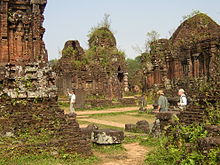
Vietnam's main international airports are located at Hanoi ( HAN IATA ) and Ho Chi Minh City ( SGN IATA ). Both airports are served by numerous flights from major cities in East Asia and Southeast Asia , with some intercontinental services to Australia , Europe and the United States .
International airports at Da Nang , Vinh , Nha Trang and Phu Quoc receive flights from neighboring Asian countries. As Da Nang is closer to the historical sites of Central Vietnam than the two main airports, it can make a convenient entry point for those who wish to visit those sites.
The national carrier is Vietnam Airlines , which operates flights into Vietnam's two largest cities from various cities in Australia, Asia and Europe. Vietnam Airlines serves most capital cities of Southeast Asian countries . The largest low cost carrier is Vietjet Air which flies to regional destinations including Bangkok, Chiang Mai, Hong Kong, New Delhi, Seoul, Singapore and Yangon.
By train [ edit ]
There is a nightly sleeper train between Nanning in China and Hanoi, taking 12 hours, including a tedious 2+2 hours at the border — see Hanoi#Get in for details. Through service are also available from Beijing , but travellers will need to change railway coaches at Nanning.
The old metre-gauge Kunming-Hanoi line has closed, and the simplest work-around is to take the high-speed train from Kunming to Nanning to join the overnight train to Hanoi. Another option is to travel to Hekou North Station in China, walk across the border from Hekou to Lao Cai , then take a Vietnamese train from Lao Cai to Hanoi. Both sides have several trains a day, so a daytime train from Kunming to Hekou can be matched with an overnight train from Lao Cai to Hanoi.
There are no railway links between Vietnam and Laos or Cambodia.
By road [ edit ]
Cambodia [ edit ].
Regarding bribes ; this is still a problem as of 2023, however most people encounter no issues when entering Vietnam by land. Certain border crossings, like the Bavet–Moc Bai crossing between Phnom Penh and Ho Chi Minh City , are known for demanding a 100,000–200,000 dong bribe from some people for giving the entry (but also exit) stamp — a claim is that this only applies to e-Visa. If you are one of the unlucky ones, try negotiating it down to 50,000 dong or be bold, put the 50,000 dong into your passport, walk up to the border officer desk in the VIP line, and hand over your passport. Check the reviews of the relevant border checkpoint on Google Maps to understand the situation and how to react. When travelling by bus, most likely the bus company will take care of the border formalities in exchange for a "service fee", so as to not to get stuck at the border. So, any potential bribe will already be included in this service fee or your bus ticket price.
The main crossing with Cambodia is the already above mentioned Bavet–Moc Bai crossing on the Phnom Penh–Ho Chi Minh City road. Buses between the two cities cost US$22–25 and take around 6–7 hr. Passengers are usually taken to a duty free shop for lunch while staff process them through immigration.
The Phnom Den–Tinh Bien crossing just north of Chau Doc . There is no regular boat service from Chau Doc onward towards Ho Chi Minh City or even other parts of the Mekong Delta , but you have to go by road.
Close to the coast is the Xa Xia–Prek Chak (Ha Tien) crossing . The Vietnamese consulate in Sihanoukville issues 30-day tourist visas on a same-day basis. Buses run between Sihanoukville and Phnom Penh , and Ha Tien and even Phu Quoc in Vietnam.
The Tro Peang Plong–Xa Mat crossing on the Kampong Cham – Ho Chi Minh City road is not well served by public transportation.
The Oyadav–Lệ Thanh crossing connects Banlung in North Eastern Cambodia and Pleiku in the Central Highlands of Vietnam. Vietnam e-Visas are not accepted for entering Vietnam at this border crossing. So, only visa-free nationalities or people with a traditional visa from an embassy/consulate can enter. The Vietnamese entry checkpoint closes to foreigners at 17:30.
China [ edit ]
There are three border crossings between China and Vietnam that can be used by foreigners:
- Dongxing - Mong Cai ( by road; onward travel Mong Cai to Ha Long by sea or by road )
- Hekou - Lao Cai ( by road and/or rail, but no international passenger train services )
- Youyi Guan - Huu Nghi Quan (Friendship Pass - by road and/or rail )
Laos [ edit ]
There are six border crossings between Laos and Vietnam that can be used by foreigners (from north to south):
- Tay Trang (Dien Bien province, Vietnam) - Sobboun (Phongsali province, Laos)
- Na Mao (Thanh Hoa province, Vietnam) - Namsoi (Houaphanh province, Laos)
- Nam Can (Vietnam) - Namkan (Xiangkhouang province, Laos)
- Kaew Neua - Cau Treo (Keo Nua Pass)
- Lao Bao (Vietnam) - Dansavan (Laos)
- Ngoc Hoi (Kon Tum province, Vietnam) - Bo Y (Attapeu province, Laos)
Be wary of catching local buses from Laos to Vietnam. Not only are they often crammed with cargo (coal and live chickens, often underfoot) but many buses run in the middle of the night, stopping for several hours in order to wait for the border to open at 07:00. Whilst waiting, you will be herded off the bus (for several hours) where you will be approached by pushy locals offering assistance in getting a Laos exit stamp in exchange for money (usually US$5+). If you bargain hard (tiring, at 04:00) you can get the figure down to about US$2. The men will take your passports, which can be disconcerting, but they do provide the service they promise. It is unclear whether you can just wait for the border officials to do this. There is also a VIP bus from Savannakhet.
By boat [ edit ]
Boats (4–5 hr) from Phnom Penh to Chau Doc run once a day — see Phnom Penh#By boat . They use the so called Song Tien landport border crossing on the banks of the Mekong River.
This journey between Phnom Penh and Ho Chi Minh City can also be stretched into a 2-nights/3-days Mekong Delta tour and provides a more insightful journey between the two cities, starting from about US$60–100. However, the only times on a boat with these tours will be the Phnom Penh–Chau Doc bit, a floating market morning boat tour from any of the overnight towns along the way, and the short Ben Tre – My Tho boat ride — the rest is by bus. For an actual boat tour of the Mekong Delta it will probably require several hundreds if not a thousand US dollars.
Get around [ edit ]

Trains are undoubtedly the most comfortable and an exciting way to travel overland in Vietnam.
Due to the steady increase of tourist bus prices, trains are now an inexpensive alternative to buses. While a night in a sleeper carriage is still more expensive than a sleeper bus, seat carriage prices are very competitive.
Destinations [ edit ]
There is one major train line in Vietnam, the 1,723 km (1,071 mi) trunk between Hanoi and Ho Chi Minh City (HCMC), on which the Reunification Express runs. HCMC to Hanoi is more than 30 hours, and overnight hops between major destinations are usually possible, if not entirely convenient. It is a good way to see the countryside and meet upper-middle class locals, but unless you are travelling in a sleeper car it is no more comfortable than buses.
In addition, there are shorter routes from Hanoi leading northwest and northeast, with international crossings into China . One of the most popular of the shorter routes is the overnight train from Hanoi to Lao Cai (with a bus service from Lao Cai to the tourist destination of Sapa ).
Seats and carriages [ edit ]
Air conditioned soft or hard sleeper berths are recommended for overnight trains. Otherwise air-conditioned soft seats are sufficiently comfortable to travel in them during the day. If you are sensitive to cigarette smoke try to book a seat closer to the middle of the carriage as people smoke in the areas at the end of the carriages and the doors are often left open.
At least in the sleeper carriages, there are hot and cold water dispensers and paper cups — tea or instant coffee may be a great idea. Toilets in the seater carriages can be squatting ones, whereas toilets in the sleeper carriages are regular ones. So, if possible, head to one of the sleeper carriages if the passage is not locked. There is always a sink separate from the toilet with water to wash your hands, but only the sleeper carriages may have soap and a dryer.
When buying a ticket, also check the sleeper carriages for availability. During day travel, some sleeper berths are priced almost as cheap as seats, the upper berth sometimes even cheaper. Note that the train personnel in Vietnam seems to enforce the bed selection and people are not sitting together on the lower seat during the day like in India. In the worst case, you will have to stay in sleeping position the whole trip, during the day. However, on the lower berth(s), two friends or on your own, with one or two pillows in your back, is a great way to chill and watch the landscapes fly buy. If the seater carriage is fully booked, be assured, so will be the sleeper soon. So, you will most likely have to stick to the selected berth, even if your side of the cabin was empty when you booked it. (In the 6-berth carriage, for more head space put the middle berth up half way and use the foot rest to keep it in that position.)
Tickets [ edit ]
In high season, purchasing as early as possible is a good idea. However, you can simply check the ticket situation online by checking near-future trains (in the next couple of days) to understand how early you need to book.
Booking online is possible through the official Vietnamese Railways website , which has an English version and accepts payments by international bank cards. The process is straight forward and works flawlessly — you will receive an e-ticket for download with a QR code in the end. Printing the e-ticket is not necessary if you got the QR code, but most larger railway stations will have a ticket printing machine anyways, just in case.
Prices fluctuate a little, by 5% or so, but booking early except for assuring a seat is not necessary. Prices for holiday periods are generally higher.
There are commercial websites to book your train ticket with, like Baolau or 12go.Asia . However, if the Vietnamese Railway website is working, there is no real reason to do so. Also, while they will assure you a seat on the train, they might lie about the type of seat, especially if the train is getting full. It happened to tourists in the past that they booked a regular seat but ended up with a sleeper berth, having to lie down the whole journey during daytime. It is best therefore to book directly, which will also ensure you the best price.
Booking at the train station itself is generally safe, but beware of scams by station staff . Prepare a piece of paper with the destination with date, time, no. of passengers and seat class, and, most importantly, know the price.
( It is unclear whether the following information is still relevant as of 2023. ) Popular berths and routes are often bought out by tour companies and travel agents well before the departure time. Being told the train is sold out at a station ticket window or popular tour company office does not mean there are no tickets available; they have simply been bought by another reseller. Unsold tickets can often be bought last minute from people hanging around at the station. A train is rarely sold out for real, as the railway company will add cars when demand is high. Commissions on these tickets will drop away as the departure time draws nearer. As of July 2018 tickets (now termed "boarding passes") do indicate the class of ticket, making scams with falsely promised seat classes less of an issue, although buying your ticket directly online or from the train station remains the best option.
By bus [ edit ]

Public buses travel between the cities' bus stations. In bigger places, you often have to use local transport to get into the city centre from there. Buses are generally in reasonable shape, and you have the chance to interact with locals.
Every major city will have a centralised bus station, and most of the major companies will have ticket offices at the stations. Bus stations are generally well organised, safe and easy enough to navigate even if you don't speak Vietnamese.
As a foreigner, you are likely to get overcharged on local buses, where you pay a conductor during the journey. Find out what the right fare is by looking up the price (it is displayed somewhere, often next to the front door on the outside of the bus; take a photo if you can), or by talking to one of the local travellers. Give the right amount and be prepared to argue your case. Nowadays however, many conductors will issue tickets, making it harder or less interesting for them to overcharge you.
Long-distance buses connect most cities in Vietnam. Most depart early in the morning to accommodate traffic and late afternoon rains, or run overnight. Average road speeds are typically quite slow, even when travelling between cities. For example, a 276 km (172 mi) journey from the Mekong Delta to Ho Chi Minh City by bus will likely take about 8 hours.
So called open tour buses are run by a multitude of tour companies. They cater especially to tourists, including door-to-door service to your desired hostel. You can break the journey at any point and continue on a bus of the same company any time later, or simply buy tickets just for the stage you're willing to cover next. If you are not planning to make more than 3-4 stops, it might be cheaper to buy separate tickets as you go. Buses without the journey break option are just called deluxe or inter-provincial buses .

There are seater buses available, especially during the day, sleeper buses , where instead of a seat, you get an angled-flat bunk bed that you can sleep on, and more expensive VIP sleeper bus , in which you get a wider bunk bed, your own cubicle for more privacy, and a personal TV system similar to those in aeroplanes.
Most ho(s)tels and guesthouses can book buses for you. However, they will try to book a more expensive option, because their commission is bigger then. So, you are better off to shop around at travel agents and bus companies directly, as prices will vary considerably on any given ticket or bus company — some buses (even sleeper) are as cheap as a seater railway carriage, e.g. FUTA Bus or Son Tung Bus (Hue and south). Booking with the bus company directly may net you a commission-free fare, but most companies have fixed pricing policies, which can only be circumvented through a travel agent.
If you are traveling with a bicycle , negotiate the extra fee with the driver rather than the ticket counter before buying your ticket. The bicycle fee should be no more than 10% of the ticket price.
Cope [ edit ]

Stop-offs are often at souvenir shops to give the bus company an extra income. You do not have to buy anything, but they always have toilets and drinks and water available for purchase. The estimated time for a bus trip will not be accurate and may be an additional couple of hours sometimes, due to the number of stop offs. Collecting the passengers at the start of the journey can also take quite a while too. Always be at least half an hour early to catch the bus. Try not to drink too much water, as rest stops, especially for overnight buses, may be just somewhere where there are a lot of bushes.
Vietnamese buses are made for Vietnamese people; bigger Westerners will be uncomfortable, especially on overnight buses. Also, many Vietnamese are not used to travelling on long-haul buses, and will sometimes get sick — not very pleasant if you are stuck on an overnight bus with several Vietnamese throwing up behind you.
Even if you are sometimes bus-sick, it is advisable to book a seat at the middle rather than at the front of the bus. First, you will avoid viewing directly the short-sighted risks the driver is taking on the way. Second, you will somewhat escape the loud noise of non-stop honking (each time the bus passes another vehicle, that is about every 10 seconds).
Although the bus company will usually be happy to collect you at your hotel or guest house, boarding at the company office will guarantee a choice of seats and you will avoid getting stuck at the back or unable to sit next to your travelling companions. The offices are generally located in or near the tourist area of town, and a short walk might make your trip that much more pleasant.
The long haul bus companies operate from north to south and back on the only main road (QL1). If you take a bus going further than your destination, the bus will drop you off at the most convenient crossroad for it and not as you may have expected at the bus terminal of your destination. For Hué, this crossroad is 13 km from the city centre; for Nha Trang 10 km. At these crossroads, you will find taxis or motorbike taxis to get you to your ho(s)tel.
Stay safe [ edit ]
A scam that you may encounter is that after arriving at your location, the guides will ask you whether you have booked a hotel. Even though you haven't, say that you have and prepare the name of a hotel. If you say you have not booked one, they will charter a taxi for you and probably drop you at a hotel which they can collect commission. If you decide not to stay, things may get a little ugly, as they will demand that you pay the taxi fare, which they may quote as several times the actual fare for a ten-minute ride.
Be very careful of your possessions on the overnight bus, as people (including bus employees) have been known to look through passenger's bags and take expensive items like electronics and sell them on for profit. Do not fall asleep with your headphones in your ear, as the chances are your phone will be nowhere to be found in the morning. Get a padlock for your hand luggage and lock everything up in there before you go to sleep.
Flights are the fastest way to traverse this long country. Flights between Hanoi and HCMC last only about 2 hours and start at €30–40.
There are many airports connecting with Hanoi and HCMC (north to south).
Northern Vietnam :
- Điện Biên Phủ Airport ( DIN IATA ) near Dien Bien Phu
- Van Don International Airport ( VDO IATA ) near Cai Rong
- Cat Bi International Airport ( HPH IATA ) near Hai Phong , including international connections with South Korea and China
Central Coast :
- Vinh Airport ( VII IATA ) near Vinh
- Dong Hoi Airport ( VDH IATA ) near Dong Hoi
- Phu Bai International Airport ( HUI IATA ) near Hue
- Da Nang International Airport ( DAD IATA ) near Da Nang , including international connections with South Korea , China , Malaysia , Cambodia , Singapore , Taiwan , and Japan
- Chu Lai Airport ( VCL IATA ) near Quảng Ngãi
- Phù Cát Airport ( UIH IATA ) near Quy Nhon
- Tuy Hoa Airport ( TBB IATA )
- Cam Ranh International Airport ( CXR IATA ) near Nha Trang , including international connections with South Korea , China , Malaysia , Thailand
Central Highlands :
- Pleiku Airport ( PXU IATA ) near Pleiku
- Buon Ma Thuot Airport ( BMV IATA ) near Buon Ma Thuot
- Lien Khuong Airport ( DLI IATA ) near Da Lat , including domestic connections to Da Nang , Vinh and Hue
Southern Vietnam :
- Rach Gia Airport ( VKG IATA ) near Rach Gia
- Can Tho International Airport ( VCA IATA ) near Can Tho
- Con Dao Airport ( VCS IATA ) on Con Dao
- Phú Quôc International Airport ( PQC IATA ) on Phú Quôc
Some airports are further away from the next major city or sight. Make sure to know how to get away from the airport without shedding another 500,000 dong for a taxi.
The full-service domestic airlines are flag carrier Vietnam Airlines operating some shorter flights, as well as privately owned Bamboo Airways . The main budget airlines are Pacific Airlines [dead link] and VietJet Air .
By bicycle [ edit ]
Adventurous travellers may wish to see Vietnam by cycling . Several adventure travel tours provide package tours with equipment. Most of the population get around on two wheels, so it's an excellent way to get closer to the people as well as off the beaten path.
Bicycles can be rented cheaply in many cities and are often a great way of covering larger distances. Good spots for cycling are Dalat , Hoi An , Hue and Ninh Binh . On the other hand, attempting to cycle in Hanoi or Ho Chi Minh City (HCMC) is virtually suicide without proper experience of traffic rules (or lack thereof, 'proper experience' in this case means understanding that everyone around you could potentially change direction without signalling and at any moment). A general 'rule of thumb' when on a bicycle or motorbike is 'expect the unexpected'. It's like a school of fish traffic situation.
In cities like HCMC and Hanoi, parking bicycles on pedestrian areas is not allowed and you will have to go to a pay parking lot: 2,000 dong per bike, 5,000 dong for a motorbike.
By motorbike [ edit ]

Some choose to traverse the entire country this way while most are satisfied with a few local day trips — also see below . If you are not an experienced motorbike rider you should reconsider starting to ride here. Riding in the big cities is not advisable unless you are an experienced rider with a very cool head. Traffic is intense and chaotic; "right of way" is a nearly unknown concept.
In small towns and beach resorts where traffic is light, e.g. Pho Quoc, it's a delightful way to get around and see the sights, and much cheaper than taxis if you make several stops or travel any distance. Roads are usually decent, though it's advisable not to ride too fast and always keep an eye on the road for the occasional pothole.
Two main categories of motorbike are available for rent: scooters (automatic transmission); and four-speed motorbikes.
Most places you would want to stop have parking attendants who will issue you a numbered tag and watch over your bike.
If you are in Vietnam during the rainy season , make sure to buy a poncho or a raincoat before you start. They are available for as little as 10,000 dong. However, the traffic doesn't stop, it just becomes more chaotic. If you are hesitant or have not driven in such conditions before, it might be prudent to park and wait.
Beware of thieves: always keep your motorbike in sight or parked with an attendant. Look for rows of neatly-parked motorbikes or signs that say giu xe .
It is illegal for foreigners to ride a motorbike in Vietnam without a temporary Vietnamese motorbike licence , or an International Driving Permit with a valid home country motorbike licence. Nevertheless, many foreigners ride without a valid licence. Make sure to check with your travel insurance company to see if you are even covered to ride.
Crossing the border into Cambodia with a Vietnamese license plate seems no issue as of Dec 2023.
By taxi [ edit ]
Nowadays, the taxi and motorbike taxi market is dominated by the ride-hailing service Grab ( Android , iOS ), which took over Uber's former South-east Asian operations, including that of Vietnam. This means that the price and destination are set upfront and cash is not required; while cash is accepted, the driver may not have enough change should you hand them a large note, so preparing the exact amount is preferred. Depending on the route taken and time, prices will be slightly higher than for a taxi in most cases, but will sometimes be even cheaper. Outside of large cities, Grab arranges taxi rides according to metered rates, which are still paid through the app.
Even if you don't use Grab for booking, the app will help you to get a feeling for the rough price ranges for rides in case you hail a taxi or motorbike taxi directly along the street. Note that there are cases where the Grab driver can charge additional money, e.g. in case he used a larger vehicle. Find out about those cases from Vietnamese people or the TOS so not to be surprised when it happens expecting some kind of a scam.
As of 2023, Xanh SM [dead link] is pushing persistently into the taxi aka ride-hailing market with its EV fleet of cars and motorbikes. According to industry insiders they are supposed to overtake Grab in 2024 on the car side. They often have specials to attract people, so it is a good idea to also download this app (for Android or iOS ) and price–compare against Grab, especially for larger distances and prices.
By metered taxi [ edit ]
Regular taxis are still operating in places where ride-hailing may not be immediately available, like airports, railway stations, or around hotels. The smaller the taxi the lower the flag fall: so a small compact saloon or equivalent will have a flag fall of 5,000 dong, a mid range saloon 9,000 dong and an SUV 11,000 dong. The flag fall fare is for a shorter distance the smaller the car so the 5,000 dong flag fall takes you 500 m, whilst the 11,000 dong will last for 850 m so on journeys longer than 1 km the size of the vehicle makes no difference (somewhat complicated but after a few rides you will understand how the system works). In the evening these flag falls may rise by 1,000 dong.
Few drivers speak more than a few words of English, so staff at your hotel write down the names of your travel destinations in Vietnamese to show the driver. Another option is to show them the destination in Google Maps on your phone. In that case, most drivers prefer to view the complete route instead of just the destination and may even end up using your phone for navigation. It helps to carry one of your hotel's business cards so you can return to the hotel without too much fuss.
In the more touristy destinations such as Sapa and Cat Ba, it is much more difficult to get drivers to use their meters than in the big cities and beach centres. Be prepared to walk away if the driver refuses to use the meter.
Beware of common taxi scams , such as drivers refusing to use the meter and quoting ridiculous fares, or rigged meters than jump at ridiculous rates. However, as long as the meter starts automatically after the vehicle has been rolling for a few metres or the driver switches it on manually, you shouldn't be scammed. To minimise your chances of falling for a scam, try to learn to recognise the reputable large taxi companies — see city articles.
Carry small change and notes for paying fares, since drivers often are or pretend to be short on change.
Many drivers have a good command of the geography of their city and the nearest most passengers will come to being scammed is that the driver may select a slightly longer route than is strictly necessary. Keeping Google Maps open during your journey often prevents this issue.
By xe ôm [ edit ]
Motorbike taxis ( xe ôm , literally "hugging vehicle") are a cheap and reasonable mode of transport for Vietnamese as well as tourists — provided you avoid getting scammed. It's generally not a good idea to grab a random one off the street, as you are much more likely to get scammed as a foreigner. Instead, use one of the before mentioned ride hailing apps if available or use them for negotiating the price, as you are much less likely to get scammed that way. About 10,000 dong should suffice for a 10-minute trip, which should get you anywhere within the city centre. Longer trips to outlying areas should cost about 20,000-30,000 dong.
All riders are now required to wear helmets, a rule that is strongly enforced. Make sure the driver supplies you with a helmet. If he doesn't, find another one, as you'll be the one stung for the fine.
Drivers rarely speak English. As with most things, a tourist will often be quoted an above-market price initially, and you need to be firm, anything over 10,000 dong is a reason to walk away. Occasionally drivers will demand more than the negotiated price at the end, so it's best to have exact change handy. Then you can pay the agreed amount and walk away, end of discussion.
In some cases they will take you wherever they want (tourist attractions or shops you didn't request to go) and sometimes they will wait for you to come back (even if you don't want them to wait) and will ask you for more money for having been waiting. Even if you speak some Vietnamese, this is not useful, since they will cheat you anyway or they will act as if they don't understand even if they do. Again, be firm and walk away.
By cyclo [ edit ]

Not really an alternative to (motorbike) taxis, but an interesting way to see the city, cyclo pedicabs still roam the streets of Vietnam's cities and towns, especially the ones with many tourists. They are especially common in scenic smaller, less busy cities like Hue, where it's pleasant to cruise slowly along taking in the sights. Though the ride will be slow, hot and sometimes dangerous, you will generally need to pay more than for a motorbike for the equivalent distance. On the plus side, some drivers (particularly in the South) are very friendly and happy to give you a running commentary on the sights. Cyclos are slowly being supplanted by motorbikes though.
Cyclo drivers are notoriously mercenary and will always ask for a high price to start with. Sometimes they will also demand more than the agreed price at the end. Japanese tourists, especially women, are most often targeted with this scam since they are more responsive to the threat that the driver will call the police and make trouble for them if they don't pay as demanded. A reasonable price is about 20,000 dong for up to 2 km (1.2 mi), and if the driver disagrees, simply walk away — you won't get far before that driver or another takes your offer.
Prices for a sightseeing circuit with intermediate stops are more complex to negotiate and more subject to conflict at the end. If you plan to stop somewhere for any length of time, it's best to settle up with the driver, make no promises, and start fresh later. Some drivers start with a very low rate to get you into their cycle and then if required to wait for you or otherwise vary the agreed price, bring out a typed up price list of their "standard rates" which are inflated beyond belief. If even slightly unsure ask the driver show you his list of charges. Then negotiate from that point or walk away.
To avoid trouble, it's also best to have exact change for the amount you agreed to pay, so if the driver tries to revise the deal, you can just lay your cash on the seat and leave.

You will be missing a big part of Vietnamese life if you do not spend some time on a boat. Do be careful though because many boats, although seaworthy, are not designed to first world standards. An example is the ferry from Phu Quoc to the mainland. This ferry has one tiny entrance for all passengers to board. When full, which it usually is, there are approximately 200 people on board. In the event of an accident, the chance of everyone getting out of the boat fast enough would be very small. The idea of an emergency exit does not exist there.
Tour boats can be chartered for around US$20 for a day's tour; but beware of safety issues if you charter a boat, make sure the boat is registered for carrying tourists and has enough life jackets and other safety equipment on board. Or you can book a tour through a tour company; but in Vietnam most Tour Agents charge whatever markup they want and therefore the tourist is often paying margins of 30-40% and the boat owner and operator (of anything from a van to a boat etc.) are paid very little of the total amount.
Ha Long Bay is a famous destination for one- to three-day boat trips among its scenic limestone islands. The problem is that all the boats seem to visit the same places - and with high prices, poor quality boats and service real value is hard to come by. Many boats have a US$10 corkage fee, and forbid BYO alcohol, while on-board alcohol and seafood is about the same price as in Europe in some places. If there is rain, mist or low cloud, you may not see much. Try to pick a clear day.
Dozens of small family-operated boats ply the river in Hue taking visitors to the imperial tombs southwest of the city. This journey is long because the boats are slow, taking about 4 hours or so to make the journey in one direction.
Snorkel, fishing or lunch trips are available from Nha Trang , Hoi An , and Phu Quoc to nearby islands. In Central Vietnam northeast monsoon season limits many sea boat tours during the months Sep-Feb; other parts of Vietnam seem less affected.
A 90-minute hydrofoil boat operates from HCMC to the seaside resort of Vung Tau for about 250,000 dong each way, the fastest way to reach the beach from the city.
By car [ edit ]

Traffic moves on the right in Vietnam.
The concept of renting a car to drive yourself is almost non-existent, and when Vietnamese speak of renting a car, they always mean hiring a car with a driver. (After a short time on local roads with their crazy traffic, you will be glad you left the driving to somebody used to it.) Vehicles for rent are widely available. Tourists can hire vehicles through hotels and tour agents found in every tourist area. International car brands have started to surface, offerint chauffeur-driven services. Few drivers speak any English, so make sure you tell the hotel or agent exactly where you want to go, and have that communicated to the driver.
On foot [ edit ]
Traffic is made up of a staggering number of motorbikes and, since import duty was reduced when Vietnam's joined the World Trade Organization, an increasing number of private cars. However it's exceptionally rare to see a motorbike of more than 150cc, and the traffic rarely gets above 20–30 km/hr in central areas.
When crossing roads stay aware, and walk slowly and confidently. Motorbike riders are exceptionally good and will simply move to avoid you, just don't make any sudden erratic moves. Just look for a gap or seam in the traffic, and begin a slow, but steady movement. If you hear a beep coming your way it's likely a motorbike rider is about to enter your personal space. Be alert and prepared to stop putting your foot forward until he passes.
Always look both ways — don't assume traffic only comes from one direction. Give oncoming vehicles ample time to see and avoid you. Never move hastily between rows of waiting cars, often motorbike drivers will use the space between car rows to drive and they won't see you coming, since the cars block their sight.
Adherence to traffic signals is not guaranteed. Drivers tend to use "best judgment". Just remember though that vehicles can always turn right at any time (regardless of lights). Motorbikes often drive in the wrong direction to take a short cut, even against the traffic flow. Crossing roads therefore maybe a challenge for Westerners used to traffic laws and traffic lights.
For navigation make sure to have good (offline) maps and GPS with you. For reliable maps, GPS navigation , comprehensive map information, consult OpenStreetMap , which is also used by this travel guide and by many mobile Apps like OsmAnd or Mapy.cz .
See [ edit ]
Vietnam will show you sides of Asia that you've dreamed of. Lush rice fields at the bottom of stunningly gorgeous highlands, colourful water markets on the streams of the Mekong Delta and the endless bustling city life of Hanoi, where anything from school children to fridges and huge piles of vegetables are transported on the back of countless motorcycles. Although Vietnam's huge cities are rapidly transforming into modern Asian metropolises, traditional culture is never far away.
Architecture [ edit ]
Numerous ancient buildings remain and are actively maintained in Communist Vietnam, like the old town of Hoi An , but so are the buildings of Communist history, like the Independence Palace in Ho Chi Minh City. Also, the colonial history provides for many architectural delicacies.
City life [ edit ]

Head to Hoi An with its Venice-like canals and beautiful old town for some top sightseeing. Enjoy the old port , wander through its endless winding alleys and take a pick from its countless fine restaurants and shops, or relax on the beach. Once a fishermen's village, this town's now well-protected by preservation laws and has turned into a major hot spot for visitors. Hanoi is of course the summit of Asian city life. It's an incredible myriad of ancient traditions, old and modern architecture, sounds, smells, bustling commerce and famously crazy traffic. It's chaotic and enchanting at once - a great place to discover both ancient and contemporary Vietnam. Most sights are in the Old Quarter , including the famous Hoan Kiem Lake and the beautiful Bach Ma Temple . Spend a day or two in Ho Chi Minh City , or Saigon, the country's largest city. Nowhere are contrasts between old and new more ubiquitous and alive than here, where you'll find ancient pagodas and traditional street life at the feet of giant skyscrapers. Top sights include the Reunification Palace and Giac Lam Pagoda . Also well worth visiting is the former imperial town of Hue , with its beautiful Citadel and the Tombs of the Emperors along the Perfume River . The largest beach city is Nha Trang which spreads out along the beach but also has an interesting city-scape.
Landscapes and nature [ edit ]

Few countries are blessed with landscapes as captivating as those of Vietnam. For many, the country's awe-inspiring limestone scenery, perfect beaches, islands, mountain ranges, rice fields and lakes are its greatest treasures. One of Vietnam's top attractions, Ha Long Bay , boasts thousands of limestone pillars and islands topped with dense jungle vegetation. Among the bustling port life, you'll find floating fishermen's villages, caves, and island lakes. Neighboring Lan Ha Bay is as spectacular, but less busy. Head to Sa Pa and the Muong Hoa valley to get take in the views of local rice fields against a background of bamboo forests. Also in the north is Tam Coc near Ninh Binh . This area is famous for its karst scenery, rice fields, and caves and is best explored by hired boat.
Phu Quoc , off the Cambodian coast, is the largest island in the country. Its delightful palm-lined beaches and tropical forests can compete with any in the world. Most famous in the south is of course the Mekong Delta . Here, the Mekong River empties into the South China Sea via a maze of smaller streams. It's a lush, green region and the source of half of Vietnam's agricultural produce. It offers scenic views of the rivers and rices fields as far as the eye can see. Here, natural landscapes and culture go hand in hand as life revolves around the water. The Mekong streams are a major means of transportation and host floating markets .
Some best picks in terms of natural wonders can be found in the country's national parks. Phong Nha-Ke Bang National Park , a UNESCO World Heritage Site, is famous for its natural caves and grottos, with underground rivers and cave beaches as well as stunning stalagmites and stalactites. For wildlife, try Cuc Phuong National Park .
Museums [ edit ]
For better insight in Vietnam's ancient traditions, culture and history, visit one of the many museums, some with truly excellent collections. The War Remnants Museum in Ho Chi Minh City will leave a lasting impression, particularly the chilling collection of war photography. Although not exactly neutral in tone, there are English labels. The HCMC Museum is in a building worth seeing on its own, and gives a nice overview of the city's history. For a broader history collection, try the fine History Museum , which has artefacts from several Vietnamese cultures on display. In Hanoi , the Vietnam Museum of Ethnology is an excellent place to dive into the life of the country's tribal people. In the centre of town is the Fine Arts Museum has all kinds of arts on display, from high-quality wood and stone carvings to fabulous ceramics and textiles. Descriptions in English. For something completely different try the Robert Taylor Museum of Worldwide Arms in Vung Tau . This is one mans fascinating collection of arms and uniforms collected from around the world.
Do [ edit ]
Trekking Vietnam is an ideal way to enjoy and experience beautiful nature of Vietnam, from the yellow farmers' terraces in harvesting season of the north ( Sa Pa ), to the off-the-beaten-path Central Highlands, or the frenetic activity of the Mekong Delta in the south.
Chinese chess ( cờ tướng ) is a popular game in Vietnam, and you will often notice the elderly having games in the public parks. If you know how to play, this can be an opportunity to befriend the locals. A uniquely Vietnamese tradition pertaining to Chinese chess is human chess ( cờ người ), typically played at temple and village festivals during Tết . As the name suggests, the pieces are played by humans dressed in traditional Vietnamese costumes, usually with 16 teenage boys on one side and 16 teenage girls on the other, and a choreographed traditional martial arts fight between the two pieces always ensues whenever a piece is captured.
Retreats, spas, meditation and yoga are popular in Vietnam, with Hoi An in particular becoming a hub for like-minded individuals.
Motorbiking [ edit ]
Epitomized in an episode of “Top Gear” riding a motorbike in Vietnam has become a goal for many people visiting the country. While riding in Vietnam can be dangerous, it can also be a life-changing experience. You see things from the seat of a motorbike that you don't see while travelling in different type of vehicle.
Motorbiking is popular with locals and tourists alike. Given that motorbikes are the main mode of transport in Vietnam, they can give a particularly authentic view of travelling through the country. Renting or buying a bike is possible in many cities.
Major roads between cities tend to be narrow despite being major, and full of tour buses hell-bent on speed, passing slow trucks where maybe they shouldn't have tried, and leaving not much room at the edge for motorbikes. But there are many good roads and beautiful sights to be seen with the freedom of your own motorbike.
Motorbike tours are the newest addition to the motorbike hype in Vietnam. Three basic concepts exist for that:
- On the most simple "tour", your luggage is taken care of and you ride the distance, e.g. Hoi An to Hue by motorbike and visit all the sights on the way. Price-wise this comes up to the same as a bus ride for the same distance, which is why many people choose this interesting alternative.
- On motorbike adventure tours , you are guided on multi-day drives to remote regions of the country. Most tours include accommodation, petrol, helmets, drivers and entry tickets to local places of interest. Guides usually speak good English or French and offer customised tours if desired.
- Motorbike sightseeing tours are similar but have a more local range specific to one city or area and can focus on food, shopping or sightseeing.
Buy [ edit ]
Money [ edit ].
The national currency is the dong ( đồng ), sometimes denoted by the symbol " ₫ " (ISO code: VND ). Prices are usually shown without a currency notation, e.g. as "100.000", "100k" or "100K", and in speech it's common to drop the thousands completely. Wikivoyage articles will use dong to denote the currency.
Notes are available in denominations of 1,000, 2,000, 5,000, 10,000, 20,000, 50,000, 100,000, 200,000 and 500,000 dong. Smaller bills and coins in denominations up to 5,000 dong also exist, but are rarely seen. While they are legal tender, they are difficult to get rid of if you end up with some.
ATMs [ edit ]
ATMs are common and can be found in most cities and every tourist destination. They will accept a selection of credit and debit cards, including Visa, MasterCard, Maestro or Cirrus and several other systems. Many ATMs charge a fee per withdrawal, but a few are free. Withdrawal maximums are a problem of the past and withdrawing 5–10 mn dong is not an issue anymore.
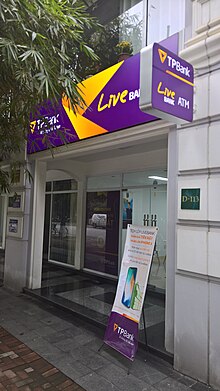
The ATMs of the following banks have no withdrawal fee :
- TP Bank . ( updated Nov 2023 )
- VP Bank . ( updated Dec 2023 )
- ACB . European Visa (unclear whether "Union" or continent) and JCB cards only . ( updated Nov 2023 )
- HDBank . Visa cards only . ( updated Dec 2023 )
- EXIMBANK . ( updated Dec 2023 )
The ATMs of the following banks have the listed fee per withdrawal :
- Agribank . 22,000 dong . ( updated Mar 2020 )
- ABBank . 20,000 dong . ( updated Jan 2018 )
- ANZ Bank . 40,000 dong . ( updated Jan 2018 )
- BIDV Bank . 50,000 dong plus 5,000 dong VAT . ( updated Mar 2016 )
- DongA Bank . 20,000 dong . ( updated Jan 2018 )
- HSBC , [email protected] . 100,000 dong . ( updated Apr 2016 )
- Techcombank . 66,000 dong . ( updated Jan 2018 )
- VIB . 50,000 dong (and they don't warn about it!) .
- Vietcombank . 1.5% fee . ( updated Feb 2020 )
- Vietinbank . 55,000 dong . ( updated Jun 2016 )
- Sacombank . 1.5% fee . ( updated Feb 2020 )
Credit cards [ edit ]
Credit cards are now accepted more and more around the country, especially where there is a lot of tourists present. Credit card purchases are required by law to be charged in dong.
A train ticket is easily payable with a credit card through the official government website for example.
Cashless payment [ edit ]
Vietnamese seem to love cashless payment, and even the tiniest shop will have a QR code to submit the payment. It is unclear however whether foreigners can use this payment method.
At least the cashless payment hype is not yet at a stage where you will have problems paying with cash, like in India for instance.
Money exchange [ edit ]
If you choose to carry cash, jewellery shops and gold shops offer the best rates for all major and hard currencies (EUR, USD, AUD, SGD, GBP, etc.) and least bureaucracy. Weirdly their rates are sometimes even better than the official Interbank rate at XE.com, but generally they are very close and the procedure is straightforward. There is no form filling or passport required. Most don't advertise their service, just ask. This is vaguely illegal, but enforcement is minimal. The best place in many cities in Vietnam to find gold shops that will transact currency exchange is to head for the central food/clothing market. Try to bring the largest denomination banknotes possible (e.g. $100 for U.S. dollars, £50 for pound sterling) in as pristine a condition as possible, as you will usually get a better rate that way.
Unofficial exchange agents like hotels and travel agencies often have a considerable markup over the official Interbank exchange rate, and sometimes they have different rates for different services. Also, US$50 and US$100 notes get a higher exchange rate than notes of lower denominations. Official exchange counters however, e.g. at the airport or in the city centre, have quite competitive buy and sell rates with markups as low as 1–2%, depending on the currency.
When leaving Vietnam , on most land borders connecting to Cambodia, China and Laos there are freelance money changers to take care of your financial leftovers, but be assured they will get the better of you if you don't know the going rate. In Hanoi airport, there are no money changers after you clear immigration, so exchange your dong before you enter the departure hall unless you plan to shop.
It is difficult to find or exchange dong outside Vietnam, with some notable exceptions such as Singapore or Bangkok — if you are not heading to either of those places, you should get rid of any leftovers before leaving the country.
Banking [ edit ]
Traveller cheques of well-known companies are accepted, but usually a small fee is charged. Fees might also be the only thing that would keep you from getting cash advances on Visa- or MasterCard at most banks. Through both ways you can also get hold of U.S. dollars, though there will be even higher fees. There are mentions in some popular travel books about Vietcombank not charging any commission fees to cash American Express travellers cheques. However, this is no longer true.
There are branches of money transfer companies like Western Union, but this is always one of the more expensive ways to get money. However, it's better for larger amounts. A US$800 transfer costs US$5 from America and the exchange rate is quite good. You may also transfer US dollars to
Acceptance of other currency [ edit ]
Prices are sometimes advertised in U.S. dollars, but payment is almost always expected in dong only , especially outside major tourist destinations. It is easier to bargain with dong, especially since dollar prices are already rounded. If paying with dollars, bills in less than perfect condition may be rejected. US$2 bills (especially those printed in the 1970s) are considered lucky in Vietnam and are worth more than US$2. They make a good tip/gift, and many Vietnamese will keep them in their wallet for luck.
Tipping [ edit ]
Tipping is not expected in Vietnam with the exception of bellhops in high-end hotels, and the Vietnamese themselves don't do it, though tips will not be refused if offered. Some establishments which are used to serving Western tourists have come to expect tips, though it is still perfectly acceptable not to tip. In any case, the price quoted to you is often many times what locals will pay, so tipping can be considered unnecessary in most circumstances. To avoid paying an involuntary tip when a taxi driver claims he doesn't have small change always try to carry small denominations.
Shopping [ edit ]
Tax refund [ edit ].
Foreign visitors may claim a VAT refund provided they make the purchase at a participating shop, and leave the country through specific ports of exit.
Price discrimination [ edit ]
As you travel about, you will find there are clusters of shops all selling similar goods, such as 20 sewing machine shops together, then 30 hardware shops all together, 200 motorcycle repair shops in the same block. Prices are competitive.
However, overcharging has long been an issue in Vietnam tourism, and it is an issue both for foreigners and for Vietnamese people whose accents identify them as being from another region. It can happen anywhere on anything from a hotel room, a ride in a taxi, coffee, a meal, clothing, or basic grocery stuff. Your coffee suddenly becomes 100% more expensive and a restaurant may present you an English menu with inflated prices. A friendly local who spent 30 minutes talking with you may also feel like overcharging you on anything.
Vietnamese hold a diverse view on this issue, and the practice also varies somewhat from region to region, but in general it is more common in Vietnam than other neighboring countries to see it socially acceptable to overcharge foreigners. They may argue inflated prices are still cheap and they may blame the cheap cost of living which attracts a lot of backpackers with bare-bone budgets. According to this school of thought, if tourists complain about it, it's because they are stingy. Rich tourists should not have a problem being overcharged.
In general, in the south, while vendors have no qualms overcharging an ignorant foreigner, they will generally allow you to bargain prices down to the local price if you know what it is and insist on it. On the other hand, vendors in the north tend to hold more strongly onto the belief that foreigners should be overcharged, and they will usually refuse to sell items to you unless you agree to pay the grossly inflated foreigner price.
The good news is that standard prices are much more common than in the early 1990s. You will absolutely spoil your trip if you assume that everyone is cheating you. Just try to be smart. In a restaurant, learn some names of common dishes in Vietnamese, insist that you need to read the Vietnamese menu, and compare it. If owners argue that the portion of dishes in the English menu is different, it's definitely a scam so move to another place. Learn some Vietnamese numbers and try to see how much a local pays a vendor. The old bargaining tactic of proposing a price, if you are sure that it is a fair and appropriate price that a local would get, and walking away often does the trick, if you are willing to actually walk away.
Supermarkets [ edit ]
Shopping in supermarkets is much less common in Vietnam than in Europe and North America, or even in China or Thailand. Most grocery shopping for local still happens in traditional street markets.
Nevertheless, there exist supermarkets and convenience stores in most places, and they are constantly becoming more. Foreign companies are pushing into the market, like the Thai supermarket chain Big C, which also sells clothing items and household goods. Other supermarket chains are OK!, WinMart, Circle K, Family Mart, and Bách Hóa XANH — the latter, mostly available in the south and probably the most inexpensive one, popular for its evening fruit, meat and fish specials —, besides many smaller and privately run convenience stores.
Traditional street and covered markets are still thriving though, especially for produces — much as they do in Thailand for example. Supermarkets are generally more expensive when it comes to produces, but can be cheaper for packaged products and beverages.
Costs [ edit ]
Vietnam is cheap by Western standards. A month's stay can be as cheap as €300–350 using basic rooms (100–140,000 dong), local food (100–150,000 dong) and public transportation (50,000 dong).
Eat [ edit ]
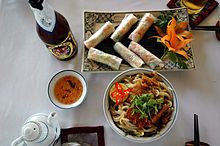
Food is at the very core of Vietnamese culture: every significant holiday on the Vietnamese cultural calendar, all the important milestones in a Vietnamese person's life, and indeed, most of the important day-to-day social events and interactions - food plays a central role in each. Special dishes are prepared and served with great care for every birth, marriage and death, and the anniversaries of ancestors' deaths. More business deals are struck over dinner tables than over boardroom tables, and when friends get together, they eat together. Preparing food and eating together remains the focus of family life.
Yelp and Tripadvisor are not widely used by locals in Vietnam, and reviews on those directories are usually posted by tourists. Foody is the go-to restaurant rating directory for the Vietnamese, and also functions as a food delivery and restaurant reservation app. While the interface is available in English, the downside is that almost all reviews are in Vietnamese.
Vietnamese cuisine varies from region to region, with many regions having their own specialties. Generally, northern Vietnamese cuisine is known for being subtle, central Vietnamese cuisine is known for being spicy, while southern Vietnamese cuisine is known for being sweet. There is also distinctive Vietnamese-Chinese cuisine to be found in Ho Chi Minh City's Chinatown.
At the same time, the Vietnamese are surprisingly modest about their cuisine. (An old proverb/joke says that "a fortunate man has a French house, a Japanese wife, and a Chinese chef.") High-end restaurants tend to serve "Asian-fusion" cuisine, with elements of Thai, Japanese, Chinese, and occasionally French mixed in. The most authentic Vietnamese food is found at street side "restaurants" (A collection of plastic outdoor furniture placed on the footpath), with most walk-in restaurants being mainly for tourists. Distinct regional styles exist: northern, central, and southern, each with unique dishes. Central style is perhaps the most celebrated, with dishes such as mi quang (wheat noodles with herbs, pork, and shrimp), banh canh cua (crab soup with thick rice noodles) and bun bo Hue (beef soup with herbs and noodles).
Many Vietnamese dishes are flavoured with fish sauce ( nước mắm ), which smells and tastes like anchovies (quite salty and fishy) straight from the bottle, but blends into food very well. (Try taking home a bottle of fish sauce, and using it instead of salt in almost any savoury dish: you may be pleasantly surprised with the results.) Fish sauce is also mixed with lime juice, sugar, water, and spices to form a tasty dip/condiment called nước chấm , served on the table with most meals. Vegetables, herbs and spices, notably Vietnamese coriander or cilantro ( rau mùi or rau ngò ), mint ( rau răm ) and basil ( rau húng ), accompany almost every dish and help make Vietnamese food much lighter and more aromatic than the cuisine of its neighboring countries, especially China.
Vietnam's national dish is phở (pronounced like the fu- in funny , but with tone), a broth soup with beef, pork, chicken or seafood and rice noodles (a form of rice linguine or fettuccine). In the south, phở is normally served with plates of fresh herbs (usually including Asian basil), cut limes, hot chilies and scalded bean sprouts which you can add according to your taste, along with chili paste, chili sauce, and sweet soybean sauce, while in the north, it is usually served only with fried quẩy fritters and chilli sauce on the side. Phở bò , the classic form of phở, is made with beef broth that is often simmered for many hours and may include one or more types of beef (skirt, flank, tripe, etc.). Phở gà is the same idea, but with chicken broth and chicken meat, so is Phở thit lon with pork, Phở tom with shrimp, Phở ca with fish, and Phở chay with tofu and vegetable stock. Phở is the original Vietnamese fast food, which locals grab for a quick meal. Most phở places specialize in phở and can serve you a bowl as fast as you could get a Big Mac. It's available at any time of the day, but locals eat most often Phở chay for breakfast. Famous phở restaurants can be found in Hanoi. The phở served at roadside stalls or informal restaurants tend to be cheaper and taste better than those served in fancier restaurants.
Street side eateries in Vietnam typically advertise phở and cơm . Though cơm literally means rice, the sign means the restaurant serves a plate of rice accompanied with fish or meat and vegetables. Cơm is used to indicate eating in general, even when rice is not served (i.e., An cơm chua? - Have you eaten yet) Though they may look sketchy, street side eateries are generally safe so long as you eat at places popular among the locals and avoid undercooked food. Many street food stalls do not display their prices; those outside tourist areas usually charge foreigners honestly, but ask for the price before you order to be sure.
In rural and regional areas it is usually safest to eat the locally grown types of food as these are usually bought each day from the market. It is not uncommon that after you have ordered your meal a young child of the family will be seen running out the back towards the nearest market to purchase the items.
Most restaurants/cafes in Vietnam will have a bewildering variety of food available. It is very common for menus to be up to 10-15 pages. These will include all types of Vietnamese food, plus some token Western food, possibly some Chinese-style ribs and maybe a pad Thai as well. It is generally best to stick with the specialty of the area as this food will be the freshest and also the best-prepared. As in other South East Asian countries, the menu is often more an indication of what a restaurant can cook and not all items may be available at any given time.
In restaurants it is common practice for the wait staff to place a plastic packet (stamped with the restaurant's name) containing a moist towelette on your table. They are not free. They cost 2,000–4,000 dong. If you open it, you will be charged for it. Also, peanuts or other nuts will be offered to you while you are browsing the menu. Those are not free, either. If you eat any, you will be charged.
Coffee , baguettes , and pastries were originally introduced by the French colonisers, but all three have been localised and remain popular. More on cà phê below, but coffee shops that also serve light fare can be found in almost every village and on many street corners in the bigger cities. Bánh mì are freshly baked baguettes, most commonly filled with grilled meats or liver or pork pâté plus fresh herbs and vegetables as bánh mì thịt , but there are countless variations filled with egg, beef, meatballs, pork skin etc. They are delicious and should be enjoyed at least once during a visit, and can easily be found from the bánh mì carts that are ubiquitous on the streets of Vietnam.
Vietnamese waters are in danger of collapse from over-fishing. Nevertheless, for the moment if you like seafood , you may find bliss in Vietnam. The ultimate seafood experience may be travelling to a seaside village or beach resort area in the south to try the local seafood restaurants that serve shrimp, crab, and locally-caught fish. Follow the locals to a good restaurant. The food will still be swimming when you order it, it will be well-prepared, very affordable by Western standards, and served in friendly surroundings often with spectacular views.
Most restaurants' hours are 10:00-22:00, although places serving breakfast-type items like noodles will open and close earlier. In 24-hour restaurants, there will be two prices. Prices are normal from 06:00 to 22:00, then doubled from 22:00 to 06:00. For example, rice usually costs 10,000 dong, but if you order after 22:00, the price will be 20,000 dong. This policy is government-mandated, to discourage people from eating late. Some dishes are not served after 22:00.
Cuisines other than Vietnamese, as well as fast foods, are increasingly available in the larger cities in the South and Central regions, less so in the North. Chinese, Japanese, Korean, Thai, Lao and other Asian restaurants are commonplace and Italian, French, German, Mexican, Russian, Ukrainian and Armenian restaurants can be found in most large cities in the South and Centre, as well as British, Irish an Australian food in bars and pubs. There is usually at least one Indian restaurant in most large towns and cities all over the country, many offering excellent quality food. Increasingly more affluent Vietnamese are sampling the different cuisines now available in their country so the chances of eating in a tourist ghetto are diminishing.
Dietary restrictions [ edit ]
Vegetarian food is quite easy to find anywhere in Vietnam due in large part to the Mahayana Buddhist influence, and all Vietnamese Buddhist monks are required to be vegetarian. Vegetarian eateries range from upscale restaurants to cheap and basic street stalls. Any Vietnamese dish with meat can be made vegetarian with the addition of fake meats. Besides the Buddhist influence of two vegetarian days a month, Cao Dai people eat vegetarian for 16 days. Look for any signs with the word chay as a suffix, like cơm chay for vegetarian rice dishes, phở chay for vegetarian pho, or bánh mì chay for vegetarian sandwiches. The words quán chay and nhà hàng chay literally translate as "vegetarian restaurant". It is also helpful to remember the phrase " ăn chay ", essentially meaning "I am a vegetarian". Even if you are not a vegetarian, a visit to a Vietnamese vegetarian restaurant will add a few new flavours that you won't find elsewhere. Also vegetarian food tends to be cheap which can help eke out the most hardened meat eaters budget. Be careful at regular stalls and restaurants though, as even dishes that seem vegetarian on the surface can sometimes make use of non-vegetarian seasonings such as fish sauce. As Vietnamese food traditionally does not use dairy products, vegetarian food in Vietnam is usually safe for vegans , but be careful to make sure it does not contain eggs.
Halal food is rare in Vietnam due to the small size of the Muslim community. Halal restaurants are mostly concentrated in Ho Chi Minh City and Hanoi , many of which are operated by immigrants from South Asia, Indonesia or Malaysia. The Mekong Delta and Ho Chi Minh City are also home to Muslim Cham communities, some of whom operate food stalls serving halal versions of Vietnamese street dishes for their respective communities. Kosher food is nearly unknown; if you keep kosher, contact Chabad Vietnam well in advance of your trip for assistance.
Drink [ edit ]
Drinking in a Vietnamese bar is a great experience. One of the interesting things is that during the day, it is almost impossible to see a bar anywhere. Once the sun goes down though, dozens appear on the streets out of nowhere.
Watch out for ice in drinks. Factory-made ice is generally safe, but anything else can be suspect. Factory ice has a hollow, cylindrical shape. Avoid irregular chunks of ice as it may be unclean.
Beer [ edit ]
The main brews are light lagers with a strength of 4.5–4.9%. In supermarkets a 0.33L can of beer starts at 10,000 dong. Some cheap beers in plastic bottles (0.9L) can be had for 15–18,000 dong. "Saigon" in a 0.45L glass bottle starts at 11,000 dong, but sometimes a deposit of 3,000 dong is added. A beer in a bar starts at around 20,000 dong.
The most popular beer (draught, bottle or can) among the southern Vietnamese is Saigon Do (Red Saigon) . For the northern Vietnamese Bia Hanoi (Hanoi beer) is the most popular brand, whereas central Vietnamese prefer Bière Larue from Da Nang or Bia Huda from Hue. 333 , pronounced "ba-ba-ba" is a local brand, but it's somewhat bland; for a bit more flavour, look for Bia Saigon in the green bottle and a bigger bottle than Bia Saigon Special. Bia Saigon is also available as little stronger export version. Locally brewed foreign brands like Tiger and Heineken are also common.
The craft beer revolution has well and truly reached Vietnam and bottled IPAs, brown beers and stouts are available in the major cities. Ho Chi Minh boasts an increasing number of brew-pubs and microbreweries. These brews are available at a fraction of the price they cost in Thailand or Singapore.
Beer in Vietnam is usually served in glasses filled with (and is thus drunk with) ice. This means that the cans or bottles of beer need not be chilled. If you are drinking with Vietnamese people, it is considered polite to top up their beer/ice before re-filling your own drink. It is also considered necessary to drink when a toast is proposed: "mot, hai, ba, do" ("one, two, three, cheers"). Saying "Trăm Phần Trăm" (100% 100) implies you will empty your glass.
Coffee [ edit ]
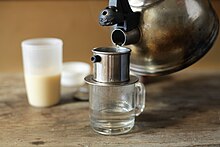
Coffee is usually served black ( Cà Phê Đen (Đá) ) or with sweetened condensed milk ( Cà Phê Sữa (Đá) ) — usually over ice ( Đá ). Ask for (Cà Phê) Nóng if you want your coffee hot without ice. Some people may add extra water with the hot version (see picture) to make the coffee less strong — the ice version gets less strong automatically. Also, locals tend to drink their Cà Phê Đen incredibly strong with up to 4 teaspoons of sugar. If you want black coffee without sugar, say so.
However, the slow dripping coffee through the metal filter seems distinct for tourist frequented places. Normal Vietnamese don't take or have the time to prepare nor wait that long. Hence, in less touristy places you will have a hard time finding the slow-filter version, they often won't have these filters and just serve already prepared coffee, often with the condensed milk already in the glass. If you want the milk separately, say so.
Take-away coffee ( Cà Phê Mang Đi ) with ice in a plastic cup and straw along the street can already be had for 10–12,000 dong.
In Hanoi , Cà Phê Trứng (egg coffee) is a local speciality.

A late addition to the coffee culture of Vietnam and often served for take-away are Cà Phê Muối (salted coffee) and Cà Phê Cốt Dừa (coconut coffee), basically a Cà Phê Sữa Đá topped with a cool mountain of salty whipped cream or sweet fluffy coconut slush, respectively. These are especially popular with the younger generation, but also tourists enjoy them.
Soft drinks [ edit ]

- Coconut water directly from the coconut is popular all around the country. After drinking the water, let the seller open the coconut, ask for a spoon, and enjoy the sometimes jelly-ish inner coconut meat. (If the coconut is too mature, the meat will be very hard and you are out of luck using the spoon, but the seller will know.)
- Nước Mía , or sugar cane juice , is served from distinctive metal carts with a crank-powered sugar cane stalk crushers that release the juice.
- Sinh Tố is another fabulous thirst quencher, a selection of sliced fresh fruit in a big glass, combined with crushed ice, sweetened condensed milk and coconut milk. You can also have it blended in a mixer. You could place any fruit-type after the word sinh tố , e.g., sinh tố bơ (avocado smoothie) or sinh tố dứa (pineapple smoothie). If you prefer to have orange juice, you won't use the word sinh tố but nước (literally: water) or nước cam if you would like to have an orange juice. Juices are usually without condensed milk or coconut milk.
- Chè Thái (Thai tea), Trà Trái Cây (fruit tea), or Trà Sữa (milk tea) are tea-based ( chè , trà ) dessert mix drinks made with various jellies, assorted tropical fruits, crushed ice, and (condensed) milk — kind of an advanced bubble tea, refreshing and colorful with a variety of textures, but it can be quite sweet if you don't watch it. Various word combinations exist to denominate this kind of drink.
Wine and liquor [ edit ]
Vietnamese "rượu đế" or rice alcohol ( rượu means liquor or wine [not beer]) is served in tiny porcelain cups often with candied fruit or pickles. It's commonly served to male guests and visitors. Vietnamese women don't drink much alcohol, well at least in public. It's not recommended for tourists.
Dating back to French colonial times, Vietnam adopted a tradition of viticulture. Dalat is its centre, and you can get red and white wine . There is a better range and better quality red wines than whites as reds seem to appeal more to the Asian palate. Most restaurant wine is Australian and you will be charged Australian prices as well, making wine comparatively expensive compared to drinking beer or spirits. Vietnamese wine has hit the mass market and is available by the glass or bottle in many restaurants. The quality ranges from the just-about-drinkable Vang Dalat Classic to the more than palatable Vang Dalat Premium. In supermarkets a bottle of Classic can be bought for around 80,000 dong whilst Premium is around 120,000. In restaurants a bottle of Classic costs 120,000–150,000 dong. Premium is less widely available in restaurants and where it is costs around 200,000 dong a bottle.
Imported wines, mainly Australian, French and Chilean are also available in supermarkets and in mid range and high end restaurants at far more expensive prices.
Rice spirits and local vodka is cheap in Vietnam by Western standards. Local vodkas cost about US$2-4 for a 0.75L bottle. Russian champagne is also common. When at Nha Trang, look for the all-you-can-drink boat trips for around US$10-15 for an all-day trip and party with on-board band.
Sleep [ edit ]

Lodging is not an issue in Vietnam, even if you are travelling on a tight budget. Accommodation in Vietnam ranges from 100,000-dong dorm accommodation in hostels to world-class resorts, both in large cities and in popular coastal and rural destinations. Even backpacking hostels and budget hotels are far cleaner and nicer than in neighboring countries (Cambodia, Thailand, Laos). And even cheap hotels that charge as little as 250,000 dong for a double room are often very clean and equipped with towels, clean white sheets, soap, disposable toothbrushes and so on.
Service in many of the very inexpensive hotels is quite good (since the rate that a person pays per night could equal a typical Vietnamese national's weekly pay), although daily cleaning and modern amenities like television may not be provided. In hotels costing a few dollars more (300,000+ dong, more in Hanoi) you can expect an en-suite bath, telephone, AC and television. As with hotels elsewhere in the world, mini-refrigerators in Vietnamese hotels are often stocked with drinks and snacks, but these can be horribly overpriced. You are much better off buying such items on the street. Adequate plumbing can be a problem in some hotels, but the standard is constantly improving.
It is a legal requirement that all hotels register the details of foreign guests with the local police. For this reason they will always ask for your passport when you check in. The process usually only takes a few minutes, after which they will return your passport. However, because non-payment by guests is by no means unknown, some hotels retain passports until check-out. If a place looks dodgy, then ask that they register you while you wait and take your passport with you afterwards. Few people have had a problem with this as it is routine across the country. You might find it helpful to carry some photocopies of your passport (personal data page and visa) which you can hand over to the hotel.
Hotels can be noisy, particularly when local families are staying. Vietnamese is one of the world's more vocal languages, and local tourists are happy to give full vent to it from 06:00 onward with scant regard for fellow guests. There are also a number of other sounds to be aware of when staying in Vietnamese hotels. Vietnam is a country under construction and the chance of the hotel being next to or very close to a building site is high. Also rooms in many small boutique hotels, guesthouses and home-stays are built fronting a central atrium or stairwell and the activities of the reception, common area and kitchen contribute more noises. Finally, there are the room-maids who start work soon after dawn and seem to think that you should be awake by then and consequently feel free to chat with each other at a loud volume and send and receive messages on mobile phones and walkie-talkies. If you are a light sleeper, bring a supply of earplugs.
Learn [ edit ]
If you want to meet local people, stop by a school. In Ho Chi Minh City, visit the American Language School, where you'll be welcomed enthusiastically and invited to go into a class and say hi. You'll feel like a rock star. The Vietnamese love to meet new people, and teachers welcome the opportunity for their students to meet foreigners.
An excellent novel set in modern-day Vietnam is Dragon House by John Shors. It's the story of two Americans who travel to Vietnam to open a centre to house and educate Vietnamese street children.
Former BBC reporter in Hanoi, Bill Hayton, has written a good introduction to most aspects of life in Vietnam, the economy, politics, social life, etc. It's called Vietnam, Rising Dragon , published in 2010.
Vietnam also has numerous universities for people who wish to pursue higher education. The most prestigious among them is Vietnam National University, Hanoi , originally founded by the French as Université Indochinoise in 1906. Other notable universities include Vietnam National University, Ho Chi Minh City and Hanoi University of Science and Technology
Work [ edit ]
You can volunteer as an English teacher through many volunteer organisations. However, if you have a TEFL/TESOL qualification and a degree then it's very easy to find paid teaching work. Without qualifications it's also possible to find work, but it takes more patience to find a job, and often there are concessions to make with payment, school location and working hours (weekends). Most teaching jobs will pay US$15-20 an hour. There are also many you-pay-to-volunteer organisations which allow you to help local communities, such as Love Volunteers , I to I and Global Volunteers . (But you must avoid some organized fraud. Ex: V4D, VTYD, RAKI, VVN...) Vietnam also has a booming tech startup scene, so opportunities may be available for people with expertise in computer science or other closely-related fields.
Legally, a work permit is required to work in Vietnam, although many foreigners do not bother, especially if the intention is to work for only a short period of time. Visa extensions are generally easy to obtain (your school will have to do this for you) although the immigration department will eventually insist on you obtaining a work permit before any more visas are issued. If your aim is to remain for a longer term, then it is possible to obtain a work permit although your school will need to do this for you. To apply, your employer will be required to submit the following: A contract and application letter from your school; a full, medical health check (done locally); a criminal record check (the criteria for this varies from province to province, some requiring a check from your home country, others, a check done solely in Vietnam); a copy of your TESOL/CELTA/TEFL and degree certificates; your 'registration of stay' form; a copy of your passport/visa. Sometimes, you may be asked to pay a small fee although the better schools will generally offer to do this for you. Work permits are valid for 3 years and are renewable for a period of up to 12 years.
Once you have a work permit, it is then a relatively simple process to apply for a temporary residence permit, which will alleviate your visa worries. The validity and procedure for renewal is the same as a work permit.
Vietnam has made a huge leap forward in terms of economic development and tourism, and many of the most feared annoyances are minor concerns. Vietnam is still a poor country, though. Tourists are considered money mules, and milking them is no crime. Nevertheless, outside of tourist hotspots, crime and scams against foreigners are rare.
Unexploded ordnance [ edit ]
As a legacy of the Indochina Wars , much of Vietnam's countryside is still littered with unexploded bombs and landmines, and many locals are still killed or maimed by them. Be very careful about going off the beaten path in rural areas, and ideally do not do so unless you have a guide who knows the area well.
Crime [ edit ]
Vietnam is a relatively safe place for tourists, and especially when travelling in groups. It will also depend on your nationality whether you may encounter issues — large western men are much more intimidating than smaller Japanese women, see cyclo scam.
Tourist areas are hotspots of petty crime. Violent crime towards foreigners is uncommon, but pickpockets and motorbike snatching are not uncommon in larger cities. Thieves on motorbikes snatch bags, mobile phones, cameras, and jewellery from pedestrians and other motorbike drivers. Don't wear your bag on your shoulder when riding a motorbike. Don't place it in the motorbike basket. When walking along a road, keep your bag on your inboard shoulder. If your bag is snatched, don't resist to the point of being dragged onto the roadway.
Reports of thefts from hotel rooms, including upmarket hotels, have been heard occasionally. Do not assume that your hotel room strongbox is inviolable.
Avoid fights and arguments with locals. Westerners may be bigger than Vietnamese, but if you're dealing with 5 or more Vietnamese guys then you're in serious trouble. Yelling is highly insulting to Vietnamese and may prompt a violent response. Vietnamese in general are placid and kind. As a visitor, you should respect local laws and customs. Altercations can be avoided easily by showing courtesy and tolerating cultural differences. Be on your best behaviour when drinking with Vietnamese men.
Corruption [ edit ]

The international monitoring group Transparency International has rated Vietnam as one of the most corrupt nations in Asia. Locals are convinced that the police are not to be trusted.
Motorcycle drivers may be stopped for a variety of reasons such as random checks of paperwork and licences and will fine foreigners around US$20 for each offence (the average traffic fine for locals is around US$5-10). Be polite but resolute, and stand your ground. Traffic officers are required to write traffic violations in their notebook and must give you a receipt for your fine which must then be paid at the station (not to the officer). For some offences (especially missing paperwork relevant to the vehicle you are riding), officers have the right to confiscate and impound your bike. If you have a phone, you could threaten to call your embassy and he may back down, although in most cases, it is often best to prevent any further escalation of the situation by paying the fine.
You generally won't encounter any problems with the police in more remote or rural areas because officers are likely to have a very poor command of the English language. The larger cities and areas that are frequented by tourists have more police who are proficient in communicating with tourists.
Immigration officers at land borders are known to demand bribes to stamp you in or out of the country. Refusing to pay the bribe will usually mean you are denied entry or not allowed to leave. The reputable bus companies will often charge a "border crossing fee" for their international routes, and staff would usually process you through immigration while you wait on the bus, and any bribes are included as part of that fee.
Most government offices will also require a small "gratuity" before processing paperwork. This is most commonly encountered when trying to obtain permits of residence for private accommodation, or work or residence permits.
Prostitution [ edit ]
Despite its seeming abundance, prostitution is illegal in Vietnam. The age of consent is 18. Vietnamese penal law levies penalties of up to 20 years in prison for sexually exploiting women or children, and several other countries have laws that allow them to prosecute their own citizens who travel abroad to engage in sex with children.
Under Vietnamese law, it is illegal for a foreigner to take a Vietnamese national to a hotel room. While this law is rarely enforced, you could find yourself in even deeper water if you report a crime disclosing that you shared a room with a Vietnamese national.
HIV/AIDS is prevalent in Vietnam, and many people go untreated due to the taboo nature of the disease. There is also a danger of theft when taking any unfamiliar woman back to a hotel or guest house. The tale of a man waking up to find his wallet, mobile phone or laptop missing is all too common. Stories also abound of Westerners being drugged while in a hotel room or being led to a dark, quiet place where they are relieved of their possessions by criminal gangs.
Scams [ edit ]
Most scams in Vietnam involve transportation, hotel prices, or the two-menu system practised by some restaurants.
Taxis [ edit ]
If you don't know what a reasonable fare is, it is generally a bad idea to agree on a price in advance. Rule of thumb to detect scammers: if the taxi doesn't have the fare charges written, or drivers name and photo on the dashboard, immediately ask the taxi to stop and get out. It is a definite scam.
As always, it is advisable to walk a hundred meters away from any tourist deposit point (bus arrival, train station etc.), as many taxi waiting here are either scammers or pay a commission to the cartel.
Many taxi drivers in Saigon and Hanoi try to overcharge newly arrived gullible travellers. When leaving the airport, the taxi driver may insist that you pay the airport toll. He might not be very forthcoming with the price, and if you give him cash, he will pay the toll and pocket the rest. The toll is 10,000 dong (July 2018) and having the correct money will avoid you getting fleeced. The toll is quoted along with the fare written on the dashboard of the taxi. You can confidently say "airport toll only 10,000 dong" and refuse to pay anything else such as parking (unless there were more toll roads in between).
Ask your hotel or hostel to arrange taxi services for you. This will ensure that you get a flat quoted rate as well as a trusted driver. Many hotels will be happy to arrange pick up and drop off from airports if you ask. Nevertheless, this can be more expensive than if you arrange it directly yourself, because the hotel will always try to cut into the deal, earning a little extra.
In several other cities of Vietnam, such as Dalat, Hoi An, Nha Trang, etc., do not travel by meter from the airport. The airports are as far as 30–40 km from these places and meter will cost you from 500,000–650,000 dong. However, you can either take a bus from the airport to city centre, or pre-negotiate a rate with the taxi for 200,000–300,000 dong. Pay attention to sides of taxis. Usually a rate for the airport is written on the door. Around town in these cities, metered taxis generally work fine.
If you ever get caught in a big taxi scam (such as rigged meter), you should get out of the vehicle and retrieve your belongings as if everything was all right, then refuse to pay the demanded price and threaten to call the police. Usually they will accept a more reasonable fare, but be prepared to face the driver's anger, so it is better to do this with a few witnesses around.
Taxi and cyclo drivers [ edit ]
Taxi and cyclo drivers may claim that they don't have change when accepting payment for an agreed-upon fare. The best way to handle this is to either carry smaller bills or be ready to stand your ground. Generally, the driver is only trying to get an extra dollar or so by rounding the fare up, but to prevent this scam from becoming more popular it is advised to stay calm and firm about the price.
When you meet an over friendly cyclo driver who says, "never mind how much you would pay" or "you can pay whatever you like at the end of the trip". He may try to show you his book of comments from international tourists. This kind of driver has to be a scammer. If you still want to use his service you should make it clear about the agreed price and don't pay more than that. Just be clear what you are willing to pay. The cyclo drivers are just trying to make a living.
Hotels [ edit ]
Hotel owners may tell you that the room price is 200,000 dong. However, when checking out, they may insist that the price is US$20, charging you almost double. Another trick is to tell customers that a room is a few dollars, but following day they will say that price was for a fan room only and it's another price for an air-con room. These days, legitimate hotel owners seem to be aware of these scams and are usually willing to help by writing down how much the room is per person per day (in U.S. dollars or dong), if it has air-con or not. Staff of legitimate hotels also never ask for payment from a guest when they check in. Watch out if they insist that you should pay when you check out but refuse to write down the price on paper. Otherwise, just book online with one of the common reservations websites, which will guarantee you the right price, and leave a review if something goes wrong.
As of 2019 most of the dollar versus dong scams have ended as almost all hotels now quote in dong and accept dong. Keep your dollar stash hidden and deal only in dong. Also as of 2019 quite a few low- to mid-range hotels do require payment upfront and as long as you get an official receipt there is nothing to worry about in this.
Restaurants [ edit ]
Some restaurants are known to have two menus, one for local people and another one for foreigners. The only way to deal with it is to learn a few Vietnamese phrases and insist that you should be shown only the Vietnamese menu. If they hesitate to show you the local menu, walk away. This scam is very unusual.
Hostels [ edit ]
Some hostels in Vietnam will want you to leave your passport at the reception, insisting even. This is not a legitimate business practice. Never leave your passport as collateral for anything.
Copycats [ edit ]
Besides accommodation and transport, another big scam in Vietnam involves copycat tour companies and restaurants. Anytime a company gets famous, copycats will pop out. A very famous example is the dozens of Sinh Cafes (bus company), which popped up. The real company has since changed its name to TheSinhTourist.
Fake monks [ edit ]
Buddhism in Vietnam generally follows the Mahayana school, meaning that the monks are required to be vegetarian and generally do not go on alms rounds. Instead, the monks either grow their own food or buy their food using temple donations. Monks do not sell religious items (shops selling religious items are staffed by laypersons, not by monks) or ask people for donations. Instead, donations are to be placed in temple donation boxes. It is entirely up to an individual to decide whether or not they wish to donate, and how much they wish to donate, and genuine temples will never use high-pressure tactics to solicit donations. "Monks" who approach tourists for donations are imposters.
Traffic [ edit ]

The first discovery for many tourists who just arrive in Vietnam is that they need to learn how to cross a road all over again. You may see a tourist standing on the road for five minutes without knowing how to cross it. Traffic in Vietnam can be a nightmare. Back home, you may never witness the moment of crash, seeing injured victims lying on the road, or hearing a BANG sound. Staying in Vietnam for more than a month, you will have fair chance of experiencing all these.
Roads are packed. Some intersections in main cities such as Hanoi, Ho Chi Minh City have traffic lights patrolled by police; most are either non-functional or ignored.
Crossing roads is an art in most of Vietnam, and there are no stop signals that will actually be followed by drivers. The art of crossing the road is fortunately very simple, though scary:
- There are some traffic lights and pedestrian crossings but they are by no means everywhere.
- If it is night time, and you are wearing dark clothes you should cross in a bright area or shine a torch towards the traffic
- If there is a bus, car or taxi, wait until it and its motorcycle entourage passes, as vehicles will not stop for pedestrians
- Ensure you, your fellow travellers and every piece of your luggage form an almost perfect line parallel with the traffic
- There is no 'ideal' time to start although you could pick a time with a little less traffic
- Step a little forward, a little more, and you will see motorcycle drivers to slow down a bit, or go to another way. Make your pace and path predictable to other drivers, don't change your speed or direction suddenly, and move forward until you arrive at your destination. Be aware that motorcycle drivers will swerve to avoid you but might swerve into your path.
- The simplest and best way to cross streets is to make yourself known and be steady. This means spread your arms out and walk at a steady pace. The locals will route around you. They are extremely good drivers and will avoid hitting you; just be sure to walk at a steady pace.
- Cars, buses and trucks can do you far more damage than motorcycles where the odds are much or even. Wait for anything with four or more wheels to pass and then take on the motorcycles.
The simplest way, if available, is to follow a local, stand next to them on the opposite side of the traffic (if you get hit, he will get it first) and he will give you the best chance of crossing a road.
If you are injured, don't expect the local people to help, even by calling an ambulance, because it is not free. Make sure you tell the local clearly that you will pay the ambulance fee. Hospitals will also not admit you until you prove that you can pay the bill.
Highways are risky, with an average of 30 deaths a day, and some locals will not even venture on them if not in a big vehicle (car or bus). Taking a bicycle or motorbike on highways is an adventure for risk takers, but definitely not for a family with children. Having said that, Vietnamese roads are no more dangerous than elsewhere in South East Asia.
Nightlife [ edit ]
- Petty crime in nightclubs is not unknown. Don't escalate an incident: avoid quarrelling with local people as drunks can be violent.
- Clubs are full of working girls trawling for clients. They may also be looking for wallets and mobile phones.
- Walking very late alone on the streets in the tourist areas is safe, but avoid unfamiliar women engaging you in conversation. They may try to touch you, sweet talk you, and then pick your pocket.
- Don't ask taxi drivers to recommend nightspots. Most taxi drivers earn commissions from bars and lounges to bring in foreign tourists. When you walk into one of these places, they will quote reasonable prices, but when you receive the tab, it may include extravagant charges. Do your homework beforehand, tell the taxi driver where you want to go, and insist on going to where you want to go despite their remonstrations. Most nightspots are reputable. Going to those with a mostly foreign clientele is a good practice.
Wildlife [ edit ]
Little wildlife remains, let alone anything dangerous to humans. Venomous snakes, such as cobras, may still be common in rural areas, but virtually everything else has either become extinct or exists in such small numbers that the chances of even seeing one are remote. Tigers may exist in very small numbers in remote areas, but this is unconfirmed.
LGBT travellers [ edit ]
Vietnam is generally a safe destination for LGBT travellers, and there are no laws against homosexuality in Vietnam. Transgender persons are allowed to change their legal gender after undergoing sex reassignment surgery. That being said, same-sex relationships are not recognised by the government, and the Vietnamese can be rather conservative, meaning that LGBT individuals can often be subject to some degree of prejudice. Fortunately, anti-LGBT violence is extremely rare.
Insulting national heroes such as Ho Chi Minh and Vo Nguyen Giap is illegal in Vietnam, and many foreigners have been jailed for doing so.
Stay healthy [ edit ]
Tropical diseases such as malaria , dengue fever and Japanese encephalitis are endemic in rural Vietnam. Malaria isn't as much a concern in the bigger cities such as Ho Chi Minh City and Hanoi, but always remember to take liquid mosquito repellent with you. It may be very useful, especially in the countryside and crowded neighborhoods.
Street food , including blended ice drinks, and food in restaurants is mostly safe to be consumed due to much improved hygiene. Vietnamese are very clean people, there are bins everywhere and interiors/floors are mostly tiled. Use common sense and follow the tips under the Traveller's diarrhea article and you will be fine.
Tap water is not safe to drink.
Contact lens solution is seldomly sold by pharmacies. You will have to find to specialised lens store or an optometrist to get it.
Healthcare [ edit ]
Vietnamese hospitals are generally not up to Western standards. Hospitals are often short of medicines and other supplies, and waiting times can be long, even in acute cases. Outside Hanoi, Ho Chi Minh City and Da Nang, few doctors speak English. Private clinics in Vietnam, run by foreigners, are therefore recommended as the first port of call. These clinics have both Vietnamese and foreign doctors. In general, hospitals will only accept your case if you can demonstrate the ability to pay for their services.
There are private hospitals in Hanoi, Ho Chi Minh City and Da Nang that cater mainly to Western expatriates and provide excellent healthcare, with staff members who are able to speak English and French, though you would be paying a steep premium for their services. Vinmec International Hospital is a chain of expatriate-oriented private hospitals with locations in several of Vietnam's larger cities.
Private hospitals in Hanoi recommended for travellers to Hanoi include Hanoi French Hospital, International SOS Clinic Central Building, Hanoi Family Medical Practice.
In Ho Chi Minh City, hospitals recommended for travellers include Franco-Vietnamese Hospital, City International Hospital, Columbia Asia Gia Dinh International Clinic, Columbia Asia Saigon International Clinic, HCMC Family Medical Practice Diamond Plaza, International SOS Clinic Hannam Building, Hoan My Medical Corporation chain.
If you fall seriously ill while travelling, it is advisable to seek treatment in nearby Southeast Asian countries if possible. In serious cases, doctors may even order the patient to be flown to Singapore or Thailand for treatment. When travelling to Vietnam, it is very important to take out comprehensive travel insurance. Please read the terms and conditions of your travel insurance carefully.
In tourist destinations, you can ask for medical services at hotel reception desks or from your tour operator. In many cases, you may have to pay cash in advance to see a doctor. In larger cities, payment can usually be made by debit card. Keep receipts for insurance purposes.
The emergency number for ambulances in Vietnam is 115, but the emergency number usually does not serve in English. Public ambulances can be slow to arrive, so it is usually best to take a taxi, for example. If you call an ambulance, be prepared for a long waiting time. Paramedics do not usually speak English and ambulances are poorly equipped. In large cities, hospitals also have private ambulances, which are usually more efficient than public ambulance services.
In large cities such as Hanoi and Ho Chi Minh City, there are a number of good quality pharmacies. Most private hospitals and clinics also have a pharmacy. Pharmacies are usually well-stocked and most medicines can be bought without a prescription.
Pharmacies in Vietnam are not strictly regulated. If you buy medicines from a pharmacy other than a hospital pharmacy, it is a good idea to check the expiry date of the medicine packs you buy. The packaging, the contents of the packs and any instructions for use should be checked carefully.
Respect [ edit ]
In traditional Vietnamese culture, elders are treated with great deference and respect. While expectations are more relaxed when foreigners are involved, it's a good idea to show politeness, respect and restraint towards those who look older than you.
It's common to be stared at by locals in some regions, especially in the rural areas outside of big cities, and in the central and northern parts of the country. Southerners are usually more used to foreigners. Wherever you are, though, expect some probing questions whenever a conversation starts: How old are you? Are you married? Do you have children? While these might seem nosy in the West, they're perfectly normal, good-natured questions here that help people determine how they should address you. The best thing to do is just play along. You probably don't know much about their culture; it's only fair that locals wouldn't know much about yours.
An Asian woman travelling with a non-Asian man often attracts a more undesirable kind of attention. Probably due to memories of the sexual escapades of GIs during the American War, people will often assume she is an escort or prostitute, and she may be insulted or harassed, even if she has no relationship to the man. These prejudices have lessened somewhat, but they are still present. As of April 2019 these prejudices have almost completely disappeared for 'respectable looking Asian women' and the nearest they will get to a problem is that almost all locals will assume they are Vietnamese and seek to circumvent the English speaking foreigner by speaking Vietnamese to Thai/Chinese/Singaporean/ Australian-never-been-to-Vietnam before-but-looks Asian, wives or girlfriends. The Vietnamese themselves generally do not engage in public displays of affection, even among married couples, as it is considered to be disrespectful, so it is advisable for couples to show restraint while in public.
Vietnamese people tend to be dressed modestly and conservatively, though somewhat less so at bars and nightclubs in Hanoi and Ho Chi Minh City, where young locals can sometimes be spotted in sexy outfits. But generally, you should try to cover your shoulders and knees, as doing so will earn you a lot more respect from the locals.
Saving face is very important in Vietnamese culture. You should generally avoid pointing out the mistakes of others no matter how minor they might be in order to avoid causing major embarrassment.
As in many other Asian countries, you are expected to remove your shoes before entering people's homes.
When handing out and receiving business cards, always be sure to do it with both hands , as using only one hand is considered to be very disrespectful.
Relations with China are a sensitive issue best not discussed with locals. Tensions boil over periodically over territorial disputes in the South China Sea, called the "East Sea" ( Biển Đông ) in Vietnam — using the former name may offend locals by suggesting that you support China's claims. Possession of maps showing the nine-dash line is likely to elicit negative reactions from Vietnamese; this has also resulted in certain foreign movies and television series such as the 2019 animated film Abominable and the 2023 Barbie movie being banned in Vietnam.
However, China is Vietnam's largest trading partner and source of international tourists, and individual visitors from mainland China should not face any major issues so long as they avoid political discussions. This animosity towards China also generally does not extend to ethnic Chinese from other countries.
The American War [ edit ]
The most surprising thing about the topic of the Vietnam War (the American or Reunification War, as it is called in Vietnam) is that most Vietnamese do not bear any animosity against visitors from the countries that participated, and in the South many Vietnamese (especially older Vietnamese involved in the conflict or with relatives in the war) appreciate or at least respect the previous American-led or French-led military efforts against the North. Two-thirds of the population were born after the war and are quite positive towards the West. Some attractions present an anti-American viewpoint on the war, whilst many are surprisingly restrained.
Be sensitive if you must discuss past conflicts. Well over 3 million Vietnamese died, and it is best to avoid any conversations that could be taken as an insult to the sacrifices made by both sides during the wars. Do not assume that all Vietnamese think alike as some Vietnamese in the South are still bitter about having lost against the North.
Souvenir shops in Vietnam sell lots of T-shirts with the red flag and portraits of "Uncle Ho." Many overseas Vietnamese, particularly in the United States, Canada and Australia, are highly critical of the government of Vietnam, so you may want to consider this before wearing communist paraphernalia in their communities back home. A less controversial purchase if you are American, Canadian or Australian would be a nón lá (straw hat) instead.
Religion [ edit ]
Although the official census claims most Vietnamese are non-religious, you wouldn't know it to see them. Whether they attend services or not, most Vietnamese are in fact strong believers, incorporating a variety of religious traditions, beliefs and rituals into their daily lives.
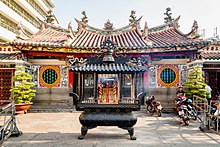
As in neighboring Southeast Asian countries, the most influential and widespread religion in Vietnam is Buddhism. Buddhism in Vietnam generally follows the Mahayana school, which is widespread in China, unlike the neighboring Southeast Asian countries which follow the Theravada school. This means that monks are required to be vegetarian, and pious individuals seeking a particular blessing will often forgo meat as well. Unlike in other Southeast Asian countries, it is not customary for monks to collect foodstuffs in the streets. Instead, they will either buy their food using temple donations, or grow their own food. Monks who hang out in tourist areas requesting donations are bogus. Similar to China and neighboring countries, Swastikas are commonly seen in Buddhist temples as a religious symbol; they are positive signs representing sacredness and blessing, and have no connection to Nazism or anti-Semitism.
Also, and more than in neighboring countries, Vietnam has a sizable proportion of Christians (11%; 9% Catholic, 2% Protestant). Christianity is especially prominent in major cities, where at least a few churches can be found. It is common for strangers and acquaintances to ask you to come to their church, although offence will not usually be taken if you decline.
Much like the Chinese and other Southeast Asians, Vietnamese people place a strong emphasis on spirits and ancestor worship. You'll see at least one shrine in every Vietnamese home and place of business, where occupants burn incense to honor or placate certain spirits. These are often decorated with statuettes or pictures of sacred figures: for devout Buddhists, this might be Buddha or Bodhisattva; for Roman Catholics, a crucifix or the Virgin Mary; for "non-religious" people, depictions of various traditional deities or spirits. If you see someone's photograph featured on a shrine, it's most often that of a family member who's passed away. Burning joss sticks (sticks of incense) for the spirits of departed family members is generally a token of respect.
Many temples require you to remove your shoes before you enter the temple buildings. As a general rule, you should always enter using the right gate and exit using the left gate (facing inward); the middle gate is traditionally reserved for the emperor and deities. Do not step on a raised doorway threshold when entering or exiting the temple; always step over it. Also be sure to dress conservatively when visiting temples; do not wear sleeveless shirts, and make sure your knees are covered.
Vietnamese are generally quite superstitious when it comes to death and the spirit world, and there are certain taboos you'll want to avoid. Some of these include:
- Placing chopsticks upright in the middle of a bowl of rice : Bowls of rice are arranged in this way next to the body of the deceased at funerals, so it reminds people of funerals. If you eat your rice with a spoon, place the spoon face down in the bowl, never face up.
- Taking photos of an odd-numbered group : The superstition goes that the person in the middle of a group will be singled out by evil spirits. Photos of even-numbered groups (2, 4, 6, or 8 people, and so on) are fine.
- Sitting with your back facing a family shrine : Considered disrespectful to the shrine, and to the spirits of the deceased.
- Climbing onto altars to pose for photographs with the statues : Considered very disrespectful to the deities being venerated.
Electricity [ edit ]
Electricity is delivered at 200 V, 50 Hz in Vietnam. Most Vietnamese sockets are compatible with the 2-pin American Type A, and the 2-pin European Type C, E and F plugs. Some sockets are also compatible with the 3-pin American Type B plugs.
Connect [ edit ]
Telephone [ edit ].
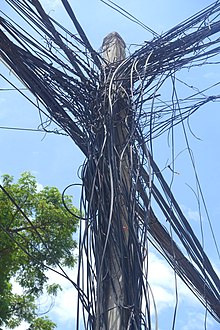
Land-line numbers in Hanoi and HCMC have a sequence of eight numbers, others have seven.
- Vietnam international code: +84
- Hanoi area code : (24)
- Ho Chi Minh area code : (28)
Telephone bills are 30% to 40% cheaper if dialed with 171 or 178 services.
- Domestic call : 171 (178) + 0 + Area code + Number.
- International call : 171 (178) + 00 + Country code + Area code + Number.
Since hotels and guesthouses often charge higher for telephone calls, try to find a post office or any reliable public service.
Mobile phones [ edit ]
Mobile numbers in Vietnam must always be dialed with all 9 or 10 digits (including a "0" prefixing the "1nn" or "9nn" within Vietnam), no matter where they are being called from. The 1nn or 9nn is a mobile prefix, not an "area code", as such and the second and sometimes third digits (the nn part) denotes the original mobile network assigned. As is the case with most mobile numbers, they can also be called within or outside Vietnam using the international format.
There are many mobile networks with different codes:
- Mobifone : 90, 93, 70, 76, 77, 78, 79
- Vietnamobile [dead link] : 92, 56, 58
- Viettel : 98, 97, 96, 32, 33, 34, 35, 36, 37, 38
- Vinaphone : 91, 94, 81, 82, 83, 84, 85
Prepaid account charges vary from 890–1,600 dong per minute. Recharge cards are available in denominations of 10,000, 20,000, 50,000, 100,000, 200,000 and 500,000 dong.
Useful numbers [ edit ]
- Fire Brigade 114
- Hospital 115
- General Information 1080
Internet [ edit ]
- SIM cards from all the main providers: Viettel, Vinaphone, Mobifone and Vietnam Mobile can be purchased on arrival in Ho Chi Minh or Hanoi. 100,000 dong buys 9 GB of data valid for 30 days, which is enough as long as you don't watch too many videos on your phone. If you intend to use your phone a lot, 30 GB data for 30 days costs around 330,000 dong. Providers offer phone packages as well, but for most tourists Facebook/Skype/Line calls are enough to keep in touch with friends and family, and your hotel can usually call taxis and bus companies, tourist informations, and any other place.
- Wi-Fi is now widespread in Vietnam and most hotels, restaurants and bars in the main tourist centres have free Wi-Fi. Ask for the password when you make your purchase. Sometimes the password is printed on the receipt or advertised near the counter. Otherwise, public plazas, most airports and many larger railway stations will also have Wi-Fi — wherever people or tourists frequent the place. Some Internet cafes are still available in tourist spots and rates are fairly cheap, ranging from 2,000-10,000 dong per hour. Connection speeds are high, especially in the big cities.
- Internet censorship is applied to a very small number of Internet services. Most foreign news sites like the BBC and CNN, as well as social media web-sites such as Facebook, Twitter and YouTube are usually freely accessible in Vietnam, though they may be temporarily blocked during politically sensitive periods. It may be wise to use a VPN service, which seem to work with most Wi-Fis in Vietnam.
- Has custom banner
- Has map markers
- Articles with dead external links
- Eat listing with no coordinates
- Has caution box
- Has caution box with out of date warning
- Usable countries
- Usable articles
- Country articles
- Has Geo parameter
- Southeast Asia
- All destination articles
- Pages with maps
Navigation menu

Copyright © 2022. Tourist Vietnam All rights reserved.

COMMENTS
Live fully in Vietnam. Vietnam opens its door widely to welcome visitors all around the world! Starting from 15th August 2023, Vietnam extends e-visa validity to 90 days and unilateral visa exemption will be valid in 45 days! We are more than happy to welcome you all here and admire our stunning landscapes, free your soul on white sandy beaches ...
Food & Drink. Air Travel. Getting around Vietnam is easy whatever your budget. Mar 14, 2024 • 10 min read. Whether it's bus, train, private car, motorcycle, bike, plane or boat, you can plan your trip around Vietnam with this guide to getting around. Activities. The 15 best things you can do in Vietnam in 2024.
May - November. Northern Vietnam - The best months to travel Northern Vietnam are April to May or September to October. There are mostly sunny days and the rain has stopped. The weather gets really cold from December to March and is not suited for hiking or sailing a junk boat in Halong Bay that time of year.
Vietnam is a country with a countless of destinations to explore, and this Vietnam travel guide highlights some of the most popular ones. North Vietnam 1. Hanoi. Hanoi, the capital city of Vietnam, is known for its rich history, vibrant culture, and bustling street life. Visitors come to explore its charming Old Quarter, taste delicious street ...
10. Ha Giang. Best for mountain views. Trekking to the minority villages in the hills around Sapa is one of Vietnam's top draws, but the country's trekking capital feels rather commercialized these days. Hikers have to walk further every year to find the rural idyll that first drew people to the northwest.
The carefully created travel itineraries in our Vietnam travel guide will inspire and help you make the most of your trip. Combining the classic tourist sights and busy cities with laidback beaches, quiet temples and remote mountain villages, where you'd be hard-pushed to find another visitor, there's an itinerary to match your interests ...
There's a lot to love about travelling in Vietnam, which stretches from the soaring mountains and fascinating ethnic groups of the north to the endless rice paddies and vibrant waterways of the Mekong Delta in the south, with more than 3000km of glorious coastline in between. Throw in a good transport infrastructure of buses, trains and flights ...
Dalat attracts tourists seeking a serene escape with its breathtaking landscapes, vast pine hills, and vibrant flowers. Check out these top 15 destinations in Dalat in 2023. This is a detailed guide to the 2-week itinerary in Vietnam. The article includes detailed information on maps, routes, destinations, and costs for 2 weeks in Vietnam.
Find out everything you need to know before you visit Vietnam, from visas and transport to weather and safety. Explore Vietnam from home with recipes, books, music, and stories.
How to Apply for Vietnam's e-Visa: Step 1: Prepare the required materials. Step 2: Open the official website for Vietnam's e-Visa Application. Step 3: Upload your .jpg images (passport data page and passport photo) and fill out the required fields on the form.
Let Vietnam's tourism board guide you to the country's best destinations with 360-degree tours of top attractions, must-do experiences, and insights from locals.
Costs of Traveling in Vietnam. Travel on a budget in Vietnam, from $110 − $240 USD weekly per person, mid-range $280 − $830 USD, and high-end from $750 − $1250 USD. However, costs depend on factors like accommodation, transportation, and activities. We did not include flights. Check flight prices here.
A Travel Guide to Vietnam with ️ Travel Itineraries, ️ Top places to visit in 2024, ️ Best Cities, and more! Vietnam. Travel Guide. Where street food rules, the history is rich, and breathtaking landscapes are some of the world's best. Itineraries; Best places; Map;
And in 2021, it was named Asia's Leading Destination by the World Travel Awards. Pandemic or not, Vietnam remains one of the best travel destinations on earth. From the rice terraces of Sapa to the sprawling skyscrapers of Saigon — Vietnam has it all. We've put together an Essential Vietnam Travel Guide to help you get to know the country ...
4. Visit Cuc Phuong National Park. South of Hanoi lies Vietnam's first National Park, Cuc Phuong. Covering 222 square kilometers (85 square miles), this place is home to over 2,000 species of trees and some truly rare wildlife including the Clouded Leopard, Delacour's Langur and Owston's Civet.
1. Pack for the climate. Perhaps the most important consideration when planning a trip to Vietnam is the weather. The south of the country sits firmly in the humid tropics, but the climate becomes increasingly temperate as you head north, and the highlands around Sapa can be downright chilly in winter. If you plan to visit both halves of the country, bring some clothes for the cooler highlands ...
The menu offers artisanal cheeses and high-end charcuterie, as well as a mix of neat jams and other items from various provinces in Vietnam. The coffee is well-priced and equivalent to any place in town. The meals are a bit more dear, with most things starting at 100,000+ dong per dish.
Pongour Waterfall in Da Lat, Vietnam. See more: Da Lat travel tips. 6. Da Nang. Da Nang is one of the biggest surprises on my first visit to Central Vietnam. It's a major tourist hub with its own set of attractions and convenient direct domestic and international flight connections.
4 Visit a pagoda - Vietnam has. a fascinatin spiritual history told throuh a vast rane of temples paodas churches and spiritual places. 5 Try the local street food - Vietnam is alive with some of the most famously delicious frarant food in outheast sia. i in and enoy.
9. Hanoi. Hanoi - the capital, is Vietnam's important cultural, political, commercial, and tourist center. Over a thousand years of history, Hanoi has become a famous tourist destination in the world. Hanoi attracts tourists by its ancient beauty, historical colors, and hospitality from local people.
1 Hanoi ( Hà Nội) — Vietnam's capital, a historic city with a wealth of cultural and historical sites. 10.775556 106.701944. 2 Ho Chi Minh City ( Thành Phố Hồ Chí Minh) — Vietnam's largest and most cosmopolitan city, formerly known as Saigon ( Sài Gòn) when it was the capital of South Vietnam. 16.069444 108.209722.
Vietnam Tourist Guide Welcome to an Asian destination well and truly on the rise - get there fast before it changes! Vietnam offers some of Southeast Asia's most awe-inspiring landscapes, most interesting locals, the best food, awesome road trips, and a complex history that will shake you to your core. This is Southeast Asia at its most ...
A beginner's guide to www.vietnam.travel. www.vietnam.travel Hanoi Ha Long Bay Hue Hoi An Sapa Phong Nha Da Nang Nha Trang Mekong Delta Ho Chi Minh City Magnificent mountain trekking, ethnic ... Another great reason to visit Vietnam is its diverse natural beauty. The capital of Hanoi is your gateway to the treasures of the north: spectacular ...
A Tourist's Guide to Love is a 2023 romantic comedy film directed by Steven K. Tsuchida and written by Eirene Tran Donohue. It stars Rachael Leigh Cook, Scott Ly, Missi Pyle, Ben Feldman, Nondumiso Tembe and Andrew Barth Feldman. Filming took place on location in Vietnam in April 2022. The film was released by Netflix to mixed reviews on April ...